Professor Dong is spending the semester as a Visiting Scholar in Electrical Engineering at the Harvard John A. Paulson School of Engineering and Applied Sciences.
Mechanical and Aerospace Engineering Professor Bing Dong Advances Smart Building Research as a Visiting Scholar at Harvard University
Mechanical and Aerospace Engineering Professor Changmin Shi Receives Grant for Solid-State Battery Research
Assistant Professor of Mechanical and Aerospace Engineering Changmin Shi has been awarded a three-year industry grant to develop a manufacturing system for solid electrolyte battery components.
A Passion For Engineering: Chloe Britton Naime ’25

Motivated by a passion for understanding how the brain learns, Chloe Britton Naime ’25 aspires to become a neuroscientist. As a child of engineers, they were naturally exposed to the field from an early age. However, for a young Britton Naime, the world of engineering seemed far less interesting than the complexities of the human brain, a belief that was held until late high school.
“I took a course in calculus and physics and realized I like engineering much more than I expected,” says Britton Naime.
Unwilling to abandon their love of neuroscience, Britton Naime pursued a dual major at Syracuse University, enrolling in both mechanical engineering at the College of Engineering and Computer Science and neuroscience at the College of Arts and Sciences. This dual major was an ambitious approach, combining two fields that seem unrelated on the surface, but Britton Naime was determined to make it work.
As an undergraduate research assistant at the Center for Autism Research and Electrophysiology (C.A.R.E. Lab), directed by Natalie Russo, Ph.D., their research focus was on identifying and understanding sensory and perceptual differences within autism and related conditions in children and adults. Additionally, Britton Naime was a peer coach at Syracuse University and a Fulbright-Mitacs Globalink scholar as a research assistant at the University of British Columbia’s Baby Learning Lab (B.L.L.), directed by Lauren Emberson, Ph.D.
“My experience at the University of British Columbia focused on understanding underlying mechanisms of learning in infants using a neuroimaging technique called functional near-infrared spectroscopy (fNIRS),” says Britton Naime. “I was central in developing the lab’s first data preprocessing pipeline for their state-of-the-art high-density fNIRS system.”
Though being a dual major student in neuroscience and mechanical engineering was challenging, Britton Naime stayed on top of their work and completed their neuroscience honors thesis and mechanical engineering capstone project. With their capstone group, they designed, built, and tested an innovative energy storage device that utilizes elastic potential energy through rubber balls.
“Collecting data and understanding different methods used in neuroscience has been aided by my work in mechanical engineering – allowing me to analyze and understand the complexities of processing neuroimaging data,” Britton Naime says. “Mechanical engineering allowed me to use the systematic and efficiency part of my brain.”
Britton Naime has also been the recipient of scholarships and awards, including Scholarship in Action, the Invest in Success Scholarship, and the SU Orange Distinction Award, among other achievements. Graduating from the University in the spring of 2025, they look forward to working toward a PhD in neuroscience at Florida State University, where they will continue their research on how the human brain learns.
“I would like to thank Dr. Natalie Russo, Dr. Lauren Emberson, the C.A.R.E. Lab, and B.L.L. for all their support and mentorship. I’m grateful for the Career Center, especially Shelby Bergen, who has been a big supporter,” says Britton Naime.
“I’d like to thank Dr. Michelle Blum, Dr. Mehmet Sairmurat, and Dr. Jen Cook, who have been essential in helping me stay on track to graduate in four years with my majors,” Britton Naime continues. “I’d also like to thank Jolynn Parker, who specifically helped me with my Fulbright-Mitacs application, and S.O.U.R.C.E. and the Honors College for providing funding for an independent research project I completed in the C.A.R.E. Lab.”
Mechanical and Aerospace Engineering Professor Teng Zhang Receives National Science Foundation (NSF) Award to Study Mechanics of Tissue Boundary Formation
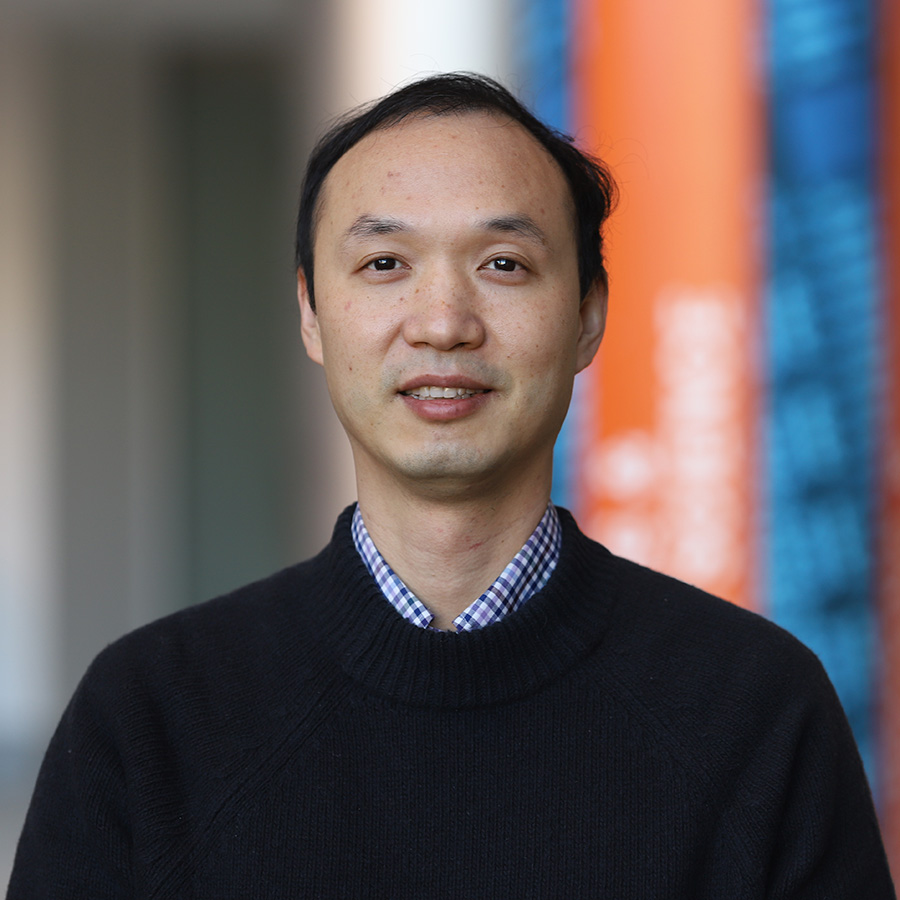
Teng Zhang, Associate Professor of Mechanical and Aerospace Engineering, was awarded a National Science Foundation (NSF) grant to research how biomechanical forces shape developing tissues inside the human body. The project titled “Collaborative Research: Studying Mechanics of Tissue Boundary Formation with Experiments and Theory” will be led by Zhang and Professor Jianping Fu of the University of Michigan.
Zhang and Fu will combine biomechanical experimental research with computational modeling to study somite boundary formation. Somites are a type of precursor cell that become the building blocks of vertebrae and ribs. Disruptions to this cell growth process can lead to congenital vertebral defects.
“We will develop a modeling framework that is rigorously tested and refined through direct experimental validation,” explains Zhang. “This constant dialogue between model and experiment is essential to uncover the mechanical principles governing somitogenesis and transform observation into mechanistic understanding.”
The project will also provide hands-on STEM education for K-12 students, offering summer internship opportunities at the University of Michigan, as well as programming through STEM Exploration Day at the College of Engineering and Computer Science (ECS).
“I’m thrilled to see this important work funded by NSF,” says ECS Interim Associate Dean for Research Quinn Qiao. “By integrating computational modeling with biological validation, Drs. Zhang and Fu are poised to turn observations into meaningful insights that could advance our understanding and prevention of congenital vertebral defects.”
“Dr. Zhang’s work exemplifies the importance of an interdisciplinary approach to biomedical problems and the power of combining theoretical modeling and experimental investigations. I am so happy that this cutting-edge research is recognized and funded by NSF,” says Professor Jianshun “Jensen” Zhang, MAE Interim Department Chair and Executive Director of Syracuse Center of Excellence in Environmental and Energy Systems (SyracuseCoE).
A past recipient of an NSF Faculty Early Career Development (CAREER) Award, Zhang is an expert in the complex interactions between mechanics and biological structures. He is affiliated with the BioInspired Institute, and his research group focuses on using mechanics as an enabling tool to design smart materials and structures that improve human health.
Mechanical and Aerospace Engineering Professor Anupam Pandey Receives NSF Award for Adhesion of Patterned Films on Ultra-Soft Solids Research
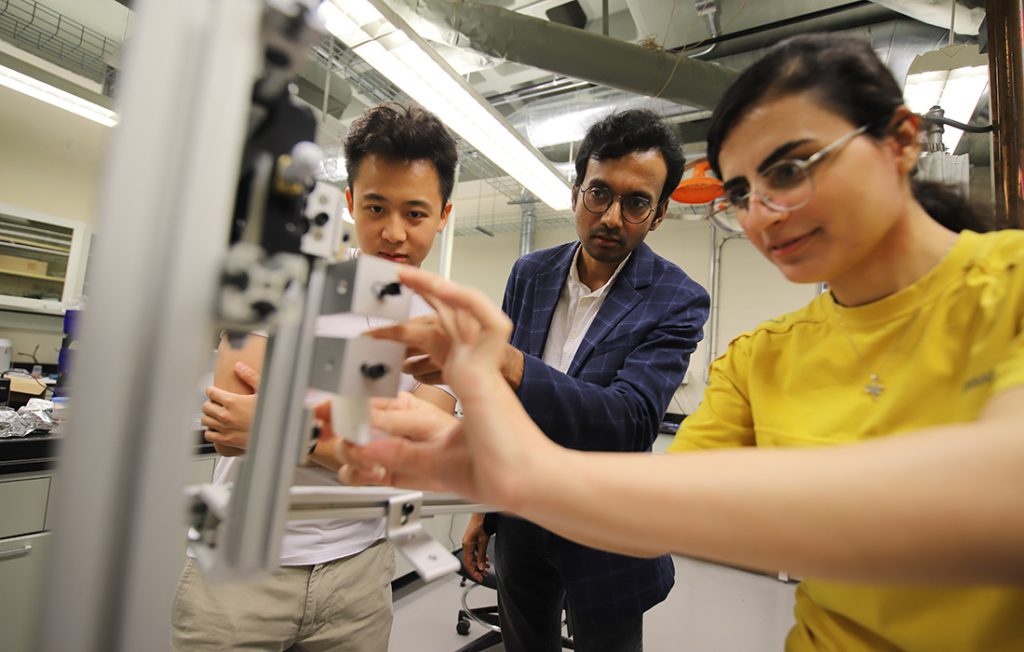
Mechanical and Aerospace Engineering Professor Anupam Pandey has received a National Science Foundation (NSF) grant to establish new strategies for controlling adhesion in ultra-soft and stretchable materials. His project will study how different types of materials stick together by examining thin materials that are partly attached to soft surfaces.
Small air pockets, or blisters, often form when surfaces don’t stick together properly, as seen in smartphone screen protectors or laminated materials. When these blisters are peeled away, one region may detach while another reattaches by itself in a unique transition described as peeling-to-rolling. This process causes noticeable changes in how strongly the surfaces stick together and involves complex interactions that existing methods can’t explain.
Pandey’s project will use analytical models and numerical simulations to understand how the peel-to-roll changes the way objects detach and causes sudden changes in the force needed to pull them apart. Additionally, the research will explore how the shape and arrangement of the air pockets can be engineered to actively control adhesion at the interface.
The findings aim to improve our understanding of how soft materials stick together in tight spaces and help design better soft interfaces for use in medical adhesives, flexible electronics, and soft robotics. To share this work, Pandey and his research team will host activities like a hands-on “Sticky Tapes” exhibit for kids, a summer workshop for high school students, and opportunities for undergraduates to get involved with research.
“This award gives us an exciting opportunity to uncover the mechanics of adhesion of blistered films on soft and stretchable materials,” says Pandey. “I’m eager to see how these insights will inspire both new science and practical applications.”
Using Candles to Make Super-Slippery Surfaces
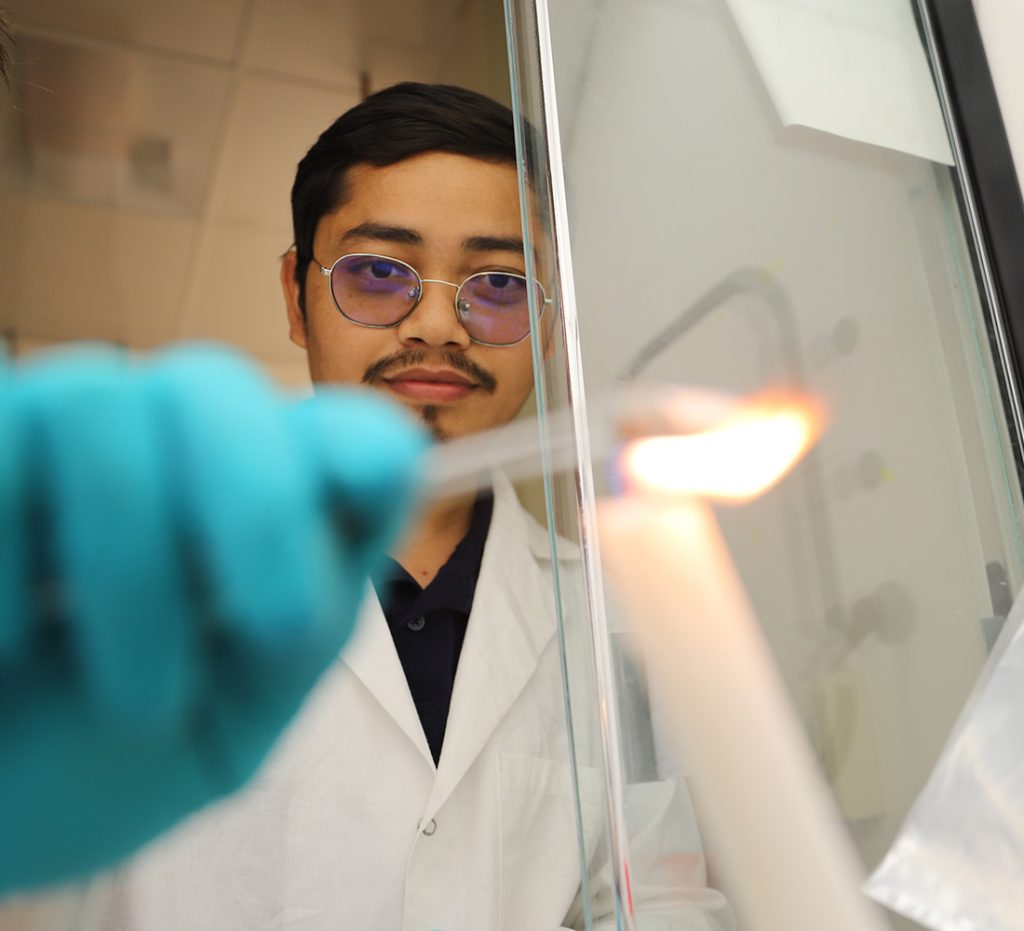
Imagine you are standing on a slippery surface and the slightest imbalance makes you stumble. At Syracuse University, researchers have developed such a surface, not for you (phew!), but for water droplets. Such a super-slippery surface for water, called a superhydrophobic surface, makes water roll-off the surface even if you tilt the surface by just two degrees. Such surfaces can be used for self-cleaning windows, safer medical tools, waterproof clothing, protection of electronics, and even to help ships and planes move faster.
Syracuse University researchers have taken soot coming off a wax candle flame and transformed it into a remarkably durable coating that makes surfaces practically impossible for water to stick to. This invention doesn’t stop at water. It also repels sticky substances like honey and chocolate syrup and even cleans itself from dirt and dust. Unlike other artificially developed water-repelling superhydrophobic coatings, which fail under heat and prolonged exposure to water, the design from Syracuse University proved astonishingly robust. It survived high-speed water jets, chemical baths, saltwater, scorching temperatures up to 650 °F and even a full month submerged underwater, emerging dry and intact.
“The magic comes from a clever combination of candle soot with oil-infused porous silica structure. The porous structure holds the oil which in-turn holds the soot particles making the surface superhydrophobic.” said doctoral student Maheswar Chaudhary, who worked on the project alongside fellow doctoral student Ashok Thapa under the guidance of Mechanical and Aerospace Engineering Professor Shalabh C. Maroo in the College of Engineering and Computer Science. “We have shown this approach to work on both flat and curved surfaces, making it versatile for real-world applications. This isn’t just about repelling water, it’s about creating an easy-to-fabricate coating that truly survives real-world conditions.”
Maroo sees the discovery as a reminder that innovation doesn’t always start with exotic ingredients. “Even something as ordinary as a wax candle can inspire groundbreaking ideas,” he said. “We’ve turned candle soot into science, blending simple materials with simple nanoscale engineering to open up exciting possibilities for technology and sustainability.”
The research was recently published, with open (free) access, in Surfaces and Interfaces.

Mechanical and Aerospace Engineering Faculty Spotlight: Changmin Shi
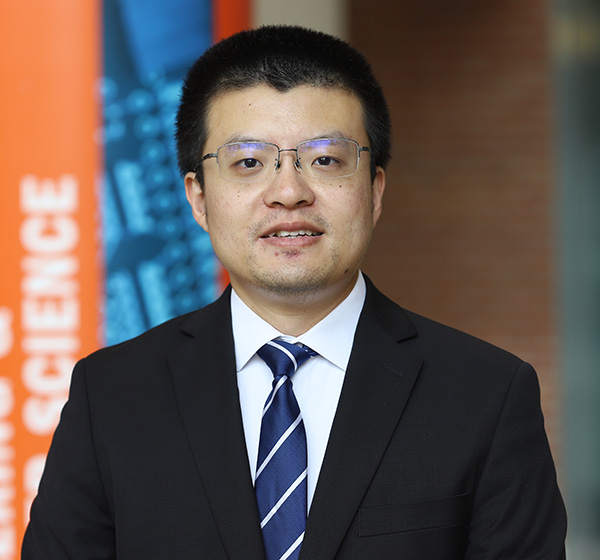
The College of Engineering and Computer Science (ECS) welcomes Changmin Shi to the Department of Mechanical and Aerospace Engineering (MAE). Shi joins ECS in the Fall 2025 semester as an Assistant Professor.
Shi earned his Ph.D. in Materials Science and Engineering from the University of Maryland, College Park. Prior to his faculty appointment at Syracuse University, he spent two years in the School of Engineering at Brown University, where he completed postdoctoral research in energy materials mechanics, thermal energy management, and artificial intelligence.
“Changmin brings a unique expertise to ECS, including both fundamental material sciences and engineering applications,” says Professor Jianshun “Jensen” Zhang, MAE Interim Department Chair and Executive Director of Syracuse Center of Excellence in Environmental and Energy Systems (SyracuseCoE). “His cutting-edge research includes novel electrochemical material systems for batteries and optically tunable materials for thermal energy regulations. I am excited to welcome him to MAE and SyracuseCoE, and look forward to his many significant contributions.”
Shi has worked on multiple groundbreaking innovations in battery and thermal management technologies, including the development of high-energy-density battery designs, novel strategies to suppress lithium dendrite growth and prevent cell failure, sustainable electricity-free cooling systems for buildings, and passive water harvesting and desalination solutions.
Recently, he was selected to serve as a lead symposium organizer for the 250th Meeting of the Electrochemical Society, the leading professional association focused on electrochemistry solid-state science and related technologies. Titled “AI-Driven Battery Materials Design and Manufacturing,” his symposium session will focus on technologies like autonomous manufacturing, predictive modeling of electrochemical properties, and other AI-assisted tools that can help accelerate battery commercialization. The conference will take place in Calgary, Canada in October 2026.
Shi is a Principal Editor of the Journal of Materials Research and a member of Sigma Xi, The Scientific Research Honor Society. He has published extensively on next-generation energy storage batteries and battery technology. In the Spring 2026 semester, Shi will teach a graduate-level course on fundamentals and properties of materials.
Dr. Shi is currently recruiting postdoctoral researchers, graduate, and undergraduate students to his research group. For more information and instructions on how to apply, please visit the Openings page on the Shi Research Group website.
Mechanical and Aerospace Engineering Professor Lihong Lao Receives ASHRAE Research Award to Study Data Center Corrosion
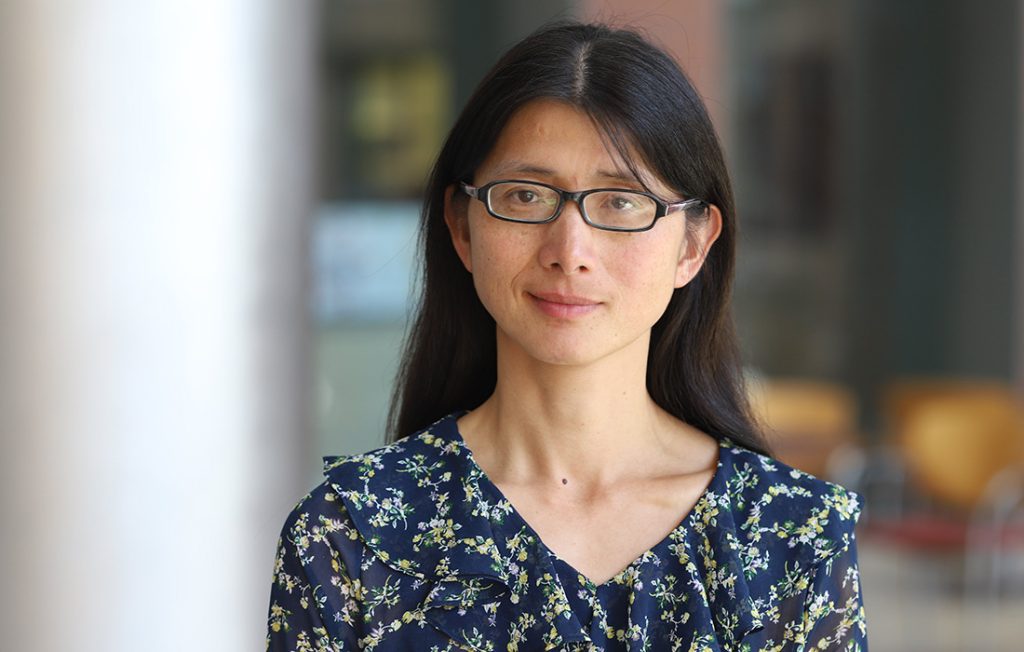
Mechanical and Aerospace Engineering (MAE) Assistant Professor Lihong Lao has received a research grant from the American Society of Heating, Refrigerating and Air-Conditioning Engineers (ASHRAE). With ASHRAE’s support, Lao will study the impact of corrosion on equipment in data centers located in coastal regions.
Lao’s lab will mimic the conditions of a coastal data center to study how factors like air flow, dry bulb temperature, dew point, humidity, gaseous pollutants and sea salt concentration affect the corrosion levels of copper and silver materials used in IT equipment.
“Currently, there is little guidance on the optimal environmental conditions for data centers in coastal areas, which can have high humidity and airborne salinity,” explains Lao. “This research project aims to develop guidelines for data center operators that prevent IT equipment failure and make these facilities more resilient.”
Lao joined the College of Engineering and Computer Science (ECS) in 2024, after completing postdoctoral research at the University of Illinois Urbana-Champaign. At ECS, she leads the Environmental Control Materials Lab, which focuses on developing smart materials that help regulate temperature and moisture in both the human body and the built environment. Lao holds a Ph.D. in Polymer and Fiber Science from Cornell University.
“Congratulations to Lihong on winning this award. This project gives us the opportunity to continue supporting ASHRAE as they advance environmental design guidance for data centers,” says MAE Interim Department Chair and Syracuse Center of Excellence In Environmental and Energy Systems Executive Director Jianshun “Jensen” Zhang. “This award builds on the capability we developed through a previous ASHRAE sponsored project that provided knowledge and data to support the expansion of the acceptable temperature and humidity conditions for data centers, while reducing the risk of IT equipment failure due to corrosion by gaseous pollutants.”
Lao and Zhang will serve as Co-PIs on the project. Zhang also acknowledged MAE Professor Emeritus and a Member of National Academy of Engineering, Roger Schimdt, who has provided ongoing support to MAE faculty in this area, and helped translate fundamental research into practical design guidelines.
Founded in 1894, ASHRAE is the world’s largest society of heating, refrigerating and air-conditioning professionals, representing experts from over 130 countries.
Diving Deep into Aerospace Engineering: Brady McKenna ’25

While scuba diving and space exploration seem like worlds apart, they share more similarities than you’d expect. In fact, one of the world’s largest indoor pools is housed in NASA’s Johnson Space Center in Houston, Texas. Known as the Neutral Buoyancy Lab (NBL), this facility is designed to prepare astronauts for spacewalks since water closely mimics the weightlessness experienced in space. Divers are also present in the lab to ensure the astronauts’ safety during their training.
For an aerospace engineering student and scuba diver like Brady McKenna ’25, NASA’s buoyancy lab is the perfect place to combine his interests. While studying abroad in Australia, he became a certified diver and later discovered how he could merge his engineering education with his love for deep-sea diving.
“I love scuba diving, and I love engineering. I’d be pairing a lot of my interests,” says McKenna. “Being able to draw on that moving forward in my career would be incredible.”
After securing an internship with NASA in the summer of 2024, McKenna came across the buoyancy lab, where he would earn an advanced scuba diving certification. He also learned about the work of engineers who design equipment for test runs with astronauts in the lab. These engineers dive into the pool to observe the equipment and receive direct feedback from astronauts about improvements.
“It sounded awesome to me because you never get to do that in engineering. You never get to design it, see it used, get direct feedback, see it in the field and go back to improve it,” says McKenna. “That would be a cool avenue to explore.”
In addition to becoming a certified diver, McKenna learned about cryogenic systems, vacuum chambers, and pressure vessels. He visited the Mission Control Center, the Space Vehicle Mockup Facility, spacesuit labs and saw the latest space technologies that are in development. He also improved his presentation and communication skills through meetings with leadership.
“It was great interacting with people and different commercial space vendors. I got a real feel for what’s going on in the space industry,” he says.
McKenna has gained valuable experience in building and designing through his senior design capstone. This project is a collaboration with NASA, made possible through his internship experience with the agency. His team is developing a Chamber D test stand that will be used to test spacesuit components such as gloves and boots. McKenna and his teammates were also able to visit the space center, where they gained insights from engineers across various disciplines and industry experts.
His involvement with the NASA-sponsored capstone has also led him to consider starting his own company. “Capstones are a great way for students to get hands-on experience they may not otherwise get in the classroom,” he says. “I would love to help connect companies with colleges for company-sponsored capstones.”
McKenna will be returning to the Johnson Space Center in the summer of 2025 to continue working with the EC Crew and Thermal Systems Division, focusing on cryogenics and space suit testing technologies. He also plans to obtain his rescue diver certification in the buoyancy lab. After the summer, he will return to Australia to pursue a dive master certification to become a dive guide.
“Working with NASA has been a dream come true. I never imagined I’d get to that level as an undergraduate,” says McKenna. “To have the opportunity to go to the Johnson Space Center and see the things I saw was incredible and I’m grateful for the experience.”
Jianshun “Jensen” Zhang Named Interim Department Chair of Mechanical and Aerospace Engineering

The College of Engineering and Computer Science is excited to announce that Professor Jianshun “Jensen” Zhang has been appointed Interim Department Chair of Mechanical and Aerospace Engineering, effective July 1, 2025. Zhang serves as Executive Director of the Center of Excellence in Environmental and Energy Systems (CoE) and is one of the premier experts worldwide on built environment systems.
Zhang received his Ph.D. degree from the University of Illinois at Urbana-Champaign in 1991, worked as a researcher at the National Research Council of Canada for 8 years, and then joined Syracuse University in 1999. He has over 35 years of research experience in built environmental systems and has authored and co-authored more than 200 peer-reviewed journal papers and over 100 conference papers. His areas of expertise include combined heat, air, moisture and pollutant simulations in buildings, material emissions, air filtration/purification, ventilation, indoor air quality, and intelligent control of building environmental systems.
Zhang has developed advanced experimental methods, tools, and equipment, as well as computer simulation models and environmental control technologies. Over the last 25 years at Syracuse University, he has established and sustained an active research program in building energy and environmental systems with over $20 million in sponsored research. He also teaches graduate and undergraduate courses in the areas of building energy and environmental systems and fundamental heat and mass transfer. He has advised and co-advised over 20 Ph.D. students, over 20 M.S. students, and eight postdoctoral fellows.
Zhang is a member of the International Academy of Indoor Air Science (ISIAQ fellow) and a fellow of the American Society for Heating, Refrigerating, and Air Conditioning Engineers. He is also currently the vice president of the Indoor Air Quality, Ventilation and Energy Conservation Association. He served as president and chairman of the board of the International Association of Building Physics from 2018 to 2021. He is also Editor in Chief of the International Journal of Ventilation and Associate Editor of Science and Technology for the Built Environment.
“Professor Zhang is one of the best respected researchers, educators, and leaders in his field. I am especially grateful for his willingness to serve as interim department chair because he has been so intentional about mentorship and support of other faculty,” said Engineering and Computer Science Dean J. Cole Smith. “Although we will miss Dr. Young Moon’s steady leadership of MAE, I am excited to see the innovative actions Professor Zhang will take to move MAE forward.”
“I am truly honored and excited to have the opportunity to serve the department, college, university, and the profession in this new role. I sincerely thank the faculty, staff and ECS leadership for their trust and support, and thank Professor Young Moon for leading and serving MAE over the last decade. MAE has highly talented and very student-caring faculty and staff running excellent undergraduate and graduate programs. I am looking forward to working with them more closely to advance MAE to the next level,” says Zhang.
Mechanical and Aerospace Engineering Professor Fernando Zigunov Selected for NASA Glenn Faculty Fellowship
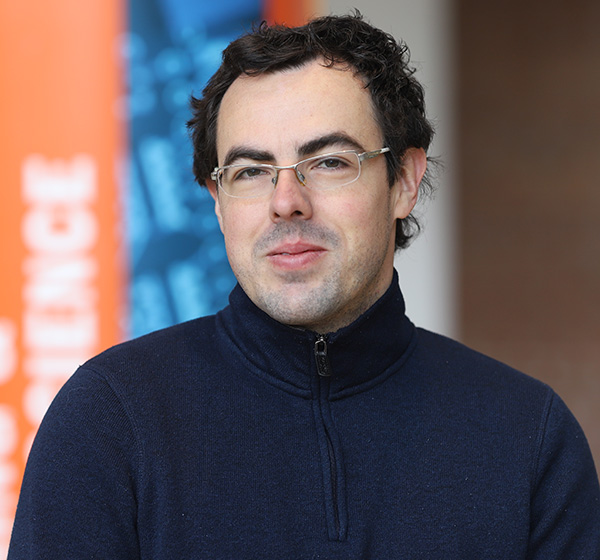
Assistant Professor in Mechanical and Aerospace Engineering Fernando Zigunov has been selected to participate in the NASA Glenn Faculty Fellowship, a 10-week research program for full-time STEM faculty members. The fellowship will take place from June to August at the Glenn Research Center (GRC) in Cleveland, Ohio.
Participants in the fellowship will contribute to research, technology and engineering goals in support of NASA’s mission, engage with NASA subject matter experts in research and engineering, enhance their professional knowledge, and infuse NASA mission-related research and technology content into classroom teaching.
“I’m very grateful to have been selected for this fellowship,” says Zigunov. “I look forward to collaborating with NASA Glenn’s aeropropulsion group and contributing to their cutting-edge research to understand turbulent noise production mechanisms towards the development of the next generation of quiet propulsion systems.”
Mechanical and Aerospace Engineering Doctoral Student Melissa Yeung Receives Zonta International’s 2025 Amelia Earhart Fellowship

Mechanical and aerospace engineering doctoral student Melissa Yeung has received Zonta International’s 2025 Amelia Earhart Fellowship, a prestigious award that supports women pursuing doctoral degrees in aerospace engineering. The award honors aviation pioneer Amelia Earhart. Zonta International is a global organization that supports women and girls.
The Amelia Earhart fellowship offers financial support to help women further their education and advance their careers. Promising and talented women from top-tier universities all over the globe are selected by Zonta International for the Amelia Earhart Fellowship every year. During her time at the College of Engineering and Computer Science, Yeung has demonstrated an exemplary academic record in aerospace engineering research, joining the National Science Foundation (NSF) Graduate Research Fellowship Program (GRFP) last year.
“Winning the Amelia Earhart Fellowship affirms my aspirations to be a leader in the field, motivating me to continue my efforts in uplifting and supporting other women in STEM. It serves as a reminder that I am not alone in my journey and challenges, and I am excited to be among a community of women equally as passionate about advancing aerospace engineering,” says Yeung.
“Melissa’s Amelia Earhart Fellowship is not just a recognition of her achievements—it’s a celebration of her potential. From the moment she joined my lab, she has impressed me with her intellect, initiative, and kindness. As someone who knows how much this fellowship can mean, I’m thrilled to see it now honoring someone so deserving. She’s already leading with purpose, and this is just the beginning,” says Yiyang Sun, assistant professor in mechanical and aerospace engineering.
Professor Bing Dong Named as the Traugott Professor of Mechanical and Aerospace Engineering
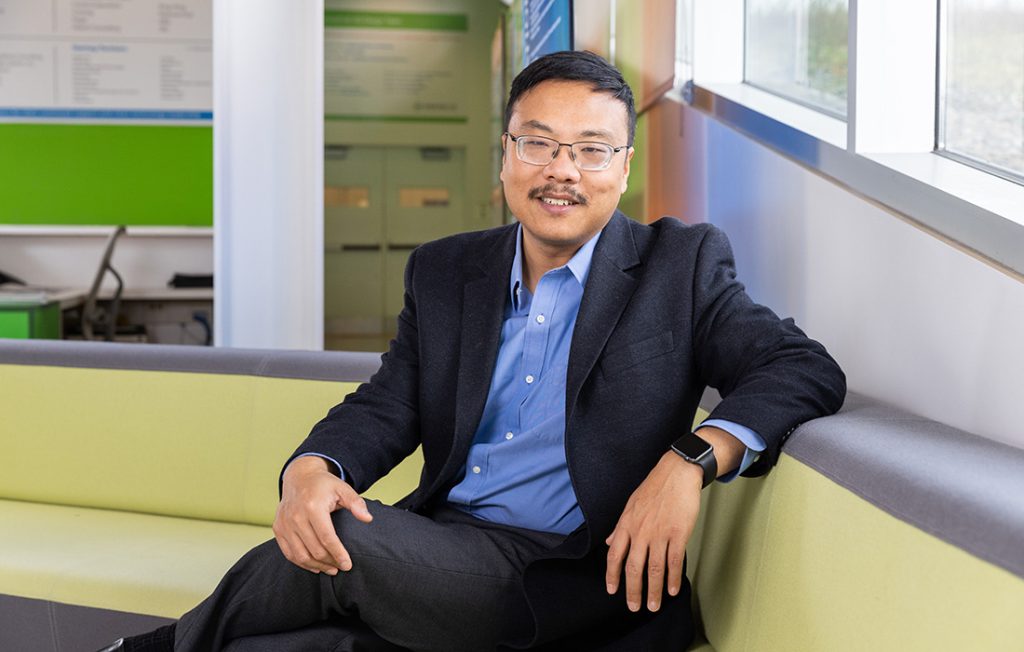
The College of Engineering and Computer Science is proud to name Bing Dong as the Traugott Professor of Mechanical and Aerospace Engineering. This endowed professorship is made possible by a 1998 gift from the late Fritz Traugott H’98 and his wife Frances.
A prolific researcher with a strong track record of securing external funding, Professor Dong is the Associate Director of Grid-Interactive Buildings at the Syracuse Center of Excellence in Environmental and Energy Systems, oversees the Built Environment Science and Technology (BEST) Lab, and teaches courses on HVAC system design, machine learning for mechanical engineering, and control systems.
Dong holds a dozen patents and has published more than 130 peer-reviewed papers with approximately 11,500 citations. Since joining Syracuse University in 2019, he has served as the Principal Investigator (PI) or Co-PI on over 20 projects, totaling more than $15 million in funding.
Dong’s research sits at the intersection of building performance, human behavior, and urban infrastructure. Using physics-informed machine learning, optimization, and AI-enabled controls, his goal is to improve energy efficiency while ensuring the productivity and comfort of building occupants.
Since earning his Ph.D. in Building Performance and Diagnostics from Carnegie Mellon University, Dong has been a leader in the field of building science. He received a 2023 World Fellowship from the International Building Performance Simulation Association (IBPSA), Syracuse University’s first such fellow and one of only two U.S. members in the biennial cohort. Dong also received a 2023 Distinguished Service Award from the American Society of Heating, Refrigerating and Air-Conditioning Engineers (ASHRAE), in which he was the only New York state honoree. He is the recipient of the NSF CAREER award and several best paper awards from international journals.
“Bing’s innovative research and commitment to improving energy systems is exactly what Fritz and Frances Traugott had intended when they established the endowed professorship,” says Engineering and Computer Science Dean J. Cole Smith. “Their vision and commitment to this important work is supporting breakthroughs from Bing and his research team.”
“Bing has been integral to our work at the Syracuse Center of Excellence,” says Professor Jianshun “Jensen” Zhang, CoE’s Executive Director. “In collaboration with our academic and industry partners, he is advancing research across multi-scales of the built environment and developing cutting edge technologies for improving energy efficiency, environmental quality and human health.”
Fritz Traugott came to Syracuse University through a Marshall Plan work-study initiative for young engineers. He retired in 1990 after a long career with Robson & Woese Inc., a Syracuse-based consulting engineering firm. In establishing the Traugott Professorship, Fritz and Frances Traugott specifically wished to support energy systems engineering research in the College of Engineering and Computer Science, making Dong’s work an ideal match.
“It is truly a great honor to be the Traugott endowed professor,” says Dong. “I will continue Mr. Traugott’s vision of conducting research and education in energy system engineering.”
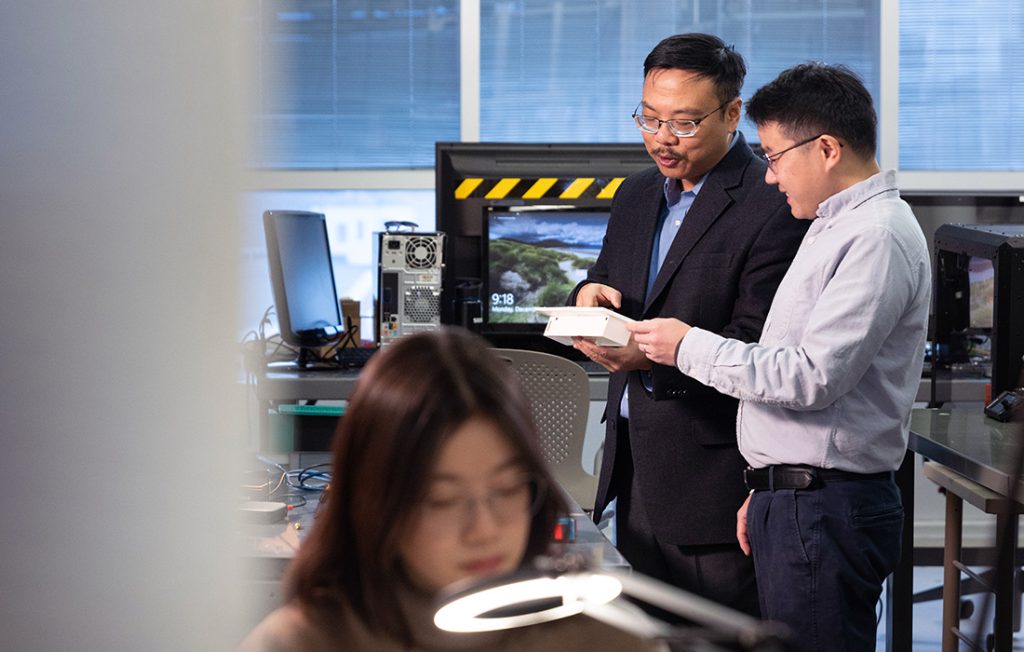
Mechanical Engineering Capstone Design Teams Present Final Projects
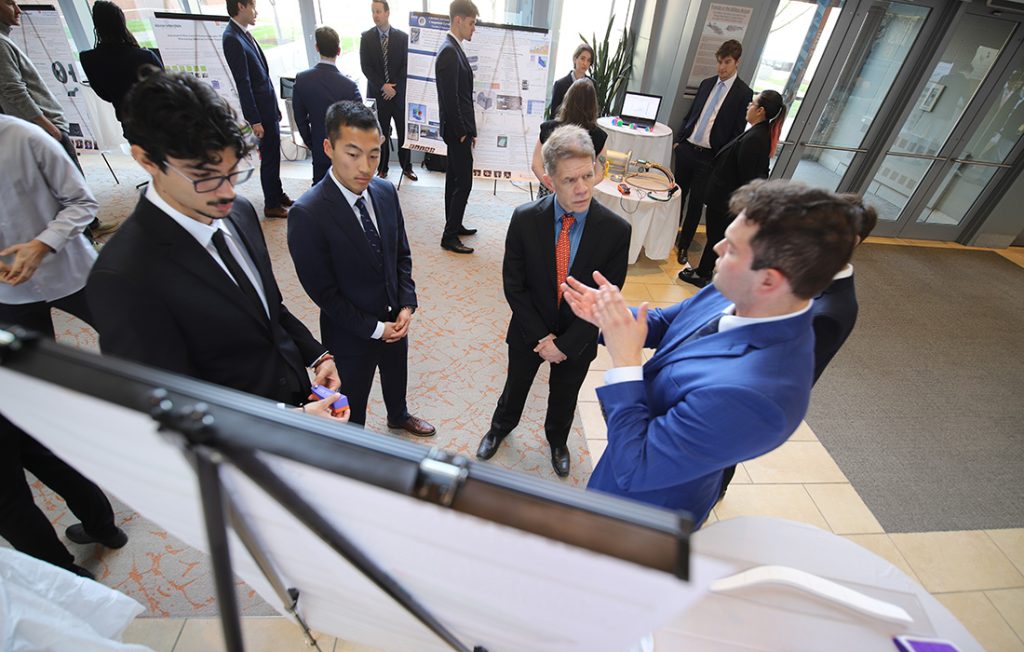
Over the past two semesters, 61 mechanical and aerospace students across 15 teams partnered with 15 sponsoring companies to tackle real-world engineering challenges. Their work reflected not just technical excellence, but also innovation, teamwork, and professionalism.
“This program wouldn’t be possible without the dedication of our faculty mentors, whose guidance connects classroom learning to real-world application. A heartfelt thank you as well to our industry sponsors for their continued support and valuable feedback,” said Professor Alex Deyhim.
This year’s sponsors included: NASA, Lockheed Martin, Boeing, Eaton, Carrier, DuPont, Advion, Aerovec, Pursuit Aerospace, ASHRAE, TTM Technologies, Automated Biomass Systems, RedCat, SoldyneX LLC, and TensilasticEnergy.
Special thanks to Boeing Corporation for sponsoring the Boeing Award for Engineering Excellence.
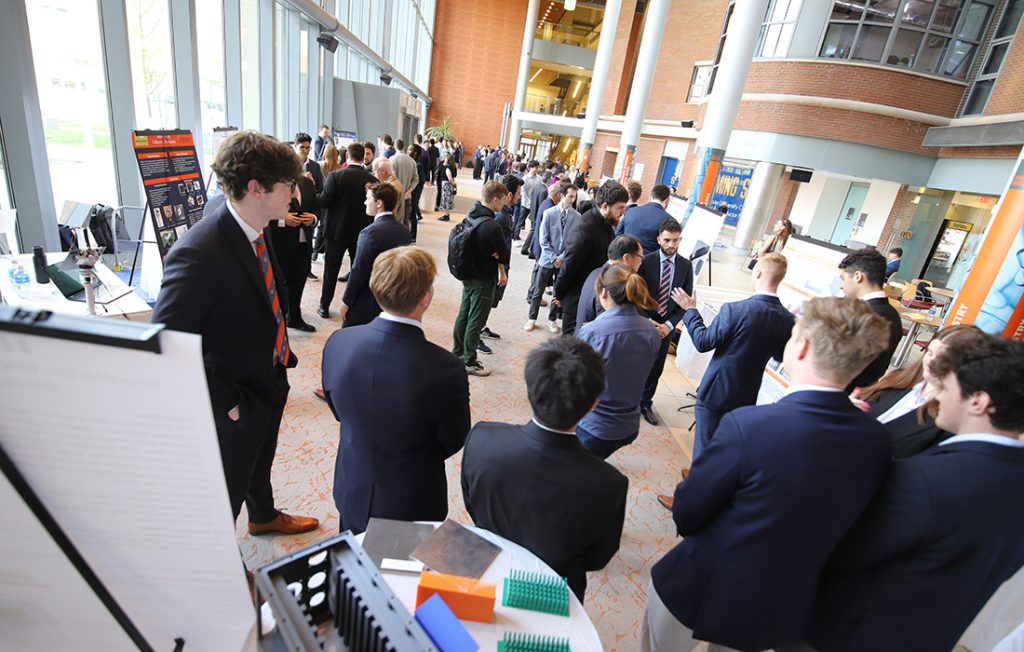
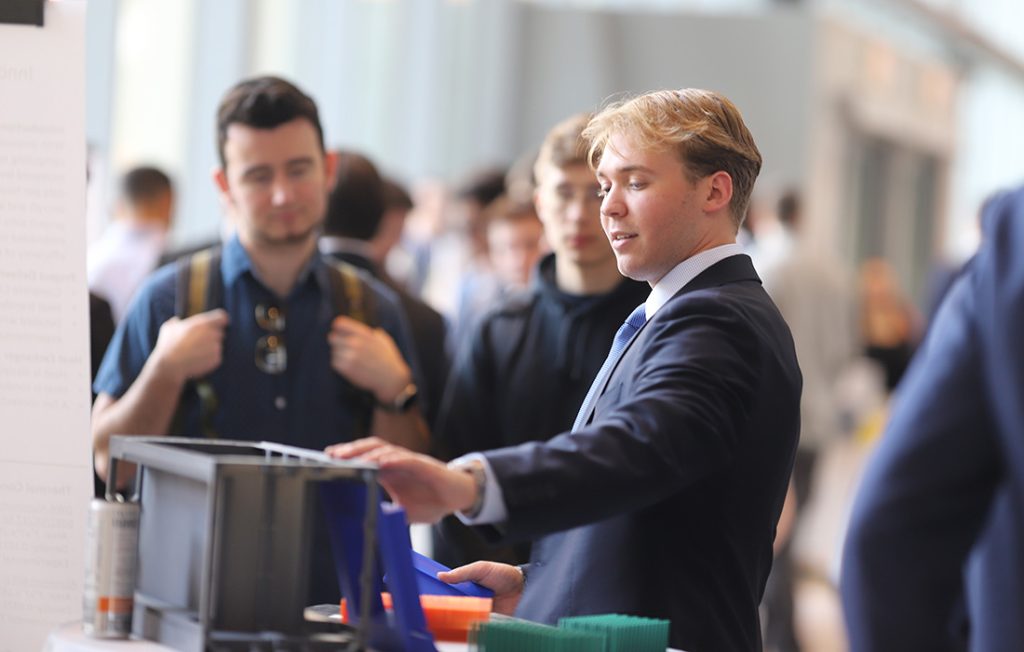
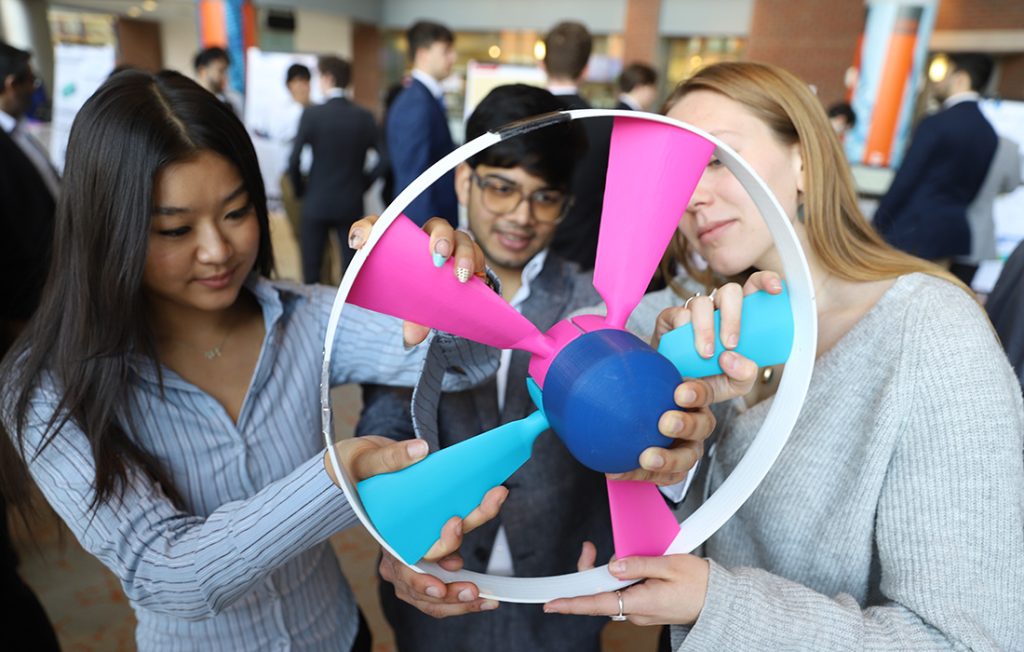
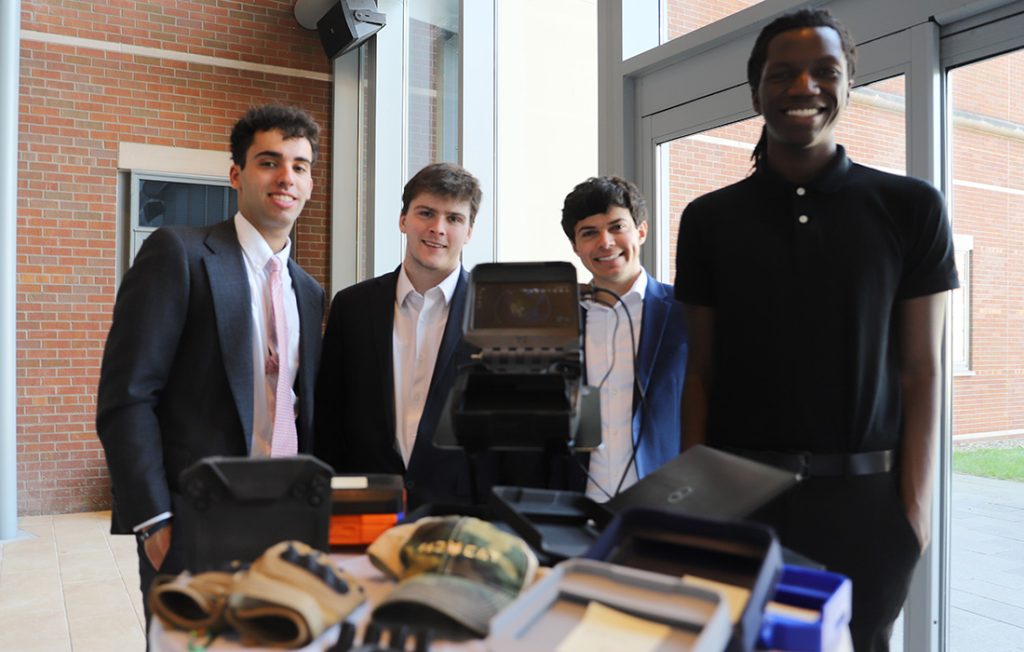
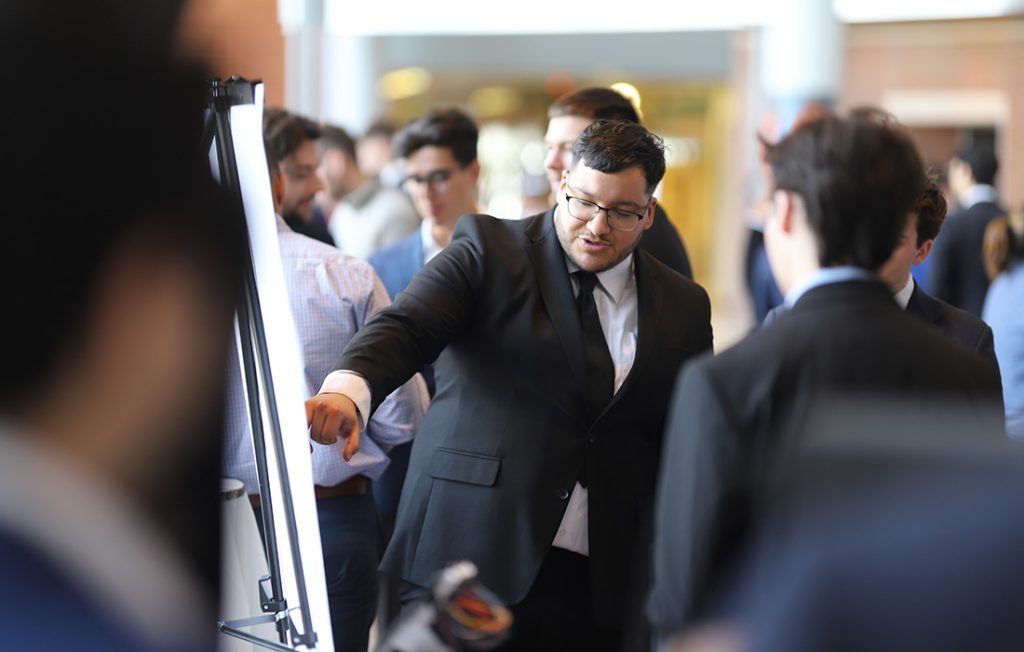
Aerospace Engineering Students Test Aircraft Designs in the JMA Wireless Dome
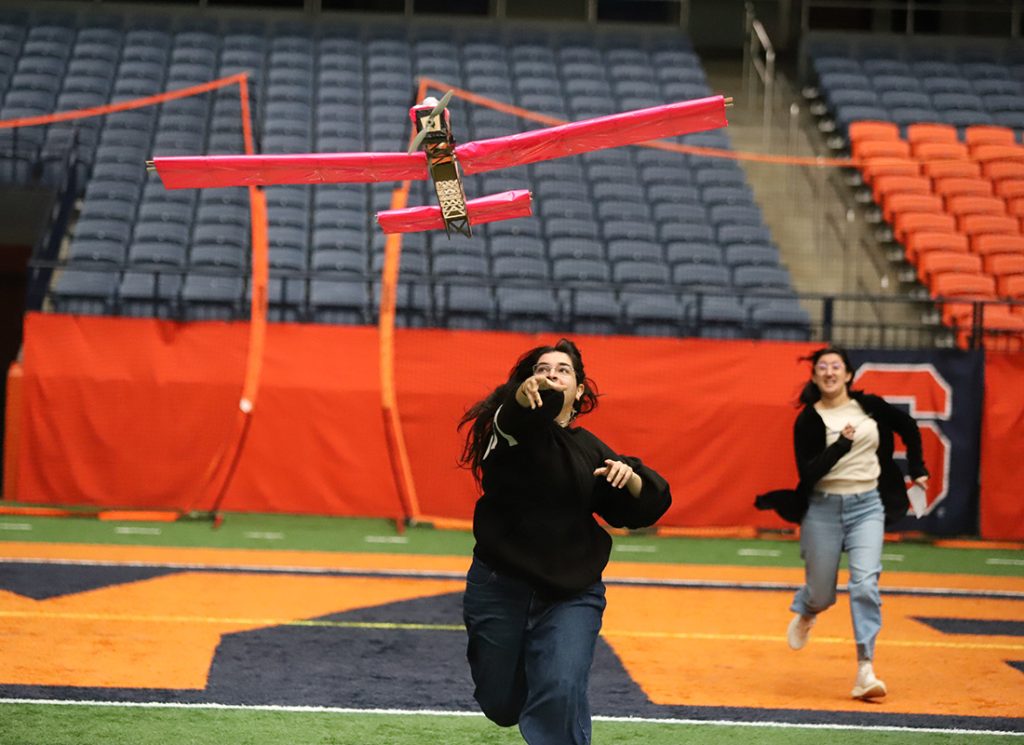
Aerospace engineering seniors had a chance to test their aircraft designs in the JMA Wireless Dome as part of the annual Flight Day event. Student teams designed and constructed their aircraft over the course of the spring semester and tested their ability to stay airborne and carry a load of gold balls.


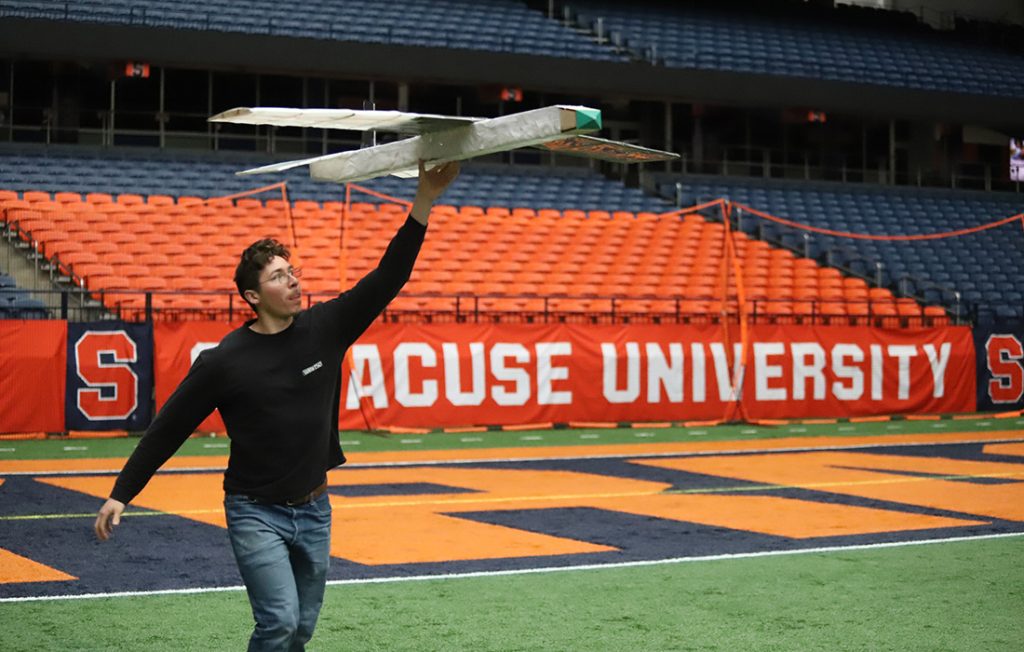

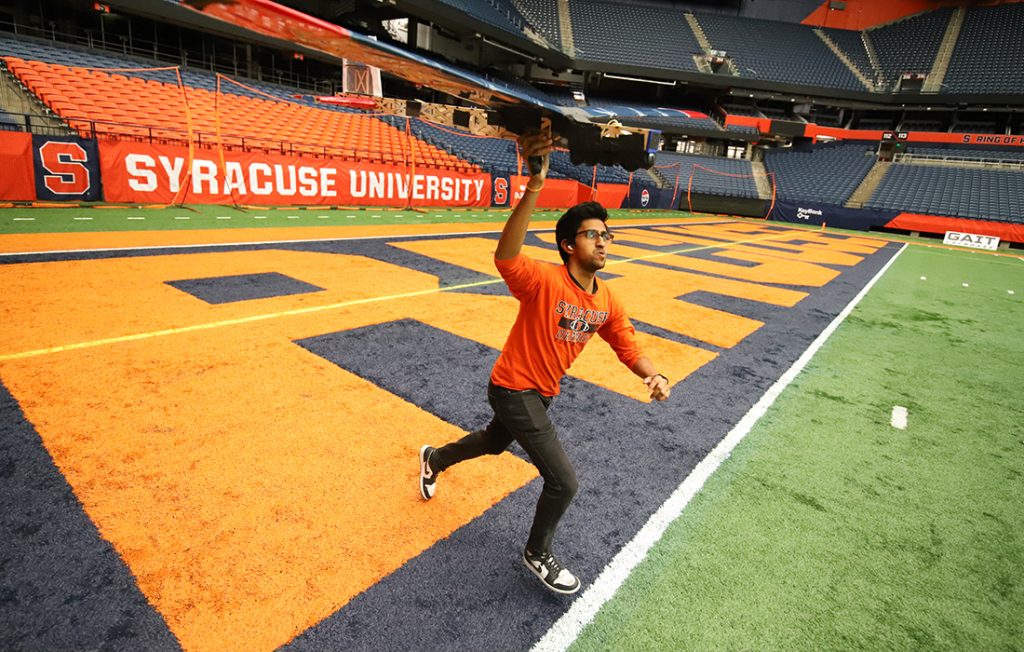



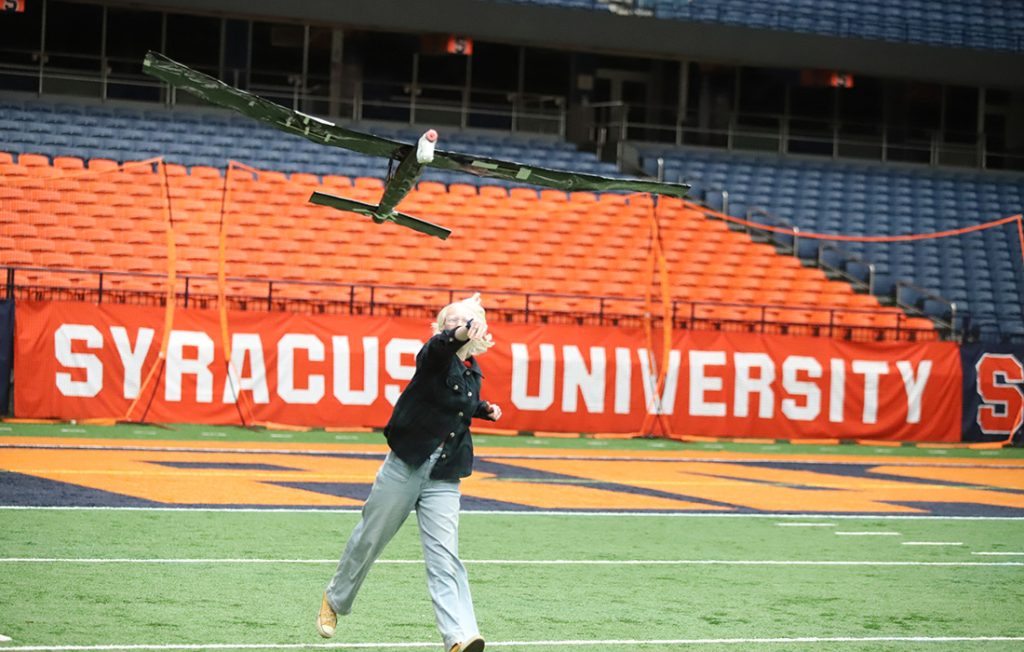


Changmin Shi
Center/ Institute Affiliations:
Syracuse Center of Excellence in Environmental and Energy Systems
BioInspired Institute
Degrees and Training:
Postdoc., Brown University, 2025
Ph.D., University of Maryland, College Park, 2023
M.S., Columbia University, 2019
B.E., University of Science and Technology Beijing, 2017
Areas of Expertise:
- Battery Materials and Manufacturing
- Passive Thermal Management Materials and Manufacturing
- AI-Driven Manufacturing and Prediction
- Micro/Nano Fabrication
- Recycling
Dr. Shi’s group research is at the interface of materials, advanced manufacturing, and AI-driven methodology to push the frontiers of energy storage batteries and passive thermal-management technologies. The group designs novel materials as well as new recycling and manufacturing approaches to advance next-generation batteries. In parallel, the group designs novel passive materials and materials architectures that enable efficient temperature regulation and water harvesting. By combining fundamental science and applied engineering, the group advances solutions to address grand challenges in energy and environment to promote a circular economy.
Selected Honors and Awards:
Nominated Sigma Xi Full Member, The Scientific Research Honor Society, 2025
Inventor of the Year, 2024
All America Chinese Youth Federation Top Under 30, 2024
Nano Research Energy Young Star Researcher Gold Award, 2023
Chinese Government Award for Outstanding Self-Financed Students Abroad, 2023
Future Faculty Program Fellow, 2022
Outstanding Graduate Assistance Award, 2020
Publications:
Professor Shi’s full publication list is available here.
Mechanical and Aerospace Engineering Students Collaborate with NASA on Senior Design Capstone

For decades, NASA’s testing chambers have been used to simulate the harsh conditions of space, allowing engineers to test the durability of spacecraft and other equipment in a controlled environment. These testing chambers, which can simulate extreme temperature or pressure environments, have played a crucial role in developing new technology for space travel, dating back to the first Apollo space mission.
Collaborating with NASA on their senior design capstone project, four mechanical and aerospace engineering students, Liam Collins ’25, James Jabbour ’25, Brady McKenna ’25 and Alexandra Vaida ’25, are gaining real-world experience building a mechanical actuator test stand for one of NASA’s testing chambers, Chamber D. Chamber D will be used to test next generation spacesuit gloves and boots at extremely low temperatures. The mechanical actuator will apply force to the test article, allowing engineers and suit designers to analyze the thermal performance of spacesuit gloves and boots as NASA prepares to return to the moon and beyond.
To gain a better understanding of their design, the team visited NASA’s Johnson Space Center in Houston, Texas, meeting with engineers across various disciplines, including the Chamber D team and industry experts. The team presented their designs and received feedback from various engineers, as well as tours of the Space Environmental Simulation Laboratory and the spacesuit laboratory.
“There were small vacuum chambers to test spacesuits and big, massive vacuum chambers to test the James Webb telescope, which is hundreds of feet tall. It was incredible to see that. It’s an engineer’s candy shop. Walking in, seeing all this technology they’ve built and are using, it’s mind-blowing,” says Jabbour.
“It was interesting to see the test sites because we were able to get tours of the facility as well as meet with the engineers. The scale of all their testing was interesting to see in person and it was helpful for our capstone,” says Vaida.
“We got to meet electrical engineers, controls engineers, thermal engineers and subject matter experts. It was great to hear their perspective on our design, which helped us better understand what we’re doing and how we’re approaching it,” says McKenna.
In the past, the testing plate in the chamber remained stationary, and test operators would move test articles to touch the plate. What sets Chamber D apart from previous testing is that the contact plate moves toward the test article, rather than requiring test articles to move to the plate. This design choice gives test operators flexibility and gives the students creativity in designing a truly novel system.
“We’re trying to make it as versatile as we can so different spacesuit companies can use it for whatever test they need,” says Vaida.
“Our test stand also meets extreme temperature and vacuum requirements that many other chambers cannot, which is unique to our project,” says McKenna.
The team has been prototyping and testing their mechanical actuator for final presentations and delivery to the Johnson Space Center in May. Final presentations will take place toward the end of the 2025 spring semester.
“I am very proud of my team for how we handled the adversity. No one ever complained and we all did what we could to help each other, which was great to see,” says Collins.
“Chamber D will be the Earth’s sandbox for testing technology that will be exposed to the coldest, darkest regions of the moon and beyond,” says Stephen Baker, project manager of NASA’s Systems Test Branch. “No other chamber in the world has the combination of thermal capabilities, size, and convenience. I’m happy with the progress I’ve been seeing on this project.”
“Liam, James, Brady, and Alexandra made the most of this incredible opportunity to collaborate with NASA on testing next-gen spacesuit components. Their visit to Johnson Space Center truly highlights the value of hands-on, experiential learning,” says Kenneth and Mary Ann Shaw Professor of Practice Alexander Deyhim.

Robotics and Rehabilitation
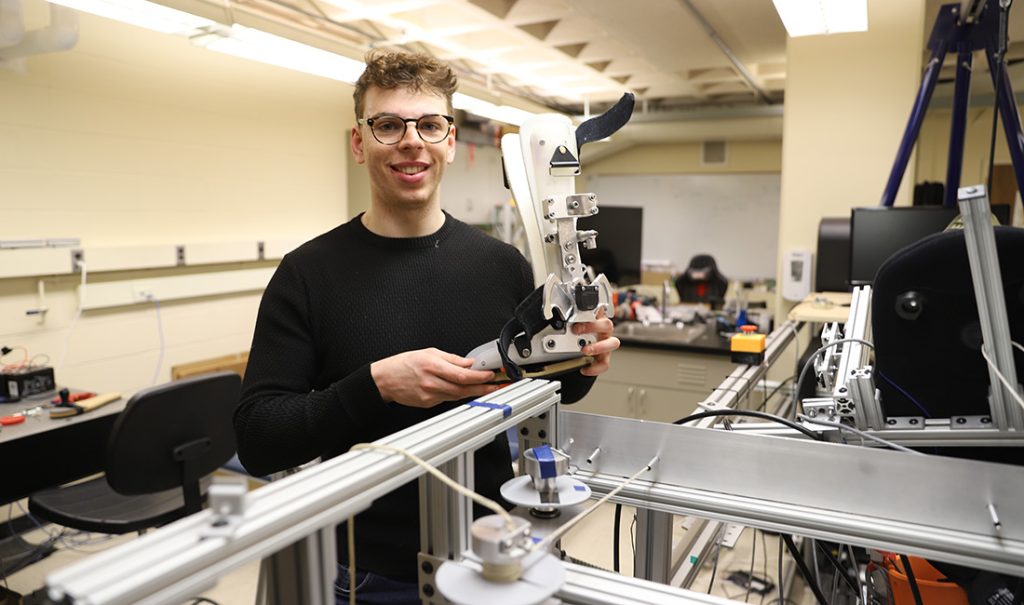
Observing his father’s work in physical therapy research and cognition tests, Evan Tulsky’s ’24 interest in robotics and rehabilitation took shape at a young age. He recognized the crucial role that rehabilitation devices play in transforming people’s lives, motivating him to pursue research in this field while attending Syracuse University. This path would lead him to the Bionics, Systems and Controls (BSC) Lab, an interdisciplinary research space centered around robotics and rehabilitation.
“I’ve always been fascinated by the intersection of control systems, dynamics and rehabilitative devices,” says the mechanical engineering graduate student. “I was raised around research, and this was the best place for it. This is a really cool lab.”
Led by Victor Duenas, assistant professor in mechanical and aerospace engineering, the BSC Lab focuses on individuals who have had strokes or other neurological conditions that affect the brain, spinal cord, or nerves. Tulsky joined the lab as an undergraduate research assistant and is now pursuing his Ph.D., where he’s been building devices that support hip, foot and ankle movements.
Because the muscles and joints in the lower body work together, problems in one area can impact the others during movement. A robotic ankle-foot device and hip exoskeleton could help individuals with hip and knee issues since ankle pain can put stress on the hip and knee.
“If you’re working on an ankle and hip device, you’re working on the entire leg—they’re interconnected,” says Tulsky. “The goal is to develop devices that support all three joints and different movements.”
The lower limb exoskeleton—a wearable device that helps with walking, standing and other lower limb bodily functions—is the latest project in development in the BSC Lab, which Tulsky has been assisting with. This exoskeleton will give individuals with spinal cord injuries or strokes balance and flexibility, allowing them to rotate their legs naturally around their pelvis and hip area.
“Most exoskeletons don’t focus on foot placement and balance,” Tulsky explains. “People with spinal cord injuries can’t land on their foot well. With this device, we’re trying to make motions as natural as possible and help people regain their confidence.”
Tulsky’s graduate studies build upon his research in muscle activity, particularly electromyography (EMG). EMG measures the electrical activity of muscles and nerves and is a great way to assess the health of nerves and muscles that allow movement and other bodily functions. He would present a research paper on EMG and muscle activity in the ankle and foot at the Institute of Electrical and Electronics Engineers (IEEE) Conference on Controls, Technology and Applications. The conference took place in England in 2024.
The BSC Lab conducts research in collaboration with the Syracuse Veterans Affairs Medical Center since the University has a well-established history with the veteran population. Tulsky has been honored as the Richard A. Bernard Scholar for his efforts in assisting the disabled population and received recognition for the best thesis in engineering.
“My journey is driven by a deep-seated passion to leverage technology for enhancing human health and quality of life. I aspire to continue contributing to innovations that advance the field of rehabilitative robotics and empower individuals facing physical limitations.”
Mechanical and Aerospace Engineering Professor Bing Dong Awarded New York State Energy Research and Development Authority (NYSERDA) Funding
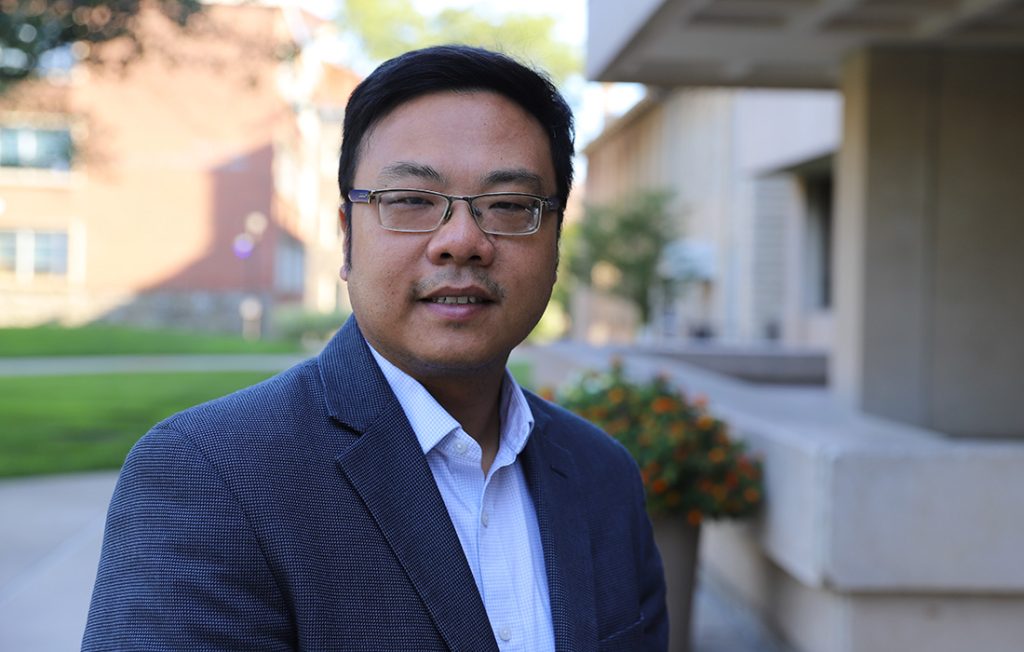
New York State has set ambitious clean energy targets, with a goal of achieving a carbon-neutral economy by 2050. Because residential and commercial buildings are significant contributors to greenhouse gas emissions, there is a need for innovative solutions to heat and cool buildings efficiently.
The New York State Energy Research and Development Authority (NYSERDA) Next Generation Buildings Innovation Challenges program aims to find those solutions, funding projects related to advanced building technologies for clean heating, air conditioning, ventilation, building envelopes and intelligent building controls. Mechanical and Aerospace Engineering (MAE) Professor and Associate Director of Grid-Interactive Buildings at the Syracuse Center of Excellence in Environmental and Energy Systems (SyracuseCoE), Bing Dong recently received more than $1 million in funding through this NYSERDA program to develop intelligent building technologies.
Dong’s project, “Occupant-Centric Data-driven Controls for Multiple Energy Assets in Commercial Buildings,” will utilize physics-informed machine learning to optimize building energy systems. Using 727 E. Washington St. as a testbed, the research team will collect data from a variety of building systems – including HVAC, thermal storage, battery energy storage, and EV charging stations. They will use this information to model potential energy savings and peak load reduction. Ultimately, the team seeks to develop a plug-and-play platform structure that can be replicated in other buildings.
“With emerging energy storage technologies, future smart buildings need to know how to best optimize those technologies together with existing building systems,” says Professor Dong. “We will develop an AI-based control agent for those multi-energy assets to achieve their best performance.”
Building on SyracuseCoE’s strong industry connections, Professor Dong will partner with Taitem Engineering, Leaptran, and TRC Companies. Carrier will serve as a technical advisor. MAE faculty Jianshun “Jensen” Zhang and Ian Shapiro will serve as co-principal investigators on the project. Professor Zhang is the Executive Director of the SyracuseCoE , and Professor Shapiro is SyracuseCoE’s Associate Director of Building Science and Community Programs.
Next Generation Buildings Innovation Challenges was created to support the state’s Climate Leadership and Community Protection Act goal of reducing greenhouse gas emissions by 85% over the next 15 years. The program is supported by NY’s Clean Energy Fund.
In the Return Phase of Life: John Chawner ’84 on Giving Back to the University That Launched His Career
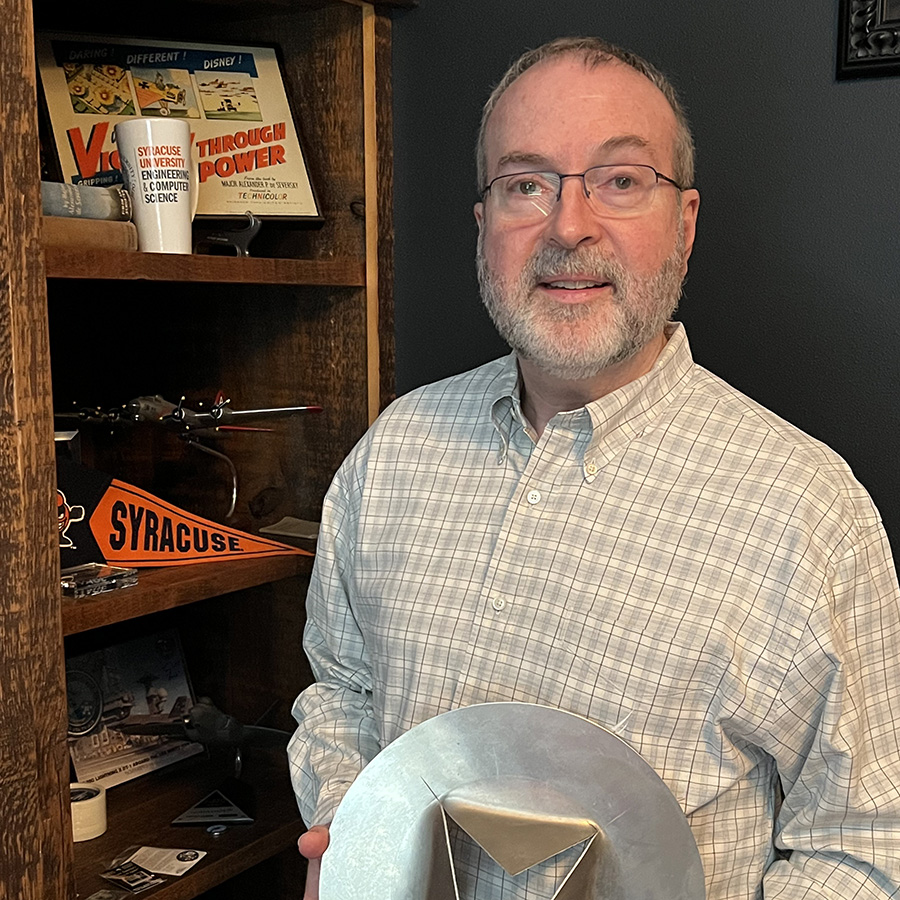
In his home office, John Chawner ’84 proudly displays a disk of aluminum dated “4-8-84.” It is a treasured memento from his days at Syracuse University and, in many ways, it is symbolic of his approach to service and philanthropy to his alma mater, which includes a recent gift establishing a new endowed professorship. Chawner vividly recalls assembling a 100-foot-long shock tube, a testing device for supersonic airflow, in the basement of Link Hall, assembling it from parts, bolts and instrumentation that was scattered in offices throughout the engineering building. It was part of an independent study project under John LaGraff, then professor of mechanical, aerospace and manufacturing engineering in the College of Engineering and Computer Science.
“Creating such a device required open-ended thinking that is critical to learning,” says Chawner, who credits Syracuse University for laying the foundation for a highly successful career that made possible the generous gift for the professorship. “I feel that I was transformed by my time at the University, from a raw 18-year-old to someone ready to enter the professional world. I want to ensure that today’s students and professors are able to maximize their time at Syracuse and enjoy the benefits of higher education.”
Chawner has supported scholarships for deserving students for years, but his latest gift funds an endowed professorship within the Department of Mechanical and Aerospace Engineering. Through the Forever Orange Faculty Excellence Program, the University will match one-third of the gift to ensure that the John R. Chawner Endowed Professorship has the resources to support world-class scholars and the research needed to propel their work forward.
Chawner earned a bachelor of science degree in mechanical and aerospace engineering in 1984 and, later, a master’s degree from The University of Texas at Arlington. Immediately after graduation from Syracuse, he got a job with General Dynamics in Texas. “I came out of Syracuse University with a great body of knowledge and raw skills that allowed me to get into the aerospace and defense field at a great time,” says Chawner. “I’m an engineer by degree but I’m a programmer by practice because I got involved in computational fluid dynamics (CFD), which was a brand new software technology back then. A bunch of us 22- to 25-year-olds were given the opportunity to develop this capability from scratch and that launched the rest of my career.”
Cultivating Talent
Chawner would go on to launch Pointwise Inc., which became internationally renowned for developing mesh generation software for CFD in aerospace applications. The technology has been applied to virtually every major military aircraft and spacecraft, including the F-16, F-22, F-35, B-2, and Space Shuttle. After more than 26 years at the helm, Chawner sold Pointwise to Cadence Design Systems where he continued to work until retiring in 2023 and forming his own consulting firm.
“Owning a small business is like agreeing to be punched in the face for a living,” Chawner told an interviewer in a blog on how to become a CFD engineer. In all seriousness, he loved the process of cultivating talent, inspiring creativity in teams, and the continuous learning required to develop and successfully market new technologies. “Everyone wants to pigeonhole engineers,” he says, but he personally defied being defined and found great value in following more than 300 blogs in engineering, business and marketing. He calls himself “an early adopter” of social media and eventually created a very popular blog called Another Fine Mesh to educate and share information.
Chawner is still educating, sharing and inspiring through a company called Gibberish Consulting (he’s the chief gibberish officer), where he attempts to redefine the stereotype of consultants. “What you need is someone with direct experience to guide you through the gibberish with simple, direct and actionable advice. That’s my role,” he says, adding the consulting work allows him to remain relevant, to pass along earned wisdom.
Building Future Engineers
Chawner brings that same wisdom and experience to his role as a member of the Mechanical and Aerospace Engineering Advisory Board at the College of Engineering and Computer Science and as a member of the Dean’s Leadership Council. “John’s service to the college is invaluable,” says Dean J. Cole Smith. “He has acquired wisdom over the years that has impacted our approach to educating and preparing engineering students for successful careers. His generosity has opened doors, helped build futures and, with this new gift, creates a legacy that will continue to support innovation and creativity for generations to come.”
“I’m a big believer that an engineering education should not be like going to a trade school. It’s about developing the aptitude and ability to learn,” says Chawner, who describes himself as a continuous learner. “An engineering education allows one to be very impactful and I want to enable students and professors to enjoy that. The investment Micron has made in the Syracuse region amplifies that impact and essentially multiplies the effect of the gift.”
Chawner says he views philanthropy as a way to give back “to a place that gave me so much in terms of education and other life experiences.” Those “experiences” include his wife, Cathy, of nearly 40 years, whom he met “at a mixer” during freshman year. They lived in the same dorm and share many memories, including the first football games in the then-Carrier Dome.
Those were the years in the first phase of life, says Chawner—the learning phase, which is followed by the earning phase, and finally, the returning phase. Learn, earn, return. “I’m in the return phase where I give back what I’ve learned and earned,” he says.
Aerospace Engineering Student Tatiyyanah Nelums ’25 Joins Patti Grace Smith Fellowship
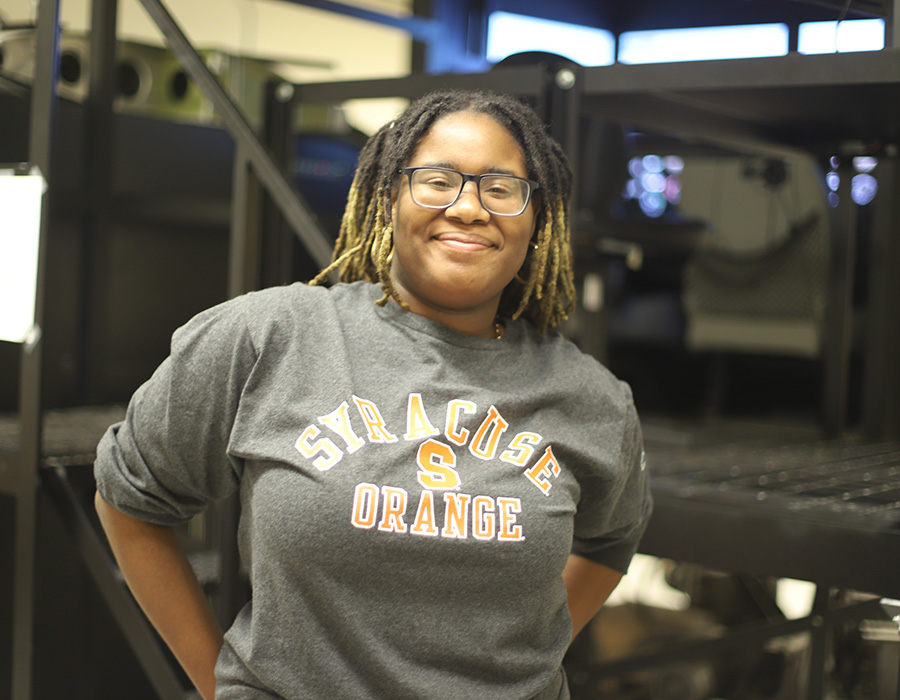
Aerospace engineering student Tatiyyanah Nelums ’25 was selected by the national nonprofit Patti Grace Smith Fellowship as a member of its latest cohort. The program is designed to support the careers of Black aerospace leaders. As part of the fellowship, Nelums will participate in a challenging summer aerospace internship at one of America’s leading aerospace companies. They will also receive a scholarship, personalized mentorship and access to a community of young Black professionals pursuing careers in aerospace.
Nelums conducts research in computational fluid dynamics and aims to work in the commercial space sector. They are the co-president of the Syracuse University branch of the American Institute of Aeronautics and Astronautics (AIAA) and serve as the aerodynamics and propulsion lead for Syracuse’s AIAA Design/Build/Fly team. As part of the fellowship, Nelums will be working at the research and development company Draper during the summer.
“Tatiyyanah’s fellowship is a recognition of their academic achievement and leadership skills as demonstrated during their studies in Syracuse. As their instructor in airbreathing and rocket propulsion, I can attest that they are well-equipped to succeed in the aerospace field. This award further sets them on that path to success,” says Ben Akih Kumgeh, associate professor and aerospace engineering undergraduate program director.
“Being a part of this fellowship is an amazing opportunity, and I am proud to be included in such an amazing program,” says Nelums. “It is not often that I get to interact with people in my field who look like me, so this representation matters a lot to me.”
Mechanical and Aerospace Engineering Alumnus Named American Institute of Aeronautics and Astronautics (AIAA) Engineer of the Year
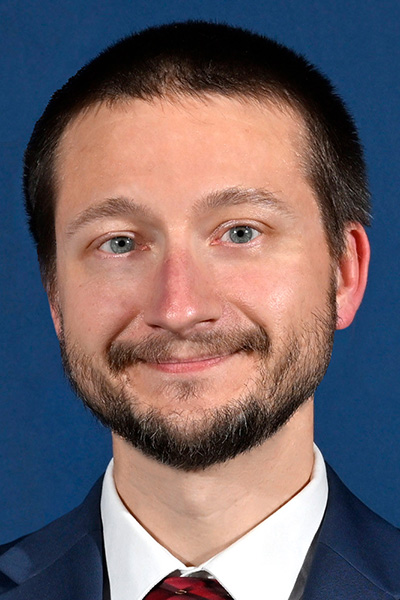
Mechanical and aerospace engineering alumnus Christopher John Ruscher ’09, G’11, G’14, has been named by the American Institute of Aeronautics and Astronautics (AIAA) as the AIAA Engineer of the Year. Ruscher is the vice president and a senior research engineer for Spectral Energies, LLC.
The AIAA will present the award during the AIAA Awards Gala on Wednesday April 30th at the Grand Hyatt Washington in Washington, DC. The institute also will recognize its Class of 2025 Honorary Fellows and Fellows at the AIAA Awards Gala.
The AIAA Engineer of the Year Award is presented to a member of the Institute who has made a recent individual technical contribution in the application of scientific and mathematical principles leading to a significant technical accomplishment.
Rusher was recognized “for the design, development, integration, and demonstration of a robust pressure sensor on a hypersonic sounding rocket and F404 engine test.”
The AIAA is the world’s largest aerospace technical society with nearly 30,000 individual members from 91 countries.
Ruscher earned his bachelor’s, master’s and doctoral degree from Syracuse University’s College of Engineering and Computer Science in the department of mechanical and aerospace engineering.
‘Cuse Baja: The Road Ahead

Ian Storrs ’24 joined ‘Cuse Baja as a wide-eyed freshman eager to build off-road vehicles for rough terrains. But to his surprise, the club once known for participating in rugged vehicle competitions had seemingly lost its drive. The impact of the pandemic, coupled with former members graduating, left the student organization without guidance. The club’s off-road vehicle was also just a frame, and the remaining members didn’t know how to complete it. As the club’s numbers began to dwindle, Storrs knew he had to do something.
Assuming the position as the club’s leader, Storrs worked hard to rebuild ‘Cuse Baja from the ground up, focusing on recruiting and training the next generation of engineers to take the wheel. Today, ‘Cuse Baja is a thriving student organization that actively competes across the country and the off-road vehicle that was nothing more than a simple frame is now breaking records.
“The development of our current car has been a long road. With a large amount of reverse-engineering and scrappiness, we managed to cobble together a functional car,” says Storrs.
Despite challenges in their early competitions, ‘Cuse Baja didn’t let any roadblocks slow them down. And in September 2024, the club would set new records at the Baja Society of Automotive Engineers (SAE) competition held in Michigan. After undergoing rigorous inspections, the team competed at different events that tested their vehicle’s acceleration, maneuverability, suspension and traction as well as rock-crawling ability.
The final event on the last day of the competition was the endurance race, where each team that passed inspections strives to complete as many laps as possible in 4 hours. ‘Cuse Baja was able to complete 15 laps, which was more than double the six laps they completed in a previous competition, making history as the best a Baja team had done at the University in over 20 years.
“We had gone from having never been to a competition to being legitimately competitive in only one year,” says Storrs. “Prior to us, a Baja team from SU had not raced at a competition in 20 years, so we are enormously proud of our accomplishments.”
“This year was filled with many great successes allowing our team to meet multiple goals,” says aerospace engineering student Laney Price ’27. “However, when I look back at Michigan, I will not remember our scoring. I’ll remember the excitement our team felt and expressed during that week when we worked through many obstacles to reach that success.”
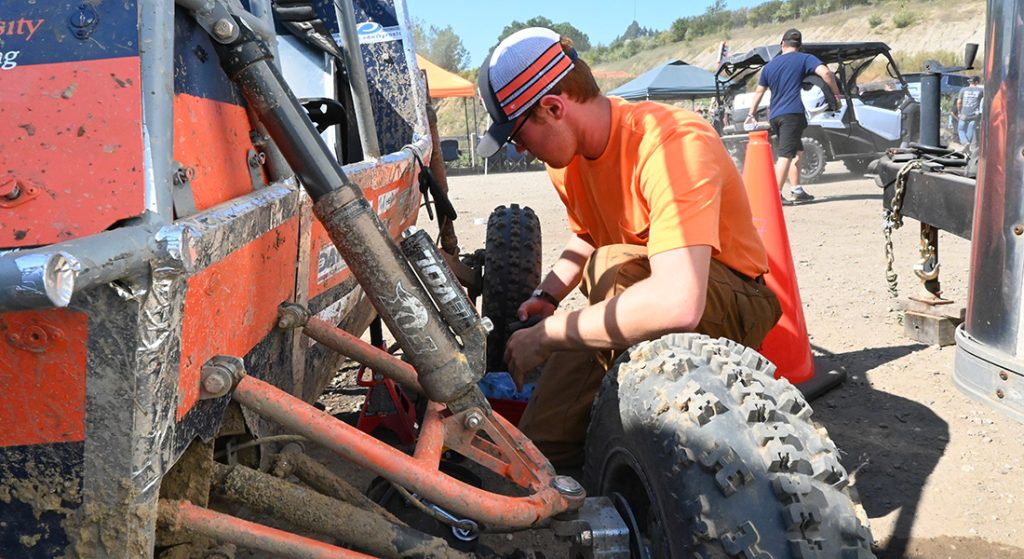
Through Cuse Baja, Storrs has connected with other students who share his passion for designing and building off-road vehicles and gained hands-on experience in engineering through machining and welding. As president and chief engineer, he has also developed valuable leadership skills that have strengthened his team-building and project management abilities.
“Throughout my leadership, I have made it my number one priority to recruit and train the next generation of ‘Cuse Baja members who will be able to grow the team after I have graduated,” says Storrs. “Our current success is due to the large influx of passionate and interested members over the past year, who have shown great initiative in learning and leading the team.”
“I became a member at the beginning of the 2023 school season and have witnessed ‘Cuse Baja grow so much since I’ve been on the team,” says mechanical engineering student Riehen Walsh ’27. “With a new generation car being designed and an ever-growing connection with the local Syracuse community, I look forward to seeing what the team can become in the upcoming years.”
Even as Storrs prepares to graduate, he believes the club will continue to thrive. “Baja and the other engineering teams are an invaluable addition to the ECS community, and are, in my opinion, undervalued. We provide practical and hands-on experience to students, which is something that cannot be taught in class. I hope that through our continued success and growth, we can further prove our value to the engineering community.”
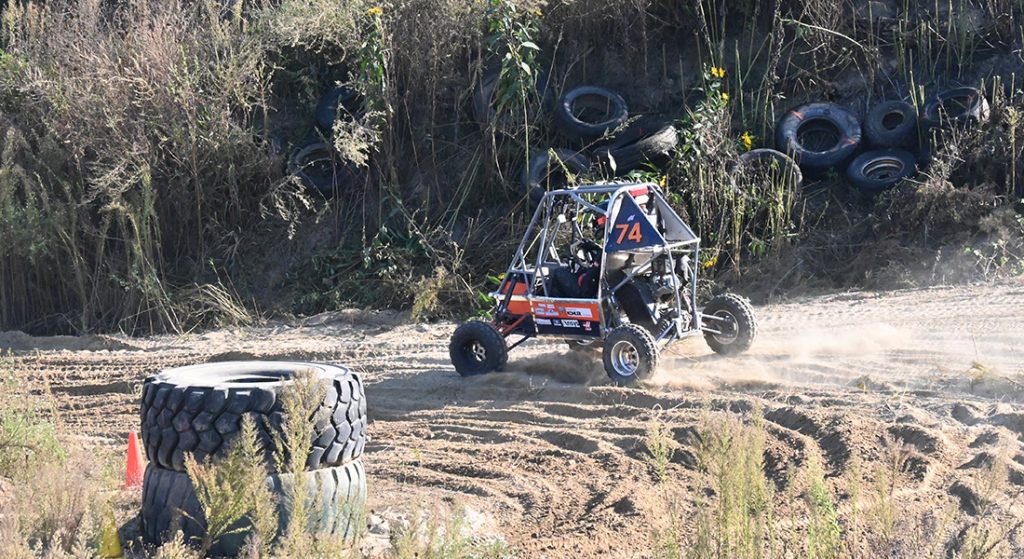
Mechanical and Aerospace Engineering Alumna Spotlight: Emily Greaney ’21 G’22
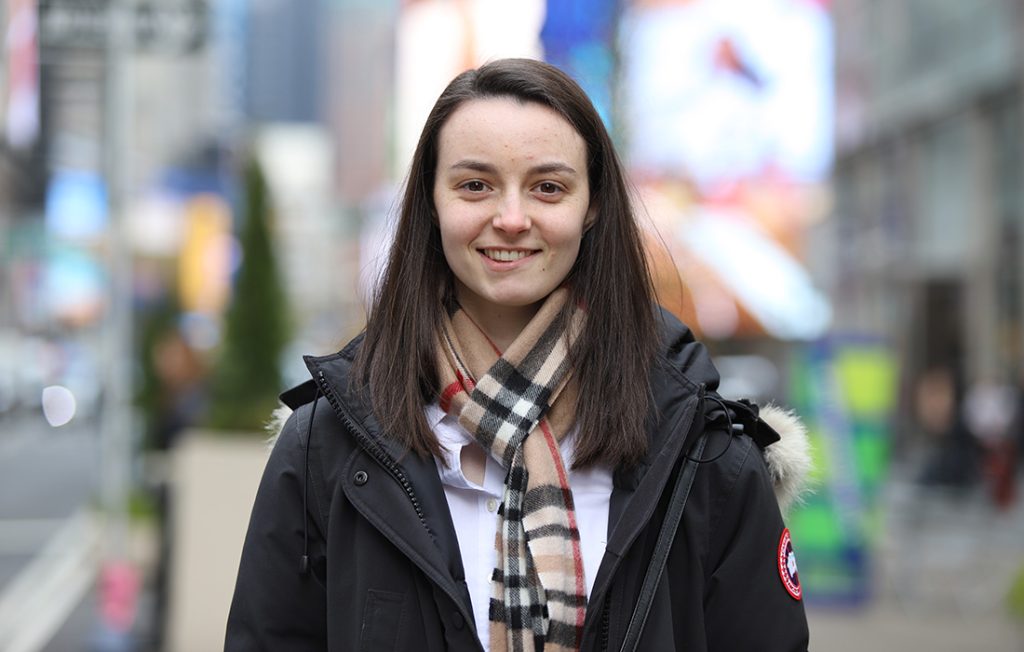
When Emily Greaney ’21 G’22 faced the decision of where to attend college, she pictured a place that embodied the typical college experience – a campus with a beautiful landscape, great academic programs, and a vibrant school spirit with athletics and club sports. So when she came across Syracuse University during her search and saw everything the University had to offer, she knew it was the place to be.
“The programs were good, the campus had a collegiate feel, and it wasn’t too far from my home in New Jersey. I started playing ice hockey in high school senior year and SU had a club and D1 team, so it was an ideal school for me,” Greaney says.
Before graduating high school, Greaney initially planned to become a physical therapist but pivoted to engineering when she attended a summer camp at Stevens Institute of Technology in New Jersey. This experience would be crucial to discovering her passion for mechanical engineering.
“The summer camp touched on each engineering discipline. The mechanical module came up and we were playing soccer with robots” says Greaney. “It was taking all the things I loved, math, science, and physics, and putting it all together. After that, I knew mechanical was the way to go.”
Enrolling in the College of Engineering and Computer Science (ECS) as a mechanical engineering student, Greaney experienced what life at SU was all about. Joining clubs and connecting with others, she also got the chance to play ice hockey and find community among like-minded individuals.
“I really liked how welcoming the staff at ECS was. It was an environment where I never felt unsafe and felt that I belonged there,” she says. “They fostered that environment and my overall experience at Syracuse was great. There was always something to do, and I appreciated how the campus catered to anyone’s interest.”
Graduating from ECS with her bachelor’s in 2021 and her master’s in 2022, Greaney now works as a Generator Insulation and Non-Metallic Mechanical Engineer at General Electric (GE) Vernova. GE Vernova primarily focuses on energy generation, decarbonization, building power plants, and wind turbines. In her current position, Greaney works on the insulation that goes on copper bars inside power plant generators.
“In our power plants, we have generators. Those are what create the electricity that goes to the power grid. I’m working on the insulations that go around the copper bars that sit inside those generators.”
Greaney also runs a mechanical testing lab where a material’s mechanical properties are examined to see if they’re suitable for use. She’ll often start her day by going to the manufacturing floor of the building to see what’s going on. These workplace walkthroughs, known as “Gemba walks”, help management understand the work being done and engage with employees. Gemba walks derives from the Japanese word “Gemba” which means “the real place.”
“Gemba is where you actually go to where things are happening. You talk to the people, you understand what issues you’ve been experiencing for the past 24 hours and that kicks off your day on what you need to focus on or prioritize. I go there to understand what issues they’ve been experiencing and if that will be applicable to projects I’m working on.”
Greaney has also been interfacing with the mechanical manufacturing shop to create some samples for mechanical testing in her lab among other projects. She loves that her job continually keeps things interesting, and it goes hand-in-hand with her passion for sustainability.
“My advice to students would be to find your passion. I’m into sustainability and use this passion to contribute to making the world a better place. Whatever your passion is, find it since that will make you not dread your job.”
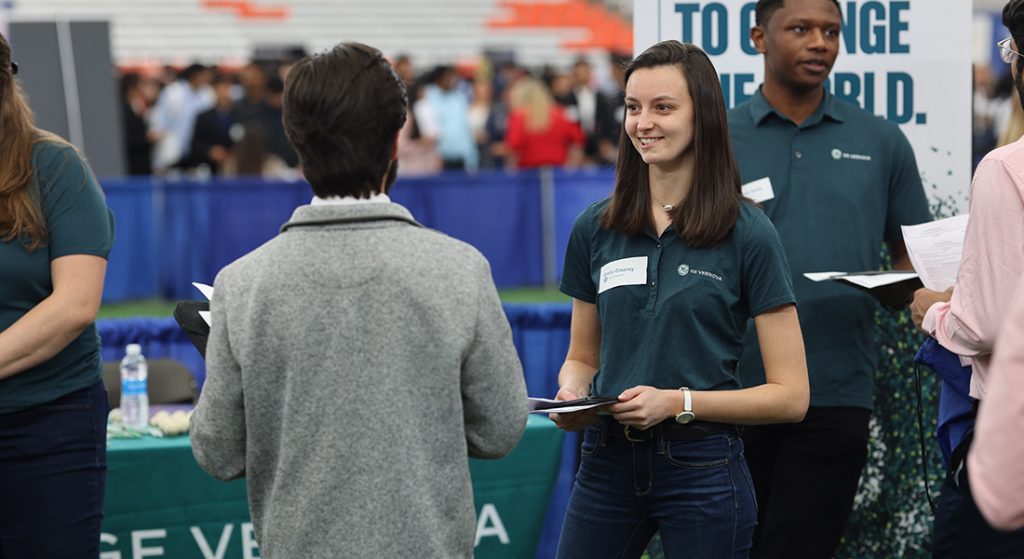
Mechanical and Aerospace Engineering Professor Quinn Qiao Named as Interim Associate Dean for Research

Mechanical and Aerospace Engineering Professor Quinn Qiao has been named Interim Associate Dean for Research (ADR) in the College of Engineering and Computer Science.
Qiao joined Syracuse University in 2020. He has published over 200 papers in leading journals with topics ranging from battery storage and photovoltaics to sustainability and precision agriculture, establishing him as a global leader in electrical and materials engineering research. He has more than 16,000 citations on Google Scholar and received funding from a wide range of federal and industrial sources.
Qiao has experience in building and promoting successful interdisciplinary research teams as the Site Director for the National Science Foundation (NSF) Industry-University Cooperative Research (IUCRC) Center for Solid-State Electric Power Storage (CEPS) at Syracuse University. He is also a campus lead at Syracuse University for the NSF Regional Innovation Engines New Energy New York led by Binghamton University and a recipient of the NSF CAREER Award in 2010.
“Quinn Qiao possesses exceptional research expertise, and his colleagues throughout the College have truly come to admire his passion and excitement for innovation since he came to Syracuse University,” says Dean J. Cole Smith. “His experience and proven ability to build successful interdisciplinary teams will be crucial for advancing our College’s research initiatives to new heights.”
“I am honored to step into this ADR role to build on the numerous successes that have been achieved, maintain the great momentum ECS currently has, grow new research areas to broaden the funding opportunities, partner with industry to advance technology and develop the workforce, and support our faculty and students to continue to innovate and succeed in a competitive world,” Qiao says. “We will certainly encounter new challenges, but I am confident that with the determination and persistence of our highly talented faculty and students, we will continue to grow as a leader in engineering fields.”
Mechanical and Aerospace Engineering Faculty Spotlight: Lihong Lao
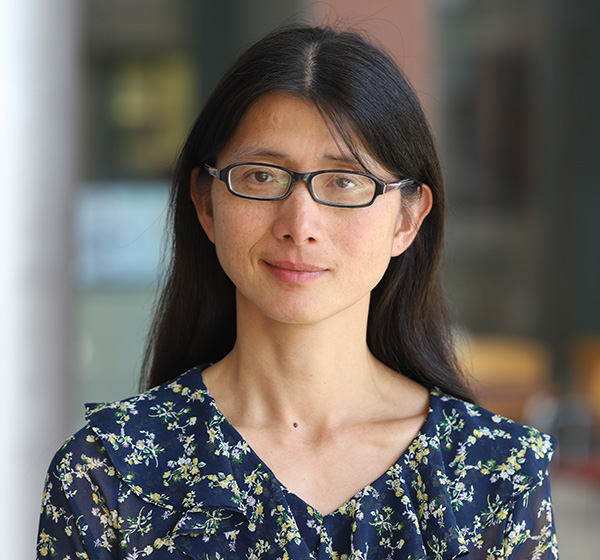
Lihong Lao joined the College of Engineering and Computer Science (ECS) at Syracuse University as an Assistant Professor at the start of the Fall 2024 semester. Lao received her Ph.D. in Fiber and Polymer Science from Cornell University. Lao leads the Environmental Control Materials (ECM) Lab. During the Spring 2025 semester, she will also teach a graduate-level course on polymer materials. Read on for more details about Lao’s research.
Question: Can you give us a brief overview of your research lab?
Professor Lao: My lab focuses on understanding the interaction among the human body, buildings and environment, and improving their performance by developing advanced materials and smart systems. We aim to design smart materials for thermal, moisture and air quality management for the human body and the built environment. Particularly, we use biomimetic approaches inspired by nature for the materials design and engineering based on polymers, fibers, textiles, soft materials, smart materials and advanced manufacturing.
The lab is an interdisciplinary research group within the Department of Mechanical and Aerospace Engineering and is associated with the Syracuse Center of Excellence in Environmental and Energy Systems (SyracuseCoE) and the BioInspired Institute. Our research spans the fields of chemistry, chemical engineering, materials science, mechanical engineering, system engineering and architecture. Our goal is to contribute both scientific fundamentals and practical technologies to serve some global challenges such as human health, environment, energy and sustainability.
Question: Tell us about your current research — are there any projects you’re working on that you’re especially enthusiastic about?
Professor Lao: The research topics in our lab include, but are not limited to:
- Design of smart materials (e.g., stimuli-responsive materials, bio-inspired design, 3D printing)
- Personal thermal and moisture management (e.g., smart textiles, surface wettability, thermal regulation, directional liquid transport)
- Smart building and environment control (e.g., thermal regulation, ventilation control, air quality improvement).
I am particularly excited about developing new materials with self-thermoregulation properties and applying them in smart and green buildings towards energy-saving and sustainability.
Question: What do you like about working at 727 East Washington Street?
Professor Lao: The building is very beautiful and has so many flexible spaces. The indoor thermal condition and air quality are monitored and optimized, making it a comfortable place to work. More importantly, the people are extremely nice, and many faculty members, staff members and students have supported me to quickly adapt to this new environment.
Automotive Engineering Course Focuses on Vehicle Design and Development
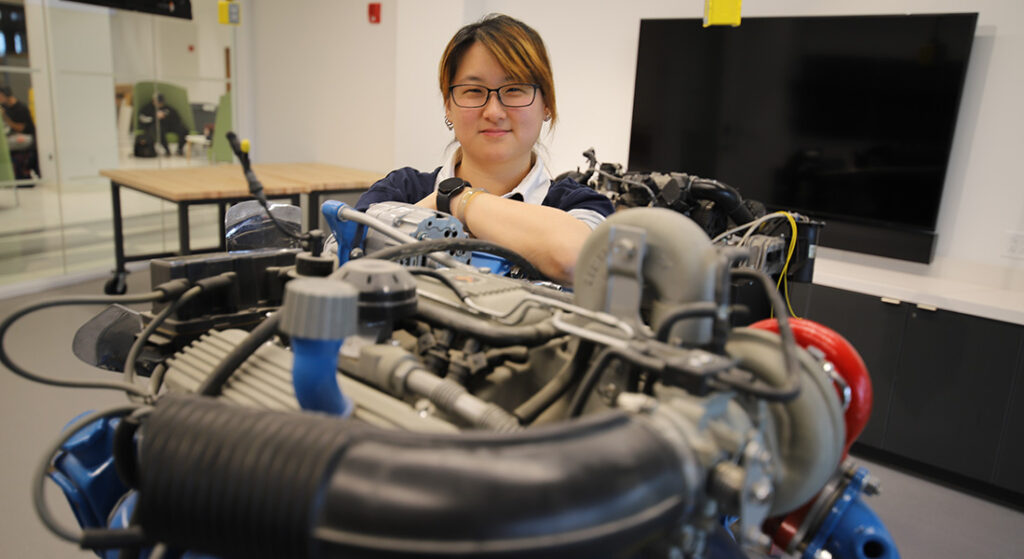
Automotive Engineering (MAE 457) is a course designed to equip students for careers in the automotive industry and a variety of other fields. This course will ignite students’ curiosity to explore the design and development of different vehicle engines and will be taught by Mechanical and Aerospace Engineering Professor Andrea Shen. The course will also cover new topics in automotive engineering, including hybrid and electric vehicles.
Students in MAE 457 will learn about how internal combustion engines work, the significance of biofuels, vehicle dynamics, and how different factors impact engine performance. They will also have hands-on learning experiences with engines, observing the functions of a diesel engine and gasoline engine located in Link Hall. Additionally, each student will complete a project where they will conduct research on a vehicle of their choice.
The course will also feature guest speakers from companies such as Space X, Ford, Harley Davidson, Sierra Space, Roush Yates, Cummins and Caterpillar, and students will have an opportunity to interact with these industry professionals.
“I’m hoping students will gain an appreciation for cars,” says Shen. “They will gain an understanding of all the things that go on in the car and how they interact with each other. I also want to bring awareness on biofuels and the importance of research on combustion engines and automotives in the face of electric vehicles.”
Shen earned her bachelor’s and master’s degrees at Virginia Tech and her Ph.D. at the University of Wisconsin-Madison in the Engine Research Center. She will incorporate her research focuses on gasoline engines, biofuels, and engine performance as well as creating representative models of different base fuels into the course.
Mechanical and Aerospace Engineering Student Spotlight: Fatimata Gory ’26
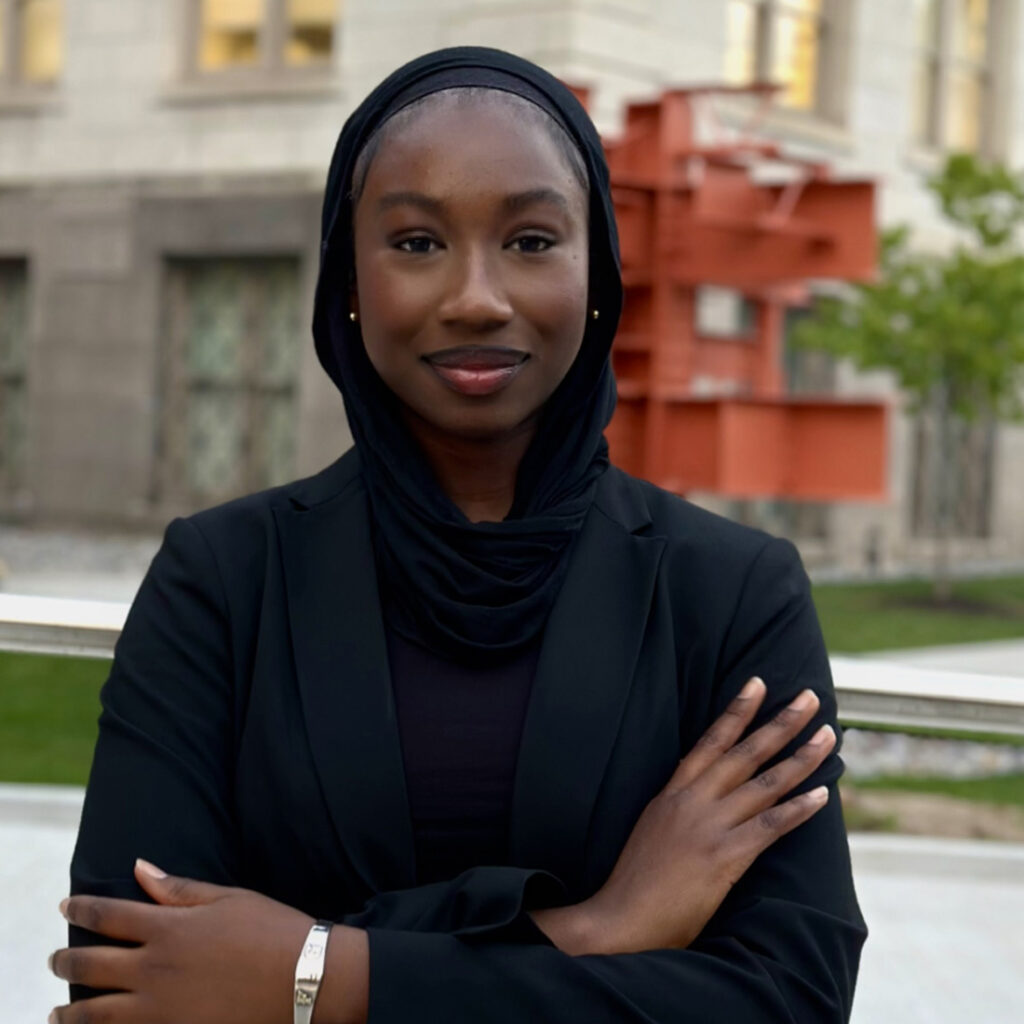
When Fatimata Gory ’26 left her home country Senegal to study in the United States, she never imagined becoming a peer leader, running academic workshops, or holding positions in student organizations. However, with the right community and a healthy support system, Gory has been able to thrive in her academics, participate in hands-on research and make the most of her experience in the College of Engineering and Computer Science (ECS).
“The language barrier was challenging when I first moved,” says Gory. “But I learned to adapt, be more open to people, got to know my professors and found friends in my major to help me in areas where I struggled. Now that I’m more involved, I find it more enjoyable.”
Gory initially planned to attend State University of New York (SUNY) Oswego but after a few interactions with Associate Director for Undergraduate Admissions and Recruitment, Jonathan Hoster, she had a change of mind. “Jonathan was a big help. My sister was talking to him at the time, and I saw how much he was reaching out, talking to my family, and helping with financial aid,” says Gory. “It was comforting coming to this country for the first time not knowing a lot of people and there was someone who cared and willing to help me.”
Enrolling in ECS as an aerospace and mechanical engineering student, Gory was interested in the design aspect of aerospace after taking a solid mechanics course her first year. Now, Gory works as a research assistant in the Composite Material Lab where she focuses on frontal polymerization. Frontal polymerization is a chemical reaction that turns a liquid monomer into a solid polymer. In the lab, they use UV light to initiate frontal polymerization, which helps control the curing process in 3D printing applications.
“Working in the lab has been a very hands-on experience. I had to redesign the 3D printer head to accommodate continuous carbon fiber printing, which was key in making the process more automated and reducing manual intervention.” says Gory. “It’s been exciting to work in such a cutting-edge area of composite manufacturing, especially with the potential to apply these techniques in fields like aerospace or repair applications where quick, reliable material production is essential.”
On top of thriving in her academics, Gory is an active member of ECS. She’s the treasurer of the National Society of Black Engineers, assistant treasurer of the Society of Women Engineers, and an energy analyst for the Industrial Training and Assessment Center. Gory is also a peer leader and Academic Excellence Workshop (AEW) facilitator. Additionally, her lab research earned her an honorable mention from the Universities Space Research Association (USRA.) With a wealth of experience across ECS, she urges students to connect with peers, faculty and staff as well as being open to trying new things.
“I love being an AEW facilitator. I enjoy working with Jonathan, meeting with new students, talking to student panels and giving them advice. Before coming to college, I didn’t have that mentorship so it’s nice to be that for other students.”
Syracuse University Faculty and Staff Attend Department of Energy Peer Review in Washington, DC
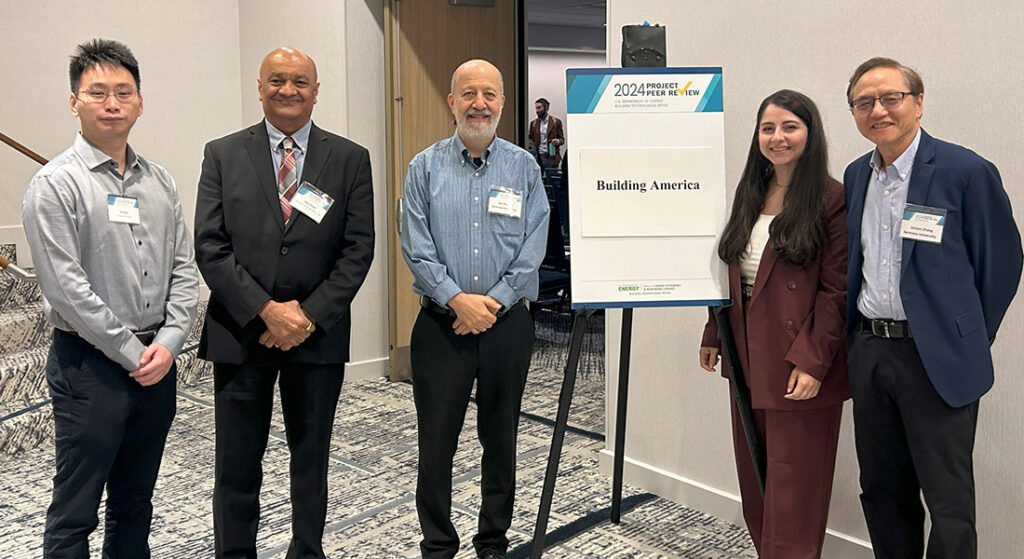
Multiple faculty and graduate students affiliated with the Syracuse Center of Excellence in Environmental and Energy Systems (SyracuseCoE) traveled to Washington, DC to participate in the U.S. Department of Energy (DOE) Building Technologies Office (BTO) 2024 Peer Review. As BTO’s signature event, this annual peer review process brings together academics, practitioners, and policymakers in the building sector.
Bess Krietemeyer, Associate Professor in the School of Architecture (SOA), led a presentation on SU’s Advanced Building Construction award, “Integrated Whole-Building Energy Efficiency Retrofit Solution for Residences in Cold/Very Cold Climates.” Using a demonstration site on Syracuse University’s South Campus, Professor Krietemeyer’s team is developing a method for retrofitting single-family residences. By leveraging insulated panels and prefabricated systems, they can create significant energy savings and improve indoor air quality with minimal disruption to building occupants.
Ian Shapiro, Professor of Practice in the Department of Mechanical and Aerospace Engineering (MAE) and Associate Director of Building Science and Community Programs, gave a presentation on SU’s Building America Project to improve the heat pump efficiency by reducing applied energy losses. SOA Assistant Professor Nina Wilson presented another Building America project led by Cycle Architecture + Planning, a SyracuseCoE Partner Program member, which will focus on field validation projects for residential retrofit solutions.
Three MAE Ph.D. students, who played key roles in SU’s DOE projects, participated in the peer review: Shayan Mirzabeigi, Sameeraa Soltanian-Zadeh and Ji Zhou. Sameeraa also attended workshops and gatherings specifically for DOE IBUILD Graduate Research Fellows.
SyracuseCoE collaborators represented at the BTO event included Taitem Engineering, Association for Energy Affordability, Cycle Architecture + Planning, and Hydronic Shell Technologies. Jianshun “Jensen” Zhang, Executive Director of SyracuseCoE and MAE Professor also participated in the 2024 Peer Review.
“The annual BTO peer review meeting was a great opportunity for researchers and practitioners to learn about the wide range of high-impact projects supported by DOE, exchange knowledge and explore new collaboration ideas in addition to a rigorous review of the various funded projects,” said Professor Zhang. “It was exciting and gratifying to see so many SU faculty, students and collaborators participating and presenting findings from pioneering research sponsored by DOE at this event.”
DOE’s BTO works to develop cost-effective tools and technologies that make residential and commercial buildings more energy efficient. Supporting an equitable transition to a decarbonized energy system, BTO works in three key areas: research and development, market stimulation and building codes and equipment standards.
Tong Lin
Lab/ Center/ Institute affiliation:
- Syracuse Center of Excellence in Energy and Environmental Systems – Analysis and Design Center
Areas of Expertise:
- Computational Fluid Dynamics (CFD)
- Turbomachinery Design and Performance Analysis
- Air Purification, Ventilation, and Indoor Air Quality (IAQ)
- Airborne Pathogen Transmission Risk Mitigation
Professor Lin specializes in computational fluid dynamics, turbomachinery design and performance analysis, with a particular focus on the interaction between turbomachinery and flow resistance systems to enhance pressure rise and energy efficiency. His expertise extends to improving indoor air quality through the development and optimization of ventilation and air purification systems, including technologies such as UV germicidal irradiation, photocatalytic oxidation, and ionization systems. Dr. Lin actively researches strategies to mitigate airborne pathogen transmission risks in indoor environments, employing both experimental analyses and modeling approaches to devise effective solutions.
Honors and Awards:
- 2019 Research Excellence Doctoral Funding (REDF) Fellowship
Selected Publications:
- Lin T, Pan Y, Sarimurat M, Dang T. System Performance of Highly Coupled Fan and High- Resistance Medium. IEEE Transactions on Components, Packaging and Manufacturing Technology. 2023; 13(9):1399-1409. Available from: https://ieeexplore.ieee.org/document/10217016/ DOI: 10.1109/TCPMT.2023.3305091
- Wang L, Lin T, Da Costa H, Zhu S, Stockman T, Kumar A, Weaver J, Spede M, Milton D, Hertzberg J, Toohey D, Vance M, Miller S, Srebric J. Characterization of aerosol plumes from singing and playing wind instruments associated with the risk of airborne virus transmission. Indoor Air. 2022 June 13; 32(6):-. Available from: https://onlinelibrary.wiley.com/doi/10.1111/ina.13064 DOI: 10.1111/ina.13064
- Lin T, Sarimurat M, Dang T. Flow Interaction Between Cascade and Flow Resistance Medium. Volume 6: Education; Electric Power; Energy Storage; Fans and Blowers. ASME Turbo Expo 2023: Turbomachinery Technical Conference and Exposition; Jun. – ; Boston, Massachusetts, USA. American Society of Mechanical Engineers; c2023. Available from: https://asmedigitalcollection.asme.org/GT/proceedings/GT2023/86991/V006T10A002/1168053 DOI: 10.1115/GT2023-101271
- Zhu S, Lin T, Wang L, Nardell E, Vincent R, Srebric J. Ceiling impact on air disinfection performance of Upper-Room Germicidal Ultraviolet (UR-GUV). Building and Environment. 2022 October; 224:109530-. Available from: https://linkinghub.elsevier.com/retrieve/pii/S0360132322007600 DOI: 10.1016/j.buildenv.2022.109530
Syracuse University Receives Department of Energy Funding for New Building Training and Assessment Center
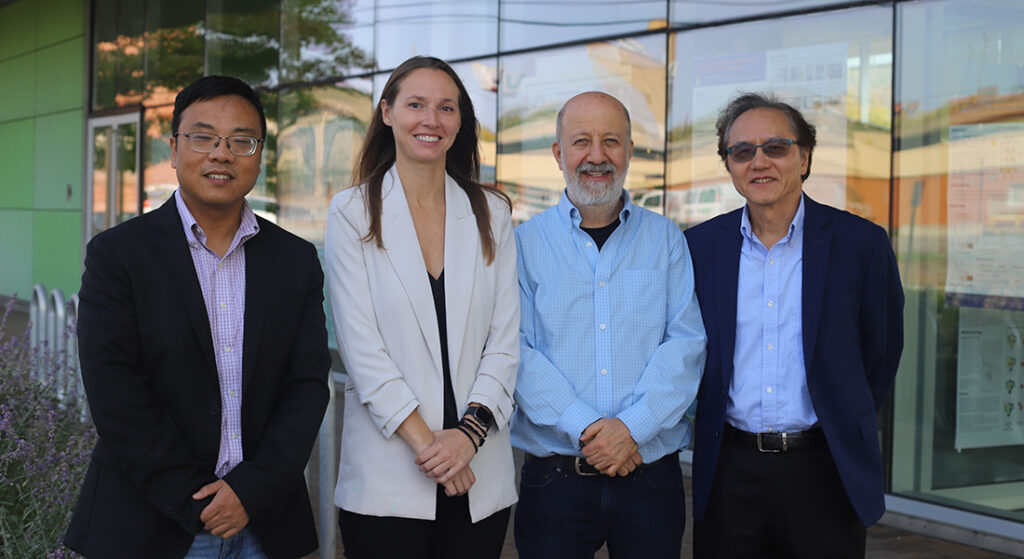
Syracuse University has received funding from the U.S. Department of Energy (DOE) to create a new Building Training and Assessment Center (BTAC) to train undergraduate and graduate engineering students and build a clean energy workforce. The SU-BTAC, aligned with the vision of the DOE BTAC program, will educate and provide hands-on training for engineering students to perform assessments focused on reducing the energy burden for commercial and institutional buildings with a focus on disadvantaged communities.
The SU-BTAC will be housed at the Syracuse Center of Excellence (SyracuseCoE), New York State’s Center of Excellence in Environmental Energy Systems which engages more than 200 private companies, organizations, and academic institutions to create new products and services in indoor environmental quality, clean and renewable energy, and water resource management. With SyracuseCoE, the SU-BTAC will create relationships and company screening opportunities to connect commercial and institutional buildings with existing programs in the region relating to unions, apprenticeships, trade organizations, community programs, and others.
“I see the SU-BTAC as an expansion of the Syracuse University Industrial Assessment Center (SU-IAC), now SU-ITAC, and as a great experiential learning opportunity for our students. Not only are we able to help commercial and institutional buildings with reducing their energy burden, but we are also able to teach and mentor the next generation of energy engineers,” says Jackie Anderson, director of IAC and associate teaching professor in mechanical and aerospace engineering.
SU-BTAC will be led by faculty from Syracuse University and supported by faculty from the City University of New York (CUNY). The center will be co-directed by Professor Ian M. Shapiro, with involvement from professors Jensen Zhang and Bing Dong.
Mechanical Engineering Capstone Design Teams Begin Working On Industry Sponsored Projects
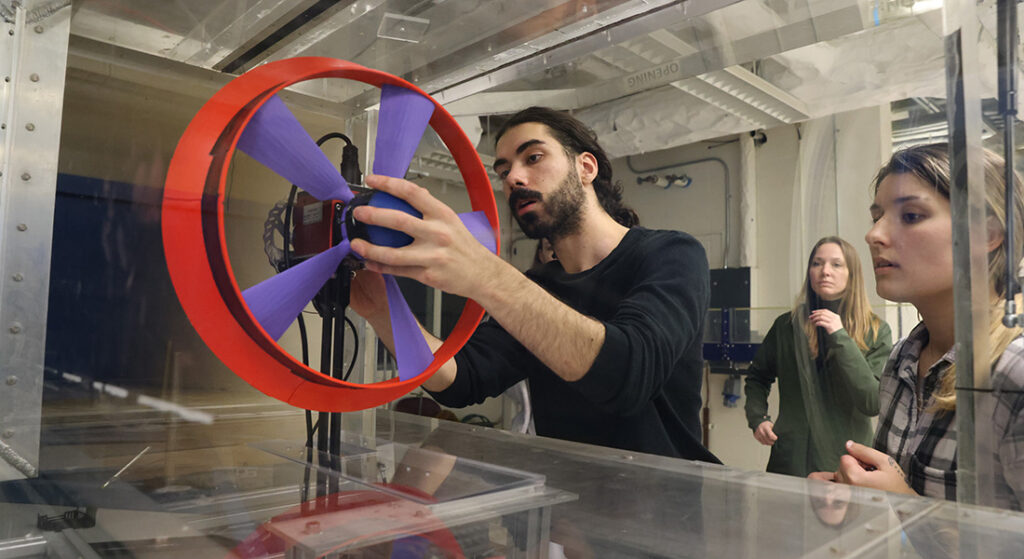
The 2024-2025 mechanical engineering senior capstone design teams have been formed and are now working on 15 industry-sponsored projects. This year’s sponsors include renowned organizations such as NASA, Lockheed Martin, Boeing, Eaton Corporation, Carrier Corporation, Dupont, Advion Inc., Aerovec Inc., Pursuit Aerospace, ASHRAE and TTM Technologies, as well as a number of start-ups including Automated Biomass Systems, RedCat, SoldyneX LLC, and TensilasticEnergy.
“We are grateful to all of our company sponsors for collaborating with our students, and delighted that some sponsors are alumni of the program. The diversity of projects is incredible and will allow our students to apply the knowledge they’ve gained from their core courses in the College of Engineering and Computer Science at SU,” says Kenneth and Mary Ann Shaw Professor of Practice in Entrepreneurial Leadership Alex Deyhim. “The practical experience they gain from the capstone projects is invaluable, and we’re excited to see the incredible work our students will accomplish over the course of two semesters.”
Clamped In: Student Inventors Develop New Way to Secure Wheelchairs in Moving Vehicles

Former Syracuse University student Jim DaRin is one of many wheelchair users who rely on adapted vehicles to drive. These vehicles are equipped with a docking system designed to secure the wheelchairs in place while users focus on the road. However, even when the wheelchair is locked in, it’s not completely secure, causing DaRin to move back and forth while driving.
“The docking system moves and I’m rocking back and forth. I’m paralyzed from my waist down and have my hands on the steering wheel and throttle. It’s not secure or safe,” says DaRin. “The wheelchair’s pin also has a tendency to get caught on certain surfaces and the bolt drags on the pavement.”
DaRin is far from the first to complain about docking systems for adapted vehicles, but very few attempts have been made to fix these issues. That’s when he reached out to engineering students Davis Hood ’26 (electrical engineering), Jennifer Mason ’26 (mechanical engineering), Matthew Pinto ’27 (biomedical engineering), and Carter Thompson ’26 (aerospace engineering) to explore ways to improve his docking mechanism.
“I showed them the challenge I was having and the problems with my current docking system,” DaRin says.
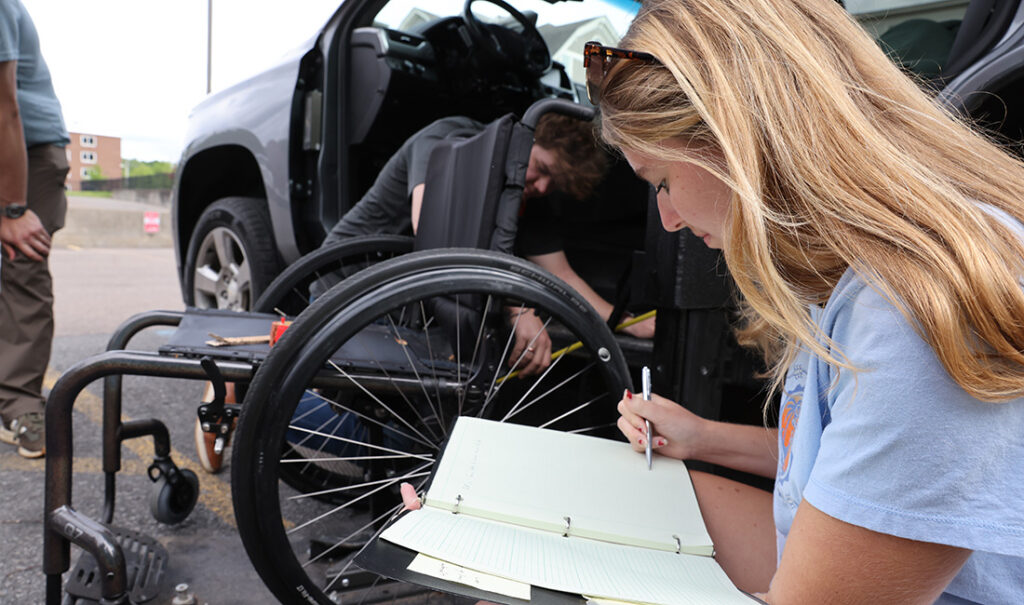
As part of Invent@SU, a six-week summer program where student teams prototype, design and pitch original devices to judges, Hood, Mason, Pinto and Thompson created MagniClaw, a device that securely locks wheelchairs in moving vehicles. Their device has a lightweight bar attachment on the back of the wheelchair and a docking mechanism that holds a clamping and electromagnet.
“We’ve gone through multiple different design iterations, and we are always trying to keep in mind Department of Transportation standards,” says Hood. “Our device is easy to use, has a universal design, and can go on a majority of manual wheelchairs.”
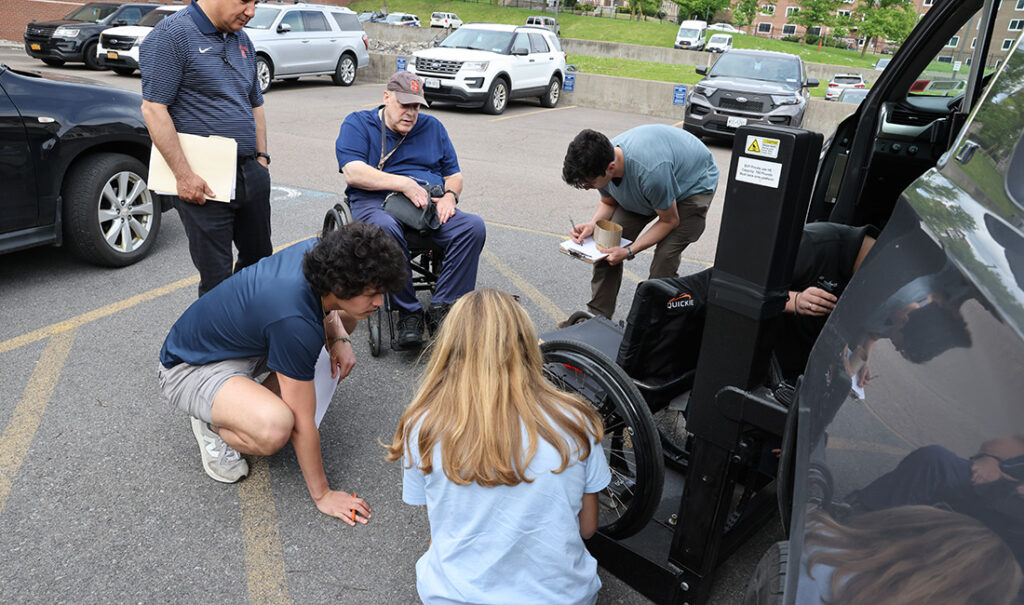
MagniClaw’s lightweight attachment can easily be connected to wheelchairs using two small clamps. Once attached, the user can connect to the docking frame. The attachment has a steel plate in the center that interacts with the electromagnet to securely hold the wheelchair in place.
“Our device has a clamping mechanism. With this, wheelchair users can back into clamps without any extra input from the control center and the clamp’s shape provides enough security for the electromagnet to turn on,” says Pinto.
The electromagnet, which holds the wheelchair in place, can pull up to 600 lbs. and is activated by a remote. The remote has a Bluetooth feature that can communicate whether the electromagnet is on or off.
“All wheelchair users have to do is back up and the system gets locked in, holding them in place until they press a button that activates the electromagnet. They’re held for the car ride, and when they’re done, they press a button to release the electromagnet and they can roll away freely,” says Mason.
MagniClaw’s hitch-less design and customizability not only set it apart from competitors but also provide more freedom and mobility for wheelchairs with an easier docking system. They showcased their original device at Invent@SU’s final presentations to a panel of 14 expert judges and guests, including faculty, staff, Dean Cole Smith, Syracuse University Life Trustee Bill Allyn, and program supporter Mike Lazar. The team tied for second place, winning a cash prize of $1,200.
“It was nice to have a broad spectrum of engineers in our group. It also feels great to help Jim out,” says Thompson.
“My previous docking system was not good. Their system is a hundred times better,” says DaRin. “It’s much more safe and secure. The potential for MagniClaw is huge.”
“Mr. Jim Darin, a former student of Syracuse University, approached me with a problem that he hoped an Invent@SU team could solve,” says Kenneth and Mary Ann Shaw Professor of Practice in Entrepreneurial Leadership Alex Deyhim. “It was amazing to watch the students work directly with Mr. Darin to design and prototype MagniClaw, a magnetic wheelchair docking system that could be helpful to the millions of Americans who use wheelchairs full-time. This project is a wonderful example of what our students can accomplish when they work across engineering disciplines.”
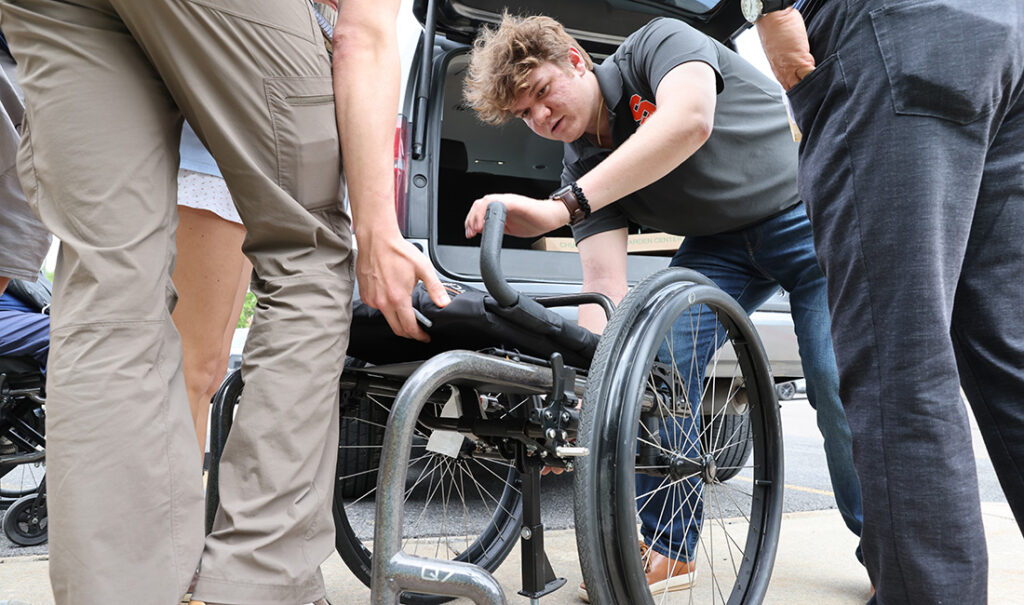
Mechanical and Aerospace Engineering Ph.D. Student Xuezheng Wang G’21 Awarded Rare ASHRAE Grant
Mechanical and aerospace engineering Ph.D. student Xuezheng Wang G’21 has been selected to receive an American Society of Heating and Air-Conditioning Engineers (ASHRAE) Graduate Student Grant-In-Aid for the 2024-2025 academic year.
Mechanical and Aerospace Engineering Student Sameeraa Soltanian-Zadeh Joins Innovation in Buildings (IBUILD) Graduate Research Fellowship
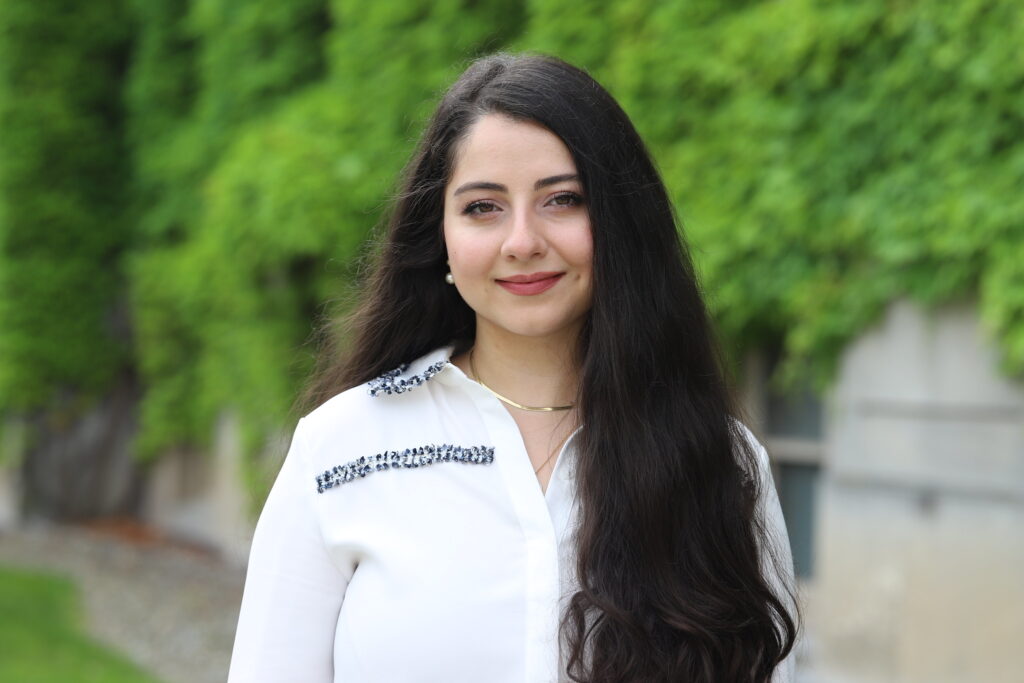
Sameeraa Soltanian-Zadeh ’26, a third-year Ph.D. student in mechanical and aerospace engineering, has been selected as an Innovation in Buildings (IBUILD) Graduate Research Fellow by the US Department of Energy (DOE). The fellowship is managed by Oak Ridge National Laboratory (ORNL) and administered by Oak Ridge Institute for Science and Education (ORISE).
The Graduate Research Fellowship aims to support the number of well-trained, diverse graduate student scholars prepared for research-intensive careers in fields supporting decarbonization. Recipients of the fellowship will receive financial support to conduct research at their home institution in an area that has shown relevance to advancing decarbonization efforts. Soltanian-Zadeh’s research focuses on indoor air quality and urban environmental dynamics, highlighting the effects of occupant behaviors on indoor air quality and building energy efficiency. This research will contribute to environmental justice, offering insights into public health, energy efficiency, and sustainable urban development, especially regarding the role of building occupants.
“By focusing on the intersection of indoor air quality, occupant behavior, and energy efficiency, my work has the potential to significantly impact how we design and operate buildings in the future. This research is crucial as we strive to create healthier, more sustainable urban environments while simultaneously tackling the urgent need for decarbonization,” says Soltanian-Zadeh. “Receiving the prestigious IBUILD fellowship marks a significant milestone in my academic journey and research career.
“This fellowship supports my ongoing work and is a step forward in my mission to create healthier, more sustainable built environments. The IBUILD program offers great opportunities to grow my skills, connect with other researchers, and learn about new developments in building science. Ultimately, it will help me contribute to a future where buildings not only meet energy needs but also enhance air quality and promote healthier living environments for all. I also want to thank my advisor, Professor Jianshun ‘Jensen’ Zhang, for his continuous support and guidance.”
“Sameeraa has made excellent progress in her Ph.D. study and played a key role in the project on ‘Integrated Whole-Building Energy Efficiency Retrofit Solution for Residences in Cold/Very Cold Climates’ and the Building America project on ‘Reducing Applied Losses in Heat Pumps’, both sponsored by DOE as well as the project on developing a multiscale building and urban environmental and energy monitoring systems supported by Syracuse Center of Excellence (SyracuseCOE)”, says Professor Jensen Zhang, Executive Director of SyracuseCOE and Soltanian-Zadeh’s Ph.D. study advisor.
Karen Martinez Soto
Areas of Expertise:
- Curriculum Development
- Conceptual Understanding and Conceptual Change
- Classroom Assessment and Evaluation
- Dynamics and Control of Atmospheric Vehicles
Karen Martinez Soto holds a Ph.D. in Engineering Education from Virginia Tech, complemented by an M.Sc. in Aerospace Engineering (Virginia Tech) and B.Sc. in Aerospace Engineering (The University of Oklahoma). Her research focuses on the development of aerospace curricula that support conceptual understanding, particularly in Sophomore and Junior level courses. This research includes the study of how to teach and assess student’s understanding and mastery of difficult engineering concepts. Her aerospace background focused on dynamics and control of atmospheric vehicles, particularly unmanned multi-rotor aircraft.
Honors and Awards:
- Best Student Paper Award at the ASEE Virtual Annual Conference | July 2021
- Best DEI Paper Award at the ASEE Virtual Annual Conference | July 2021
Selected Publications:
Martinez Soto, K. D., & Murzi, H., & Jurkiewicz, J., & Hernandez, R. A., Decolonization of Academia: Is the Word Latinx a Form of Colonization? ASEE Annual Conference, June 2023
Martinez Soto, K. D. & Murzi, H., Using Modular Assignments to Assess MATLAB in a First Year Engineering Course. ASEE Southeast Section Conference, March 2023
Woods, J. C., & Murzi, H., & Chowdhury, T. M., & Huggins, N., & Martinez Soto, K. D., Study Abroad While Studying Abroad: International Students’ Participation in the RSAP Study Abroad Program. ASEE Virtual Annual Conference, July 2021
Chowdhury, T. M., & Murzi, H., & Martinez Soto, K. D., & Schuman, A., Measuring the Impact of a Study Abroad Program on Engineering Students’ Global Perspective. ASEE Virtual Annual Conference, July 2021
Jorge Romeu
Lab/ Center/ Institute affiliation:
- Fulbright Roster Senior Speaker Specialist
Areas of Expertise:
- Reliability
- Quality and Industrial Statistics
- International Education
Current Research:
Dr. Romeu has over 40 years of experience in teaching, research and consulting in the areas of Reliability, Quality and Industrial Statistics at the Reliability Analysis Center (RAC), IIT Research Institute, and SUNY, where he retired Emeritus in 1998. He has been a Research Professor at SU for sixteen years and worked as a Fulbright Scholar in Mexico (1994, 2000, 2003), Dominican Republic (2004), Ecuador (2007) and Colombia (2020; cancelled due to Covid). He has taught industrial statistics, design of experiments, simulation, operations research and statistical analysis at SU, SUNY and several universities abroad.
Honors and Awards:
- Chartered Statistician Fellow, Royal Statistical Society
- Senior Member American Society for Quality (Past Regional Director for NY and PA)
- Fulbright Scholar
Selected Publications:
- Commented Summary of a Year of Work in Covid-19 Statistical Modeling. Proceedings of the 2022 Annual Meeting. American Statistical Association.
- Teaching New Quality Applications to the Next Engineering Generation. North East Quality Councils (NEQC) Proceedings of the Biannual Conference. Oct. 2018.
- On the Statistical Education of American Engineers. Reliability Analysis Center Journal (RIAC). August of 2012.
- Statistics in Support of Masonic Historical Studies. Proceedings of the 2017 Annual Meeting. American Statistical Association. In ESTADISTICA, Journal of the Inter-American Statistical Institute/IASI. (2018)
- Demographic Analysis of Cuban Blue Lodge Masons: technical discussion. In ESTADISTICA Journal of the Inter-American Statistical Institute/IASI. Vol. 63, No. 181. 2012
- On Operations Research and Statistics Techniques: Keys to quantitative data mining. Amer. Jour. of Math & Mgmt. Sciences, AJMMS, 26, 293-328. 2007.
- On the Juarez Lincoln Marti International Education Project. Amer. Jour. of Math. and Management Sciences (AJMMS). Vol. 25 No. 1 & 2, 1–25, 2005.
- Design and Evaluation of Aquatic Ecosystems via Discrete Event Simulation. Proc. of the Fed. Comm. Stat. Meth. (FCSM) Res. Conf. Washington, DC. 2003.
- Monte Carlo Investigation of a Model for Generation of Non Gaussian Radar Clutter. Proceedings of the Interface Symposium. San Diego, CA. April 1993.
- A Comparative Study of Goodness-of-Fit Tests for Multivariate Normality. Journal of Multivariate Analysis. August, 1993.
Andrea Shen
Areas of Expertise:
- Combustion
- Internal combustion engines
- Fuel surrogates
- Optimization
Andrea Shen earned her Ph.D. in the Engine Research Center at the University of Wisconsin–Madison with research focused on the reduction of greenhouse gases by utilizing novel alternative fuels, both neat and blended with gasoline. To analyze the potential performance of those novel fuels in a computational model, she developed an optimization method for generating gasoline surrogate compositions that represent a real gasoline fuel, both physically and chemically, while taking important fuel properties and engine processes into account. Her work consisted of both this modeling and running gasoline- and surrogate-alternative fuel blends in a single cylinder spark-ignition direct-injection engine for validation purposes. She has a passion for teaching and mentorship as well, teaching Design of Machine Elements and mentoring a number of graduate and undergraduate students while at UW–Madison.
Honors and Awards:
- Bruce and Alice Tobis Graduate Support Scholarship in Mechanical Engineering at the University of Wisconsin–Madison
Lihong Lao
Degrees:
Ph.D., Cornell University
B.S., M.S., Zhejiang University
Lab/ Center/ Institute affiliation:
- Syracuse Center of Excellence in Environmental Energy Systems
- BioInspired Institute
Areas of Expertise:
- Polymers, fibers and textiles
- Soft materials
- Smart materials
- Bio-inspired design and manufacturing
- Personal thermal and moisture management
- Advanced materials for the built environment
Lao’s research focuses on understanding the interaction among the human body, buildings and environment, and improving their performance by developing advanced materials and smart systems. The prioritized area is thermal and moisture management for the human body and the built environment. Particularly, the group will use biomimetic approaches inspired by nature for the materials design and engineering based on polymers, fibers, textiles, soft materials, smart materials and advanced manufacturing. The goal is to contribute both scientific fundamentals and practical technologies to serve some global challenges such as human health, environment, energy and sustainability.
Honors and Awards:
- AATCC Foundation Student Research Grant
- Finalists of Woolmark Performance Challenge
- Six Sigma Green Belt Project Leader, Dow Chemical
- Chu Kochen President Scholarship, Zhejiang University
Selected Publications:
[1] Lihong Lao, Dahua Shou, Yuen Shing Wu, Jintu Fan. “Skin-like” fabric for personal moisture management. Science Advances, 2020(6), eaaz0013.
[2] Lihong Lao, Hedan Bai, Jintu Fan. Water Responsive Fabrics with Artificial Leaf Stomata. Advanced Fiber Materials, 2023, https://doi.org/10.1007/s42765-023-00269-5.
[3] Guanghan Huang, Xin Wei, Yuheng Gu, Zhanxiao Kang, Lihong Lao, Li Li, Jintu Fan, Dahua Shou. Heterogeneously engineered porous media for directional and asymmetric liquid transport, Cell Reports Physical Science, 2022 (3), 100710.
[4] Chao Zou†, Lihong Lao†, Qing Chen, Jintu Fan, Dahua Shou. Nature-inspired moisture management fabric for unidirectional liquid transport and surface repellence and resistance. Energy and Buildings, 2021(248), 111203. (†Co-1st)
[5] Lihong Lao, Liling Fu, Genggeng Qi, Emmanuel P. Giannelis, Jintu Fan. Superhydrophilic wrinkle-free cotton fabrics via plasma and nanofluid treatment. ACS Applied Materials & Interfaces, 2017 (9), 38109-38116.
[6] Lihong Lao, Sanlin S. Robinson, Bryan Peele, Huichan Zhao, Benjamin C. Mac Murray, James K. Min, Bobak Mosadegh, Simon Dunham, Robert F. Shepherd. Selective mineralization of tough hydrogel lumens for simulating arterial plaque. Advanced Engineering Materials, 2017 (19), 1600591. (Highlighted in Advanced Science News)
Mechanical and Aerospace Engineering Student Andrea Hoe Joins NASA Graduate Research Fellowship
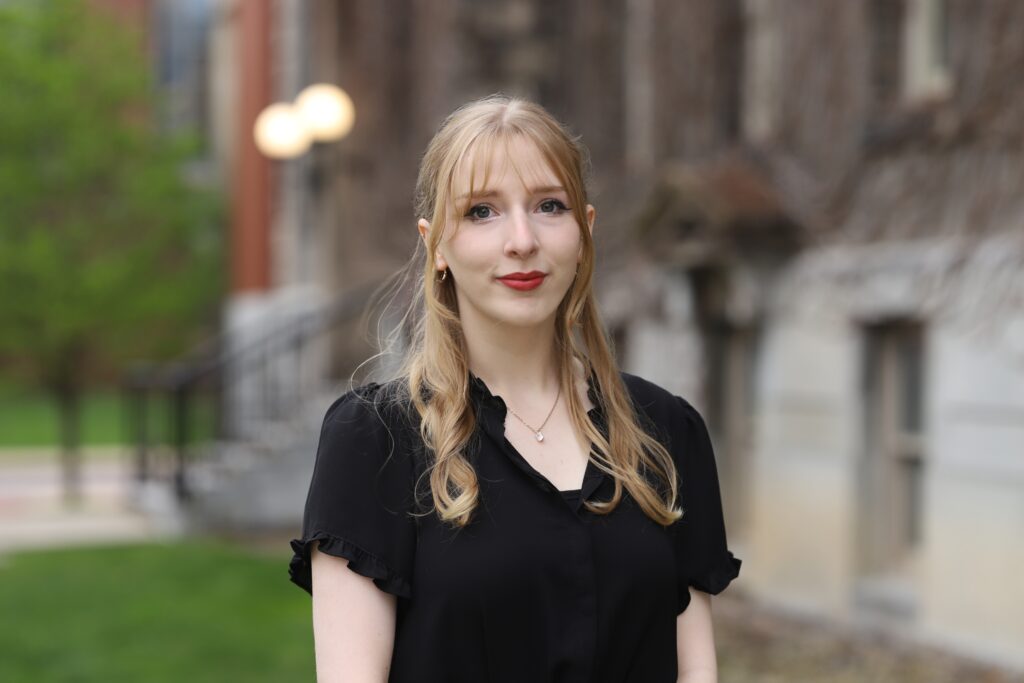
Andrea Hoe ‘23 G‘28 was ecstatic when she received an invitation to join NASA’s Graduate Research Fellowship program. It felt like years of hard work had finally paid off. She had always been fascinated with space, but it wasn’t until high school that she discovered her passion for space architecture. Since then, she’s made it her mission to work with NASA and continue exploring her interests in cutting-edge design.
“Whether it was participating in STEM programs or conducting independent research, my goals and achievements were strategic towards realizing my dream of becoming a space architect,” says the aerospace engineering student. “Now, to have the opportunity to collaborate with NASA feels like the culmination of a journey filled with challenges, setbacks, and moments of sheer determination. It is a surreal experience, and I am eager to begin this new chapter in my academic career.”
She initially began her undergraduate studies at Syracuse University as an architect student but found herself gravitating towards research opportunities. While architecture and space habitat design have their differences, she saw concepts that overlapped and knew she could apply her studies in architecture to space habitats.
“Architecture provided me with a solid foundation in design principles and unconventional thinking. I knew I wanted to apply this knowledge to engineering. I believe the intersectionality of disciplines is important in today’s time and will push society forward. By embarking on this academic journey, I aim to bridge the gap between creativity and innovation to explore new possibilities for space exploration.”
The NASA Fellowship sponsors graduate student research and development of innovative space technologies. The fellowship includes a research grant, which will provide her the opportunity to research lunar regolith composites with carbon nanotubes for space habitation applications. The study aims to create a concrete-like structural material that can be made from soil on the moon, which is known as lunar regolith.
The primary focus of the research is to investigate the effects of adding carbon nanotubes to lunar regolith. Even a small amount of these nanotubes can significantly enhance the compressive strength of the lunar soil, making it an ideal choice for durable structural material in space architecture. “Our future testing plans are diverse and exciting as we aim to delve deeper into optimizing the composition and properties of this lunar regolith-based material. Space is an extreme environment, so exploring its durability and resilience is imperative.”
She believes this research is pivotal to ensuring secure and stable habitats on the moon as well as manned missions to Mars and beyond, paving the way for the future of human space exploration. “Syracuse’s architecture program empowered me to be creative and think critically, particularly in my final thesis project. The aerospace engineering department has allowed me to pursue my ambitions and gain insightful experiences. I am truly grateful. Receiving the NASA Fellowship and grant is an indescribable event for me. It is a validation of years of hard work, dedication, and unwavering determination.
“I am so grateful for the support from the professors at Syracuse who assisted me in this journey and for the recognition from an institution as esteemed as NASA. I am particularly grateful for the mentorship of my research advisor, Dr. Wang, whose guidance and support have made this possible.”
Mechanical and Aerospace Graduate Student Melissa Yeung Joins National Science Foundation Graduate Research Fellowship
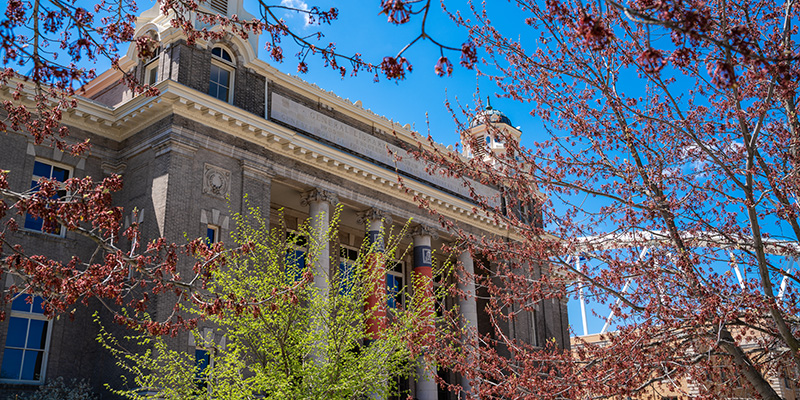
Melissa Yeung, a first-year Ph.D. student in mechanical and aerospace engineering, has joined the 2024 National Science Foundation (NSF) Graduate Research Fellowship Program (GRFP). The fellowship offers three years of support for graduate research over a five-year period.
Yeung currently works in the fluid dynamics lab of Yiyang Sun, assistant professor of mechanical and aerospace engineering, and her research focuses on supersonic jet engines. “The goal of my work is to alleviate the undesired features through strategically placed small micro-jets of air,” Yeung says. “I am currently focused on optimizing these micro-jets such that they can continuously modulate themselves to adapt to various flight conditions. By doing so, the flow can be controlled even in off-design conditions and with minimal energy input.
“Understanding these complex flow physics is vital for the development of next-generation high-performance aircraft. Successfully controlling this flow can improve upon the aircraft’s performance and ensure the safety of nearby workers or civilians. This work is one of many steps in pushing supersonic flight for commercial use.”
Yeung believes the fellowship will give her greater flexibility in her research, fund her research activities and enable her to attend more conferences. She’s also grateful for the support she’s received from Sun, Professor Emeritus Mark Glauser, and Gina Lee-Glauser, retired vice president for research.
“Their guidance has been crucial to my success and without them, I would have not had the honor of being an NSF GRFP recipient,” Yeung says.
Professor Emeritus Mark Glauser Receives 2024 American Institute of Aeronautics and Astronautics (AIAA) Fluid Dynamics Award

Professor Emeritus in mechanical and aerospace engineering, Mark Glauser, has received the 2024 American Institute of Aeronautics and Astronautics (AIAA) Fluid Dynamics Award. The award recognizes individuals with outstanding contributions to the understanding of liquid and gas behavior in motion and notable accomplishments within the aerospace community. This prestigious award is proudly sponsored by the AIAA Fluid Dynamics Technical Committee.
Glauser was selected for his seminal contributions to the innovative use of multi-point low-dimensional methods for understanding and control of turbulent flows. He will be recognized during the 2024 AIAA AVIATION Forum and AIAA ASCEND event in Las Vegas, Nevada in July. He will also give a special Fluid Dynamics Award Lecture.
“This is indeed a great honor for me and reflects very positively on the Syracuse University mechanical and aerospace engineering department and the approximately 70 of my outstanding MS and Ph.D. students who have been key to my success,” says Glauser.
Mechanical and Aerospace Engineering Senior Capstone Teams Present Designs to Industry Partners
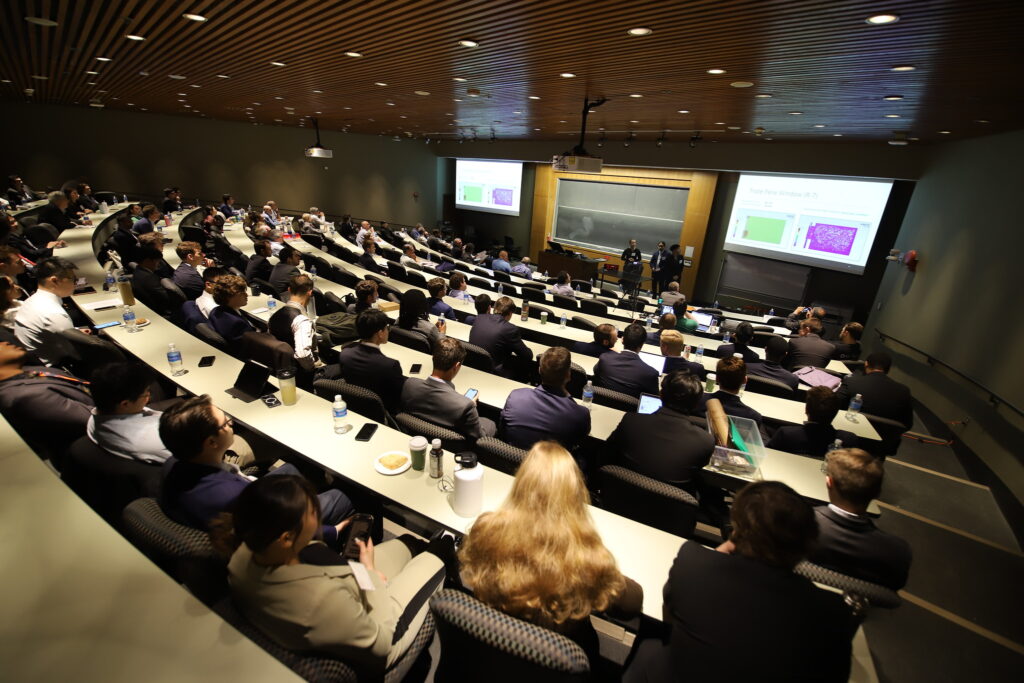
19 teams of engineering students presented their designs to industry partners at the end of the 2024 spring semester. These presentations were part of their senior capstone design course spanning the fall and spring semesters. Each team worked directly with their company sponsor to solve complex engineering problems. The top three capstone teams won a monetary prize based on the judges’ scores and this year’s winners were Pursuit Aerospace (first place), Govsphere (second place), and Aerovec (third place).
“I am so proud of all of my students who presented their senior design capstone projects to a panel of 14 industry expert judges,” says Kenneth and Mary Ann Shaw Professor of Practice in Entrepreneurial Leadership Alex Deyhim. “Each team presented the results of their year-long company-sponsored projects. They also gave poster presentations to our esteemed guests during the networking lunch.
“We are grateful to our 19 faculty mentors who worked with the teams all year, and to our esteemed panel of judges who gave their time and expertise to provide invaluable feedback to the teams. We also want to thank Boeing Corp. for sponsoring the Boeing Award. All the teams gave amazing presentations and determining the winners required calculating the scores to three decimal places!”
The projects and companies that students worked with in the 2023-2024 academic year were:
American Society of Heating, Refrigerating and Air-
Conditioning Engineers (ASHRAE)
Integrated Sustainable Building Design: Designed an HVAC System for a new library in São Paolo, Brazil.
Hydronic Shell
Simulation of a Novel Heating & Cooling Concept: Identified the key components of the design for the Hydronic Shell, a modular HVAC system integrated into panels that form an insulated shell over an existing building.
Pursuit Aerospace
CNC Machining Fixture – Clamp Redesign: Manufactured all components to be used within the CNC machine and enhanced the overall performance of the clamping mechanism.
Aerovec
Small-Scale Wind for Rooftop Applications: Assisted with the design of a small-scale wind turbine that could be installed on rooftops for commercial, industrial, and agricultural applications.
National Institute of Standards and Technology (NIST)
Neutron Velocity Selector Test Base and Cover: Designed a permanently mounted base with an attached protective cover to house all models of NVS during the testing phase and ensure the safety of all test participants in the event of a worst-case scenario.
American Society of Naval Engineers (ASNE)
Promoting Electric Propulsion (PEP): Designed and built an aquatic vessel propelled by electrical propulsion.
New York State Department of Transportation (NYSDOT)
Deformation of Elastomeric Bridge Bearings: Determined the maximum horizontal shear force bridge bearings could withstand before permanent deformation.
Microsoft
Bifacial Coldplates for High Power Servers: Developed a liquid-cooled server to provide efficient and adequate heat transfer from protected and stressed equipment.
Corning
Generative AI for Solving Real-World Problems: Improved mechanical engineering design processes by eliminating the manual operation of 3D design software through means of generative AI.
Boeing
Sustainable Composite Materials for Aircraft Interiors: Investigated the feasibility of sustainable composite alternatives to address end-of-life and environmental issues without sacrificing durability or product quality.
Lockheed Martin
Additively Manufactured Cold Plate: Investigated, analyzed, procured, and tested AM cold plate designs that were representative of designs under consideration for use in high heat dissipating electronic module assemblies.
Lote Biologics
Utility Steam Generation Plant Design: Developed an appropriately sized new design, which met current and future facility demands in a highly efficient manner.
Thermal Space
Lightweight Graphene Radiators for Space System: Developed a baseline radiator panel design that could help to predict performance such as heat rejection capacity as well as temperature gradients.
SEPAC
Universal Torque Testing Machine: Developed and prototyped a torque and burnishing system for electromagnetic clutches and brakes for SEPAC.
Northrop Grumman
Generate an Empirical Database to Characterize Critical Oscillating Heat Pipe: Designed and tested physical OHP heatsinks to determine which design would allow for the highest heat flux in a system.
L3Harris
Universal Adjustable Antenna Mounting System: Created a sustainable, reliable, and user-friendly solution for temporary communications systems installation on helicopters.
Govsphere
Modernization of MedX Rehab Medical Machines: Designed the next generation of the MedX Rehab Lumbar Extension and Cervical Extension machines, integrated electric motors, and redesigned the counterbalance, weight stack, and frame of each machine.
SAAB
Micro-Unmanned Underwater Vehicle STEM Design: Designed and constructed a cost-effective modular STEM kit variant of a military micro-unmanned undersea vehicle (UUV) at a reasonable cost for academic use.
Electrolux
AGV (Automated Guided Vehicles): Evaluated implementing Automated Guided Vehicles (AGVs) at the Kinston, North Carolina facility and facilitated efficient transportation of materials, including raw and assembled sumps, within the facility.
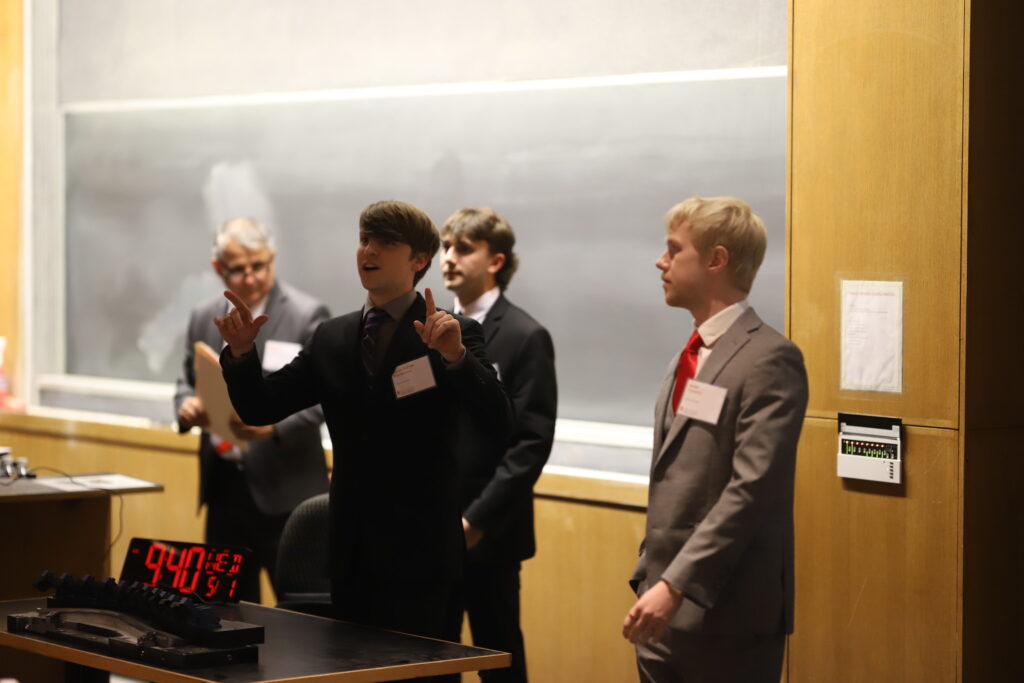
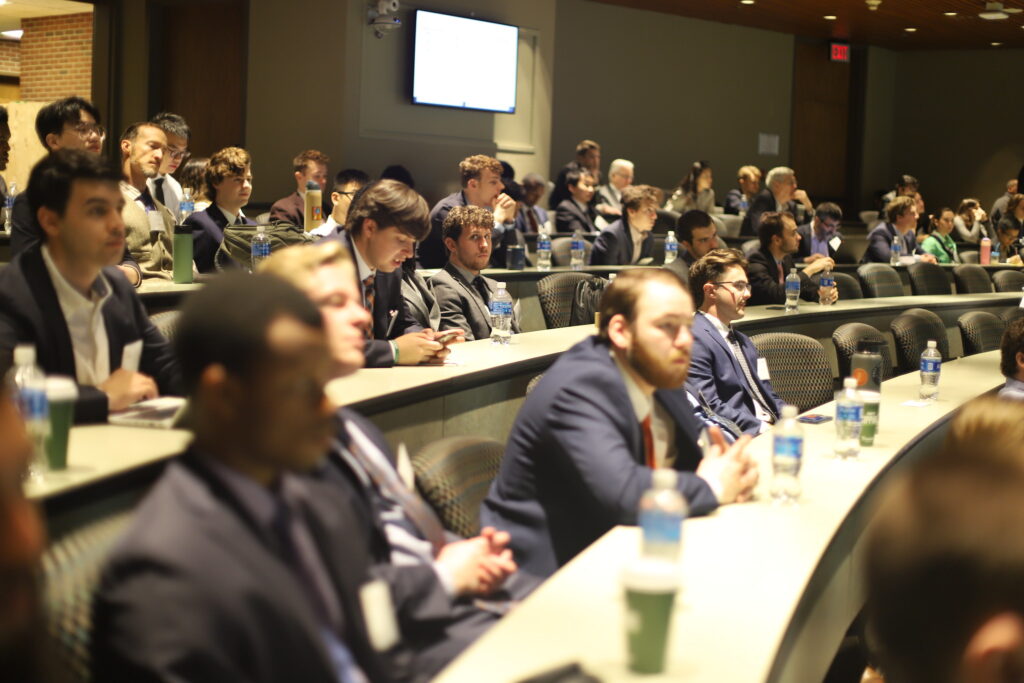
Engineering and Computer Science Staff Spotlight – Mechanical and Aerospace Engineering

Get to know the staff who keep the department of mechanical and aerospace engineering (MAE) running smoothly!
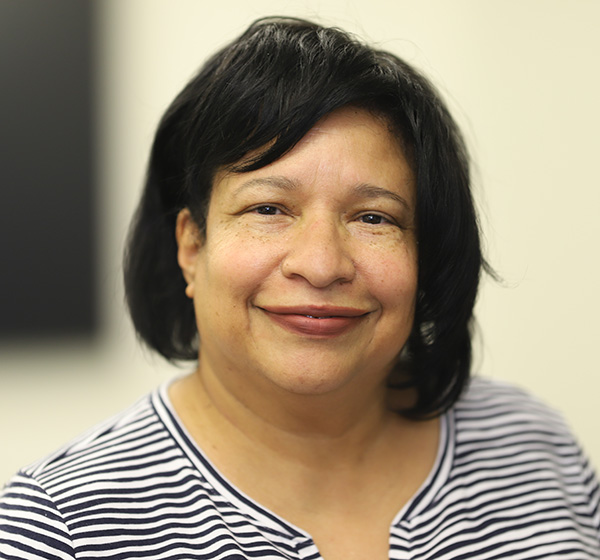
Name: Karen Dixon-Cherebin
Title: Academic Support Coordinator
Tell us about your role at Engineering and Computer Science:
I am responsible for managing class scheduling, enrollment and classroom assignments, among other academic tasks for students and faculty.
I also assist the Department Chair with MAE events and special projects.
What is your favorite part of working here at ECS?
Having the opportunity to work with a diverse group of students. I like to remind students to let their faith be bigger than their fear.
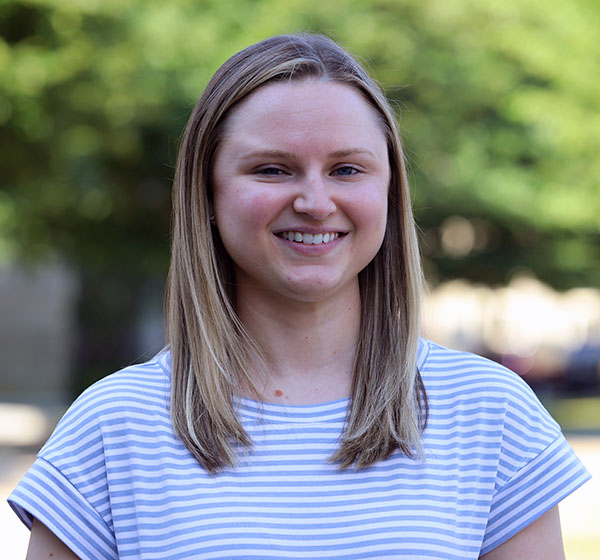
Name: Megan Claxton
Title: Budget Manager
Tell us about your role at Engineering and Computer Science:
I manage all department funding and provide guidance on the usage of available funds. I also help to facilitate grant proposals and manage the grants once awarded.
What is your favorite part of working here at ECS?
My favorite part about working at ECS is having a good network of friendly and helpful colleagues.
Mechanical Engineering Students Compete in Unmanned Boat Competition in Virginia
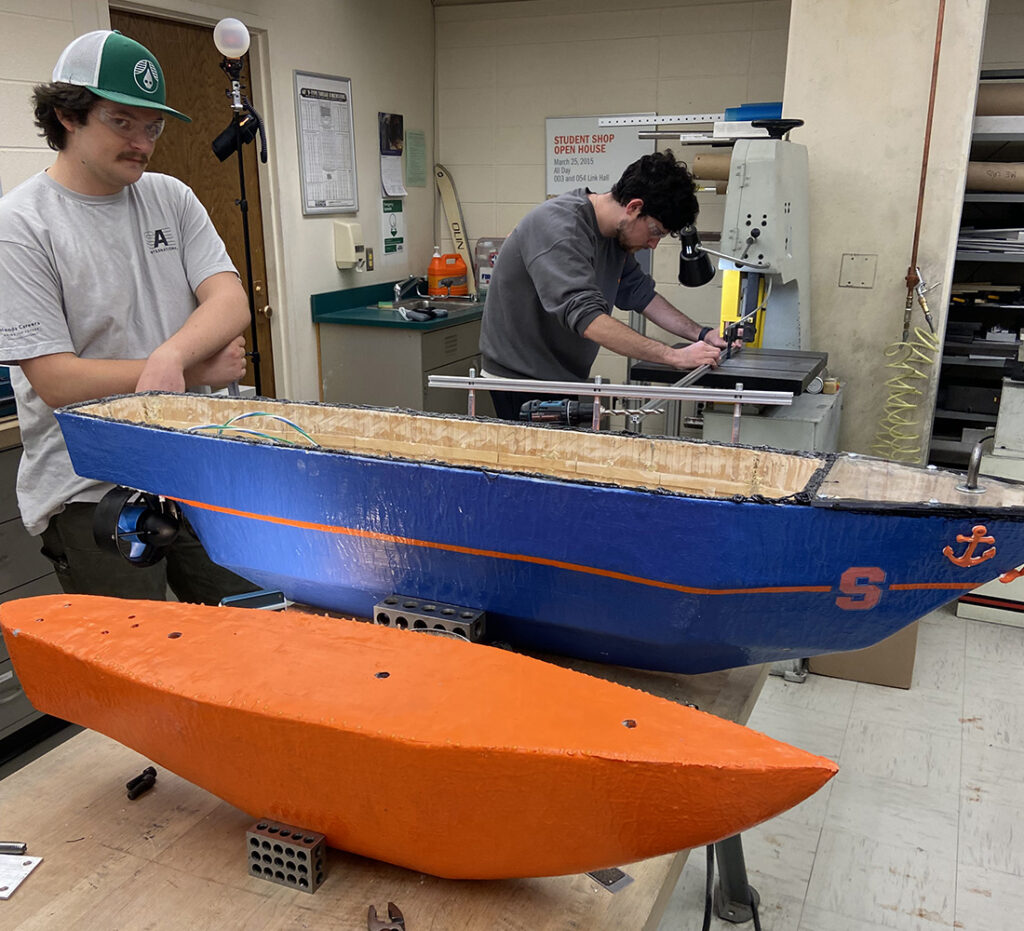
Mechanical engineering students Ian Storrs, David Denneen and Hunter Knarr and their faculty mentor, Professor Kasey Laurent, qualified for the 2024 American Society of Naval Engineers Promoting Electric Propulsion (PEP) Unmanned Division competition in Virginia Beach. This is the first year that Syracuse University College of Engineering and Computer Science is participating in the PEP program. The student team worked extremely hard designing and building their remote-controlled electric boat, overcoming a number of obstacles to complete their project in time for the two-day competition.
On Tuesday, April 16th, 35 craft qualified to race in time-trial heats for five miles. Under the supervision of Naval Surface Warfare Center Carderock, Combatant Craft Division (NSWCCD CCD), team after team took their craft into the open water and tested them in the rigorous Virginia Beach conditions. Judges from the Office of Naval Research, ASNE Tidewater Section, ROBONATION, and student volunteers tracked and documented their progress.
Aerodynamics of Avian Flight
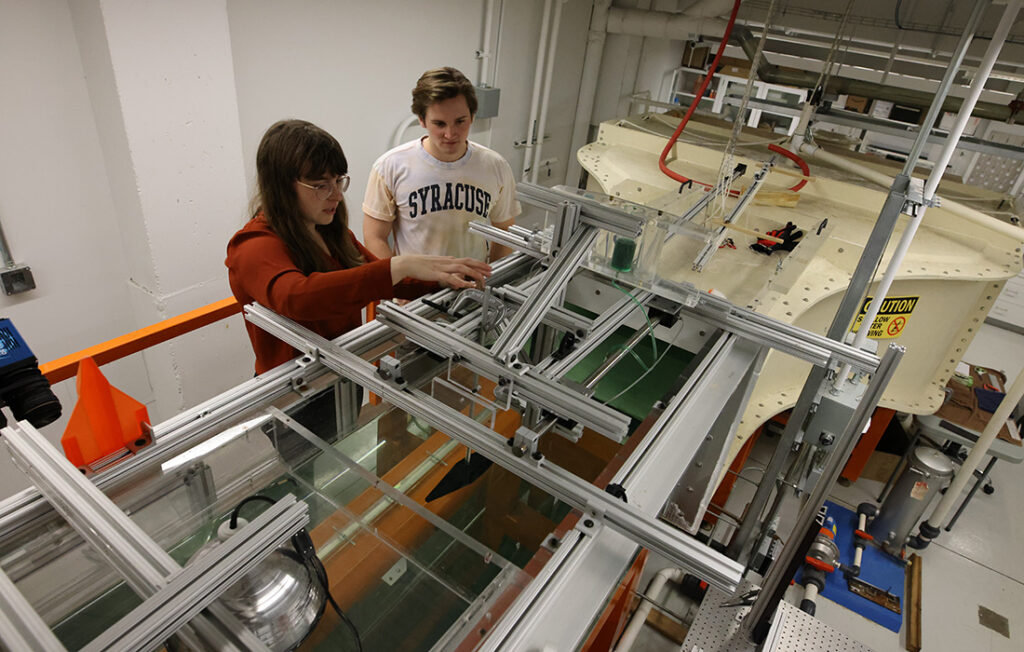
Boasting an impressive wingspan of over seven feet, the golden eagle is one of the largest birds of prey in North America. In addition to being cunning, skilled hunters and their ability to soar effortlessly for hours, golden eagles might also utilize strong gusts of wind to assist their flight – an ability that piqued the interest of aerospace and mechanical engineering professor Kasey Laurent.
During her Ph.D. studies at Cornell University, Laurent conducted research on golden eagles by recording their acceleration as they flew, and the study formed the foundation for her dissertation on bird and drone flight. She also participated in Cornell’s Raptor Program, which provides a home for injured or non-releasable birds for research, training, and rehabilitation. This experience gave her valuable insights into bird flight and behavior.
“Slowly throughout my Ph.D., I became more of a bird person. That’s what motivates my research here at Syracuse University,” she says.
Laurent’s research aims to enhance flight and aerodynamics by measuring wind speeds and unsteadiness within air flows. Her work’s interdisciplinary nature also enables collaboration with biologists to explore ideas for improving aerodynamics by learning from nature.
“If you step outside on a windy day, you’ll feel the wind coming from various directions and at varying strengths at random intervals,” says Laurent. “If we measure the wind at a single point in time, that value will be random, but if we measure the wind over a long period of time and evaluate the statistics of how the wind changes over time, we’ll find patterns. My research looks at how these patterns, or signatures, may be deduced by looking at the locomotion of animals in turbulent environments. Will a bird fly a certain way in the turbulent atmosphere?”
As Laurent puts together a proposal for gust soaring seen with golden eagles, she’s also interested in gathering data from crows, goshawks, and turkey vultures, large birds that also use strong wind gusts to aid their flight.

“Goshawks fly through the forest and can maneuver very fast in different environments. When flying close to treetops, turkey vultures’ wings have an angle to them, allowing them to restabilize. It would be difficult to replicate this in man-made vehicles since they’re not flexible and don’t have joints like birds, but there’s still much we can learn.”
Studying how birds utilize wind and atmosphere to aid their flight would assist in improving the flight of unmanned aerial vehicles (UAVs.) Smaller aircraft often face issues when encountering wind gusts, causing them to lose control and potentially crash. Understanding how to maneuver around gusts could open up new possibilities for aircraft to fly in without sustaining damage from wind gusts and even utilize gusts to their advantage, similar to birds.
This research can be useful in creating smaller and lighter UAVs for various applications, including search and rescue missions. The main challenge with drones is that they have a limited range, which requires them to return to a base to change batteries and repeat the process. If the drones have a longer lifespan, they can continue with their search without the need to land or replace the battery.
“If we find a way to let the gusts move aircraft around, power won’t be an issue. We’ll just need to know how to maintain stability in that gust,” Laurent says. “Most research looking at flight in turbulence aims to develop methods to reject gusts, but it seems, according to the eagles, that may not be the best approach. We can learn a lot from nature to improve aerodynamics and locomotion.”
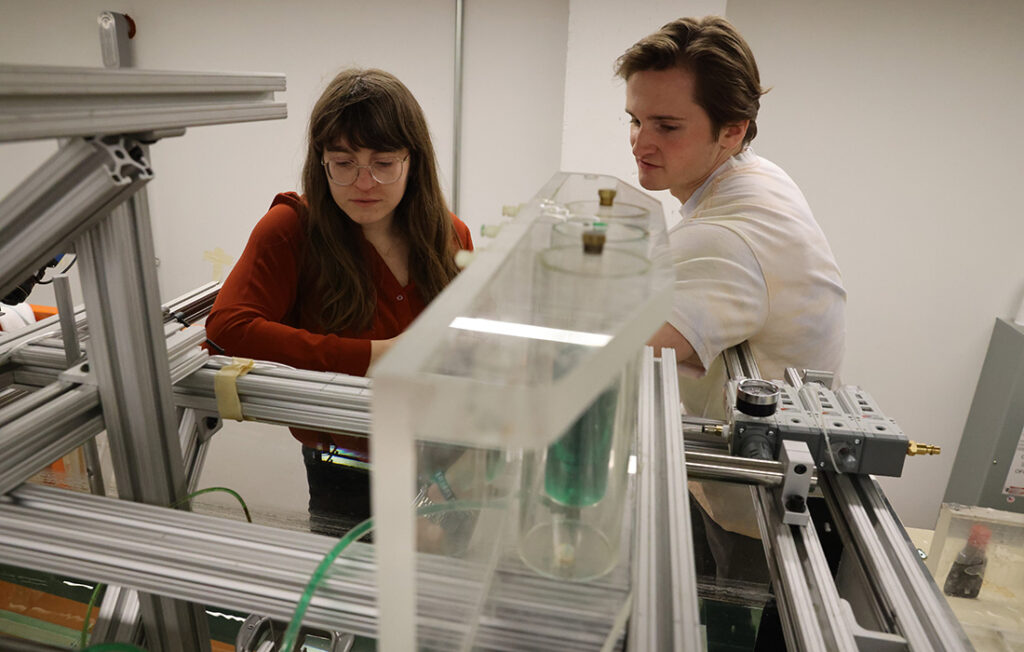
Mechanical and Aerospace Engineering Student Team Takes First Place at the New York State Green Building Conference Student Poster Competition

Mechanical and aerospace engineering students Kendra Miller, Elan Fullmer and Sydney Florence Jud were awarded first place at the New York State Green Building Conference student poster competition on February 29th and March 1st 2024. The students were advised by Professor Jackie Anderson.
Their project titled, “Generating Renewable Electrical Energy” is sponsored by Aerovec, a startup company focused on developing small-scale, modular wind turbines for remote applications and microgrids. Aerovec is one of 19 industry-sponsored capstone projects that mechanical and aerospace seniors are working on this year. Aerovec is looking into multiple installation locations, such as commercial building rooftops, construction sites, and sites which need natural disaster relief assistance. This senior design project is primarily focused on the feasibility of an array of wind turbines on commercial rooftops for local energy generation.
AIAA at Syracuse University is Reaching New Heights
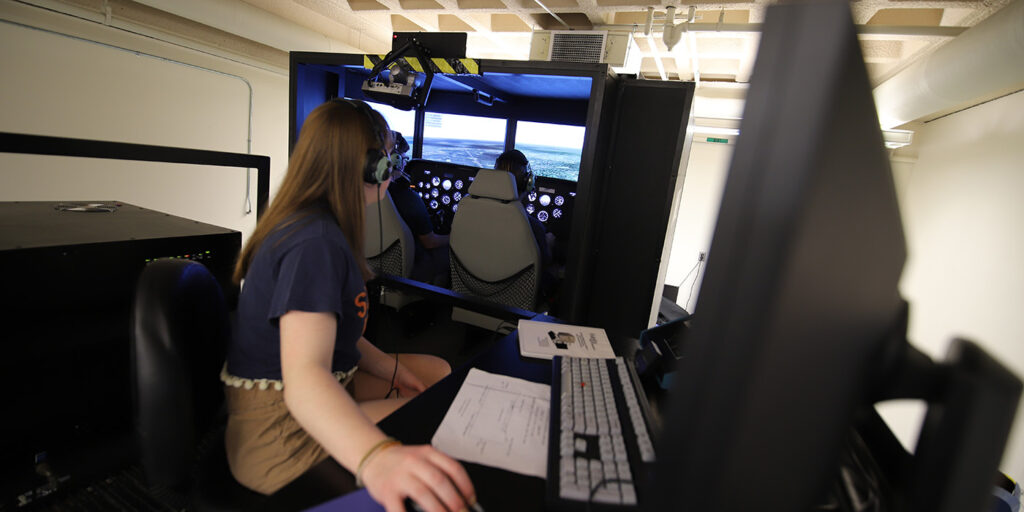
“How do we bring people from different majors together to create a collective community?” This question led the Syracuse chapter of the American Institute of Aeronautics and Astronautics (AIAA) to explore new ways to forge relationships with the broader campus community. As the student organization welcomes new E-board members, they seek to strengthen bonds within the group’s membership and create a welcoming environment for all to join.
“People in engineering typically meet other engineers – architects stay in Slocum Hall, engineers stay in Link Hall,” says vice president Theodore Todorov ’26. “We’re looking for ways to form new connections and bring people together.”
Founded in 1963, the AIAA aims to shape the future of aerospace through ingenuity and innovation while supporting aerospace professionals to succeed in their careers. The Syracuse University chapter of AIAA contributes to this mission by hosting review sessions. These sessions cover primary engineering and higher-level aerospace courses, and club members can request specific topics to study.
As a first-year student, Todorov loved being part of the club since he got to interact with other like-minded individuals. However, he noticed some aerospace engineering students he knew didn’t attend these meetings. Though the club was also open to non-engineering students, they also weren’t coming to meetings. When appointed as the club’s vice president, Todorov started thinking about ways to encourage more aerospace engineering and non-engineering students to join the club.
“We wanted to branch out more,” he says. “We thought ‘How can we change that? How can we make our club more social?’”
Breaking away from their usual meeting agenda, the club hosted an ice cream social to allow students to connect and relax. To their surprise, several students showed up, eager to mingle and fill their stomachs. This positive response prompted the e-Board to continue hosting more social events that allowed students to have fun.
After the successful ice cream social, the AIAA has decided to host bigger social events in the future. They plan to organize the STEM Olympics, which will involve a campus-wide scavenger hunt. The scavenger hunt would feature clues related to different programs such as biology, chemistry, and engineering. This event will also have prizes, and yard games and will take place before midterms so that students can unwind before their exams.
“The idea is when people go to make their teams, they would select people from other majors or programs to have a better chance at solving clues,” says Todorov. “This is one of the best ways we can have students from different majors meet.”
Todorov has been playing a leading role in organizing this event, in addition to assisting with review sessions and other duties related to the vice-president position. The e-Board has much more planned and is eagerly looking forward to students seeing what’s in store. They envision a bright future for the Syracuse chapter of the AIAA, not only as support for the future of aerospace engineering but also as a social club where people can connect.
“I saw potential for the club when I joined my freshman year and I believed AIAA could be so much more,” Todorov says. “We want to make a big impact and are excited to see where it will go next.”
Looking to join or partner with AIAA? Click here to get connected!
Reach out to aiaa@syr.edu or tdtodoro@syr.edu for more information about AIAA review sessions and events
Mechanical and Aerospace Engineering Professor Yiyang Sun Receives Young Investigator Program Award
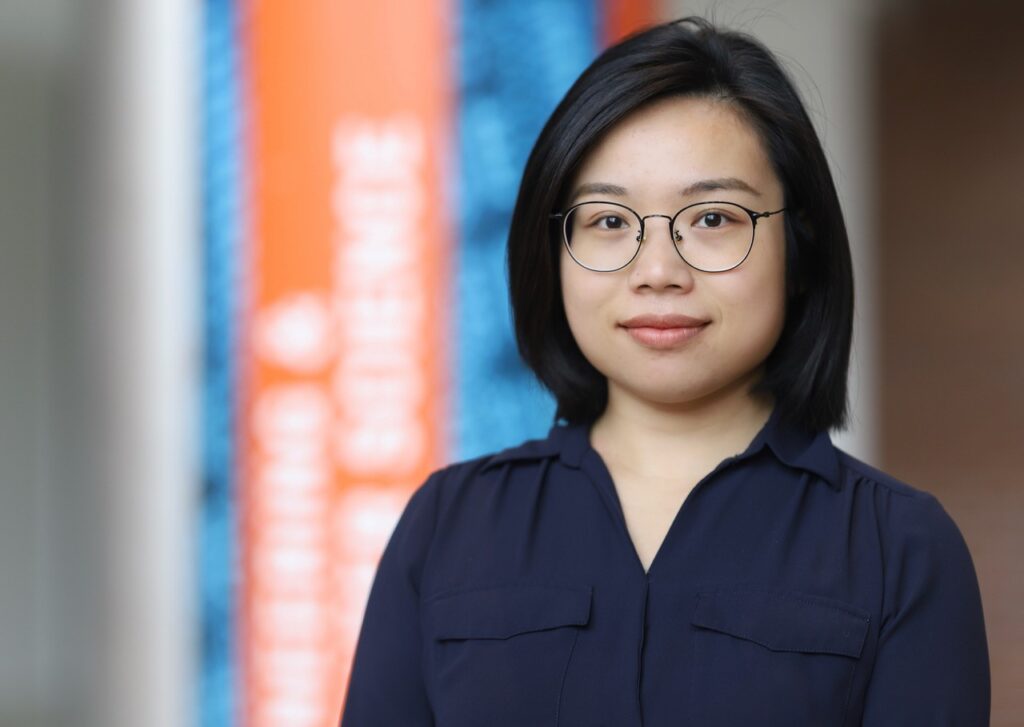
Assistant professor in mechanical and aerospace engineering Yiyang Sun has received the Air Force Office of Scientific Research (AFOSR) Young Investigator Program (YIP) Award. She has been awarded for her research efforts and contributions to unraveling multi-modal interactions in fluid flows using modal analysis, a cutting-edge technique in analyzing and understanding intrinsic physics in unsteady aerodynamic problems.
The Air Force Research Laboratory (AFRL) is the lead scientific research and development center for the Department of the Air Force. It aims to improve the career development of young investigators while providing opportunities for discovery and research. Recipients of this award have received a Ph.D. or equivalent degree in their respective fields and demonstrate outstanding ability and potential to conduct research for the AFRL. The AFOSR will award $21.5 million in grants to scientists and engineers across different U.S. research institutions.
Sun’s research outcomes could have a significant impact on advancing the designs of aircraft with improved aerodynamic performance for challenging operation conditions. She will receive about a $450,000 grant in this award for three years to continue her research activities in unsteady aerodynamics.
“I am so grateful for receiving this award from AFOSR as the recognition motivates me to continue contributing to aerospace engineering at Syracuse University and the field in general,” says Sun. “The College of Engineering and Computer Science and Mechanical and Aerospace Department have been amazingly supportive in helping me pursue my career and forming an engaging environment for my students to do great work.”
Mechanical Engineering Senior Capstone Design Teams Present Designs to Industry Partners
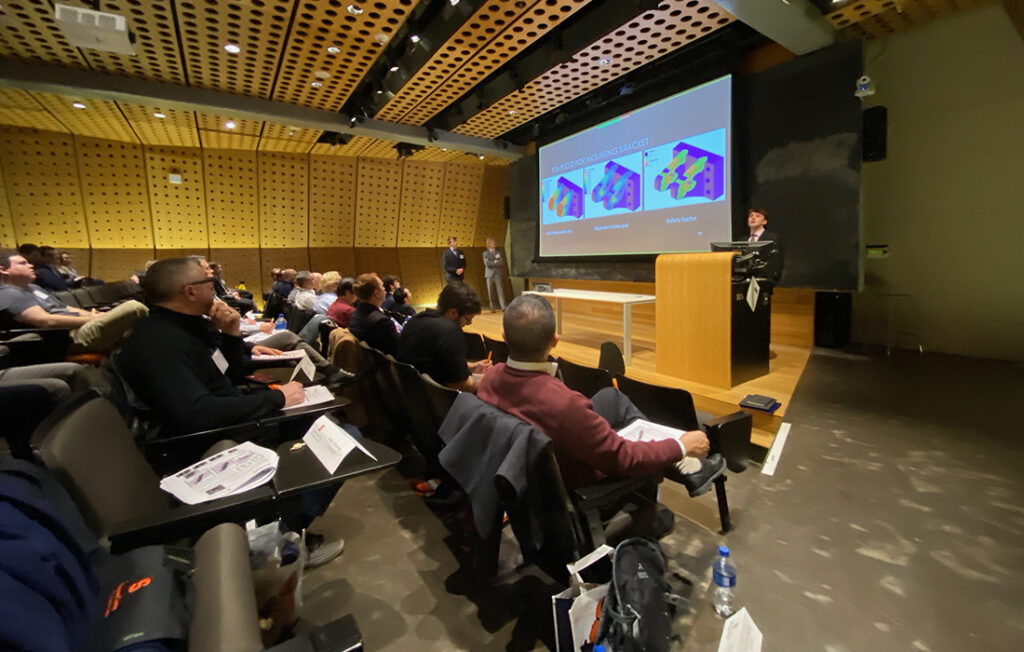
19 teams of engineering students presented their designs to industry partners at the end of the fall semester as part of their senior capstone design course. Each team is working directly with their company sponsor to solve complex engineering problem. The senior design capstone course is an engineering exercise that spans the fall and spring semesters.
The companies the students are working with in the 2023-2024 academic year are:
- Aerovec
- American Society of Naval Engineers
- ASHRAE
- Boeing
- Corning
- Department of Transportation
- Electrolux
- Govsphere
- Hydronic Shell
- L3Harris
- Lockheed Martin
- Lotte Biologics
- Microsoft
- NIST
- Northrop Grumman
- Pursuit Areospace
- SAAB
- SEPAC Thermal Space
“We are also grateful to our 19 faculty mentors who have been working with the teams all semester, and to our esteemed panel of judges who gave their time and expertise to provide invaluable feedback to the teams,” said Kenneth and Mary Ann Shaw Professor of Entrepreneurial Leadership Alex Deyhim. “We look forward to seeing the work the teams will do in the spring semester to deliver a final solution to their sponsors.”
Nature-Inspired Research
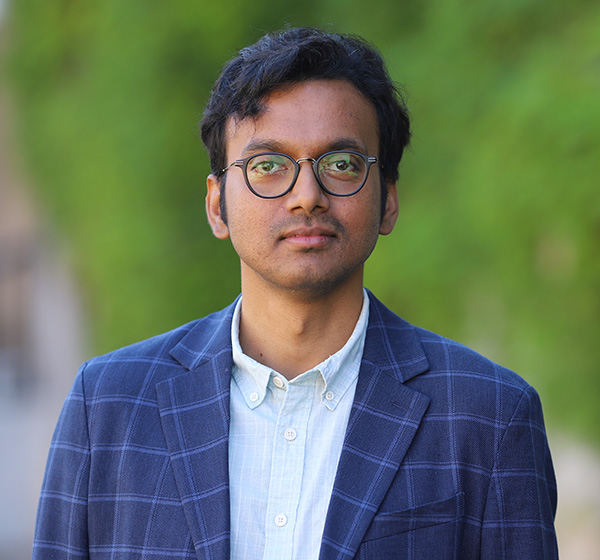
Apple snails are one of the most invasive species on our planet. Consuming several plants that provide food and habitats for various wildlife, and disrupting entire ecosystems, these snails have earned a permanent ban from the United States, only allowed in the country for research. Along with the damage they leave in their slow path of destruction, these shelled creatures also possess an ability that’s unique to their species.
By wiggling its flexible foot underwater, an apple snail can create a flow that brings floating food particles to itself, a process biologists refer to as “pedal foot collection.” Fascinated by the snail’s unique ability, this would inspire the latest research of a mechanical and aerospace engineering professor, Anupam Pandey, whose findings were published in the high-impact science journal Nature Communications.
“One of my research interests is understanding how soft, highly deformable, solid materials interact with adjacent liquid flow,” Pandey says. “Organisms that live underwater exploit this interaction for locomotion and feeding. Apple snails have evolved to leverage their proximity to the water-air interface to transport or pump liquids.”
To understand the process behind pedal foot collection, Pandey designed a robot the size of a centimeter that oscillates rhythmically and mimicked the apple snail’s motion. He then placed the robot underwater in a tank and sprinkled Styrofoam particles on the surface to see if it could collect it, discovering that the robot functioned similarly to a pump.
“We found that our bio-inspired robot was able to drag particles from distances that are five times its size. But more interestingly, we found an optimal speed at which pumping maximizes,” explains Pandey. “This optimal speed seemed to depend on robot geometry as well as the properties of the liquid it’s submerged in. Combining experiments and modeling, we predicted the optimal conditions under which the robot pumps the most liquid.”
In addition to understanding the role speed and liquid play in how the robot collects small objects and pumps liquid, Pandey also tracked the pattern of Styrofoam particle movement through long exposure photography, which he color-coded to make it easier to see how the particles moved.
While the small, oscillating robots have the potential for numerous applications, one notable benefit is as a collection device. Pandey believes that they could help address issues involving the collection of microplastics in oceans, which tend to remain at the water’s surface due to their small size.
Most plastic collection devices create strong disturbances at the water surface and cause microparticles to mix in the water. These microplastics travel to other water bodies, causing more plastic pollution which harms plants and animals and inevitably ends up in our food chain. However, devices like the undulating robot operate near the water’s surface with minimal interference and could potentially provide a solution to this problem.
“What’s great about this research is how interdisciplinary it is. Biologists may be interested in this, and it has several potential applications in engineering liquid flows at small scales, sensing and actuation of floating objects or even microplastics in water bodies,” Pandey says. “It will not only advance understanding of liquid transport near surfaces but lay the groundwork for future research as well.”
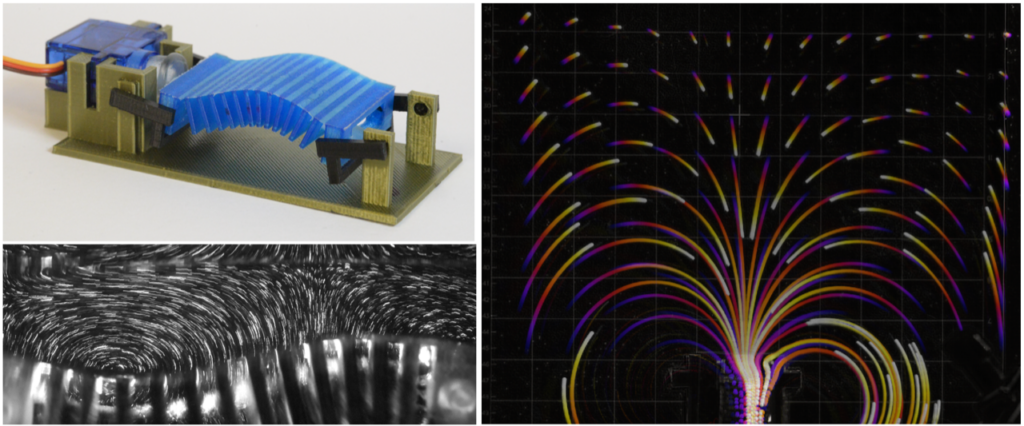
Aiming for the Stars: Aerospace Engineering Student Greg Slodysko Meets NASA Administrator Bill Nelson
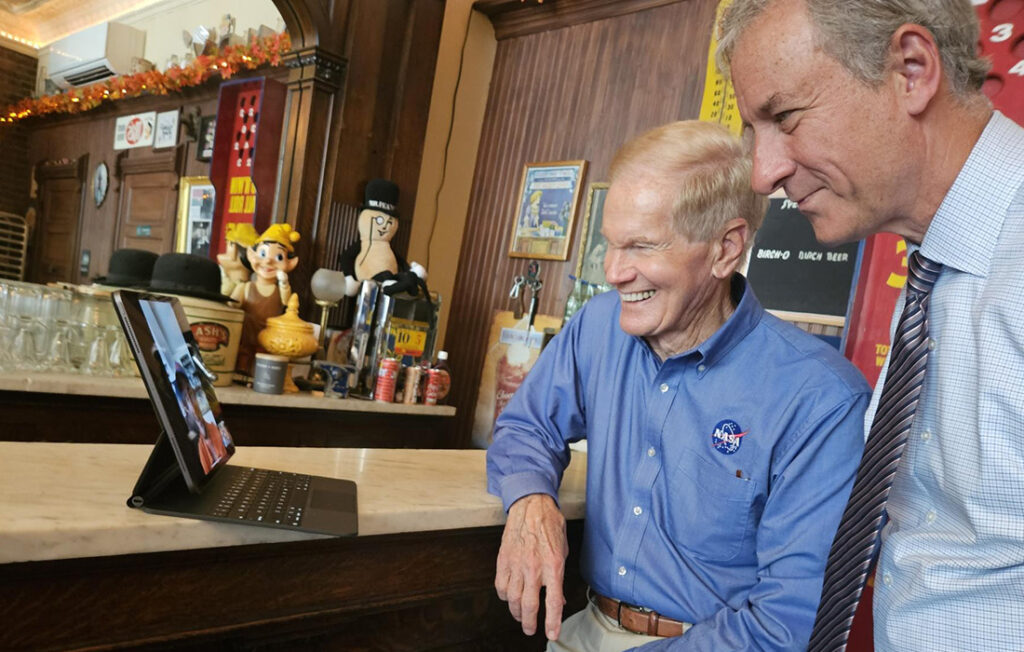
Growing up, Greg Slodysko had a deep fascination with space exploration. Games like Kerbal Space Program, which challenged players to design spacecraft for different missions, and movies like October Sky inspired him to create his own model rockets and sparked a keen interest in the world beyond our own.
“I was always excited to see photos from the Hubble Space Telescope, which has some of the best pictures we’ve ever taken of distant stars and galaxies,” Slodysko says. “I also enjoyed watching documentaries or films about space travel and even went to space camp in high school.”
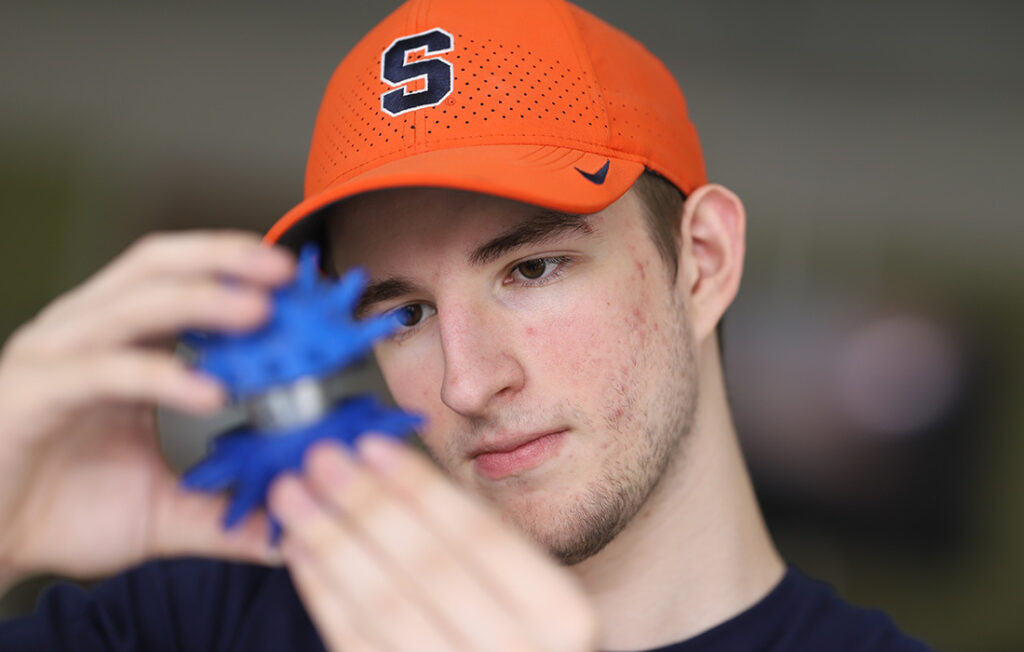
Now a senior studying aerospace engineering at Syracuse University, Slodysko recently had an experience that further fueled his love for rocketry: a conversation with Bill Nelson, the current NASA Administrator. How exactly did he manage to meet with NASA’s chief officer? The answer lies in an unexpected craving for ice cream.
Nelson and Congressman Matt Cartwright visited a high school in Slodysko’s hometown of Pittson, Pennsylvania. After the event, the NASA administrator was craving a sweet treat, so they both decided to head over to a nearby ice cream shop. The shop owners were friends with Slodysko’s parents and knew he was studying aerospace engineering at the University, so they invited Slodysko’s dad to the shop while the NASA administrator and the congressman were there. This provided the perfect opportunity for Slodysko to speak with Nelson.
“When I first got the mention that I had a chance to talk to Bill Nelson, I went for it. I immediately said ‘Yes, get me in!’ These situations are rare and don’t happen often” he says.
Slodysko couldn’t physically attend the meeting since he was on campus but was thrilled to participate in an impromptu FaceTime call with Nelson. Though he was initially nervous, the conversation was filled with encouragement and support, reigniting Slodysko’s passion for aerospace engineering and potentially paving the way for a future at NASA.
“They told me I was on the right path, and they were impressed with my work. It was such an inspiring conversation that I’ll never forget” he says.
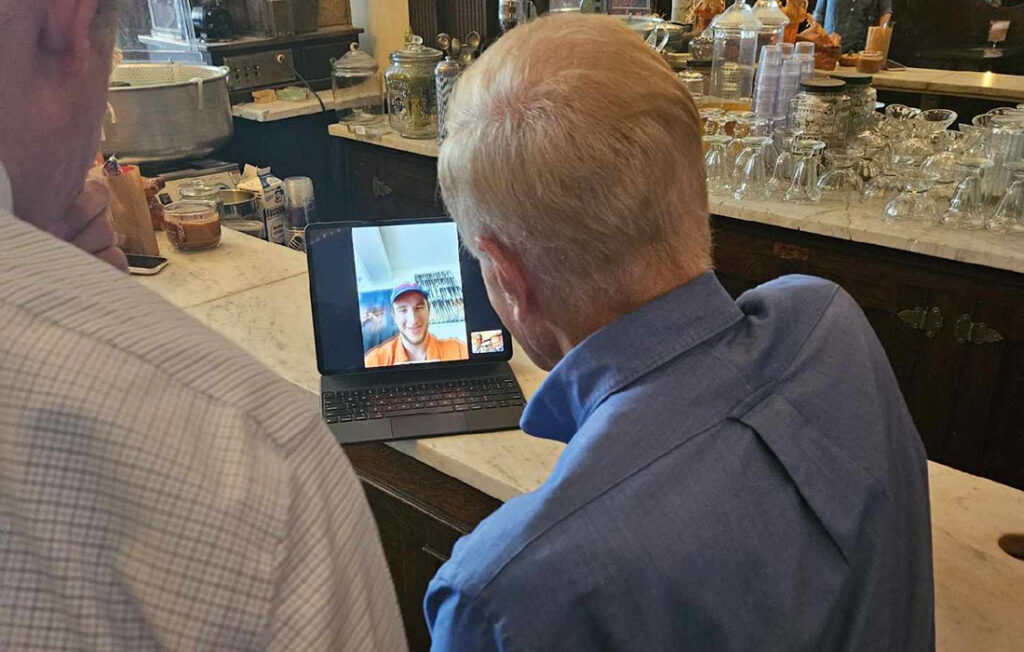
Slodysko intends to continue exploring his interest in structural design, propulsion, and aerodynamic analysis as he completes his undergraduate degree. He’s also currently completing a computer-based code that produces modular model rocket parts that are 3D printable. He aims to make this code available for free download online so that others can either create their own model rockets by adjusting code variables or work to improve the code created by him.
Additionally, he plans to enroll in graduate school and hopes to secure an internship with NASA, potentially getting to meet the administrator once again but this time, face-to-face. To Slodysko, this would be an experience that’s truly out of this world.
“I’m deeply grateful to Congressman Cartwright and Bill Nelson for this once-in-a-lifetime opportunity,” he says. “I’ll never forget this and I’m so excited for what the future holds. This is going to stick with me for a long time.”
Aerospace Engineering Student Michael Saksa Talks Internships, Academics and Future Plans

Michael Saksa had quite the summer. For six weeks, he competed in Invent@SU, where he and his team created a handy tool for clothing repair called HomeTailor. Following the competition, he began an internship with the New York State Department of Transportation where he explored what a possible future in aerospace engineering looked like for him. In this Q&A, Saksa talks about his internship, plans for the future and advice for students to make the most out of their experience at the University.
What sparked your interest in pursuing an education at Syracuse University?
I really loved the location. My family is from Hammond, Indiana and we love to vacation in Upstate, New York so we’re familiar with the area. I also love the great programs at Syracuse University and the support it offers students – It was an easy decision, really!
Can you discuss the company you interned with and your duties?
I interned with the New York State Department of Transportation as a student assistant. I assisted with projects in the Highway Design Department and we worked on a highway renovation project in Ithaca.
Since the project has expanded, we had to expand the land the state department owns. We focused on restoring the sidewalks and I drafted up new borders for the land.
What did you like the most about your internship?
It was a great working environment and management was accommodating. They gave us options to work at different times so you could come in or leave earlier. The people I worked with are also great. Even if I made a mistake, it was never a big deal. They treated everyone with respect.
Did you face any challenges during your internship?
Because I was in Invent@SU, I had to start the internship late. All of the other interns started six weeks before I did so they already knew each other and had good rapport. Initially, it did feel awkward being the new guy when everyone else was settled in. I eventually settled in and got to know some other great people too.
Were there any specific projects you enjoyed working on?
Most of my projects were highway restoration but I also did a little field work and surveying on I-81, which I enjoyed. Surveying is how they make GPS routes. We went along the side of the highway with equipment where there were points marked with stone markers which are known coordinates. We take the points and get more accurate pinpoints of them and with that data, we can improve GPS accuracy. New surveying technology has definitely improved GPS accuracy.
Where do you see yourself in the next few years?
I plan on continuing my education and hope to work at NASA or SpaceX. I feel like I’m getting valuable engineering experience and making great connections. I’ve learned a lot not only from the classroom but from this internship as well.
What advice do you have for students about making the most out of their academic experience?
I would say reach out to professors, go to office hours, connect with others on LinkedIn, and attend events like the career fair. That’s actually where I got my internship with the New York State Department of Transportation. Also, always try to show up for class – it’s very easy not to.
Try to put yourself out there and make friends. Get engaged in a community you’re passionate about and balance your social and academic life well.
Mechanical and Aerospace Engineering Professor Bing Dong Awarded as IBPSA World Fellow

Mechanical and Aerospace Engineering (MAE) Professor Bing Dong has been awarded as an International Building Performance Simulation Association (IBPSA) World Fellow for his research contributions, mentoring, and outreach within the field.
The IBPSA Fellow is awarded to individuals who have made significant contributions to the field of building performance simulation or have demonstrated their expertise through teaching, research, simulation code development, or applying building simulation on large-scale projects. To be eligible, recipients must have also been actively involved in the field for at least ten years.
Dong has distinguished himself through impactful contributions such as his pioneering research in occupant behavior modeling, development of novel simulation and control models to solve buildings-to-grid integration control problems, and education of junior researchers and students among other notable breakthroughs within building performance simulation.
“This award is very prestigious. IBPSA only gives fellow awards every two years and it’s nominated by six world experts in this area,” Dong said. “I’m looking forward to further contributing my knowledge and advancing the community of energy efficiency buildings to achieve net-zero energy and carbon buildings and cities. This achievement means a lot to me.”
“This is indeed a great recognition for many years of continuing excellence Professor Dong has demonstrated in the area of building performance simulation,” said MAE Department Chair and professor in manufacturing enterprises, Young Moon. “The association awards IBPSA fellows biennially and this year, 12 fellows were awarded worldwide with only two being in the USA. I am very glad that Dr. Dong’s leadership and contributions in this critical field now have been recognized worldwide.”
Charting a Pathway to Renewable Energy

Imagine a city where streetlights and crosswalks no longer rely on electric grids for power. Instead, they draw their energy from the construction material that makes up several buildings and sidewalks: concrete. While it sounds far-fetched, three College of Engineering and Computer Science students, Ian Storrs, Brendan Murty, and Ryan Mussaw, are working to make this a reality. Through research and testing, their discoveries have the potential to be a new commercial technology that harnesses an overlooked source of energy and makes an impact on sustainability.
Their invention, ConCurrent, relies on the principles of thermodynamics, a field of physics that involves energy, temperature, and heat. Concrete on its own can’t generate electricity. But heat can – and construction materials like concrete and asphalt can soak up a large percentage of the sun’s heat. With a huge amount of heat being absorbed into the concrete, the engineering trio discovered an ingenious way to transform this wasted energy into a power source by turning heat absorbed by concrete into electricity. This began their journey into the world of renewable energy research.
Originally a pitch for Invent@SU, their prototypes were concrete blocks fused with a thermoelectric generator, which transforms heat absorbed by the block into electricity when one side of the block is hot, and the other side is cool. The temperature difference between each side is crucial to generating electricity—the greater the temperature difference, the more electricity can be generated.
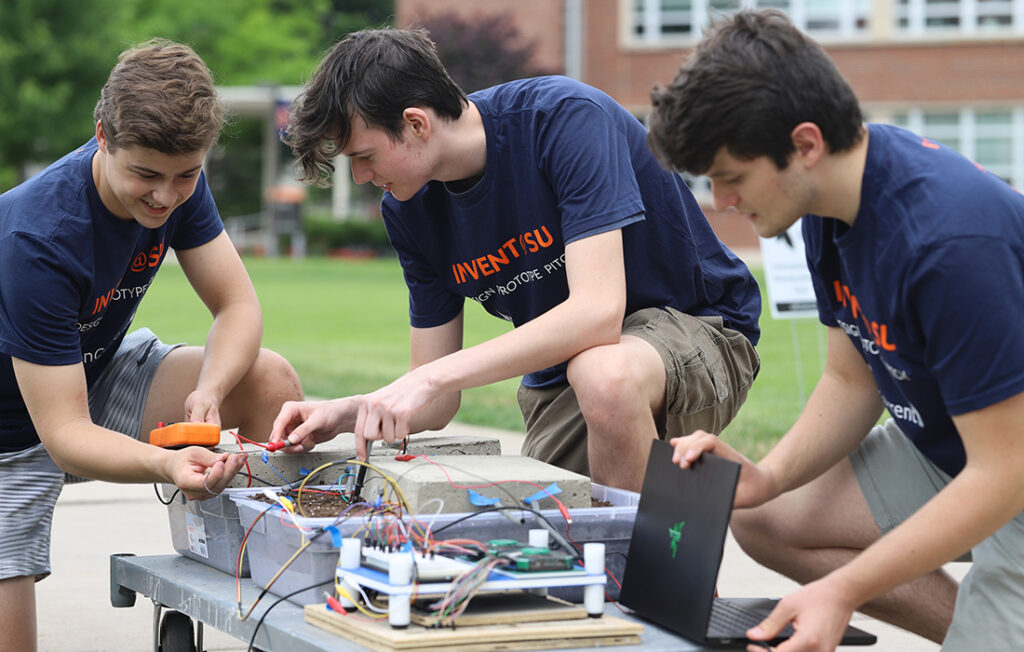
“We were thinking our invention could power things in close proximity to roadways and illumination for sidewalks like embedded lights, kind of like what you’d see at movie theatres when you’re walking down the aisle,” Murty said.
However, a single concrete block isn’t enough to generate power for crosswalks or streetlights, so they’ll need a considerable number of these devices to achieve this. These blocks have been helpful in exploring the concept of heat, concrete, and electricity and they’ve included other materials in their prototypes to amplify the temperature difference on each side of the block.
“We included a copper plate on top to absorb heat and pull it down from the surface of the concrete,” Storrs said. “The aluminum plate pulls heat from the bottom to try to cool it. The sides are also wrapped in foam insulation to reduce heat escaping. And on the bottom, we have a heat pipe, a copper tube with fluid that’s good for moving heat.”
While some may think ConCurrent is solar power with extra steps, there are some differences. Solar power relies on sunlight. ConCurrent relies on solar radiation or the heat absorbed from the sun’s radiation. This means even when the sun goes down, their invention can continue functioning since concrete absorbs and retains heat.
“It’s a resource that hasn’t really been tapped in a real effective way. We have solar, which harnesses the sun’s energy but this specific realm hasn’t been focused on,” Murty said.
The research aspect of the project was by far the most interesting part to the engineers. They would be able to continue research on ConCurrent when offered a position at the Industrial Assessment Center (IAC) at the start of fall 2022. At the assessment center, Storrs, Murty, and Mussaw assisted manufacturing companies in conserving energy by suggesting changes in lighting and other power sources. Funded by the assessment center, their work also helped them when it came to research and they spent the summer reading other academic papers and building different iterations of the design.
“It’s a relatively small research area,” Storrs said. “We did find other projects that were doing similar things like a solar collector, but those projects focus on asphalt road surfaces. They’re also different since they have pipes underneath roads that circulate water and air to collect heat.”
ConCurrent’s function heavily relies on temperature difference, so the engineers have explored ways to reduce energy loss. They’ve considered filling the empty space of their thermoelectric generator with insulation materials and conducted experiments to test the effectiveness of covering pavement with absorbent black paint, as this could help increase solar radiation absorption. Their research has also allowed them to delve deeper into understanding heat absorption in asphalt pavements. Even with their many triumphs, however, the engineers did encounter some issues along the way.
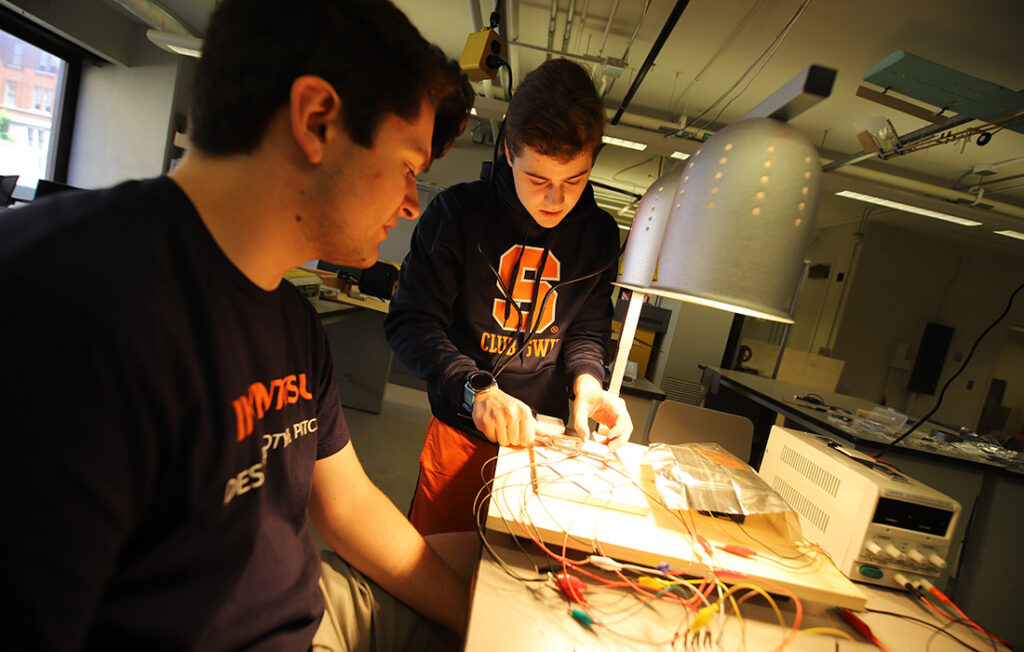
“Since we’re a self-guided research team, we’ve had to narrow the scope and direction of our project as we did our literature review,” Storrs said. “This was initially overwhelming, but we were able to meet with the engineering librarian Jaun Denzer who was enormously helpful in pointing us in the right direction.”
Despite being a self-guided group belonging to different programs within ECS, the engineering trio is far from a ragtag bunch – they’re a dream team. Whether it be Storrs’s mechanical engineering knowledge or Murty’s previous experience using modeling software in his aerospace engineering course, each member has contributed something noteworthy to the project to make it what it is today.
Mussaw, who joined the group after Invent@SU, and his electrical engineering expertise also came in handy for ConCurrent’s electrical components, something the group initially struggled with during the competition. He discussed some things he desired to achieve with this invention.
“We’re hoping to have multiple temperature sensors throughout the prototypes we’re using,” he explained. “We’re also hoping to pull weather data from Syracuse Airport so we can compare weather data from stations – there will be a lot of data analysis to paint a better picture of what’s going on.”
Matthew Brewster, a civil engineering student who exited the group after Invent@SU, was credited with designing how their invention would look and even suggested using thermoelectric generators while ConCurrent was in its early stages of development.
“One of the ideas I had initially suggested when brainstorming was developing some type of solar sidewalk where the solar cells could be laid out and pressed into wet concrete,” Storrs said. “Matthew suggested using thermo-electric generators, which I had never heard of before. We essentially just ran with it from then on.”
What began as an Invent@SU pitch has now evolved into a research project where every member, current and former, has contributed to the project’s success. And though they didn’t place in the competition, their collective drive to make a positive impact on the environment has led to the creation of innovative solutions for renewable energy. With support from the ECS faculty and their experience at the assessment center, these engineers are paving the way for clean energy solutions and revolutionizing the way we consume power.
Mechanical and Aerospace Engineering Student Theodore Todorov Joins Young Research Fellowship
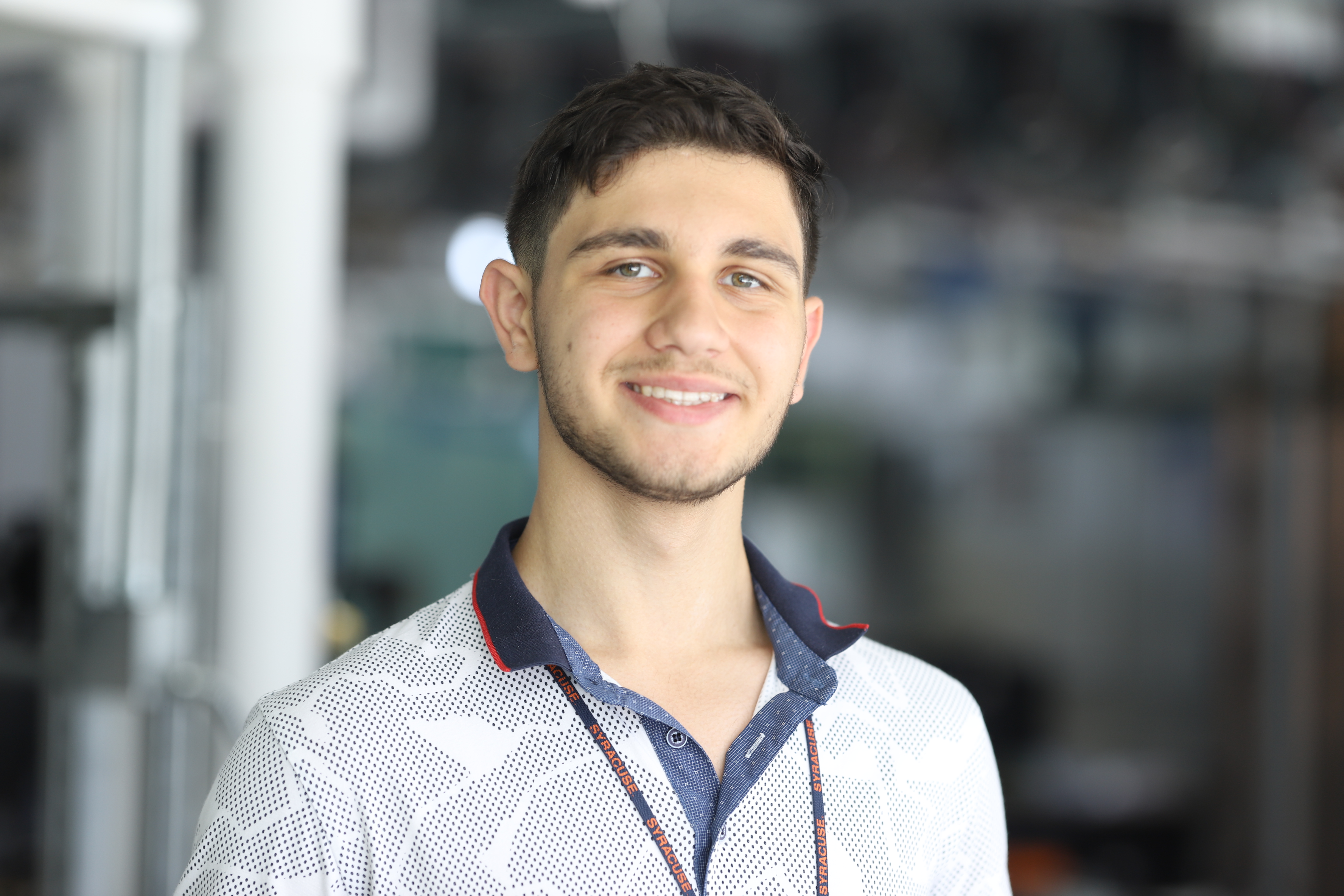
First-year aerospace engineering student, Theodore Todorov, has been selected as a CFSA-SOURCE Young Research Fellow at Syracuse University. For the next two years, he’ll work with assistant professor of electrical engineering and computer science, Pankaj K. Jha, and his team in the Quantum Technology Laboratory on classical and quantum optics projects.
Quantum optics involves studying the nature of light and how it interacts with matter. For decades, researchers have used quantum optics to better understand quantum mechanics, the study of how atomic particles interact with each other. This research has led to numerous technological developments that have now become known as the quantum revolution, or Quantum 2.0, and with his team, Professor Jha has continued conducting research on quantum technology in his lab.
Offered by Syracuse University’s Center for Fellowship and Scholarship and the Syracuse Office of Undergraduate Research and Creative Engagement, the Young Research Fellows Program supports students passionate about research. With guidance from their faculty mentors, this fellowship gives students practical experience in early research and creative inquiry development.
Some of Jha’s research focuses on novel materials that can be thinned down to a single layer of atoms and used to build extremely sensitive photodetectors that can detect light at the level of single photons. In the fellowship, Todorov’s projects will involve studying and characterizing these photodetectors and photon counting for space applications, including quantum communications, imaging distant objects, and extending the range of clear air turbulences.
Todorov first discovered his passion for writing abstracts, collecting data, and drawing conclusions through a research course he took in high school. His fascination with telescopes, quantum optics and space exploration also piqued his interest in aerospace engineering, and following his arrival at Syracuse University, he desired to connect with other students and faculty who had similar interests – this made the fellowship program at Syracuse University more than ideal for him.
“I’m happy to be a part of the Young Research Fellows Program and the community that this program wants to foster,” Todorov said.
“Quantum optics and photonics for space applications is exciting research, and we are delighted to have Theodore join our team,” Jha added.
The fellowship hasn’t stopped Todorov from pursuing other projects this summer. He’s currently working with Syracuse University’s Center of Excellence in Environmental Energy Systems on research, creating sensor boxes so the team can position them around campus and measure air quality.
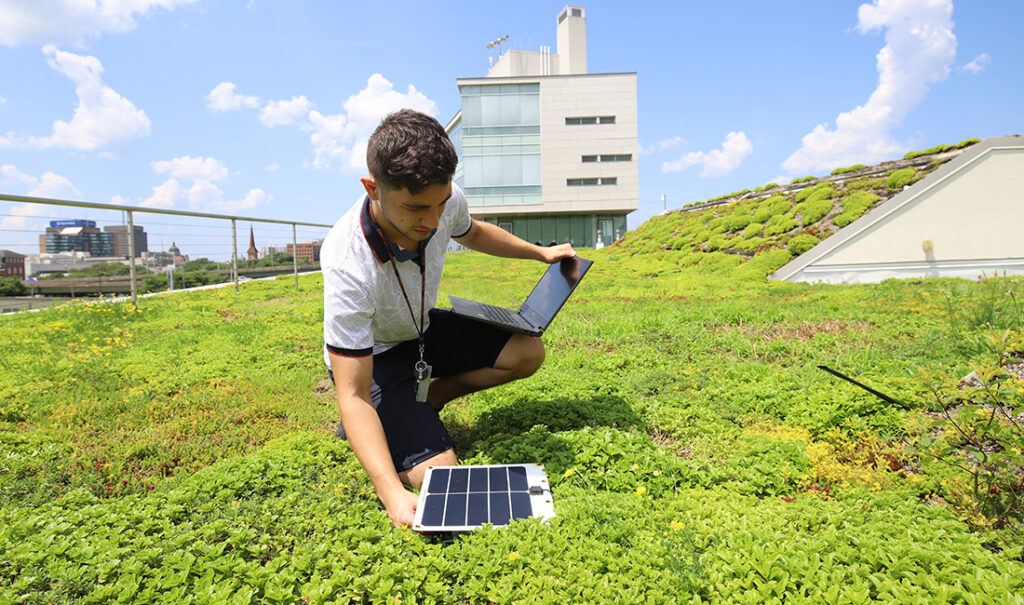
In the upcoming fall, he also plans to study the principles of classical and quantum optics and get trained in the Quantum Technology Laboratory in various experimental techniques and equipment, including lasers, single-photon detectors, and counters. He’ll focus on understanding and conducting classical and quantum interference experiments at the single photon level, analyzing the data, and writing a research paper by the end of the semester to present his work at a conference the following spring.
Professor Wanliang Shan Receives NSF CAREER Award for Research on Tunable Adhesion
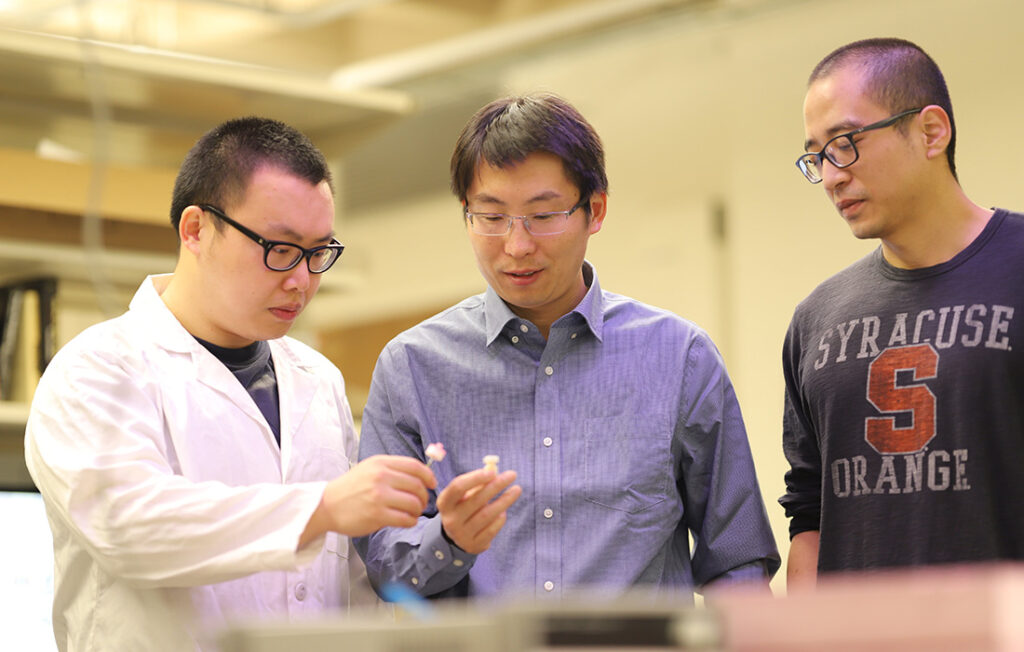
Wanliang Shan, assistant professor of mechanical and aerospace engineering at the College of Electrical Engineering and Computer Science (ECS), has received a National Science Foundation (NSF) CAREER Award to research the mechanics behind highly tunable dry adhesion for manipulating delicate and small objects.
The NSF CAREER Award supports early-career faculty with promising research and the potential to serve as academic role models. This project will significantly advance tunable adhesion for compliant manipulation, which Shan’s team has studied for the past seven years. Focused on the ability to pick up and release objects by adjusting the level of adhesion, his work has been published in high-impact journals such as Advanced Functional Materials and Advanced Materials Interfaces.
Shan’s team previously explored adhesion tuning using smart materials in soft pillars. Heating the smart material component with an electrical current, or power source, activates the device within seconds, resulting in a significant change in the adhesion of the soft pillars. This discovery earned Shan a patent which was issued in the Spring of 2022 and his team is currently working on an NSF Partnership for Innovation grant to explore the potential commercialization of this approach.
Shan’s NSF CAREER project introduces a new method for achieving tunable adhesion. Rather than using heat to activate the device, this method uses low pressure to activate adhesion which allows objects to be gripped and released efficiently at a faster rate. Shan found that a greater amount of adhesion change can be achieved within a fraction of a second compared to his previous method. This innovative approach focuses on a specific type of adhesive structure called soft hollow pillars and a provisional patent has been filed for this new approach.
The CAREER project delves deeper into understanding the mechanics behind highly tunable adhesion observed in soft hollow pillars and investigates the role of mechanical instability, specifically the buckling of thin structures under low pressure, which will give Shan insights into optimizing the design of adhesive devices. By understanding the influence of these factors, the project seeks to further improve the functionality and effectiveness of adhesive devices.
“In certain applications like manufacturing, devices need fast, repetitive movements to perform tasks,” Shan says. “In other applications, however, these devices don’t require the same movements. This is why I believe both approaches to tunable adhesion are important.”
Shan will continue incorporating findings from research into the courses he teaches at Syracuse University. Since 2019, he’s been a faculty member of ECS, where he teaches courses on solid mechanics and soft robotics. He also intends to seek internship opportunities at relevant companies for graduate students who participate in the CAREER project, a strategy he’s used to interact with industrial partners leveraging existing NSF grants. Collaborating with the Museum of Science and Technology in downtown Syracuse, he’s also proposed education and outreach initiatives such as mechanics-enabled soft robotics summer camps. These are intended to educate the general public, especially K-12 students, about his team’s research.
“There’s a significant educational aspect to this CAREER award,” Shan says. “This will be great for students and my lab at Syracuse University. I look forward to incorporating findings from this research into lecture material, both for undergrad and graduate students. The summer camps will help disseminate research outcomes to the general public and foster interest in the next generation of engineers.”
“This project not only has all the fundamentals of mechanics but also carries practical ramifications for compliant manipulation,” Shan added. “Bringing this research to my classroom and the potential impact these findings will have on technology is all very exciting. I appreciate the National Science Foundation for this award for allowing me the opportunity to carry out this exciting project.”
Mechanical Engineering Student Ruohan Xu Receives Norma Slepecky Research Prize
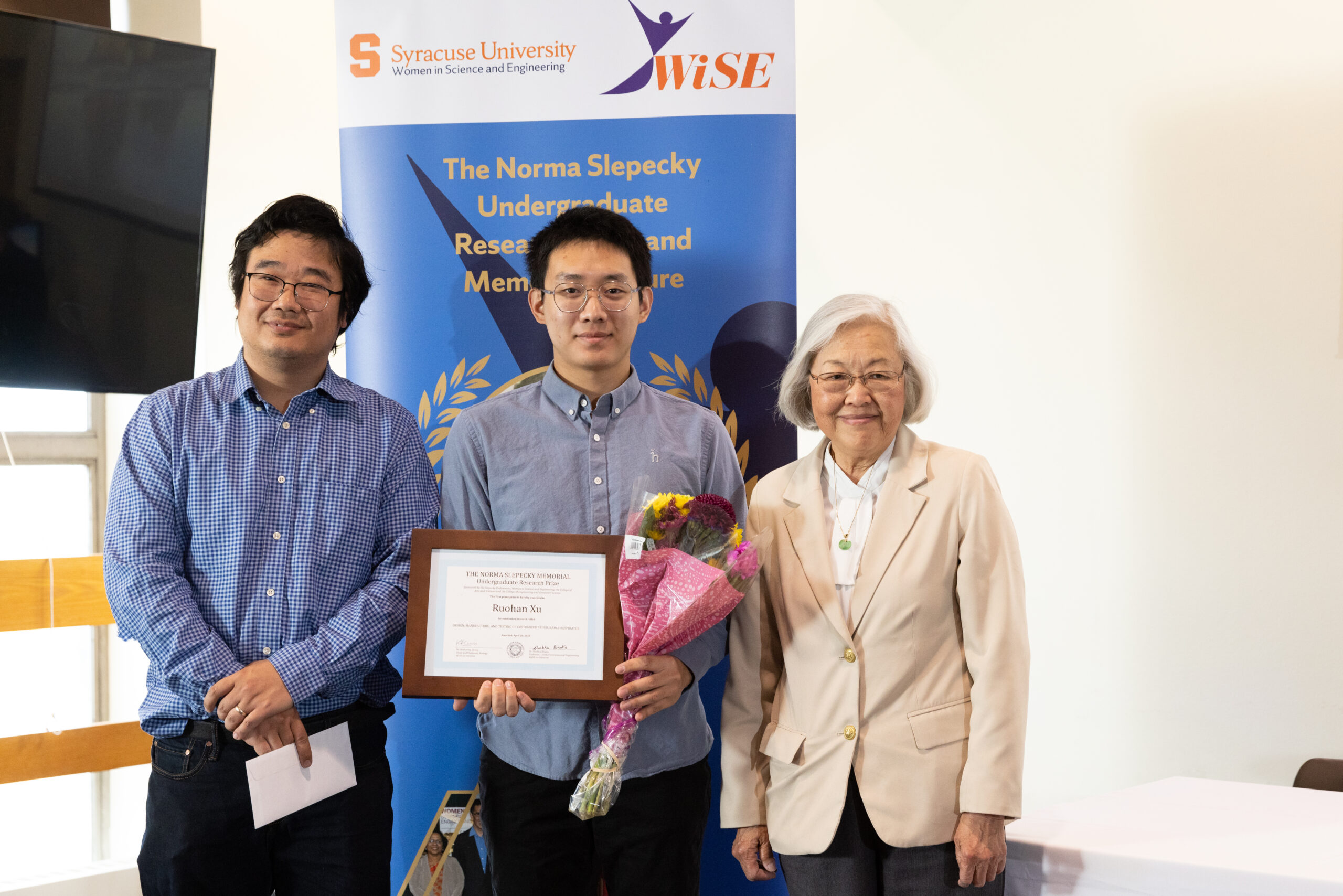
Recent mechanical engineering and applied mathematics graduate, Ruohan Xu ’23, G ’24, has received the Norma Slepecky Undergraduate Prize for his research activities. Xu received the award from the Women in Science and Engineering Review Committee and was nominated by his advisor, Civil and Environmental Professor, Zhao Qin.
In memory of the late auditory neuroanatomist and Syracuse University professor, Norma Slepecky, this award is given to a student who demonstrates a passion for research. Xu’s continued contributions to ECS embody Slepecky’s ambitious spirit and uphold her legacy as a pioneer in bioengineering.
In his first research project, Xu focused on enhancing mask design through image-based surface morphing, and his findings were published in the Journal of the Mechanical Behavior of Biomedical Materials in 2022. His second project saw him focus on the growing environment of mycelium composites for the application to infrastructure.
With two research projects and a journal publication under his belt, Xu is also an active member of his college community, currently serving as the President of the Chinese Union Syracuse and former Vice President of the Syracuse University Robotics Club. Xu is continuing his studies at Syracuse University, working towards a master’s degree in civil and environmental engineering.
Aoyi Luo
Areas of Expertise:
- Solid Mechanics
- Materials
- Design and Manufacturing
- Soft Robotics
- Thermophysics
Dr. Luo’s research group specializes in leveraging the expertise in mechanics, materials, and computational methods including data-driven methods to address cutting-edge challenges in robotics, design, and manufacturing. The group’s research encompasses a diverse range of topics, including the design and analysis of microtransfer printing processes, the development of variable stiffness structures and mechanisms, the exploration of adhesion-based soft robotic grippers, and the creation of architected materials with tailored adhesion or fracture properties. By focusing on these research thrusts, the group aims to advance the understanding and application of mechanics and materials in robotics, enabling the development of innovative designs and manufacturing techniques.
Selected Publications:
- Luo, A., Zhang, H. and Turner, K.T., 2022. Machine learning-based optimization of the design of composite pillars for dry adhesives, Extreme Mechanics Letters, 54, p.101695.
- Luo, A., Pande, S.S., Turner, K.T., 2022. Versatile adhesion-based gripping via an unstructured variable stiffness membrane, Soft Robotics.
- Luo, A., and Turner, K.T., 2022. Adhesion of beams with subsurface elastic heterogeneity. Journal of the Mechanics and Physics of Solids, 159, p.104713.
- Luo, A., and Turner, K.T., 2021. Achieving enhanced adhesion through optimal stress distributions. Journal of the Mechanics and Physics of Solids, 156, p.104610.
- Luo, A., and Turner, K.T., 2020. Mechanics of crack path selection in microtransfer printing: Challenges and opportunities for process control. Journal of the Mechanics and Physics of Solids, 143, p.104066.
- Luo, A. §, Nasab, A.M. §, Tatari, M., Chen, S., Shan, W. and Turner, K.T., 2020. Adhesion of flat-ended pillars with non-circular contacts. Soft Matter, 16(41), pp.9534-9542. (§ represents co-first author)
- Nasab, A.M. §, Luo, A. §, Sharifi, S., Turner, K.T. and Shan, W., 2020. Switchable adhesion via subsurface pressure modulation. ACS applied materials & interfaces, 12(24), pp.27717-27725. (§ represents co-first author)
- Tan, D. §, Luo, A. §, Wang, X., Shi, Z., Lei, Y., Steinhart, M., Kovalev, A., Gorb, S.N., Turner, K.T. and Xue, L., 2020. Humidity-modulated core–shell nanopillars for enhancement of gecko-inspired adhesion. ACS Applied Nano Materials, 3(4), pp.3596-3603. (§ represents co-first author)
- Luo, A. and Lior, N., 2017. Study of advancement to higher temperature membrane distillation. Desalination, 419, pp.88-100.
- Luo, A. and Lior, N., 2016. Critical review of membrane distillation performance criteria. Desalination and Water Treatment, 57(43), pp.20093-20140.
Mechanical Engineering Seniors Present Final Capstone Designs
The mechanical engineering senior capstone design course is a rigorous two-semester engineering experience intended to simulate developing a product in an industry setting. These industry-sponsored projects are designed to support the development of teamwork, critical thinking, problem solving abilities, communication skills and other key areas of expertise that prepare students for their careers. The industry partnerships provide students with valuable real world experience and networking opportunities, and the sponsoring companies receive innovative solutions to problems and the opportunity to recruit elite, young talent.
The course is co-instructed by Kenneth and Mary Ann Shaw Professor of Practice in Entrepreneurial Leadership Alexander Deyhim, and Mechanical and Aerospace Engineering Professors Mehmet Sarimurat and Ed Bogucz. Professor Deyhim describes the course as an immersive experience that pushes students to achieve excellence.
“The progress of each project is meticulously monitored through a gated review process. This process entails regular feedback and evaluation from multiple stakeholders, including the client, faculty members, fellow students, and a review panel,” says Professor Deyhim. “By engaging in this iterative review system, students receive valuable insights and recommendations at various stages of their project, facilitating continuous improvement and aligning their efforts with the client’s expectations. This year, seven teams completed capstone projects; the final presentations were excellent, and every single team impressed our esteemed panel of industry judges.”
Here are the 2022-2023 mechanical engineering senior design capstone projects:
Additively Manufactured Cold Plate
Sponsor: Lockheed Martin
Working with Lockheed Martin, the team designed, tested and determined the best way to produce an additively manufactured (3D printed) cold plate to be used in various applications for the company’s numerous radar electronics. This is a critical design because Lockheed Martin’s products can reach temperatures up to KW/cm2. The team evaluated multiple designs with complex geometric flow paths and determined appropriate material for manufacturing the cold plate while considering cost and functionality.
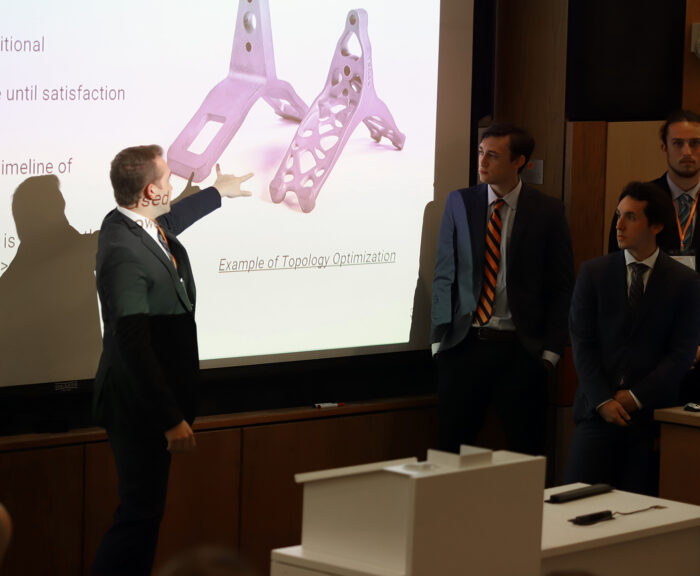
Automated Inspection of Jet Engine Components
Sponsor: GE Aviation
The team advanced the development of a solution allowing the inspection of turbine discs using cameras and artificial intelligence to determine if there are any small cracks or defects that could damage the engine. The goal of this project was to design a system to remove human error and increase efficiency of the inspection process. The team assisted GE in developing an automated white light digital system for the part inspection with a focus on pass-through features.
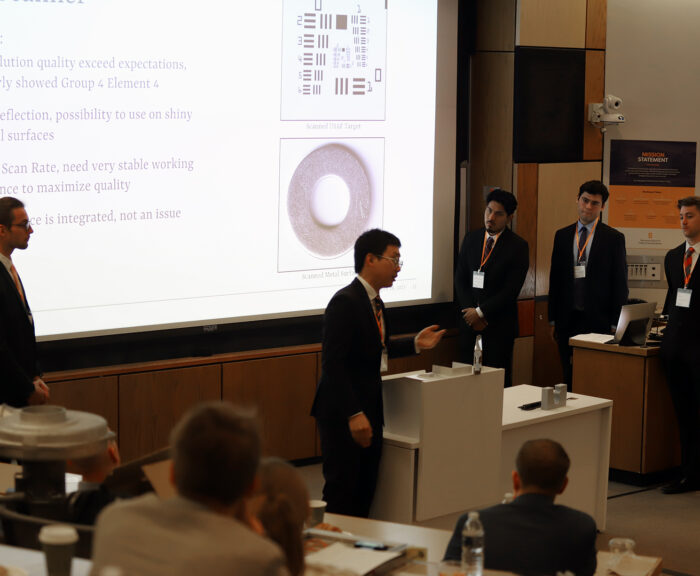
Dairy Cover and Conveyor Belt Cleaners Redesign
Sponsor: Berry Global
The team was tasked with helping Berry Global, an international plastic packaging company, to increase the efficiency of their injection molding process. The team provided a design and prototype for a portable way to clean the cover from the ground without needing to stop production. The proposed design is an automated device that sits on the framework of the dairy covers and will sweep debris and particles into dustbins located on the two sides on the dairy cover.

Compact High Efficiency Air Handling Unit
Sponsor: Upstate Parts & Supply Inc.
Centrifugal fans have been at the forefront of cleanroom technology and have been the industry standard for a long time. Mechanical and Aerospace Professor Mehmet Sarimurat and Former Mechanical and Aerospace Engineering Professor Thong Dang designed a new axial fan to be utilized in a microchip manufacturing plant (Class 1000) which uses less energy. The team’s role was to first design an FFU (fan filter unit) that can house the fan while being compatible with a high efficiency particle arresting (HEPA) filter. Once the designed FFU and fixture system were in place, the team conducted performance testing of the fan with attention being paid to how the designed system works with the fan and if the performance is superior to a traditional centrifugal one.

Occupancy Based Smart Vent
Sponsor: WellBuilding Control
WellBuilding Control is a company started by Mechanical and Aerospace Engineering Professor Dr. Bing Dong, whose research focuses on heating, ventilation and air conditioning (HVAC) systems. The team was brought in to focus on developing an occupancy control HVAC system that will reduce energy consumption in heating and cooling buildings. This system will reduce carbon emissions and save money for consumers. The team concluded that an automated air register vent would be the most effective method of achieving the goal. The team then created a design and prototype of a control vent that will open and close automatically when a room becomes occupied or unoccupied to control the air flow to that room. The vent will also control indoor air quality using a CO2 sensor that will turn on a fan that will blow air and reduce the CO2 levels.

Desiccant Hopper Redesign
Sponsor: Cryomech
The team was brought in to help Cryomech, a manufacturer of cryogenic cooling applications that use helium gas as the working fluid in a helium compressor, to design an improved hopper system. Helium compressor packages made by Cryomech use desiccant adsorbers to “clean” helium as it is cooled to temperatures as low as 4K. Currently, the molecular sieve and granular activated charcoal used in the adsorbers is being contaminated from atmospheric exposure. The team designed and created a prototype of a hopper system that will keep the desiccants clean and reduce production time.

Integrated Sustainable Building Design Competition
Sponsor: ASHRAE
The team entered the 2023 Integrated Sustainable Building Design Competition, specifically the HVAC Design Calculations competition. The project’s objective was to fully design an HVAC system for a laboratory facility located in Cairo, Egypt. The team submitted a 35-page technical report including all the work and calculations, along with analysis explaining the logic. For this competition, the team was required to adhere to the most up to date American Society of Heating, Refrigeration and Air-Conditioning Engineers (ASHRAE) standards. Representatives from Carrier Corporation also mentored the team, assisting them with the ins and outs of learning their Hourly Analysis Program (HAP) software to get the load calculations.

Spring 2023 Engineering and Computer Science Academic Department Awards
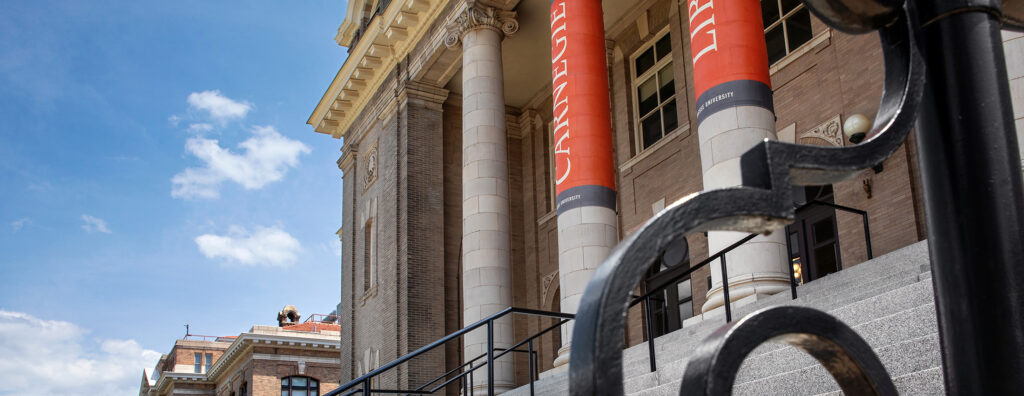
The College of Engineering and Computer Science is proud to announce the students who received awards at the end of the 2022-2023 academic year from their academic department.
Biomedical and Chemical Engineering
The Bioengineering Founders Award
Grace Haas
Karen M. Hiiemae Outstanding Achievement Award in Bioengineering
Gabriel Khan
Oren Nagasako Award
Megan Perlman
Outstanding Achievement Award in Chemical Engineering
Adam Klinger
The Allen J. Barduhn Award
Jacob Shellhamer
Outstanding Graduate Student in Biomedical Engineering
Tackla Winston
Outstanding Graduate Student in Chemical Engineering
Robson Schuraca
Civil and Environmental Engineering
Outstanding Achievement Award in Environmental Engineering
Benjamin Cavarra
K.L. Lui Memorial Award
Aymeric Destrée
The John Burch McMorran ’22 Award
Adam Landry
Outstanding Graduate Student in Civil & Environmental Engineering
Joseph Wasswa
Dr. James A. Mandel Prize for Achievement in Civil and Environmental Engineering
Haben Legesse
Samuel P. Clemence Prize for Outstanding Senior Design
Nagdalina Baez
Masson Bruening
Benjamin Cavarra
Kate Kemnitz
Adam Landry
Civil & Environmental Engineering Faculty Awards
Kate Kemnitz
Paige Yamane
Electrical Engineering and Computer Science
The Warren Semon Prize
Ryan M. May
Outstanding Achievement Award in Computer & Information Science
Matthew J. Cufari
Outstanding Achievement Award in Computer Engineering
Kyle D. Maiorana
The Outstanding Achievement Award in Electrical Engineering
Jared W. Welch
Outstanding Graduate Student in Computer Engineering
Sihao Ren
Outstanding Graduate Student in Computer Science
Sai Saran Macha
Outstanding Graduate Student in Electrical Engineering
Nicholas S. Connolly
The IEEE Computer Engineering Award
Mehak Jetly
The IEEE Electrical Engineering Award
Jemma Mallia
IEEE PES Scholarship
Jemma Mallia
Outstanding Graduate Student in Cybersecurity
Kyungrok Won
William Peil Awards
Kyle Maiorana
Julia Pepin
Wyatt G. Bush
Samsondeen Batula
Mechanical and Aerospace Engineering
Outstanding Aerospace Engineering Academic Achievement Awards
Anthony Tricarico
Christian Fitzgerald
Award for Excellence by Aerospace Engineering Senior
Evan Moore
Award for Achievement by Aerospace Engineering Senior
Madeline Phelan
The Richard Heimburg Achievement Award in Aerospace
Zachary Stahl
Charles Libove Memorial Award for Outstanding Aerospace Senior
Melissa Yeung
Award for Excellence by Aerospace Engineering Junior
Sydney Jud
Zachary Haas
Awards for Achievement by Aerospace Engineering Juniors
Isaac Lehigh
Cody VanNostrand
Benjamin Gerard
Ross Evan-Iwanowski Memorial Award
John Michinko
Ellen H. Honnold Memorial Scholarship
William Saueressig
Awards for Excellence by Aerospace Engineering Sophomores
Jonathan Martin
Parker McMillan
Awards for Achievement by Aerospace Engineering Sophomores
Alexander Donato
Kathryn Smith
Kin-Nee Tong Award
Maximillian Lipinski
Awards for Achievement by Aerospace Engineering First Year Students
Quinn Young
Zachary Munkacsy
Jason Reid
Joshua Varkey
William Peil Inventor’s Award
Christian Fitzgerald
Madeline Phelan
Katherine Braun
Outstanding Mechanical Engineering Academic Achievement Award
Joshua Arndt
Award for Achievement by Mechanical Engineering Senior
Nathaniel Slabaugh
Jay Wyner Award for Excellence in Mechanical Engineering
Luyen Duong
Bernard Wood Creative Achievement Award in Mechanical Engineering
Arnaud Buard
Jesse E. Rood Memorial Scholarship
Eric Silfies
Karl Carnevale Memorial Scholarships
Zachary Shuler
Awards for Achievement by Mechanical Engineering Juniors
Honorata Lubecka
Alexander Callo
Hugh C. Dugan Memorial Scholarships
Joseph Capra
Bei Luo
Award for Excellence by Mechanical Engineering Sophomore
Chloe Marie Britton Naime
Awards for Achievement by Mechanical Engineering Sophomores
Nathaniel Paradis
Jeffrey Bernstein
Aidan Bergman
James Melitski
Kin-Nee Tong Memorial Scholarship
Brinley Bruening
Kin-Nee Tong Award
Madeline Scott
Awards for Achievement by Mechanical Engineering First Year Students
Jennifer Mason
Gavin Johnson
William Peil Inventor Awards
Justin Kohan
Connor Norton
Melissa Jane Hiller
Kaelyn Rooney
Renee Allison
Louis N. DeMartini Award for Outstanding Research
Eric Silfies
Outstanding Graduate Student in Engineering Management
Ethan Tracey
Outstanding Achievement Award in Graduate Study
Camila Alexandra Humala Noriega
Outstanding Faculty Award
Professor Shalabh Maroo
Mechanical and Aerospace Engineering Award for Teaching Excellence
Professor Alexander Deyhim
Career Focused: Engineering and Computer Science Class of 2022 Reporting High Placement Rate
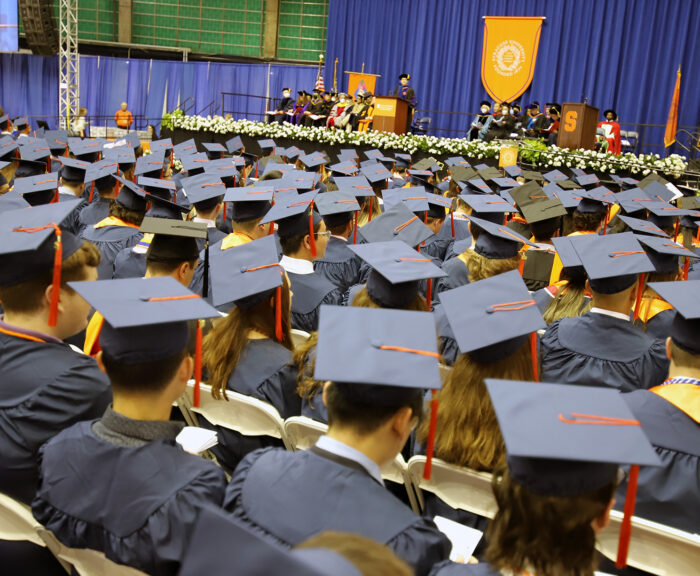
The starting salaries for graduates receiving a Bachelor of Science degree from the College of Engineering and Computer Science (ECS) has grown steadily for the last six years.
The average starting salary for the class of 2022 was $76,679. A total increase of $17,000 since 2016.
The placement rate for the class of 2022 was 93%. More than half of all graduates have started their careers and 33% are pursuing an advanced degree.
The ECS Career Services team provides students with support to reach their professional goals. They help students build their network with connections to industry leaders and alumni through information sessions, company tabling, career fairs, on-campus interviewing and more. Additional support through workshops, seminars, and drop-in advising ensures students have access to development opportunities that give them an edge in today’s job market.
Class of 2022 Top 25 Employers
- Applied Materials
- Boston Scientific
- Brainlab
- Bristol Myers Squibb
- Burns & McDonnell
- Carrier
- Deloitte
- General Dynamics, Electric Boat
- IBM
- Kimley-Horn
- L3Harris Technologies
- Lockheed Martin
- Meta
- Morningstar, Inc.
- National Grid Pfizer, Inc.
- Pratt & Whitney, a Raytheon Technologies Company (RTX)
- Qualcomm
- SRC, Inc
- The Boeing Company
- The Walt Disney Company
- Turner Construction Company
- Weston & Sampson
- Whiting-Turner Contracting Company
- WSP
Class of 2022 Graduate Schools
- Boston University
- Brown University
- Clarkson University
- Columbia University
- Cornell University
- Duke University
- Georgia Institute of Technology
- Icahn School of Medicine at Mount Sinai
- Northwestern University
- Princeton University
- SUNY Binghamton
- SUNY Stony Brook
- Syracuse University
- University North Carolina, Wilmington
- University of Maryland, College Park
- University of Michigan
- University of Minnesota
- University of Southern California
Data reflects information on 281 of 312 undergraduate degree recipients in 2022, representing a 90% knowledge rate.
Aerospace and Civil Engineering Students Selected as Goldwater Scholars

Two students from the College of Engineering and Computer Science (ECS) have been selected for the 2023 Goldwater Scholarship, the preeminent undergraduate scholarship awarded in the natural sciences, engineering and mathematics in the United States. Cody VanNostrand, a junior aerospace engineering major, and Jose Arturo Venegas, a sophomore civil engineering major, were the students selected from ECS. Matthew Snyder, a psychology major from the College of Arts and Sciences, was also selected for a Goldwater Scholarship. This is the second consecutive year that Syracuse University has had three scholars selected in one year.
The Barry Goldwater Scholarship and Excellence in Education Program was established by Congress in 1986 to honor U.S. Sen. Barry Goldwater, the five-term senator from Arizona. The purpose of the program is to provide a continuing source of highly qualified scientists, mathematicians and engineers by awarding scholarships to students who intend to pursue research careers in these fields.
The Goldwater Foundation received 1,267 nominations this year from around the country and 413 students were selected for the scholarship.
Each of the Syracuse University Goldwater Scholarship nominees worked with the Center for Fellowship and Scholarship Advising (CFSA) to prepare their application. A faculty committee, headed by James Spencer, professor of chemistry, selected Syracuse’s nominees for the national competition.
Cody VanNostrand
VanNostrand’s drive to study aerospace engineering comes from his desire to benefit society, specifically through improving transportation and aerospace vehicle capabilities. “Whether it be the upcoming urban air mobility industry, fluid-traversing robots or new types of space propulsion, a more mobile society will be able to better collect information and respond to the challenges it will face,” he says. “The aerospace field is one that is forward-looking, always with new ideas, technologies and challenges just around the corner, and I am excited to help create new ideas and solve such challenges.”
His study abroad experience in Florence, Italy, confirmed his intended path of study. “I was able to visit museums in my free time featuring the original instruments of scientists and engineers such as Galilei, DaVinci and even Bernoulli. Seeing the original instruments and how they directly related to the fundamental concepts of my coursework was both humbling and inspiring,” he says.
VanNostrand has seized opportunities for research since his first year in college. In Spring 2021, he joined the Aerospace Computational Methods Lab (ACML) of John Dannenhoffer, associate professor of mechanical and aerospace engineering. That summer, he participated in a Research Experience for Undergraduates (REU) program in which he and a partner remotely coded and developed two models of balsa planes. In Summer 2022, as part of an REU program, he joined the Combustion and Energy Research Lab (COMER) of Jeongmin Ahn, associate professor of mechanical and aerospace engineering, where he learned how to design and make a testing procedure for solid oxide fuel cells (SOFCs). He is second author on a paper published in the Proceedings of the Nineteenth International Conference on Flow Dynamics. Last year, he was selected to participate in the L’SPACE NASA workforce development program. The experience he has gained in writing proposals, using quad charts, science traceability matrices, solicitation reviews and team-based research has helped to prepare him for a career in the space industry.
VanNostrand is currently working on his Honors thesis project investigating the fin oscillations of the manta ray via a model of his design, under the mentorship of Kasey Laurent, assistant professor of mechanical and aerospace engineering. He plans to obtain a Ph.D. in aerospace engineering and pursue research and development in aerospace robotics at NASA’s Jet Propulsion Laboratory or in the private space industry.
“The Goldwater Scholarship is an amazing opportunity that will not only financially support the beginning of my career, but will also open me up to a network of scholar alumni that offer mentoring and advice; this will be immensely useful as I begin looking at graduate school,” he says. “I am incredibly honored to have been selected for this scholarship, and I am thankful for all the guidance I’ve received from the mechanical and aerospace engineering department and CFSA, and especially for continuous support from my friends and family.”
Jose Arturo Venegas
Venegas’ long-term goal is to aid as many people as possible while improving the conditions of the natural environment. “Civil engineering provides me with an avenue to improve the natural integration of infrastructure and utilities we use on a daily basis, while incorporating my passion for sciences, math and sustainability. I appreciate the career flexibility and hands-on field work that civil engineering allows,” he says.
Even before getting to the Syracuse University campus, Venegas began conducting research in the multiscale material modeling lab of Zhao Qin, assistant professor of civil and environmental engineering. He developed an independent research project focused on verifying whether a structurally complex fiber-reinforced composite expressed a real-world negative Poisson’s ratio during compression. Through this research, Venegas has used classical lamination theory to identify a baseline of mechanics for composite structure variations. He has also utilized computer-aided modeling and finite element analysis to support the elastic data predicted in in-situ imaging experiments.
Venegas gained additional research experience participating in a National Science Foundation REU program in materials science research at the University of California-Irvine in Summer 2022. He worked on two projects–one in an all-solid-state battery lab and another in a grain boundary (GB) characterization lab. “Each project provided me with insights into electrochemistry and materials science,” he says. Venegas was a part of the Strasbourg Center: Engineering program in fall 2022.
Venegas plans to earn a Ph.D. in civil engineering and pursue research on ecologically sound building material composites, with the goal of revolutionizing sustainable infrastructure in the U.S.
“The Goldwater Scholarship supports my commitment to materials research to expand energy infrastructure globally. I’m also excited to get involved in the Goldwater Ambassadors program to provide STEM mentorship to other students. I am honored to be recognized and could not have done it without the support of my research mentor, Dr. Zhao Qin, the Center for Fellowship and Scholarship Advising, my family and friends and many more,” says Venegas.
CFSA seeks applicants for the Goldwater Scholarship each fall; the campus deadline is mid-November each year. Interested students should contact CFSA at cfsa@syr.edu.
Environmental Excellence: Eric Gerstenberg ’89
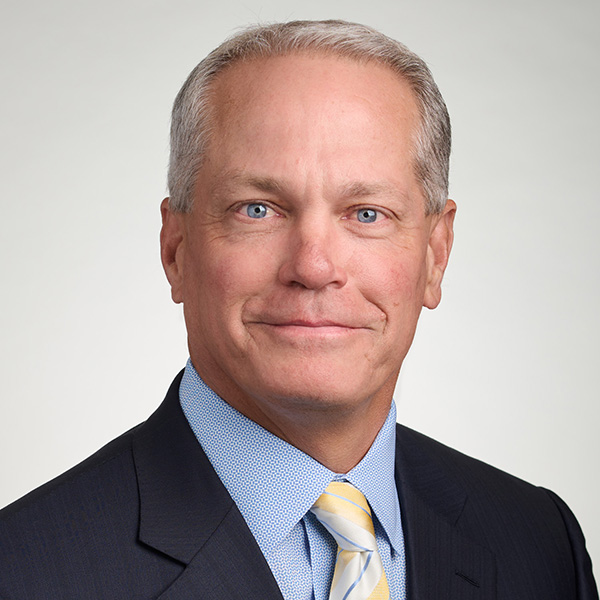
When Eric Gerstenberg started at Clean Harbors, he was about as far from the C-suite as he could be. After graduating from Syracuse University, Gerstenberg landed a job at the company as a field lab technician. He went out in a truck and took care of chemicals or materials that companies in eastern Massachusetts needed to either recycle or dispose of. At the time, Clean Harbors was a relatively small company helping businesses and government agencies but the need for the company’s environmental and industrial services was growing each year.
“I was given the opportunity to excel through advancing with the company,” says Gerstenberg.
Gerstenberg moved into a role running a business unit for Clean Harbors in Natick, Massachusetts and then managing larger facilities in Baltimore and Chicago.
“When I moved into a supervisory role, I learned a lot about the environmental industry,” says Gerstenberg.
Gerstenberg had been an aerospace engineering major at the College of Engineering and Computer Science but found that the fundamental engineering and problem-solving skills he gained at Syracuse University were helping him thrive at Clean Harbors.
“I was applying science and business skills,” says Gerstenberg. “The engineering curriculum got me exposed to the important principles of material science.”
As Clean Harbors continued to grow, so did the opportunities for Gerstenberg. The one-time field lab technician took positions as the president of the environmental, industrial & field services business, vice president of disposal services and executive vice president for environmental services. In 2015, Gerstenberg was named as the chief operating officer for Clean Harbors which had grown into a five billion dollar company with 20,000 employees. On March 31st, Gerstenberg and Clean Harbors chief financial officer Michael Battles will become co-CEOs of the company, succeeding founder Alan McKim.
Gerstenberg is grateful for his time as a student at Syracuse University and what it had to offer. He is especially eager to help engineering and computer science students looking to start their careers or take a step forward.
“Now I get to offer opportunities to talented young engineers who want to grow their career,” says Gerstenberg. “Syracuse is where I made many of my lifelong friends. It created an experience where I was exposed to a diversity of education, diversity of people and many different channels.”
Gerstenberg spends more of his time focused on the overall business operations at Clean Harbors than hands-on engineering but his Syracuse University degree is still proving its worth.
“An engineering education helps people be better problem solvers using methodical approaches. They can think through problems, understand the details and dig deep. It helps you analyze a problem and have that process,” says Gerstenberg. “I can use these skills in recycling and disposal as well as revenue growth and business operations.”
Gerstenberg sees a bright future for current engineering and computer science students and hopes they can learn from the adaptability he has shown over his career.
“Be open-minded in your approach to what opportunities you look at,” says Gerstenberg. “Be willing to travel and willing to relocate – you can do so many things with an engineering degree.”
Mechanical and Aerospace Engineering Professor Yiyang Sun Launches “Women in Aerospace” Program at Syracuse University
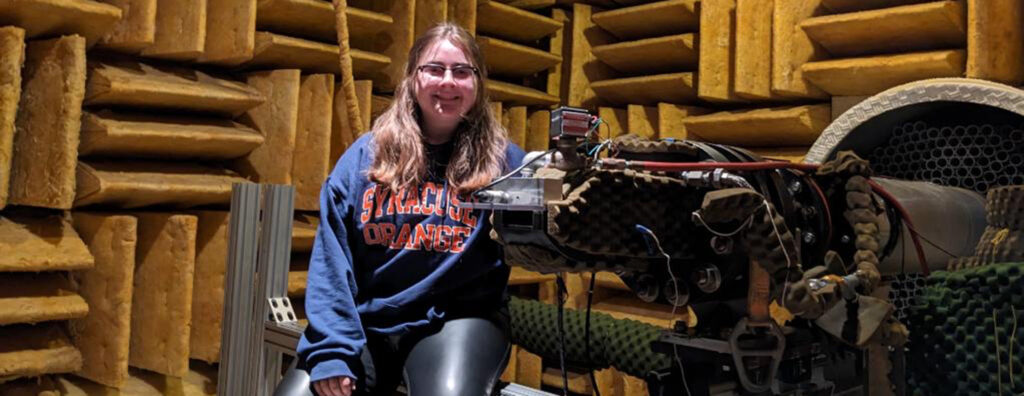
Mechanical and Aerospace Engineering Professor Yiyang Sun is committed to promoting greater participation of women in the aerospace field so that it benefits from their diverse perspectives and backgrounds. Since societal relevance is essential to selecting majors and careers for women, Professor Sun has designed educational and outreach activities to help more young women see the relevance of aerospace engineering to society and pursue an aerospace-relevant career.
The “Women in Aerospace Series” will be conducted annually and consists of events to be held in the spring, summer, and fall semesters. Each event provides education and research content appropriate for different needs, from an introduction to various career pathways to mastering research skills.
Spring Semester – Coffee Hour Network event
The program will feature a student panel followed by invited speakers and provide time for Q&A. This Coffee Hour Network aims to help students form a big picture of potential career pathways and provide students with access to resources that will foster their attainment of career goals.
Summer Semester – Providing research experiences for undergraduate and high school students
A 6-week summer research experience is designed for undergraduate students. The project provides enough time for students to understand the fundamentals while being able to complete an innovative research plan. Professor Sun will make the research skills and methods they learn during the summer semester more relevant to general concepts in the aerospace field, such as data measurement and flow simulation, so the research experience they receive can yield a broader influence on their future career.
Professor Sun has also collaborated with the Syracuse University Office of Pre-College Programs to provide a 2-week summer research immersion program entitled “Seizing the Sky: Introduction and Application of Aerodynamic Flow Control.” During the two weeks, high-school students will rotate between computational and experimental laboratories, interacting with college students to learn emerging research topics and cutting-edge methods of tackling aerodynamic problems. The high-school students will be assigned small tasks, such as simple Matlab programming, numerical simulation of fluid flows, and experimental data measurements in a supersonic wind tunnel and a high-speed jet facility. It is expected that high school students can complete the tasks with necessary help from Dr. Sun’s research group and obtain the basic skills that can be taken away for more general usage in their future studies and career.
Fall Semester – Conference attendance and student mentoring
The program offered in the fall semester aims to provide undergraduate students who have engaged in research over the past spring and summer semesters with more advanced mentorship in conducting research and support their participation at world-class conferences. It serves as an opportunity for undergraduate students to complete the “Women in Aerospace Series” program and present their research results to professionals in public.
Fernando Zigunov
Degrees:
- Ph.D. Florida State University, Tallahassee, 2020
- B.S. Universidade do Vale do Rio dos Sinos, Rio Grande do Sul, Brazil, 2017
Areas of Expertise:
- Aerodynamics
- Machine Learning Flow Control
- Experimental Fluid Dynamics
- Flow Visualization and Tomography
Lab/ Center/ Institute affiliation: Skytop Turbulence Laboratory
Dr. Fernando Zigunov’s research is focused on leveraging automated experiments in fluid dynamics to deploy machine learning systems that can achieve tangible engineering goals to control various complex flow problems to develop and improve future aircraft and energy production systems. Dr. Zigunov also has extensive expertise in volumetric flow diagnostic techniques such as tomographic and scanning PIV, as well as time-resolved PSP, shadowgraph and schlieren. He is also interested in using data assimilation and modal analysis techniques to distill complex experimental data and understand its dynamical behavior.
Honors and Awards:
- 2018-2020: Recipient of the Don Fuqua Fellowship Award
- 2015-2016: Exchange Scholarship under the Brazilian Scientific Mobility Program (BSMP)
Selected Publications:
- Zigunov, Fernando; Serdar Seckin, Rhylan Huss, Cameron Eggart and Farrukh Alvi. A continuously scanning spatiotemporal averaging method for obtaining volumetric mean flow measurements with stereoscopic PIV. Experiments in Fluids, 64(3):56, Mar 2023
- Zigunov, Fernando, Prabu Sellappan, and Farrukh Alvi. Reduction of noise in cold and hot supersonic jets using active flow control guided by a genetic algorithm. Journal of Fluid Mechanics, 2022
- Zigunov, Fernando, Prabu Sellappan, Farrukh Alvi, Yuta Ozawa, Yuji Saito, Taku Nonomura, and Keisuke Asai. Time-resolved particle image velocimetry and pressure sensitive paint measurements of afterbody flow dynamics. Phys. Rev. Fluids, 7:024701, Feb 2022
- Zigunov, Fernando, Prabu Sellappan, and Farrukh Alvi. Reynolds number and slant angle effects on the flow over a slanted cylinder afterbody. Journal of Fluid Mechanics, 893:A11, 2020
Ian M. Shapiro
Lab/ Center/ Institute Affiliation:
Associate Director of Building Science and Community Programs, Syracuse University Center of Excellence in Environmental and Energy Systems
Areas of Expertise:
- Heat pumps
- Building science
- Green building design and retrofits
- Affordability in approaches to reduced carbon emissions
Primary area of expertise is heat pumps. Has designed heat pumps for production at Carrier Corporation, consulted to multiple heat pump manufacturers, authored original heat pump theory, been awarded multiple patents relating to heat pumps and air conditioning, and done research on multiple types of heat pumps (air source, water source, vertical stack, air-to-water, etc.). Other areas of work have included lighting controls, heat pump water heaters, indoor air quality, and enclosure (insulation and window) design. Has developed a new metric to quantify building shape efficiency to minimize carbon emissions. Has authored a novel energy code that emphasizes affordability in new building design. Founded a successful consulting engineering firm, Taitem Engineering, based in Ithaca, NY, and continues to serve as partner and board member.
Honors and Awards:
- New York State Green Building Advocate of the Year, 2016
- Leader of a team that won the R&D100 award in 2005 for one of the 100 most significant innovations nationally. Team participants included the National Renewable Energy Lab and NYSERDA. For: Residential energy analysis software. The software is still in wide use, over 20 years after its introduction.
Books:
Co-author, Ithaca Energy Code Supplement (2021). This local energy code is one of the most advanced in the nation, currently requiring 80% lower carbon emissions for the design of new buildings, progressing to 100% reduced carbon emissions (fossil-fuel-free, net-zero energy) on January 1, 2026.
Co-author (with Francis D.K. Ching) of the textbook Green Building Illustrated (2nd edition 2020, Wiley). Translated into Chinese, Spanish, Portuguese, and Korean.
Author of the textbook Energy Audits and Improvements for Commercial Buildings (2016, Wiley).
Selected Publications:
“Preventing Refrigerant Leaks in Heat Pumps.” ASHRAE Journal. January 2020. Co-author with Jon Harrod.
“Ithaca’s Example: Toward Zero Carbon Buildings”, High Performing Buildings Magazine, a publication of ASHRAE. July 2019.
“Heating Loads: Upstairs Versus Downstairs.” Home Energy Magazine. Fall 2017.
“Boosting Multifamily Energy Savings Through Lighting Control Settings,” Home Energy, August/September 2013.
“Air Infiltration Measurements in Buildings Using Sound Transmission Loss Through Small Apertures,” International Journal of Green Energy, May, 2012.
“The Receptivity of Roofs to Solar Panels,” Sciforum’s 2nd World Sustainability Forum, November, 2012.
“HVAC Selection for Envelope Dominated Buildings,” ASHRAE Journal, October 2011.
“Air Bypass in Vertical Stack Water Source Heat Pumps,” HVAC&R Research, October 20x`11.
“Design from the Outside In,” Journal of Green Building, Volume 5.1, Winter 2010.
“Water and Energy Use in Steam-Heated Buildings“, ASHRAE Journal, May 2010.
“Energy Audits in Large Commercial Office Buildings,” ASHRAE Journal, January 2009.
“The Impact of Accessibility on Air Filter Cleanliness,” INvironment Professional, January 1999, Vol. 5, No. 1.
Matthew Erdman
Areas of Expertise:
- Computational Fluid Dynamics
- Heat and Mass Transfer
- Multiphase Flow
- Measurements and Instrumentation
- Hydropower
Matthew Erdman earned his PhD from the Pennsylvania State University by utilizing commercial computational fluid dynamics software to improve the multiphase mass transfer models for Eulerian-Eulerian flow. His M.S. (also at Penn State) focused on improving the off-design efficiencies in hydraulic turbines. While at Penn State, he taught and coordinated the lab portion of the Measurement, Instrumentation and Statistics course for seven years. He then led the laboratory redesign of the above course as it transitioned into the Circuit Analysis, Instrumentation, and Statistics course.
Honors and Awards:
- Hydro-Research Foundation Research Award (2014)
- Vice Admiral E.L. Cochrane Award (2014) for best peer-reviewed paper published by the Society of Naval Architects and Marine Engineers
- Outstanding Mechanical Engineering Award, Penn State Behrend (2013)
Selected Publications:
Johnson, B., Lasher, W.C., Erdman, M., Miles, J., & Curry, B. “Uncertainties in the Wind-Heel Analysis of Traditional Sailing Vessels: The Challenges it presents for Forensic Analysis of Sailing Vessel Incidents,” 2013 Chesapeake Sailing Yacht Symposium. Annapolis, MD, March 2013.
Engineering and Computer Science Students Attend the 2023 Lockheed Martin Ethics in Engineering Competition
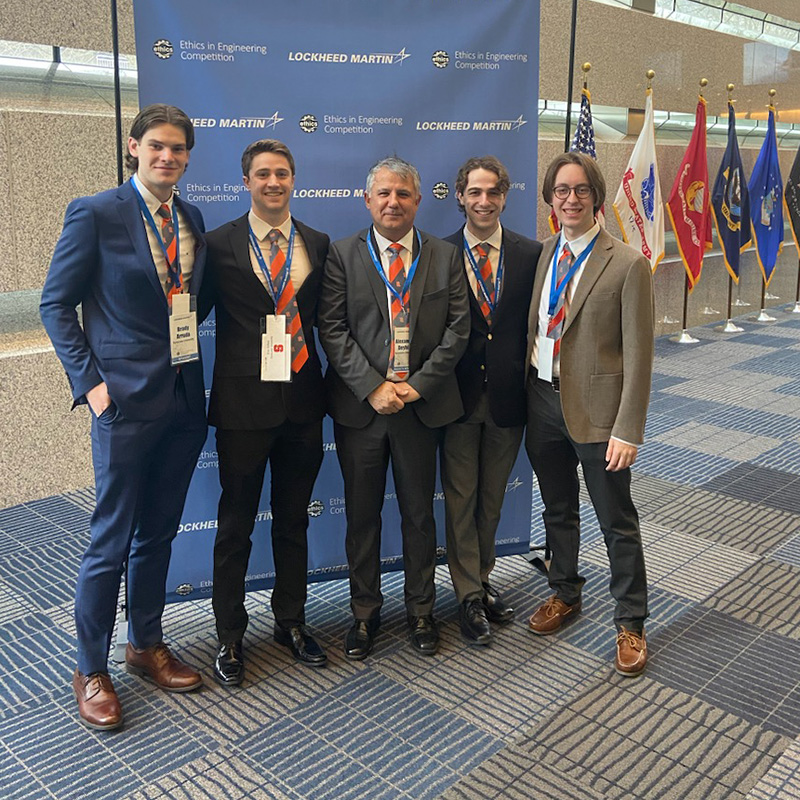
Engineering and Computer Science students Eric Silfies ’23, Brady Arruda ’25, Oliver Raycroft ’25, Max Lipinski ’24 and Mechanical and Aerospace Engineering Professor Alex Deyhim attended the Lockheed Martin Center for Leadership Excellence in Bethesda, Maryland for the LM Ethics in Engineering Competition. More than 70 universities are part of the engineering case competition that focuses on real-life dilemmas that can arise in the workplace, especially in the multifaceted and fast-paced world of technology. The competition is an annual event that compels students to think about the importance of ethics in the workplace.
“I’m very proud of the four students who represented the Syracuse University and the College of Engineering & Computer Science in the best way possible. The students showed themselves to be professional, respectful and technically competent. Further, the students commented that they learned the critical importance of not just having technical knowledge, but being able to communicate that knowledge in an effective and productive manner to arrive at ethical outcomes,” said Deyhim.
“Engineers don’t often have every piece of data when making a decision, so it important to be able to work with what you have to make the best, most ethical, decision at the end of the day,” said Arruda.
Beyond the experience of the competition itself, the students had the chance to listen to a panel featuring the Skunk Works team responsible for working on Top Gun: Maverick and tour the National Air and Space Museum Udvar-Hazy Cente. They used F-18 flight simulators and were able to see both Lockheed Martin’s SR71 Blackbird and the Space Shuttle Discovery.
Engineered Magic: Wooden Seed Carriers Mimic the Behavior of Self-Burying Seeds
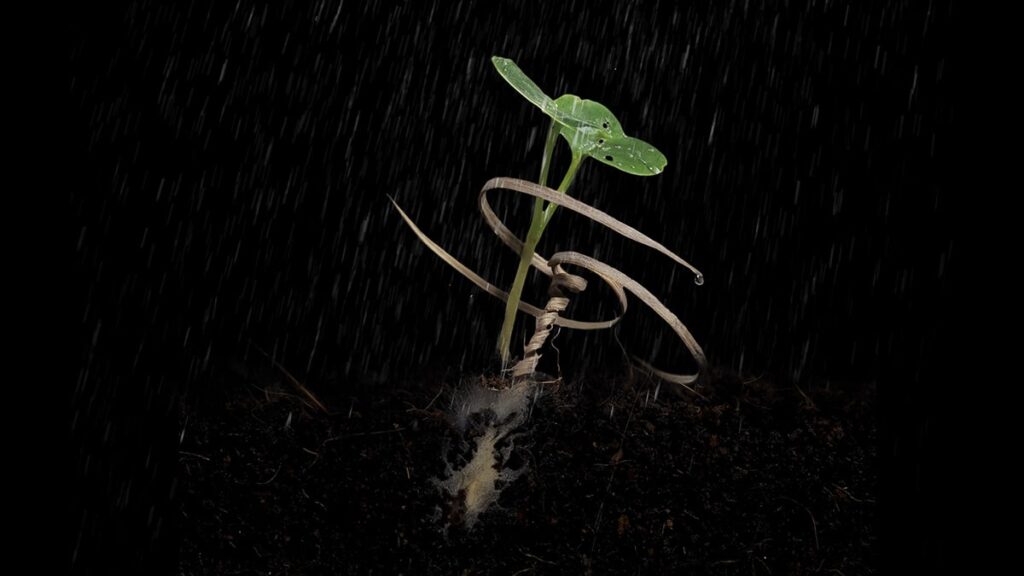
Before a seed can grow into a tree, flower or plant, it needs to successfully implant itself in soil – a delicate and complex process. Seeds need to be able to take root and then remain protected from hungry birds and harsh environmental conditions. For the Erodium flower to implant a seed, its stalk forms a tightly wound, seed-carrying body with a long, curved tail at the top. When it begins to unwind, the twisting tail engages with the ground, causing the seed carrier to push itself upright. Further unwinding creates torque to drill down into the ground, burying the seed.
Inspired by Erodium’s magic, Mechanical and Aerospace Engineering Professor Teng Zhang worked with Lining Yao from Carnegie Mellon University (CMU) and a team of collaborators to engineer a biodegradable seed carrier referred to as E-seed. Their seed carrier, fashioned from wood veneer, could enable aerial seeding of difficult-to-access areas, and could be used for a variety of seeds or fertilizers and adapted to many different environments. The carriers also could be used to implant sensors for environmental monitoring. They might also assist in energy harvesting by implanting devices that create current based on temperature fluctuations.

“This is a perfect example demonstrating the beauty and power of bioinspired design. We learn from nature and eventually achieve superior performance by leveraging the freedom of engineering design,” said Zhang, who also serves as an executive committee member of the Bioinspired Institute.
The team’s research appeared in the February issue of Nature.
The project is led by Lining Yao, director of the Morphing Matter Lab in the School of Computer Science’s Human-Computer Interaction Institute at CMU. Zhang developed models and performed simulations to explain the working mechanism of the wood actuators and the benefits of E-seed design. The key authors of the paper also include Danli Luo, a former research assistant at the Morphing Matter Lab, Shu Yang, a materials scientist from the University of Pennsylvania, Guanyun Wang, a former postdoctoral researcher in the Morphing Matter Lab and now a faculty member at Zhejiang University, and Aditi Maheshwari and Andreea Danielescu from Accenture Labs.
“Seed burial has been heavily studied for decades in terms of mechanics, physics and materials science, but until now, no one has created an engineering equivalent,” said Yao. “The seed carrier research has been particularly rewarding because of its potential social impact. We get excited about things that could have a beneficial effect on nature.”
“Gaining insight into the mechanics of wood and seed drilling dynamics leads to improved design and optimization,” said Zhang. “I am excited to see, by embracing cross-disciplinary collaborations, mechanics can play a critical role in making our society more sustainable.”
Read more about this collaborative project.
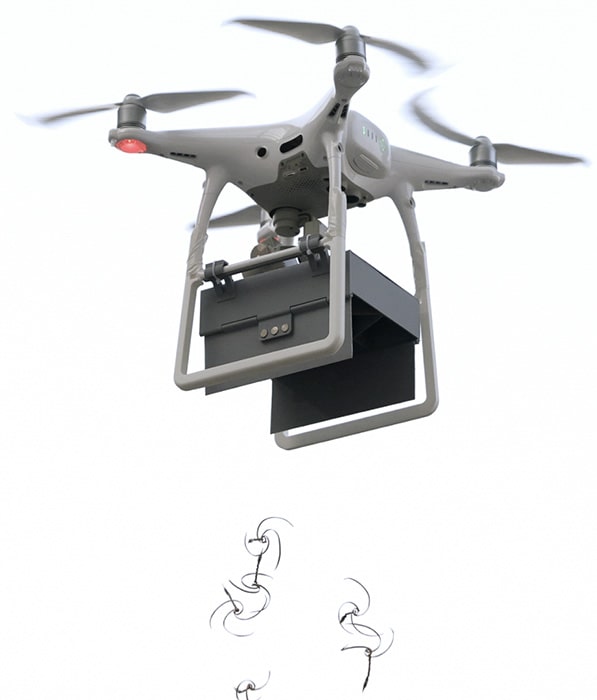
(Written by Byron Spice and Alex Dunbar)
Fall 2022 Engineering and Computer Science Dean’s List
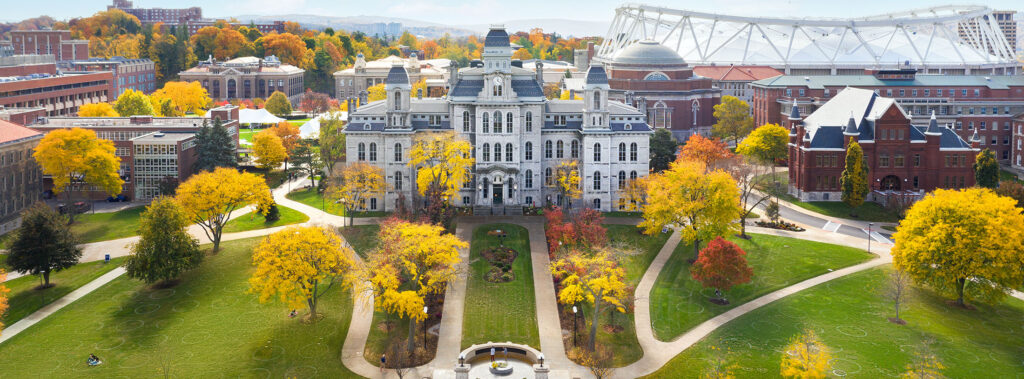
In recognition of superior scholarship, the following students have been entered on the Engineering & Computer Science Dean’s List for Fall 2022.
To be eligible for Dean’s List recognition, the minimum semester grade point average must be 3.40 or higher, must have earned a minimum of 12 graded credits and must have no missing or incomplete grades.
Aerospace Engineering
Dean Nasri Abdel-Aziz
Allyson Almeida
Brady Joseph Arruda
Jonah Oliver Blanchard
Richard L Bruschi
Mathew Carpio
Curtis James Cline
Bryan Collins
Thomas James Condon
Paolo Pio Coppola
Michael Alexander Donato
Justin Ryan Esposito
Mark Gannon Ezaki
Benjamin David Faasse
Christian Scott Fitzgerald
Darren Finn Forschino
Victoria Elizabeth Forsyth
Zachary Ryan Freyman
John M Gauthier
Benjamin Daniel Gerard
Alexandre J Gill
Zachary William Haas
David Leo Hadley
Benjamin Matthew Hassett
Ryan Benjamin Hirsch
Aidan Hoff
Jiaji Hu
Paula Cristina Ibelings
Nicholas John Jacobs
Joseph Manuel Javier
Sydney F Jud
Harrison Kayton
Myat Min Khant
Trevor Anthony Knight
Thalia Patience Lee
Isaac Alan Lehigh
Emma Lee Levenson
Dante Alexander Liotta
Maximillian Lipinski
Nathaniel Fox Lipset
Jacob Eric Long
Ava Katherine Lough
Powers Craig Lynch
Brendan Michael Marquis
Elsa Adrianna Martin
Jonathan Henry Martin
William Armstrong Martin
Jason W McElhinney
Parker Byrne McMillan
John P Michinko
Kendra Teresa Miller
Evan Gregory Moore
Zachary Thomas Munkacsy
Brendan Pierce Murty
Tatiyyanah Queen-Asia Hope Nelums
Madeline G Phelan
Logan D Prye
Kazi Golam Rafee
Jason Patrick Reid
Nicholas Christopher Richard
Andrew Douglas Rockafellow
William J Saueressig
Winston James Schaumloffel
Zachari Whitaker Sekyi-Williams
Garrett Clifton Sickmon
Gregory C Slodysko Jr
Kathryn Amber Smith
Zachary Michael Stahl
Jaime S Sued Jr
Yiyuan Sun
Marco Svolinsky
Rory Lloyd Taylor
Richard A Tedeschi
Carter Alexander Thompson
Theodore Todorov
Anthony Robert Tricarico
Sasha Valitutti
Sarah Grace Vallejo
Cody Joseph VanNostrand
Joshua John Varkey
Toby Thomas Webber
Mason Alexander Weber
Owen James Weisenberger
Ethan H Weiss
Kana Li Wong
Cameron M Woodbury
Melissa Yeung
Bioengineering
Anthony Drew Acierto
Jason Bae
Mathieu Kenji Barthelemy
Paige Bencivenga
Zeynep Sue Cakmak
Evan A Campbell
Jade Ashlee Carter
Ryan Sean Clarke
Dominic Thomas Clinch
Lukas Cook
Shane A Corridore
Samirah Lamoni Crawford
Beatriz De Melo Palma Fernandes
Michael James Dreyer
Catherine Jean Durkin
Sophie Faith Grady
Grace Haas
Lauren Elizabeth Hamilton
Brenna Henderson
Maxima Camryn Zahra Herbert
James T Hrdy
Madeline Jones
Gabriel Khan
Olivia Lynne Kmito
Jakub Aleksander Kochanowski
Emily Labour
Quinn Patrick Langdon
Sara Anne Leonardo
Isabelle S Lewis
Joshua Edwin Nana Limjuico
Alejandra Eugenia Lopez
Ethan L Masters
Aelish McGivney
Caitlin R Mehl
Sadie Shaula Meyer
Katherine Grace Monroe
Aizhan Moore
Hannah V Murphy
Jonathan Ngo
Kerrin Anne O’Grady
Luiza Awuor Owuor
Alyssa Pape
Mia Dian Paynton
Megan Perlman
Ayanna Riley Peterson
Michael Steven Presunka
Lillian Kilmer Rhuda
Ruben Rojas Betanzos
Isabella M Rosales
Amira Salihovic
Alyssa Shelburne
Bridget Yong Sides
Katherine Anne Southard
Justin N Stock
Elizabeth Tarami Su
Danny Vu
Carly J Ward
Nathaniel Wellington
Haven M Wittmann
Lauren Margaret Woodford
Rui Xie
Yougang Xue
Ahlam Zokari
Julian Marcus Smucker Zorn
Samantha Yvonne Zysk
Chemical Engineering
James William Bailey
Elizabeth R Carchia
Alex Michael Castagliuolo
Olivia R Conlin
Dennis Dao
Emily C Fittante
Edward Coleman Fluker
Mia Angela Goldberg
Hannah Grossman
Avery Gunderson
Christopher Max Hansen
Lucas Joseph Heffler
Aiden A Jacobs
Natalia Jarmain
Hope Irene Johnson
Sonia Julius
Emma Grace Klein
Adam J Klinger
Eden Tess Leavitt
Gabe Lipsitz
Annika Daphne Meyers
Cole Parker Nordby
Erin Marie Odonnell
Eli Irvin Paster
Isabella Noelani Perkins
Riley Madison Schmerber
Jacob Matthew Shellhamer
Jason Tan
Maria Jose Velez
Seojun Yu
Jackson Richard Yuen
Civil Engineering
Juan Pablo Arosemena Graziadei
Henry C Bievenue
Leila Christine Boughton
Masson Bruening
Zoya Bukhari
Alexander Burrows
Daniel Thomas Caraceni
Isabel Cardoso
Olivia Carmella Cross
Aymeric Pierre Alexis Robert Destree
Brendan Dwyer
Marlee Ann Ecton
Xuanjie Fan
Jacob C Hotchkin
Kristen Caroline Huddleston
Julia Ann Johnson-Milstein
Rhitwik Karmakar
Rachel Katz
Jakob Lamond Keller
Kate Astrid Kemnitz
Alexander Gregory Klee
Adam Paul Landry
Evangelia Birget Larson
Haben Legesse
Emma Marie Liptrap
Emilija Alise Lizins
Lucas James Meiers
Sumit Harshad Mistry
Trevor Robert Napoli
Abigail Micah Neitch
Justin Wayne Pettit
Maxwell Robert Pozar
Benjamin Joseph Putrino
Kaylin Janet Richards
Lesley S Rojas
Keisha Zefanya Rorimpandey
Anthony K Schnaufer
Aaron Presley Shinn
Samuel Paul Smith
Caitlin Jane Spillane
Alex Gabriel Torres
Jose Artuto Venegas
Zhou Wang
Christian E Ward
Sarah Wong
Paige H Yamane
Garrett J Zito
Computer Engineering
Adekunle J Akinshola
Chikeluba K Anierobi
Jackson Thomas Bradley
Ryan Joseph Brennan
Samanta S Correa
Wenhan Cui
Nathan James Czarnecki
Lyn El Sayed Kassem
Melvin Ruben Escobar Gonzalez
Elizabeth A Fatade
Gabriel Akinloluwa Babatunde Fatade
Ralph Lawrence Graham
Alexander Joseph Hai
Aidan Robert Harrington
Ashton Jeter Hernandez
Kasey Jackson
Cedrik Jethro Jean-Baptiste
Benjamin N Johnson
Jessica K Lat
Tyler Alexander Lavaway
Matthew B Leight
Jiaxiong Li
Joseph Anderson Lodato
Kyle Maiorana
Aksel James Malatak
Jacob Stephen Masrouri
Isabel M Melo
Pierce Austin Neubert
Jayden Ahamefula Okorougo
Jose L Olivera
Adedeji Nathaniel Oyefeso
Ellie Grace Parkes
Alexander C Perez
Jessica A Reslan
Anel Rizvic
Kevin Robertson
Brian Rodriguez
Samuel M Rosenthal
Mia Elizabeth Russo
Jared Anthony Santiago
Alexander Segarra
Thomas John Vitarelli
Declan Wavle
Manling Yu
Computer Science
Bamidele Benjamin Adeyemo
Aaron Alakkadan
Sajjad Abdullah Albadri
Joseph Algerio
Anas Abdallah Hussein Alkhashroom
Brianna Danielle Anthony
Ian Edward Asbury
Fiona Asungedib Azumah
Garret W Babick
Giovanna Elizabeth Barsalona
Niloy Basak
Sophia Anne Basile
Samantha E Bastien
Maxwell Robert Beam
Anas Ahmed Benhamida
Duncan Anthony Benitz
Luke S Bonenberger
Joshua Jordan Boucher
Brian Michael Bourne
Amanda Leigh Bowdren
Spencer H Bradkin
Nathan Thor Brekke
Bryan Bladimir Bueno Reyes
Kelly Jane Burke
Andy Daniel Cai
Jonathan David Callahan
Benjamin Elliott Canfield
Andrew Miles Champagne Jr
Lawrence Chen
Daniel Chmielewski
Nicholas Chopliani
Season Chowdhury
Noah John Cirks
Rahnaya T Clarke
Ta’Nasia Zhara Coleman
Miguel Angel Cruz Flores
Matthew John Cufari
Lucas John Czarnecki
Ryan Matthew Czirr
Akosua Danso
Philippe Alexandre Daubert
Nicholas Davis
Aidan Christopher DeGooyer
Julian Joseph Delucia
Christian Despecci
Lucille Jennifer Disalvo
Russell Carl Doucet
Annica Claudia Dubert
Theodor Dan Dumitru
Christopher Edmonds
Curtis Ryan Edwards Jr
Braimah Bolade Eleshin Jr.
Ryan Siebe Elsinga
Neha Eregodu Laxminarayana
Evan J Espina
Spencer Evans-Cole
Matthew J Faiola
Bennett Ferrari
Francisco Emiliano Franco Leon
Ruihong Gao
Kelly Jane Geiwitz
Aren Sevag Gharibian
Brianna S Gillfillian
Justin Gluska
Meagan Anessa Gonzalez
John Martin Gorman
Aicha Gory
Nolan Pasquale Groothuis
Avery T Gump
Jessica Gabriela Gutierrez
Alexander Peter-Anthony Haas
Talal Hakki
Ashley Marie Hamilton
Jillian Elizabeth Handrahan
Liam Gordon Hannah
Alisha Hassan
Karen Herrera
Richard Ho
Isaiah J Hollensworth-Wooten
Laurel Howell
Noah Thomas Howell
Jacob Howlett
Helou Huang
Xuanye Huang
Eda Imer
Chengyi Jiang
Tianyiming Jing
Frederick Jackson Jones
Alan Jos
Lauren Keona Kaaiakamanu
Brunon Donovan Kaminski
Xiaoya Kang
Matthew Keenan
Nicolas Walter Ketterer
Ekaterina Kladova
Joshua Jayvant Zachary Koshy
Matthew Peter Kovalcik
Polina Kozyreva
Vivien E Latt
Maya J’Nai Lee
Jack M Lefebvre
Andy Li
Modi Li
Yuxuan Li
Daniel Lim
Joshua Lim
Alicia Lin
Sandy Lin
Jing Liu
Joshua Zhou Liu
Yuyuan Liu
Cayden Thomas Lombard
Yiheng Lu
Sophia Luo
Runzhi Ma
Shizhan Ma
Gavin Thomas Macisaac
Mihir Ulhas Mahale
Juliette Eloise Mangon
Ryan M May
Anthony Louis Mazzacane
Philip Anthony Moceri
Thomas J Montfort
Jovanni Nicholas Mosca
Ryan Murphy
Krutartha Nagesh
Christopher Scott Nemeth Jr
Jillienne Judith Ness
Arianna Kassandra Nguyen
John Viet P Nguyen
Joshua Nielson
Olivia O’Hanlon
Cheryl Hadasa Olanga
Adya Aditi Parida
Brian Joseph Pellegrino
John Arthur Peters
Amlan Pradhan
Alexander Lawrence Reid
Boyu Ren
Eric Rodriguez
Andrew Frank Scerbo
Jonathan Lee Schwenk
Sean J Shin
Chad Thom Smith
Megan C Snow
Anthony Logan Solt
Townsend Garner Southard Pantano
Samuel Thomas Stowers
Kevin Sullivan
Nicholas P Sweet
Melissa Li Tang
Andrew Jeffrey Tedesco
Eduardo Torres-Garcia
Winston Tsui
Matthew Alistair Twigg
Zimuzo Somadi Udedibia
Robert Anthony Valliciergo
Kevin Anthony Verdeschi
Christopher Mark Vinciguerra
Guozheng Wang
Zijian Wang
Jacob Wansor
Robert Ward
Samantha Maureen Weir
Ryan Thomas Welch
Daniel Z Whelan
Lauren Rae Wilson
Sarah Grace Wlodkoski
Brian Matthew Wong
Hassan Wouliyou
Zongxiu Wu
Tianyi Xiang
Yujie Xu
Jishuo Yang
Naomi Lum Yokoo
Mingyan Zhang
Rixiang Zhang
Ruihao Zhang
Weiwei Zhang
Junjie Zheng
Mochen Zhou
Yiming Zhou
Yitao Zhou
Yi Zhu
Engineering Undeclared
Hunter Bertucci-Bissonnette
Gulliver Finn Brower
Fernando De Oliveira Poli
Brady Utah Denaburg
Nicholas James Harten
Kevin Paul Leger
Juwei Lin
Jacob E Manhardt
Kathleen Rose Meleski
William Matthias Morgan
Nicholas Edward Napalit
Alexander Romanofsky
Santiago Jose Sanabria
Rylee Marie Smith
Sebastian Enrique Velez
Iving Yang
Electrical Engineering
Alston Herve Abobi
Yohaan Matthew Abraham
Minghao Ai
Saul Batista Filpo
Tianle Bu
Kevin E Buciak
Wyatt Glenn Bush
Yushang Cai
Leshui Chen
Mingfu Chen
Ellison How-Sheen Chiang
Brian Sylwester Chudzik
Timothy Nehemias De Leon De La Rosa
Kevin James Donnelly
Henry C Duisberg
Anthony John Giovannini
Davis Hood
Xingtai Huang
Myles Hudson
Hayden Huy Le
Davis James Lipetzky
Jemma Mallia
Liam Fuller Marcato
Ryan Mussaw
Zixun Nian Nian
Gabriel Brian Noble
Jayson V Okhman
Julia Pepin
Savion Vernon Pollard
Gilberto E Ruiz
Gabriel E Ruoff
Harrison James Skilling
Jenna Mei Stapleton
Jared William Welch
Sierra Lauren Yang
Environmental Engineering
Jack Arnstein
Mark Bauerschmidt
Maren Behnke
Jasper Matthew Blake
David Michael Brodsky
Benjamin R Cavarra
Hollygrace Chamberlain
Ananya P Chandra
Emma Lauren Cloud
Emma Crandall
William Robert Croteau
Eleanor Elizabeth Gettens
Elisabeth Haggerty
Brady E Hartnett
Naomi Rebecca Imhoff
Muhammad Atekul Islam
Emma Charlotte Kaputa
Morgan Jean Kingdeski
Hunter Cordes Kline
Samuel Robert Livingston
Henry David Long
Molly M Matheson
Trygve Owen Moler
Connor Joseph Moulton
Matthew Edward Nosalek
Michael Joseph O’Connor
Liesel Marie Odden
Brinda Hetal Parikh
Ella Hope Phipps
Oliver D Raycroft
Audrey Elizabeth Recko
Marisol Allegra Russo
Mary H Schieman
Noah Michael Sherman
Evelyn Junting Tang
Gabriella Terry
Husna Myaza Tunje
Jacob M Tyler
Andrew Michael Vanderwege
Madeline Rose My Vo
Emily Jean Vogel
Sydney Elizabeth Youngs
Qiuyu Zhou
Reilly Zink
Mechanical Engineering
Arfeen Armaghan
Joshua Carl Arndt
Rachael O Beresford
Aidan Paul Bergman
Jeffrey Trent Bernstein
Chloe Marie Britton Naime
Renee Allison Brogley
Brinley Bruening
Alexander Joseph Callo
Joseph Timothy Capra
Massimo Casciaro
Robin Amelia Cesario
Jun Chen
Kaifeng Chen
Giancarlo D’Amore
Joanna Eilleen Delacruz
Colby John Doane
Troy Bradley Drummond
Luyen Duong
Gabriel Emilio Rangel Purnhagen
Andrew J Esposito
Griffin Thomas Estes
Thomas John Fabiano
Luke Samuel Fink
Elan Fullmer
Cameron Joseph Galloway
Xumeng Ge
Charles James Germosen
Samuel Ryan Getman
Derrick Edward Goll
James Brady Goodreau
Laura Pandora Graziosi
Daniel Robert Greene
Alec Michael Grogan
Jack T Hassett
Meagan Emily Hernandez
Melissa Jane Hiller
Elliott J Holdosh
Yue Hu
Jeffrey Huang
Jiayuan Huang
Gavin Johnson
Dong Myeong Kang
Macauley J Kastner
Teagan L Kilian
Cherry Kim
Justin Kohan
Savannah Mae Kreppein
Jasmine Anne Lin
Honorata Lubecka
Bei Luo
Matthew Macfarlane
Ryan Patrek Martineau
Jennifer Alana Mason
Ian Walter McCollom
Michael J McElroy
Kalhaku D McLester
Ryan A Melick
James Patrick Melitski
Andrew Charles Moreno
Wiley Robert Moslow
Beau M Norris
Michael John Palmer
Nathaniel Ryan Paradis
Patrick Limsuksrikul Phanichyakarn
Emma Tiffany Platten
Regina Ann Reisig
Kaelyn R Rooney
Jeremy Vinton Rosh
Teagan Isabella Marie Rowland
Michael Patrick Rzasa
Sidarth Umrith Sarathy
Madeline Celia Scott
Zachary Ryan Shuler
Eric Silfies
Dionysios Skaltsas
Nathaniel Paul Slabaugh
Daniel Michael Stich
Ian Storrs
Kittapas Tulananda
Evan R Tulsky
Alexandra Rose Vaida
Griffin Riley Vollers
Nicholas Eric Waller
Xu Wang
Michael David Wehrle
Taj Asim Whitney
Thomas Chandler Williams
Michael Wong
Zhihan Zhou
Rolling Right Off
New research from Syracuse University shows how nanochannels, oil and candle soot could provide a water repelling surface with numerous applications.
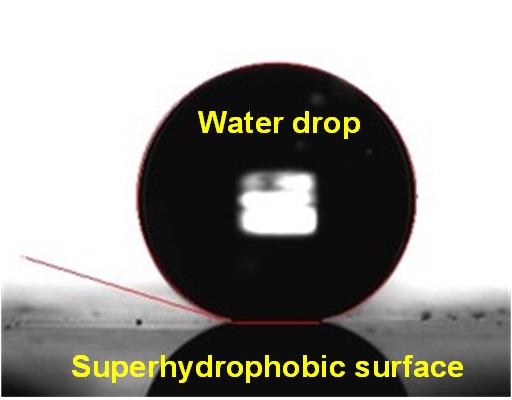
Surfaces that allow water or other liquids to roll right off are uniquely present in nature, such as on lotus leaves as well as on few aquatic insects, enabling them to walk on water or breathe under water by trapping a layer of air on their bodies. Such superhydrophobic surfaces can be helpful in a variety of engineering applications, ranging from coating of windshields and surgical tools, to steam turbines and condensers in power plants, and to improved hydrodynamics of submarines and ships.
Despite advancements in the development of artificially engineered superhydrophobic surfaces, durability and regenerative aspects of such surfaces remain elusive. Harsh working conditions including extreme exposure to water or humidity can deteriorate such surfaces especially after extended under-water usage.
Mechanical and aerospace engineering doctoral student Durgesh Ranjan and Professor Shalabh C. Maroo have developed a new approach for creating a durable superhydrophobic surface by first plasma-treating a fabricated porous nanochannel geometry on a silicon substrate followed by infusion-depletion of silicon oil and coating a layer of carbon derived from candle soot.
“We are able to engineer a superhydrophobic surface which is durable against high-speed water jets, non-sticky to many liquids ranging from water to honey, and stable under water for months,” says Maroo.
Research from Ranjan, Maroo and An Zou was published in the January 2023 issue of the high impact Chemical Engineering Journal and the technology is also patent pending. Their surface is capable of maintaining water contact angles of over 160° and roll off angle less than 5° even after undergoing 20 different tests, including chemical resistance to seawater and various solvents, high temperature exposure up to 570oF, condensation heat transfer, self-cleaning using fine all-purpose flour, frosting-defrosting cycles with ice, concentrated solar radiation exposure, and compatibility with organic products like honey, milk and syrup, thus exhibiting potential real-world applications.
First Year Aerospace Engineering Students Test Rover Designs
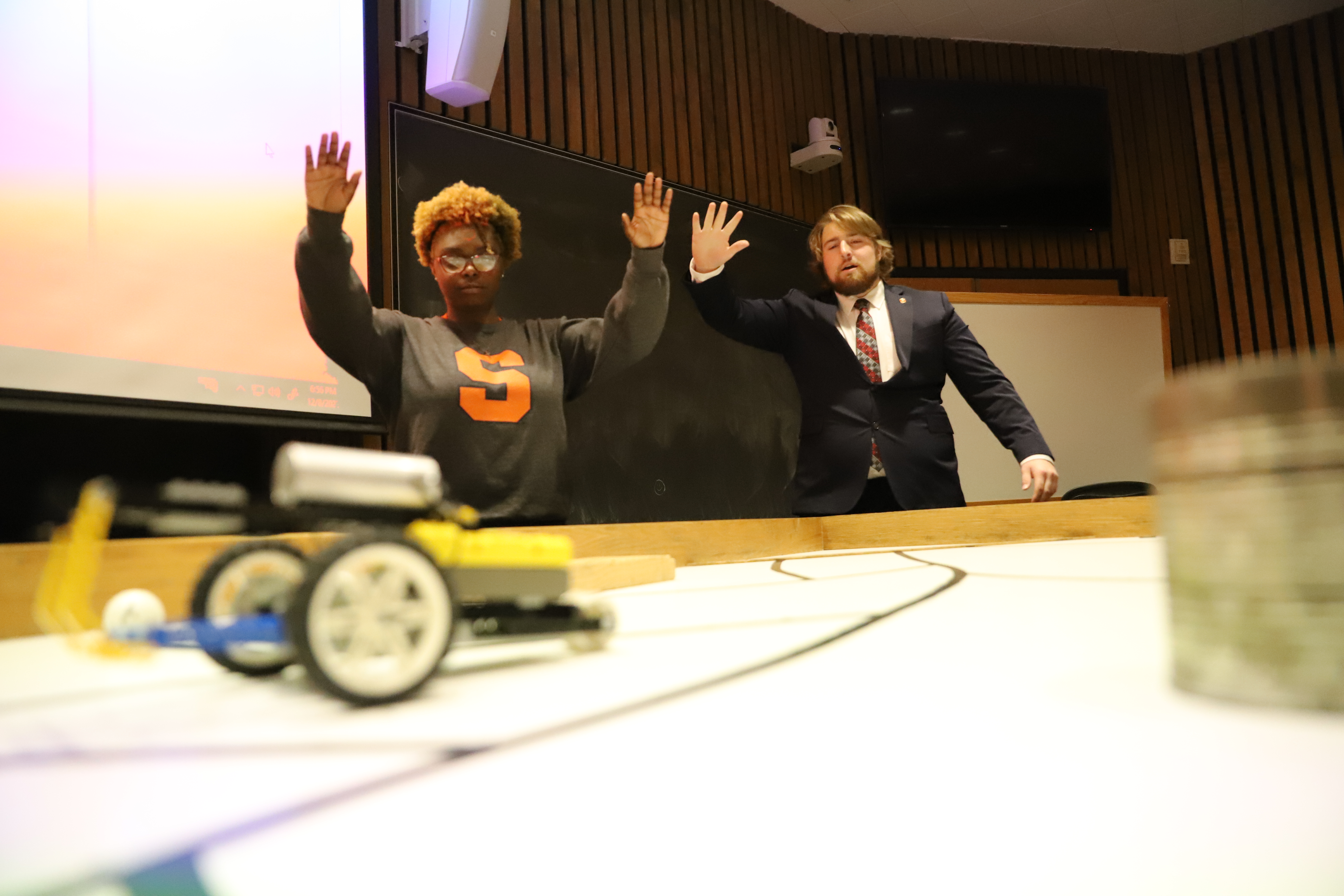
First year aerospace engineering students in Professor John Dannenhoffer’s ECS 101 class tested their Mars rover designs at the end of the fall semester. Teams of students designed small rovers designed to remotely retrieve “Mars rocks” (golf balls) and deploy a scientific instrument on a surface replicating the red planet.
With classmates cheering them on, teams deployed their rovers to see if their design and programming would allow them to retrieve samples and bring them back to the landing area. Points are assigned for how many “Mars rocks” a team’s rover interacts with, how many rocks they bring back to the deployment zone and if the rover is able to deploy a scientific instrument.

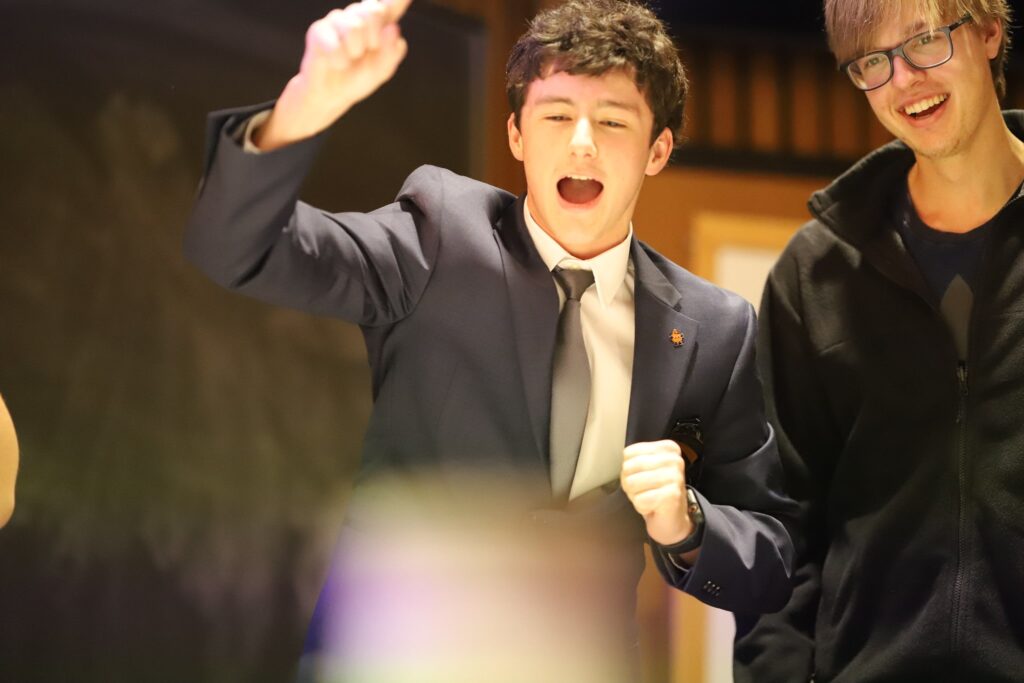

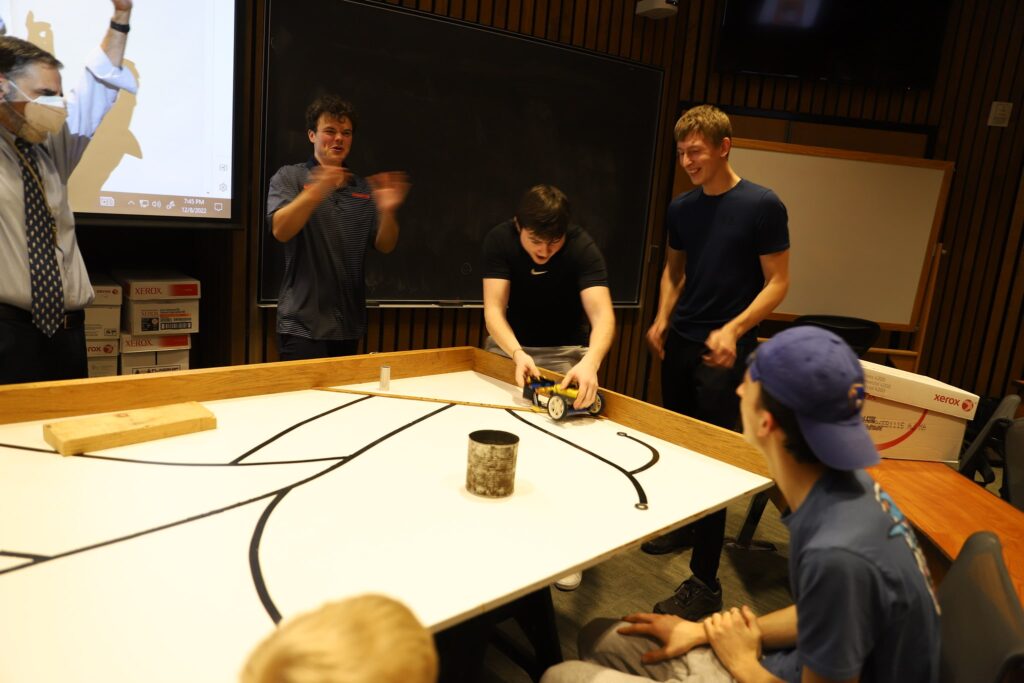

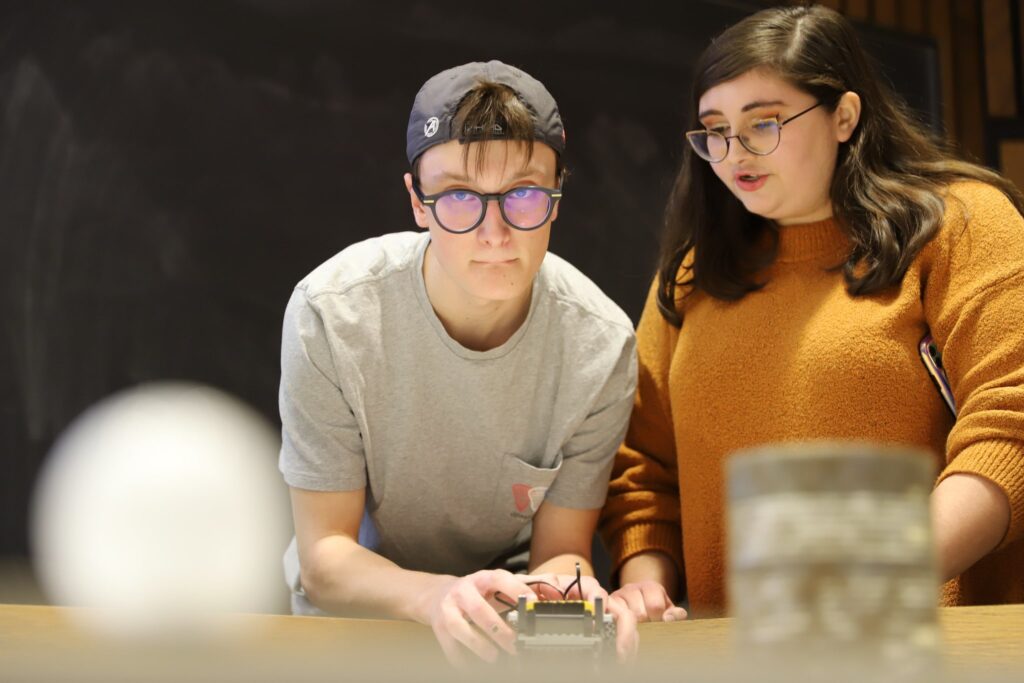


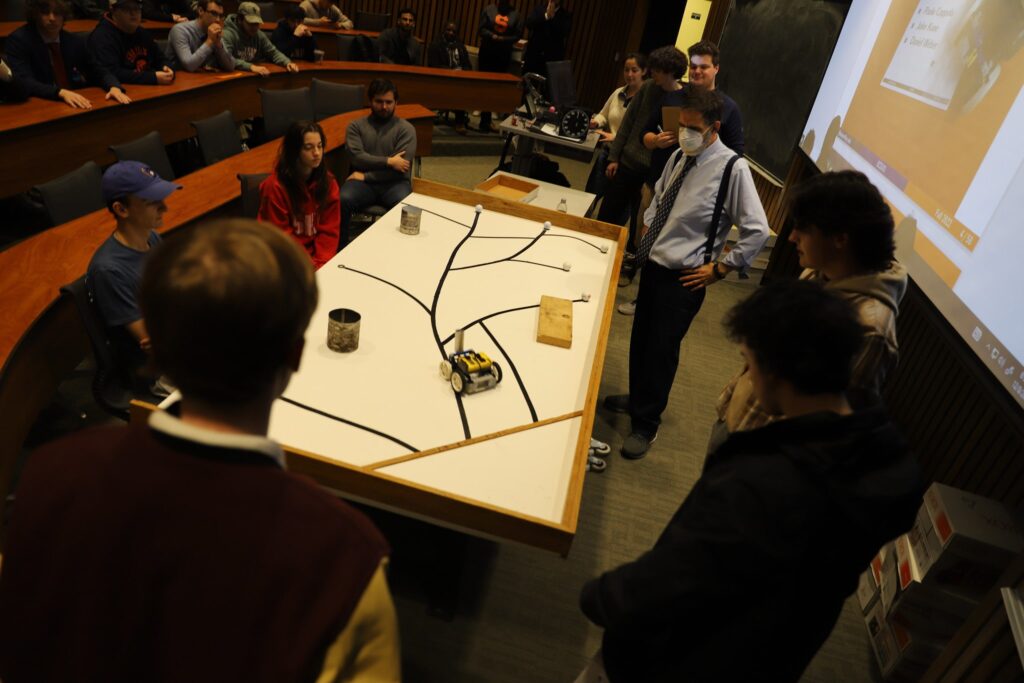
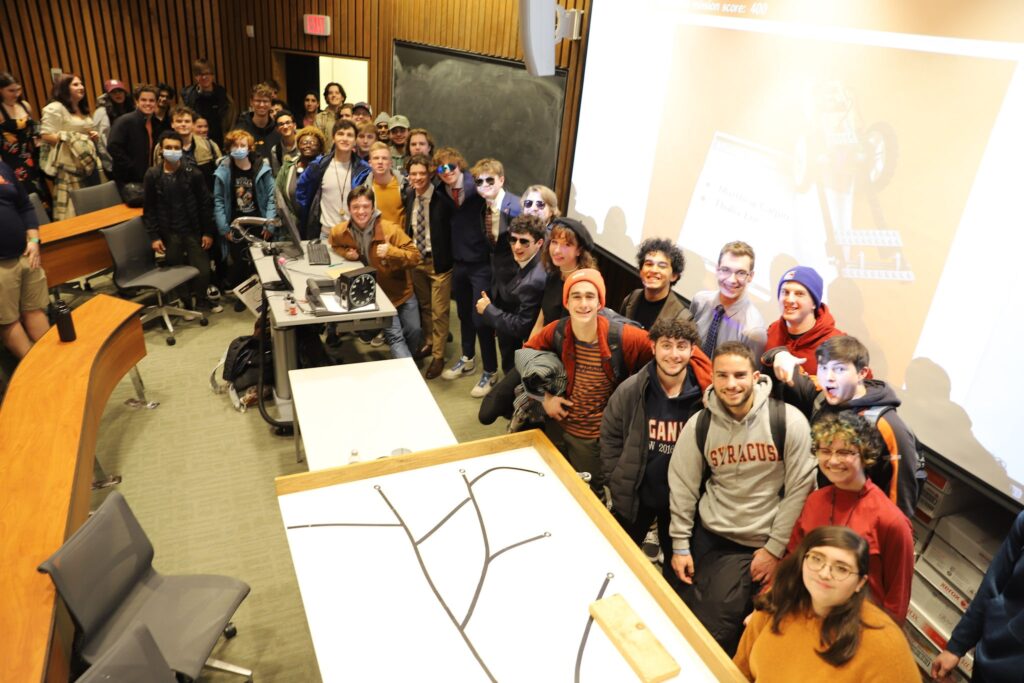
Smart Gripping
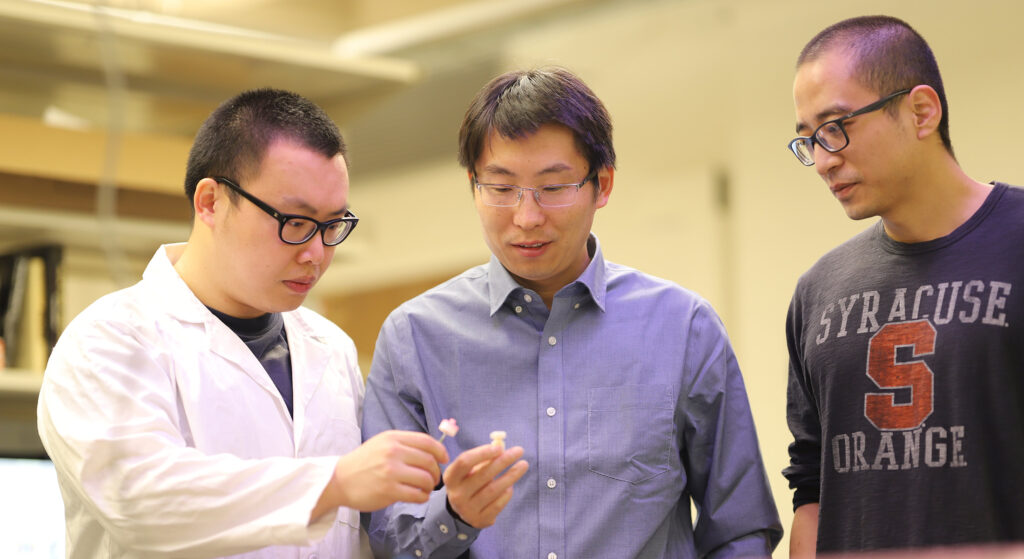
Assembling electronic devices requires precision and the ability to place key components in tight spaces. Manufacturing systems need the ability to grip a component and then release it in the right spot. To make it even more challenging – the grippers need to be tiny and able to grip and release items that are measured in microns.
Mechanical and aerospace engineering Professor Wanliang Shan started considering the problem in 2016 while he was at the University of Nevada – Reno and was awarded a National Science Foundation (NSF) Materials, Engineering and Processing grant to explore the concept.
“I wanted to see if we could use smart materials to design and fabricate a soft gripper of composite structure with tunable adhesion. By running current through the smart material component, we could change it from rigid to soft and release objects due to reduced adhesion of the gripper,” said Shan.
The proof of concept Shan’s research team designed was successful in realizing a ~10 times dry adhesion change within a matter of seconds. Their work was published in the Advanced Materials Interfaces journal in 2018 and Shan was granted a patent in the spring of 2022.
“One of the advantages of this technology is that it could save energy compared to traditional suction cups,” said Shan. “When you pick things up the gripper is in the high adhesion state, only when you release do you use current to activate it.”
Shan has completed an NSF Innovation Corps project to conduct interviews with over 100 potential customers for the compliant manipulation technology and concluded that there is tangible industry demand for it. He has most recently received an NSF Partnership for Innovation (PFI) grant to see whether it is reasonable to set up a company and commercialize it.
“This is a new approach for how to manipulate objects,” said Shan. “Through the PFI project we will see if potential customers like our prototype. If it is successful, what will it focus on?”
As part of the NSF PFI grant, Shan and his research team are partnering with Cobham Advanced Electronic Solutions for market testing and customization options.
“I’m very thankful for the support from the NSF,” said Shan. “They fund essential research, customer discovery, prototype development and partnership building.”
Shan and his team are also developing a second approach to a soft gripper that uses pneumatics to tune adhesion. That research has received funding from the NSF National Robotics Initiative. Their most recent progress along this direction was published in the high-impact journal, Advanced Functional Materials. The research shows soft grippers with over 100 times dry adhesion change within one second when triggered by low pressure (~10 kPa) and thus low power consumption has been reported. Shan and his post-doctoral researcher Dr. Guangchao Wan filed for another patent on this approach in September 2022.
“We don’t use suction which is typically ~50 kPa, we use low pressure to affect adhesion to the object being gripped.”
Shan’s lab is pursuing both gripper approaches and he sees potential and challenges for both to succeed in different applications.
“They are different methods with different activation modes but parallel approaches,” said Shan. “Depending on the environment, we could see which one is better. Both approaches have a lot of potential to solve tangible challenges in industry. Smart materials that satisfy the needs of this technology are yet to be engineered; pneumatics is readily available in industry but it might present a more challenging task for minimization than the smart materials approach. Currently we are focusing on improving the performance of both approaches through the PFI project and other parallel efforts.”
Mechanical and Aerospace Engineering Research Team Publishes Research on Efficient Conversion of Solar Energy

Mechanical and Aerospace Engineering Professor Quinn Qiao and a research team from the College of Engineering and Computer Science recently published two papers in Advanced Materials in collaboration with Peking University and other universities in Europe. Both papers focus on the organic solar cell (OSC), which is a photovoltaic device that converts solar energy to electrical energy.
The first paper is titled Quasi-Homojunction Organic Nonfullerene Photovoltaics Featuring Fundamentals Distinct from Bulk Heterojunction and discusses the unconventional organic solar cells structure with more intrinsic charge generation and less charge recombination. The second paper is tilted Simultaneously Enhancing Exciton/Charge Transport in Organic Solar Cells by an Organoboron Additive and provides a facile strategy of morphology optimization to improve the performance of OSCs. In both cases, the solar cell’s power conversion efficiencies (PCE) increase which means they can convert solar energy to electrical energy more efficiently. And Qiao’s group confirmed the mechanism of better performance for the solar cell from experiments.
The research was conducted at Qiao’s solar cell lab in the Link Hall. An atomic force microscopy (AFM) was mainly used in the research to measure the current sensing AFM (C-AFM) data and an oscilloscope was used to obtain charge carrier dynamics data. The group has applied a patent for the measurement and has published many papers based on the technique recent years. In the future, the group will publish more influential papers in the field.
Interdisciplinary team of Engineering and Computer Science Students Wins 2022 Invent@SU Competition
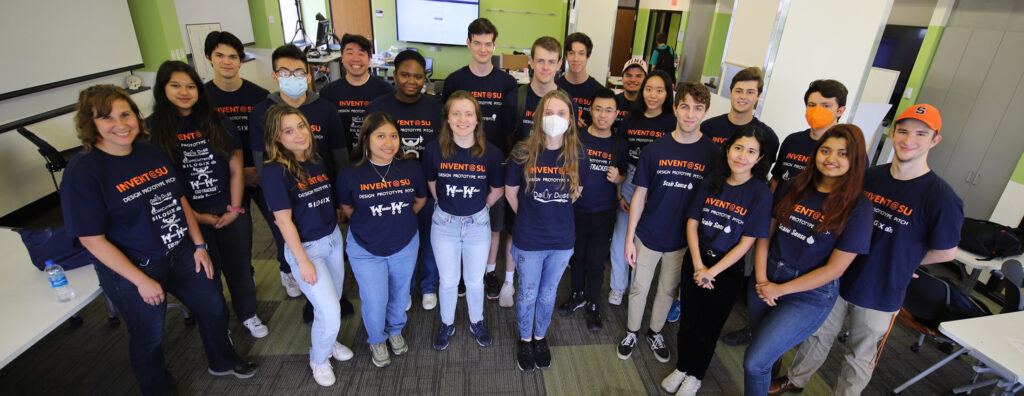
When searching a burning building for people who may be trapped inside, smoke and debris can cause firefighters to work in zero visibility conditions. They are attached to ropes but it is easy for them to become disoriented. This makes it difficult to navigate their way back to safety.
Environmental engineering student Oliver Raycroft ’25 heard about the problem from a firefighter during his first year at the College of Engineering and Computer Science and started thinking about ideas.
“I thought the problem was interesting and there was a clear need,” said Raycroft. “I wanted to help and find a solution.”
At the beginning of the six week Invent@SU program, Raycroft presented the problem to his teammates biomedical engineering student Alejandra Lopez ’22 and computer science student Adya Parida ’25. Both were interested in seeing if they could use their science and engineering skills to design a practical solution that would help firefighters orient themselves during rescue operations.
“If we could solve this problem, we could save the lives of firefighters and billions in damages,” said Parida.
During Invent@SU, student teams design, prototype and pitch new inventions with help from engineering and communications faculty. Each student receives a $2200 stipend and teams have a $1000 budget for prototyping materials. Teams spend six weeks developing their ideas during summer session one and each week a panel of Syracuse University alumni and friends evaluate the progress of their five-minute pitches.
“It was a combination of experimentation and feedback. This program taught me skills I can apply anywhere,” said Parida.
“I got better and better at presenting and communicating what we were working on,” said Lopez.
“The fact firefighters liked it so much made it worth it,” said Parida.
On the final Thursday of the program, all seven teams in Invent@SU pitched their inventions to a panel of alumni judges. Raycroft, Lopez and Parida’s team named “Scale Sense” took first place and a $1500 prize.
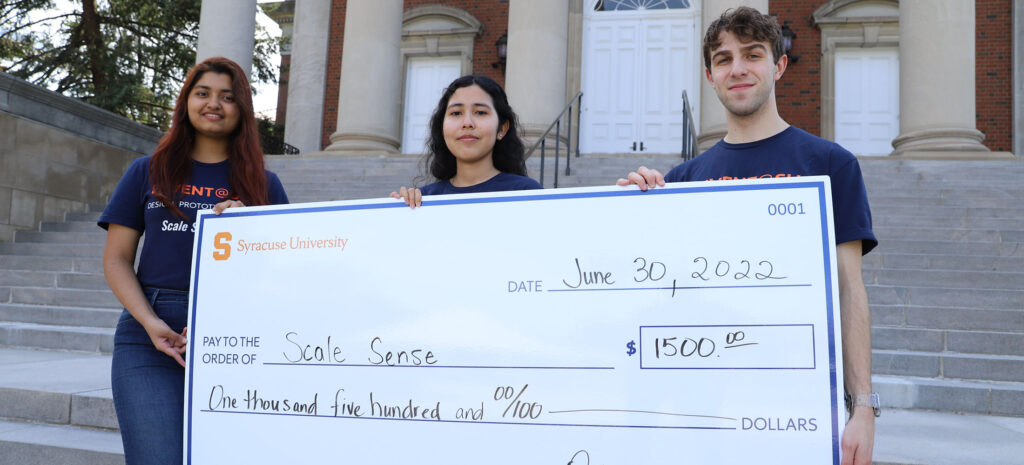
Second place went to team “Wonder Walker” who designed a mobility assistance device for children with special needs.
Third place went to team “Silogix” – who designed a device to provide farmers with a way to prevent dangerous grain blockages in silos.
“It was a ride, it was fun, challenging and rewarding,” said Parida.
Several Invent@SU teams plan to work with the Blackstone Launchpad in Bird Library to explore business plans and patents.
Invent@SU was made possible by program sponsors Syracuse University Trustee Bill Allyn G’59 and Janet “Penny” Jones Allyn ’60 and Michael Lazar G’65. The 2022 team sponsors were Matthew Lyons ’86, Haden Land G’91 and Cathy Jo Land and Ralph Folz ’90. For more information on the program, visit invent.syr.edu.
Spring 2022 Engineering and Computer Science Dean’s List

In recognition of superior scholarship, the following students have been entered on the Engineering & Computer Science Dean’s List for Spring 2022.
To be eligible for Dean’s List recognition, the minimum semester grade point average must be 3.40 or higher, must have earned a minimum of 12 graded credits and must have no missing or incomplete grades.
Aerospace Engineering
Allyson Almeida
Brady Arruda
Curtis Cline
Bryan Collins
Nicholas Crane
Brian Cronin
Christopher Doherty
Michael Donato
Sean Edelman
Nadia Elsaeidy
Benjamin Faasse
Christian Fitzgerald
Victoria Forsyth
Benjamin Gerard
Alexandre Gill
Jacob Gomez
Zachary Haas
David Hadley
Alyssa Henley
Aidan Hoff
Paula Ibelings
Nicholas Jacobs
Joseph Javier
Sydney Jud
Benjamin Kane
Harrison Kayton
Trevor Knight
Isaac Lehigh
Stephen Leung
Emma Levenson
Maximillian Lipinski
Jacob Long
Powers Lynch
Brendan Marquis
Noah Martel
Elsa Martin
Jonathan Martin
Maxwell Martin
William Martin
Jason McElhinney
Mariana McManus
Parker McMillan
Alexander Metcalf
Romeo Michelson
John Michinko
Kendra Miller
Evan Moore
Matthew Murino
Mark Namatsaliuk
Tatiyyanah Nelums
Randall Osborn
David Pham
Madeline Phelan
Logan Prye
Matthew Qualters
Mykhaylo Rafalskyy
Samantha Riedel
Brandon Riley
Tracey Rochette
Alyssa Rote
Daniela Ruano-Pinos
Gregory Ruef
Michael Saksa
William Saueressig
Fred Schaffer
Winston Schaumloffel
Justine John Serdoncillo
Kanya Shah
Vraj Shah
Prabha Singh
Gregory Slodysko Jr
Zachary Stahl
Christopher Stawarski
Ethan Stocum
Yiyuan Sun
Marco Svolinsky
Tiffany Tang
Anthony Tricarico
Cody VanNostrand
Diego Villegas
Mason Weber
Timothy Wiley
Kana Wong
Cameron Woodbury
Melissa Yeung
Bioengineering
Anthony Acierto
Ashraf Alnatour
Bianca Andrada
Jason Bae
Eric Benaroch
Colby Black
Anna Brunson
Zeynep Cakmak
Britnie Carpentier
Lukas Cook
Tessa Decicco
Mia-Marie Fields
Tessa Galipeau
Jennifer Gonzalez
Skyla Gordon
Jenna Grutzmacher
Grace Haas
Lauren Hamilton
Victoria Hathaway
Brenna Henderson
Madeline Jones
Gabriel Khan
Jakub Kochanowski
Emily Labour
Quinn Langdon
Sara Leonardo
Isabelle Lewis
Alejandra Lopez
Ethan Masters
Aidan McCarthy
Aelish McGivney
Ian McHugh
Caitlin Mehl
Lindy Melegari
Katherine Monroe
Hannah Murphy
Alexander Musselman
Jonathan Ngo
Mark Nicola
Nicole Nielsen
Kerrin O’Grady
Mia Paynton
Megan Perlman
Connor Preston
Michael Presunka
Mark Ransbottom
Lillian Rhuda
Isabella Rosales
Brandon Salazar
Amira Salihovic
Juliana Sepulveda
Bridget Sides
Katherine Southard
Justin Stock
Elizabeth Su
Kimberly Tlayaca
Zhuoqi Tong
Danny Vu
Nathaniel Wellington
Maximillian Wilderman
Haven Wittmann
Lauren Woodford
Rui Xie
Julian Zorn
Samantha Zysk
Chemical Engineering
Daud Abdullayev
Paige Adebo
Lilly Basgall
Sandy Cao
Karley Chambers
Dennis Dao
Gabriela Duarte Saadia
Samantha Esparza
Emily Fittante
Edward Fluker
Mia Goldberg
Brent Gosselin
Avery Gunderson
Christopher Hansen
Oduduabasi Isaiah
Aiden Jacobs
Natalia Jarmain
Hope Johnson
Sonia Julius
Sayf Karim
Laxmi Khatiwada
Adam Klinger
Simran Dharmendra Lakhani
Caroline Leduc
Steven M Axelsen
Haonan Ma
Rawia F A M Marafi
Annika Meyers
Erin Odonnell
Sean O’Toole
Eli Paster
Fabiana Perez
Isabella Perkins
Nora Prosak
Riley Schmerber
Jacob Shellhamer
Jason Tan
Elizabeth Wall
Murphy Waters
Jackson Yuen
Civil Engineering
Shalom Acheampong
Juan Pablo Arosemena Graziadei
Maxwell Bell
Lucas Bellandi
Henry Bievenue
Ryan Bourdeau
Shalamar Brown
Alycia Bruce
Masson Bruening
Brett Carney
Vanessa Chica
Alejandro Correa
Aymeric Destree
Brendan Dwyer
Jack Dwyer
Marlee Ecton
Maraea Garcia
Matthew Hauser
Julia Johnson-Milstein
Joshua Kaufman
Kate Kemnitz
Alexander Klee
Adam Landry
Evangelia Larson
Abigail Laschalt
Haben Legesse
Emma Liptrap
Emilija Lizins
John Mazza
Jessica McGowan
Lucas Meiers
Sumit Mistry
Salma Mohamed
Amira Mouline
Trevor Napoli
Marissa Nicole
Jenifer Pena
Joseph Penta
Brian Perez
Justin Pettit
John Pham
Maxwell Pozar
Gabriel Prepetit
Anthony Privitera
Benjamin Putrino
Kaylin Richards
Cassie Saracino
Ethan Schulz
Aaron Shinn
Caitlin Spillane
Erin Splaine
Jose Venegas
Christian Viola
Christian Ward
Angelina Wong
Isabelle Wong
Paige Yamane
Charles Zeitoune
Garrett Zito
Computer Engineering
Adekunle Akinshola
Chikeluba Anierobi
Graciela Avila
Jackson Bradley
Collin Chamberlain
Dynasty Chance
Ibrahima Diallo
Lyn El Sayed Kassem
Melvin Escobar Gonzalez
Xavier Evans
Elizabeth Fatade
Delaney Glassford
Aidan Harrington
Ethan Hensley
Kasey Jackson
Mehak Jetly
Virkin Jimenez
Fundi Juriasi
Bikash Khatiwoda
Jessica Lat
Tyler Lavaway
Matthew Leight
Jiaxiong Li
Kyle Maiorana
Aksel Malatak
Jacob Masrouri
Jas Moreno
Benjamin Murray
Pierce Neubert
Jose Olivera
Jessica Reslan
Anel Rizvic
Samuel Rosenthal
Hongyi Ruan
Mia Russo
Hanna Salem
Alexander Segarra
Ryan Wolff
Renjie Xu
Andy Zheng
Computer Science
Aaron Alakkadan
Sajjad Albadri
Huda Ali
Christian Alves-Patterson
Garret Babick
Julia Barucky
Samantha Bastien
Anas Benhamida
Luke Bonenberger
Joshua Boucher
Brian Bourne
Ella Brink
Brandon Brushwyler
Bryan Bueno Reyes
Bryce Cable
Liam Calnan
Omar Camara
Megan Campbell
Benjamin Canfield
Jackie Chen
Lawrence Chen
Siyu Chen
Yixing Chen
Daniel Chmielewski
Season Chowdhury
Konstantinos Chrysoulas
Bram Corregan
Miguel Cruz Flores
Matthew Cufari
Ryan Czirr
Salvatore DeDona
Aidan DeGooyer
Alpha Diallo
Lucille Disalvo
Christopher Edmonds
Georges Elizee
Yassin Elsharafi
Ryan Elsinga
Matthew Faiola
Xueyan Feng
Bennett Ferrari
Lucas Fox
Mason Freer
Ruihong Gao
Brianna Gillfillian
Justin Gluska
John Gorman
Alexander Haas
Athanasios Hadjidimoulas
Talal Hakki
Ashley Hamilton
Jillian Handrahan
Liam Hannah
Nicholas Hoffis
Laurel Howell
Jacob Howlett
Xuanye Huang
Chengyi Jiang
Tianyiming Jing
Frederick Jones
Michael Jones
Alan Jos
Xiaoya Kang
Aarya Kaphley
Henry Katchuba
Matthew Keenan
Ekaterina Kladova
Polina Kozyreva
Gaeun Lee
Janet Lee
Justin Lee
Andy Li
Jiashu Li
Rick Li
Yuxuan Li
Daniel Lim
Haochen Lin
Sandy Lin
Zekai Lin
Huangjin Liu
Jiaming Liu
Joshua Liu
Yiheng Lu
Runzhi Ma
Gavin Macisaac
Andrew Markarian
Konnor Mascara
Kanoa Matton
Ryan May
Anthony Mazzacane
Matthew McDaniels
Noah Mechnig-Giordano
Jose Mendoza
Philip Moceri
Thomas Montfort
Jacob Morrison
Jovanni Mosca
Ryan Murphy
Zoe Neale
Christopher Nemeth Jr
Jillienne Ness
Arianna Nguyen
Cheryl Olanga
Carlyn O’Leary
Marissa Orsley
Daniel Pae
William Palin
Xiaofeng Pan
Michael Panighetti
Adya Aditi Parida
Brian Pellegrino
Carlo Pisacane
Daniel Pomerantz
Fiona Powers Beggs
Cheng Qiu
Shane Race
Christopher Rhodes
Eric Rodriguez
Sadikshya Sanjel
Jack Schmidt
William Seeley
Huahao Shang
Nolan Shepherd
Chad Smith
Jeremy Stabile
Kevin Sullivan
Cheng Yu Sung
Nicholas Sweet
Rae Tasker
Dylan Teare
Emmanuel Teferra
Jonathan Thomas
Eduardo Torres-Garcia
Brendan Treloar
Winston Tsui
Randy Vargas
Kevin Verdeschi
Kritika Verma
Bermalyn Maricel Vicente
Christopher Vinciguerra
Ruobing Wang
Xinyi Wang
Zijian Wang
Robert Ward
Jack Willis
Nolan Willis
Brian Wong
Ethan Wong
Tianyi Xiang
Zhuoyi Xiong
Yujie Xu
Jishuo Yang
Yongcan Yang
Stella Yaunches
Elin Yaworski
Yulun Zeng
Liaotianbao Zhang
Mingyan Zhang
Ruihao Zhang
Weiwei Zhang
Junjie Zheng
Liuyu Zhou
Xinqian Zhou
Yitao Zhou
Joseph Zoll
Engineering Undeclared
Luke Lybarger
Kathleen Meleski
James Peden
Emily Schiessl
Electrical Engineering
Minghao Ai
Mohammed Aljohani
Tianle Bu
Kevin Buciak
Wyatt Bush
Yushang Cai
Arianna Cameron
Leshui Chen
Nicholas Connolly
Kevin Donnelly
Henry Duisberg
Randy Galicia
Jose Ginorio
Jemma Mallia
Tyler Marston
Ryan Mussaw
Zixun Nian Nian
Jayson Okhman
Dylan Palmer
Julia Pepin
Matthew Piciocchi
Savion Pollard
Gilberto Ruiz
Gabriel Ruoff
Luis Santin
Jenna Stapleton
Jared Welch
Environmental Engineering
Elexis Jean Bishop
David Brodsky
Benjamin Cavarra
Ananya Chandra
Bessie Chen
Emma Crandall
Eric Fitzgerald
Eleanor Gettens
Allyson Greenberg
Brady Hartnett
Christopher Harvey
Joshua Higgins
Nicholas Kohl
Audrey Liebhaber
Samuel Livingston
Henry Long
Molly Matheson
Matthew Nosalek
Andrew O’Gorman
Ella Phipps
Scott Potter
Joshua Prygon
Oliver Raycroft
Mary Schieman
Noah Sherman
Husna Tunje
Jacob Tyler
Andrew Vanderwege
Maria Antonia Villegas Botero
Emily Vogel
Anna Wojcik
Qiuyu Zhou
Reilly Zink
Mechanical Engineering
Owyn Adams
Richard Andrews
Joshua Arndt
Timothy Arnold
Charles Ball
Erin Beaudoin
Aidan Bergman
Jeffrey Bernstein
Chloe Britton Naime
Brinley Bruening
Arnaud Buard
Alexander Callo
Joseph Capra
Graham Chapman
Talina Chipantiza
Artur Chuvik
Caroline D’Addio
Peter Daniels
Ryan Dileo
Madeline Doyle
Luyen Duong
Griffin Estes
Thomas Fabiano
Charles Germosen
Samuel Getman
Kara Gorman
Laura Graziosi
Jiayuan Huang
Vian Vishal Jain
Jagger Kachmaryk
Finnian Kery
Teagan Kilian
Justin Kohan
Deanna Koppenjan
Trevor Kroells
Harrison Liberto
Cameron Lotfi
Honorata Lubecka
Bei Luo
Lauren Mack
Kalhaku McLester
James Melitski
Leilah Miller
Pablo Morales
Nicholas Papaleo
Nathaniel Paradis
Corey Phung
Nicholas Piano
Scott Reyes
Aidan Riederich
Jasmine Rodriguez
Jeremy Rosh
Nitish Satpute
Justin Sauve
Eric Silfies
Dionysios Skaltsas
Nathaniel Slabaugh
Samuel Slaiby
Ian Storrs
Matthew Swanson
Ethan Tracey
Evan Tulsky
Alexandra Vaida
Nicholas Valentin
Griffin Vollers
Michael Wehrle
Taj Whitney
Michael Wong
Systems & Information Science
Connor Gurnham
Stacy Kim
Kirthiga Reddy G’95 Announced as 2022 College of Engineering and Computer Science Convocation Keynote Speaker
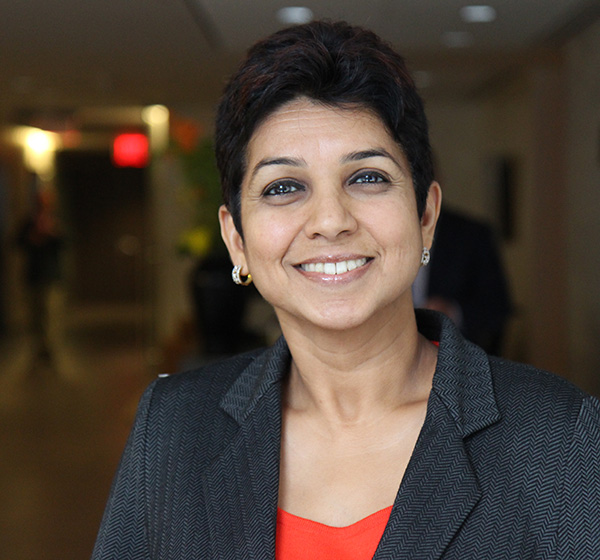
Kirthiga Reddy G’95 has many firsts to her credit. She was the first female investing partner at SoftBank Vision Fund, the first employee for Facebook in India & their Managing Director for Facebook India & South Asia. She is currently the president of Athena Technology II SPAC and a founding investment partner for f7 Ventures. She is on the Board of WeWork and Pear Therapeutics. Reddy received a master’s degree in Computer Engineering in 1995 and the College of Engineering and Computer Science is proud to announce she will be the keynote speaker at the College’s 2022 Convocation on May 14th.
Reddy brings over twenty years of experience leading technology-driven transformations. She is driven by the mantra “When businesses succeed, livelihoods flourish.”
Athena Technology II is an all-women-led SPAC (Special Purpose Acquisition Company) which brings talent and transaction experience to enable access to equity capital markets. The f7 Seed Fund’s mission is “Bold Women Investing in Bold Ventures.” Previously, Reddy was the Investment Partner at SoftBank Investment Advisers, manager of the $100B+ SoftBank Vision Fund where she led a portfolio of $5 Billion-plus. Her focus was fast evolving sectors like quantum computing, additive manufacturing, enterprise, health tech, gaming and crypto. She served on the investment committee of Softbank’s Emerge Program, a global accelerator to provide funding, tools and networks for top companies led by underrepresented founders.
Prior to SBIA, she was the Managing Director of Facebook India and South Asia for over six years, starting as their first employee in India. She started one of the global operations offices that now serves over 3.5B people. She grew the India business to several $100Ms of annual revenue and got investment buy-in for the vision of $1B. Her subsequent experiences at Facebook focused on emerging and high-growth markets including Mexico, Brazil, Indonesia, South Africa and the Middle East.
Reddy is a passionate supporter of Syracuse University’s College of Engineering and Computer Science. She has been an active member of the Dean’s Leadership Council since 2018 and is a member of SU’s Hill Society, a dedicated network of leadership annual donors who share a common goal of supporting Syracuse University’s highest priorities.
The newly established Kirthiga Reddy Graduate Scholarship Fund provides financial assistance to ECS graduate students.
She holds an MBA from Stanford University, where she graduated with highest honors as an Arjay Miller Scholar and has served as Chair of the Stanford Business School Management Board. She acquired her B.E. in Computer Science and Engineering from Marathwada University, India. She has been recognized as Fortune India’s “Most Powerful Women” and as Fast Company’s “Most Creative People in Business” among other recognitions. Her upcoming book, The Opportunity Engine, is about building high-growth, sustainable businesses.
Mechanical and Aerospace Engineering Professor Mark Glauser Receives Chancellor’s Citation Lifetime Achievement Award

Mechanical and Aerospace Engineering Professor Mark Glauser was selected to receive a Chancellor’s Citation for Excellence Award for Lifetime Achievement.
Glauser has published more than 180 peer-reviewed publications and conference proceedings and has presented more than 100 invited presentations and keynote talks worldwide. Over the past 30 years he has mentored several post-doctoral researchers and more than 45 Ph.D. and MS students along with many Research Experiences for Undergraduates (REU) students in his lab. Glauser served as Associate Dean for Research and Doctoral Programs within the College of Engineering and Computer Science from 2008 to 2016 and was responsible for overseeing the college’s research activities and coordinating the development of its future research portfolio.
“It has been my privilege to be a professor for 35 years and to engage with so many talented students and post docs from diverse backgrounds,” said Glauser. “They have contributed so much to my success and I thank all of them. Performing scholarship jointly with them has enriched me and been most rewarding.’’
“Dr. Glauser has been a leader for the College of Engineering and Computer Science at every level. I have especially seen in my time here the great lengths that Dr. Glauser has gone to in mentoring students, staff and faculty, and making them feel a part of the Syracuse University family,” said J. Cole Smith, Dean of the College of Engineering and Computer Science. “This award is a worthy recognition of his dedication to his students, STEM education and groundbreaking research.”
Glauser was a Posse Foundation Mentor to the City of Miami First Posse at Syracuse University from 2012 to 2016. He served for many years on the Syracuse University Remembrance Scholar Selection Committee and chaired the committee from 2012 – 2015. In 2008 he was a recipient of Syracuse University Chancellor’s Citation for Excellence in Research and Scholarship.
His external service includes serving as an Army Science Board Member, Special Government Employee from March 2013 to February 2021. He has been twice awarded the Meritorious Civilian Service Medal (2020, 2021), for this service. Glauser currently serves as a National Academies Review team study member tasked with reviewing Army Propulsion Research and Development at the Army Research Labs.
Glauser is a Fellow of the American Institute of Aeronautics and Astronautics, the American Society of Mechanical Engineers, the American Physical Society and the UK Institute of Physics. In 1995 he was a Fulbright Scholar in Poitiers, France.
2022 Engineering and Computer Science Research Day Awards

We are happy to announce the winners from the 2022 Engineering and Computer Science Research Day held on March 25th, 2022.
Poster Competition
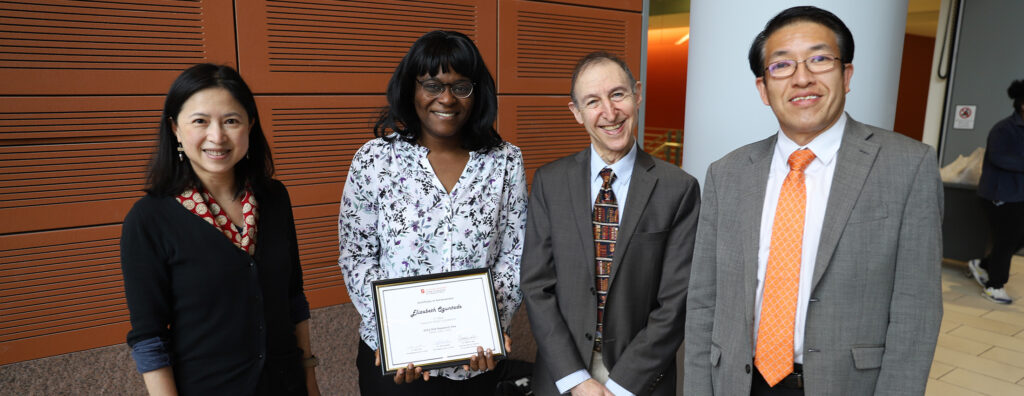
1st Place: Elizabeth Oguntade, PhD student in Bioengineering.
On-Demand Activation of Functional Protein Surface Patterns with Tunable Topography
Suitable for Biomedical Applications. Advisor: Dr. James Henderson
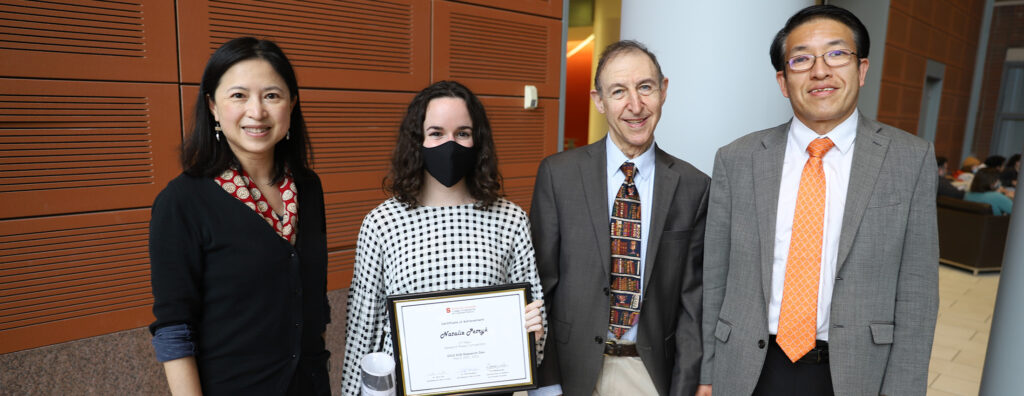
2nd Place: Natalie Petryk, MS student in Bioengineering.
Synthesis of Shape Memory Polymer Foams with Off-the-Shelf Components for Improved
Commercialization. Advisor: Dr. Mary Beth Monroe
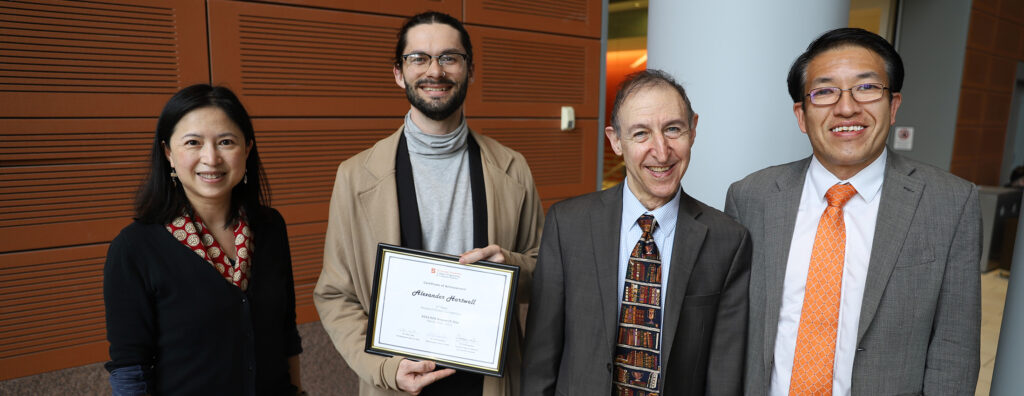
3rd Place: Alexander Hartwell, PhD student in Mechanical and Aerospace
Engineering.
Introduction of a Multilayered Cathode for Improved Internal
Cathode Tubular Solid Oxide Fuel Cell Performance. Advisor: Dr. Jeongmin Ahn
Honorable Mention: Saif Khalil Elsayed, MS student in Civil Engineering.
Modeling Self-Folding Hybrid SU-8 Skin for 3D Biosensing Microstructures.
Advisor: Dr. Zhao Qin
Oral Presentation Competition
Communication and Security Session
1st Place: Kai Li, PhD student in Electrical/Computer Engineering. Detect and
Mitigate Vulnerabilities in Ethereum Transaction Pool. Advisor: Dr. Yuzhe Tang
2nd Place: Xinyi Zhou, PhD student in Computer/Information Science. “This is
Fake! Shared it by Mistake”: Assessing the Intent of Fake News Spreaders. Advisor:
Dr. Reza Zafarani
Health and Well-being Session
1st Place: Yousr Dhaouadi, PhD student in Chemical Engineering. Forming
Bacterial Persisters with Light. Advisor: Dr. Dacheng Ren
2nd Place: Henry Beaman, PhD student in Bioengineering. Gas-Blown Super
Porous Hydrogels with Rapid Gelling and High Cell Viability for Cell Encapsulation.
Advisor: Dr. Mary Beth Monroe
Energy, Environment & Smart Materials Session
1st Place: Durgesh Ranjan, PhD student in Mechanical and Aerospace Engineering.
Porous nanochannel wicks based solar vapor generation device. Advisor: Dr.
Shalabh Maroo
2nd Place: Alexander Johnson, PhD student in Civil Engineering. Estimating Dry
Deposition of Atmospheric Particles by Rain Washoff from Urban Surfaces.
Advisor: Dr. Cliff Davidson
Sensors, Robotics & Smart Systems Session
1st Place: Lin Zhang, PhD student in Computer/Information Science. Adaptive
Sensor Attack Detection for Cyber-Physical Systems. Advisor: Dr. Fanxin Kong
2nd Place: Zixin Jiang, PhD student in Mechanical and Aerospace Engineering,
Short-term occupancy prediction driven intelligent HVAC control. Advisor: Dr. Bing
Dong
Collaborative Partnership Between Syracuse University and Leading Research Universities Receives Presidential Award

The GEM Consortium, a collaborative partnership between leading research universities and industry to help underrepresented students earn masters and doctoral degrees in STEM fields, received the 2021 Presidential Award for Excellence in Science, Mathematics and Engineering Mentoring.
Syracuse University has been a member of the GEM Consortium for almost 30 years. In the past 5 years, GEM Fellowships have been awarded to graduate students in the School of Architecture, College of Arts and Sciences, College of Engineering and Computer Science as well as the School of Information Studies. The number of GEM Fellowship applications from SU students is now in the top 10 among GEM member universities. Civil and environmental engineering Professor Dawit Negussey is the current Syracuse University representative on the GEM Consortium.
“The award recognizes the contributions of the GEM Consortium in providing a scalable path to STEM careers in academia and industry for underrepresented students,” said Negussey.
“I’m grateful for all of Professor Negussey’s efforts to grow our graduate education pipeline for underrepresented graduate students at Syracuse University,” said Peter Vanable, dean of the Graduate School. “To go from relatively little activity with the GEM Consortium to being a top 10 contributor of GEM applicants is a clear marker of our commitment to increasing the diversity of our graduate student population.”
Over the past 45 years, more than 4000 GEM Fellows have earned MS and PhD degrees in STEM fields. At present, the GEM consortium membership consists of 129 private and public national universities and 61 major corporations and research laboratories.
Anupam Pandey
Degrees:
- B.S. in Civil Engineering, Jadavpur University, 2010
- M.S. in Engineering Mechanics, Virginia Tech, 2014
- Ph.D. in Applied Physics, University of Twente, 2018
Areas of Expertise:
- Soft Matter
- Elasticity
- Capillarity
- Viscous flow
Lab/ Center/ Institute affiliation – BioInspired Institute
My primary research interest is understanding the mechanics of soft and squishy materials such as elastomers, hydrogels, and polymer melts. At a low energetic cost these materials can bend, fold, crease, pop or snap, exhibiting a variety of large (sometimes singular) and fast deformations. Their response emerge from an intricate coupling between geometry and material (surface and bulk) properties. Combining experimental, theoretical and numerical tools I study how soft materials behave when they are adhered to other substrates, wetted by liquid drops, or exposed to a flow. Leveraging this fundamental knowledge, my research lab aims to advance the development of flexible and wearable electronics, sensors and actuators for smart materials and functional surfaces.
Honors and Awards:
- Outstanding faculty award – Sigma Gamma Tau (2024).
- Active learning initiative fellowship at Cornell University (2021).
- International Congress of Theoretical and Applied Mechanics (ICTAM) Travel Award (2016).
Selected Publications:
- J. Yuk, A. Pandey, L. Park, W.E. Bemis and S. Jung, Effect of skull morphology on fox snow diving, PNAS 121, 19 (2024).
- A. Pandey, Z. Chen, J. Yuk, Y. Sun, C. Roh, D. Takagi, S. Lee and S. Jung, Optimal free surface pumping by an undulating carpet, Nature Communications 14, 7735 (2023).
- A. Pandey, J. Yuk, B. Chang, F. Fish, and S. Jung, Slamming dynamics of diving and its implications for diving related injuries, Science Advances 8, eabo5888, 2022.
- A. Pandey, M. Kansal, M. A. Herrada, J. Eggers and J. H. Snoeijer, Elastic Rayleigh-Plateau Instability: Dynamical Selection of Nonlinear States, Soft Matter, 17, 5148, 2021.
- A. Pandey, B. Andreotti, S. Karpitschka, G. J. van Zwieten, E. H. van Brummelen, and J. H. Snoeijer, Singular nature of the elastocapillary ridge, Physical Review X, 10, 031067, 2020.
Kasey Laurent
Degrees:
- Ph.D. Theoretical and Applied Mechanics, Cornell University, 2023
- B.S. Aerospace Engineering and Mechanics, University of Minnesota – Twin Cities, 2017
Research Interests:
- Experimental Fluid Dynamics
- Bio-Inspired Flight and Swimming
- Bio-Inspired Noise Mitigation
- UAV Flight Performance in Wind
Dr. Laurent’s research focuses on the role of turbulence and fluid dynamics on aerodynamic performance. She explores both biological and man-made vehicle flight. In her work studying golden eagles, she found a strong relationship between the motion of the bird and the small-scale turbulence experienced by the bird when soaring. These results indicate a need to fully incorporate an understanding of turbulence into our understanding of eagle movements, with implications for other natural and artificial fliers. In the Laurent Fluid Dynamics Lab, her research aims to find engineering solutions to challenges in the field of unmanned aerial vehicles (UAVs) by exploring both biological flight and swimming.
Selected Publications:
Laurent, K. M., Fogg, B., Ginsburg, T., Halverson, C., Lanzone, M. J., Miller, T. A., … & Bewley, G. P. (2021). Turbulence explains the accelerations of an eagle in natural flight. Proceedings of the National Academy of Sciences, 118(23), e2102588118.
Laurent, K., La Ragione, L., Jenkins, J. T., & Bewley, G. P. (2022). How vertical oscillatory motion above a saturated sand bed leads to heap formation. Physical Review E, 105(5), 054901.
Alexander Deyhim
Degrees:
1998 MBA, Cornell University, Ithaca, NY
1993 Master of Engineering, Mechanical Engineering, Cornell University, Ithaca, NY
1987 B.S. Mechanical Engineering, University of Reading, Reading, England
Program Affiliations
Director, Invent@SU
Areas of Expertise:
- Fundamentals of engineering
- Engineering design/project management
- Entrepreneurship
Prof. Deyhim brings three decades of industry and entrepreneurship experience to SU. After working as an engineer for Ford Motor Company, he founded Advanced Design Consulting (ADC) USA Inc. in Lansing, NY. For over 25 years, he managed contracts with government laboratories, international organizations and academic institutions designing complex scientific instruments. Clients included NASA, Argonne National Laboratory, ITER, Army Special Forces and similar organizations in more than 26 countries around the world.
He has a passion for bringing his industry experience and expertise into the classroom and especially enjoys guiding students in the design and delivery of innovative technical projects. He has a vast network of industry partners who are eager to work with engineering students. In his previous role as Associate Director of the MSE M.Eng. Program at Cornell University, Prof. Deyhim recruited a number of leading technical companies, including Satomer, ams, Applied Materials, Boeing, Borg Warner, Corning, Moog, Intel, Exxon Mobile and Universal Instruments, to provide hands-on projects for his students. Prof. Deyhim looks forward to continuing to build industry partnerships to create amazing opportunities for the MAE students at Syracuse University.
Courses Taught:
- ECS 221 Statics
- MEE 471/472 ME Senior Capstone Design
- MAE 500 Entrepreneurship for Engineers
Honors and Awards:
- MAE Teaching Excellence Award, 2023
Selected Presentations/Publications:
- “Development of a Precision Model Positioning System for a Multi-Use Electromagnetic Test Facility at NASA Langley Research Center” AMTA 36th Annual Meeting & Symposium Tucson, Arizona | Oct 12 – 17, 2014
- “Theoretical and experimental study of a new single-coil superconducting miniundulator” arXiv:1412.1294 https://arxiv.org/abs/1412.1294
- “Development of A Super-Mini Undulator” 2011 Particle Accelerator Conference (PAC’11) March 28 – April 1, 2011 NY USA
- “Embedded Sensors for Life-Time Monitoring of Concrete” 4th International Conference on Structural Health Monitoring on Intelligent Infrastructure (SHMII-4) 2009 22-24 July 2009, Zurich, Switzerland
- “Portable Magnetic Measurement System” European Particle Accelerator Conference, EPAC’08, Genoa, Italy, 23 to 27 June 2008 https://iopscience.iop.org/article/10.1088/1742-6596/425/3/032024
- “Development of a 100 mm Period Hybrid Wiggler for the Australian Synchrotron Project” 22nd Particle Accelerator Conference, June 25 – 29, 2007 USA
- “X-25 Cryo-ready In-vacuum Undulator at The NSLS” AIP Conference Proceedings; ISSN 0094-243X; Worldcat; CODEN APCPCS; v. 879(1); p. 283-286 https://inis.iaea.org/search/search.aspx?orig_q=RN:39062723
- “Development of a 3.8 Meter Variable Polarization Undulator (EPU)” AIP Conference Proceedings 879, 392 (2007); https://doi.org/10.1063/1.2436082 https://aip.scitation.org/doi/10.1063/1.2436082
- “Multi-element Analyzer for Inelastic X-Ray Scattering” 2004: American Institute of Physics http://adsabs.harvard.edu/abs/2004AIPC..705..893C
- “Development of a Compact System for In-situ X-ray Scattering Studies of Organic Thin Film Deposition” 2004: American Institute of Physics http://adsabs.harvard.edu/abs/2004AIPC..705.1150H
- “Development of a Double Crystal Monochromator” 2004: American Institute of Physics http://adsabs.harvard.edu/abs/2004AIPC..705..651K
- “Characterization of the Fatigue Properties of Bonding Wires” Published in: 1996 Proceedings 46th Electronic Components and Technology Conference https://ieeexplore.ieee.org/document/550505
Racing into the Future
Mechanical and Aerospace Engineering Student Elliott Holdosh ‘23 Accepts Co-Op Position with Tesla
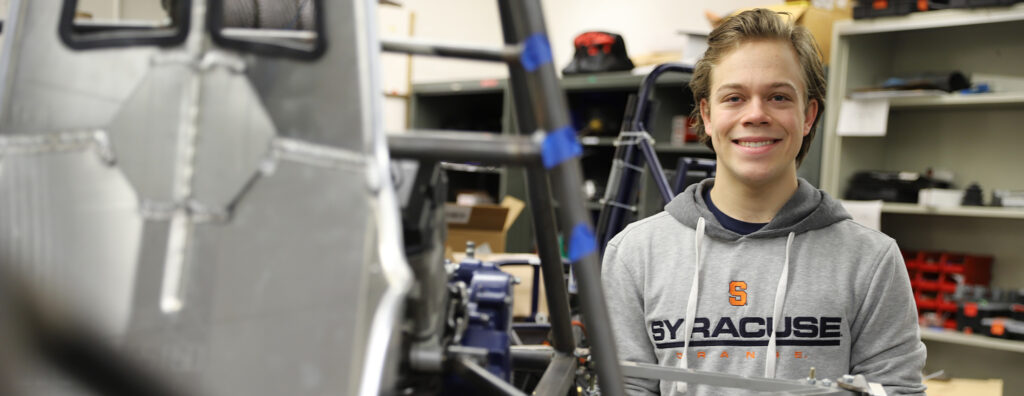
Long before he could drive them, Elliott Holdosh ’23 was always interested in cars. He got his first hands-on experience working with his grandfather on a 1989 Ford Mustang and it set his future in motion.
“When I was considering what I wanted to study in college, I thought – what could I do with cars?” said Holdosh.
When he arrived at Syracuse University’s College of Engineering and Computer Science, Holdosh started making connections and joined the Citrus Racing Formula SAE team. It gave him more experience with automobile design and engineering.
“It helped me learn a lot about technology but also automobile engineering terminology,” said Holdosh.
While working with Citrus Racing, Holdosh saw a posting in the group’s Slack channel for a job opportunity in solid works and computer aided design (CAD). It led to a part-time position with Auto Gear Equipment in Syracuse who specialize in high performance manual shift gearboxes for racecars.
“I was able to work as a drafting engineer,” said Holdosh. “I took two dimensional sketches and brought them to 3D designs. It has been an incredible opportunity and meaningful professional experience with a great company.”
The experience at Auto Gear Equipment also confirmed for Holdosh that he wanted a career in automobile engineering. He worked with the career services office and his academic advisor in the College of Engineering and Computer Science as he explored co-op opportunities at automobile engineering companies.
“Career advisor Christopher Maldonado helped me with a resume review and to improve my LinkedIn profile,” said Holdosh. “I knew a co-op could be a great opportunity for me.”
Holdosh applied for and was offered an internship with Tesla at their Fremont, California facility as a vehicle engineering intern for the interiors engineering team.
“When I got the news, it was a very impactful moment,” said Holdosh.
He will be at Tesla for the Spring 2022 semester but was able to adapt his academic schedule so he will still be on track to graduate on time after four years at Syracuse University. He is grateful for the relationships he has built on and off-campus and believes those connections are what helped him land the position at Tesla.
“Get involved on campus and get to know people,” said Holdosh. “It was the catalyst.”
While his engineering journey began with his grandfather’s Mustang, Holdosh is excited to be part of the next generation of automobile design.
“I want to work for a company that is always pushing to improve,” said Holdosh. “We are going into an age where we need to prioritize our planet. Tesla is the best at that right now.”
Fall 2021 Engineering and Computer Science Dean’s List

In recognition of superior scholarship, the following students have been entered on the Engineering & Computer Science Dean’s List for Fall 2021.
To be eligible for Dean’s List recognition, the minimum semester grade point average must be 3.40 or higher, must have earned a minimum of 12 graded credits and must have no missing or incomplete grades.
Aerospace Engineering
Lucy Genevieve Adams
Allyson Almeida
Brady Joseph Arruda
Richard L Bruschi
Curtis James Cline
Bryan Collins
Nicholas Daniel Crane
Brian James Cronin
Christopher John Doherty
Michael Alexander Donato
Benjamin David Faasse
Kassidy Fields
Christian Scott Fitzgerald
Victoria Elizabeth Forsyth
Benjamin Daniel Gerard
Alexandre J Gill
Zachary William Haas
Alyssa Henley
Aidan Hoff
Matthew James Holmes
Paula Cristina Ibelings
Nicholas John Jacobs
Sydney F Jud
Hunter John Adam Knarr
Trevor Anthony Knight
Eleanor Jane Lawler
Isaac Alan Lehigh
Emma Lee Levenson
Maximillian Lipinski
Jacob Eric Long
Powers Craig Lynch
Brendan Michael Marquis
Noah Martel
Elsa Adrianna Martin
Jonathan Henry Martin
Maxwell Joseph Martin
William Armstrong Martin
Jason W McElhinney
Mariana C McManus
Parker Byrne McMillan
Alexander Timothy Metcalf
Romeo Michelson
John P Michinko
Kendra Teresa Miller
Evan Gregory Moore
Brendan Pierce Murty
Mark Namatsaliuk
Tatiyyanah Queen-Asia Hope Nelums
Jarod I Okamura
David Dang Pham
Logan D Prye
Nicholas Christopher Richard
Brandon Walker Riley
Tracey Josephine Rochette
Daniela Maria Ruano-Pinos
Michael Chandler Saksa
William J Saueressig
Fred Evan Schaffer
William Arthur Sennett
Justine John A Serdoncillo
Kanya Kiresh Shah
Vraj Shah
Prabha Singh
Gregory C Slodysko Jr
Zachary Michael Stahl
Ethan J Stocum
Jaime S Sued Jr
Yiyuan Sun
Marco Svolinsky
Richard A Tedeschi
Anthony R Tricarico
Cody Joseph VanNostrand
Diego Roman Villegas
Mason Alexander Weber
Kana Li Wong
Cameron M Woodbury
Melissa Yeung
Bioengineering
Anthony Drew Acierto
Ashraf Tariq Alnatour
Bianca Louise Andrada
Jason Bae
Anna Mae Brunson
Britnie Jean Carpentier
Lukas Cook
Tessa Riley Decicco
Mia-Marie Fields
Katherine Ann Gardner
Jennifer Gonzalez
Skyla Gordon
Benjamin Michael Grainger
Jenna Grutzmacher
Grace Haas
Lauren Elizabeth Hamilton
Victoria Li Rui Hathaway
Brenna Henderson
Avinash Jagroo
Madeline Jones
Gabriel Khan
Olivia Lynne Kmito
Emily Elizabeth Labour
Quinn Patrick Langdon
Sara Anne Leonardo
Alejandra Eugenia Lopez
Ethan L Masters
Aidan Theresa McCarthy
Aelish McGivney
Ian G McHugh
Lindy M Melegari
Katherine Grace Monroe
Hannah V Murphy
Alexander Patrick Musselman
Mark Nicola
Nicole E Nielsen
Kerrin Anne O’Grady
Mia Dian Paynton
Megan Perlman
Connor Preston
Michael Steven Presunka
Gavin David Richards
Mia Elizabeth Russo
Amira Salihovic
Juliana Sepulveda
Bridget Yong Sides
Katherine Anne Southard
Justin N Stock
Elizabeth Tarami Su
Zhuoqi Tong
Rochan Jitendra Urankar
Hasan Usmanov
Edgardo Velazquez
Danny Vu
Carly J Ward
Nathaniel D Wellington
Maximillian Meier Wilderman
Lauren Margaret Woodford
Rui Xie
Julian Marcus Smucker Zorn
Samantha Yvonne Zysk
Chemical Engineering
Adriana M Archilla
Athena Andrea Basdekis
Brigitte A Belanger
Sandy Ynhu Cao
Trinity Joy Coates
Dennis Dao
Gabriela Duarte Saadia
Sophia Elizabeth Figueroa
Emily C Fittante
Edward Coleman Fluker
Mia Angela Goldberg
Brent Tadao Gosselin
Avery Gunderson
Christopher Max Hansen
Aiden A Jacobs
Natalia Jarmain
Hope Irene Johnson
Sonia Julius
Sayf Karim
Laxmi Khatiwada
Adam J Klinger
Simran Dharmendra Lakhani
Caroline J Leduc
Rawia F A M Marafi
Angela L Martinez
Sydney Rae Nowicki
Erin Marie Odonnell
Sean O’toole
Eli Irvin Paster
Daniel J Pelkey
Fabiana Nohelia Perez
Nora Swan Prosak
Ryan Gordon Ryersen
Riley Madison Schmerber
Jacob Matthew Shellhamer
Jason Tan
Elizabeth M Wall
Tyrese J Whyte
Jackson Richard Yuen
Civil Engineering
Shalom Acheampong
Cassie Agren
Nicole Ayora
Maxwell Bell
Christian Balingit Bianco
Henry C Bievenue
Ryan Bourdeau
Matthew Emmet Brewster
Alycia Joline Bruce
Masson Bruening
David Coghiel
Alejandro E Correa
Aymeric P Destree
Kelly Diaz Rojas
Jack Dwyer
Marlee Ann Ecton
Stephen Goffredo
Elliane Reut Greenberg
Julia Ann Johnson-Milstein
Joshua Michael Kaufman
Jakob Lamond Keller
Kate Astrid Kemnitz
Alexander Gregory Klee
Adam Paul Landry
Evangelia Birget Larson
Abigail G Laschalt
Daniel Leyva
Emma Marie Liptrap
Emilija Alise Lizins
Erick Lojano-Quispe
William Ma
John M Mazza
Jessica M McGowan
Lucas James Meiers
Sumit Harshad Mistry
Amira Mouline
Mazin F Moya
Trevor Robert Napoli
Marissa R Nicole
Maxwell Robert Pozar
Kaylin Janet Richards
Alexander David Ruppe
Cassie Elizabeth Saracino
Yazbeck Thomas Sarkees
Juha Wesley Schraden
Aaron Presley Shinn
Caitlin Jane Spillane
Jose Arturo Venegas
Christian Viola
Angelina Maggie Wong
Isabelle Wong
Sarah Wong
Paige H Yamane
Sifei Zhu
Computer Engineering
Adekunle J Akinshola
Chikeluba K Anierobi
Graciela Gicel Avila
Mergim Azemi
Kyle J Betten
Jackson Thomas Bradley
Carlon Brown
Dynasty Da’Nasia Chance
Kongxin Chen
Ibrahima Diallo
Lyn El Sayed Kassem
Melvin Ruben Escobar Gonzalez
Xavier Evans
Elizabeth A Fatade
Aidan Robert Harrington
Ethan Hensley
Kasey Jackson
Mehak Jetly
Virkin Jimenez
Benjamin N Johnson
Fundi Juriasi
Robert Nicholas Kashian
Bikash Khatiwoda
Jessica K Lat
Tyler Alexander Lavaway
Matthew B Leight
Jiaxiong Li
Nicholas Kent Magari
Kyle Maiorana
Aksel James Malatak
Jacob Stephen Masrouri
Isabel M Melo
Benjamin Hudson Murray
Pierce Austin Neubert
Jose L Olivera
Derrick Nana Yaw Osei Owusu
Alexander C Perez
Anthony Patrick Riello
Alfonso E Rivas
Daniel Rose
Samuel M Rosenthal
Hongyi Ruan
Zachary Joseph Starr
Declan Wavle
Ryan Wolff
Renjie Xu
Andy Zheng
Computer Science
Aashutosh Acharya
Aaron Alakkadan
Labeeb Alam
Sajjad Abdullah Albadri
Huda A Ali
Anas Abdallah Hussein Alkhashroom
Joseph M Balascio
Simon C Barley
Giovanna Elizabeth Barsalona
Samantha E Bastien
Maxwell Robert Beam
Emma Bellai
Anas Ahmed Benhamida
Joshua Jordan Boucher
Brian Michael Bourne
Amanda Leigh Bowdren
Ella Maria Brink
Bryan Bladimir Bueno Reyes
Christopher Manuel Calderon Suarez
Liam M Calnan
Megan J Campbell
Chih-Chia Chen
Hong Yang Chen
Jackie Chen
Lawrence Chen
Runzhou Chen
Wenyu Chen
Yixing Chen
Yuhao Chen
Oscar Chi
Daniel Chmielewski
Season Chowdhury
Konstantinos Chrysoulas
Melissa Chu
Miguel Angel Cruz Flores
Matthew Cufari
Ryan Matthew Czirr
Salvatore DeDona
Aidan Christopher DeGooyer
Alpha Oumar Diallo
Lucille Jennifer Disalvo
Ting Dong
Christopher Edmonds
Yassin Mahmoud Elsharafi
Ryan Siebe Elsinga
Jair Espinoza
Xueyan Feng
Nathan B Fenske
Bennett Ferrari
Lucas Kuebler Fox
Mason Roy Freer
Evan Garvey
Grant Thomas Gifford
Brianna S Gillfillian
Justin Gluska
John Martin Gorman
Dayong Gu
Alexander Peter-Anthony Haas
Athanasios Hadjidimoulas
Ashley Marie Hamilton
Jillian Elizabeth Handrahan
Liam Gordon Hannah
Cameron Hoechst
Laurel Howell
Jacob Howlett
Jason Huang
Xuanye Huang
Yanju Huang
Chengyi Jiang
Tianyiming Jing
Frederick Jackson Jones
Michael Wesley Jones
Alan Jos
Lauren Keona Kaaiakamanu
Aarya Tara Kaphley
Maxwell Albert Kaufman
Matthew Keenan
Ekaterina Kladova
Joshua Jayvant Zachary Koshy
Krutartha Nagesh
Rami Lionel Kuttab
Janet Jihoo Lee
Maya J’Nai Lee
Jiashu Li
Ruowen Li
Yuxuan Li
Daniel Lim
Chengda Lin
Haochen Lin
Sandy Lin
Erxi Liu
Jiaming Liu
Joshua Zhou Liu
Junzhang Liu
Yuyuan Liu
Cayden Thomas Lombard
Kevin A Lopez
Yiheng Lu
Michael Fitzgerald Lupton Jr
Runzhi Ma
Hunter O’Neal Malley
Andrew Thomas Markarian
Kanoa Matton
Ryan M May
Anthony Louis Mazzacane
Matthew McDaniels
Noah Mechnig-Giordano
Philip Anthony Moceri
Thomas J Montfort
Aaron Masoud Moradi
Jovanni Nicholas Mosca
Chenxi Mu
Andi Muhaxheri
Zoe Anne Neale
Christopher Scott Nemeth Jr
Jillienne Judith Ness
Arianna Kassandra Nguyen
Carlyn M O’Leary
Marissa Lynn Orsley
Daniel Pae
Xiaofeng Pan
Michael J Panighetti
Adya Aditi Parida
Zizheng Pei
Brian Joseph Pellegrino
Carlo Francesco Pisacane
Daniel Pomerantz
Fiona Colleen Powers Beggs
Cheng Qiu
Shane Michael Race
Raasin Amin Rahman
Alexis Hope Ratigan
Christopher Rhodes
Robert R Robinson
Eric Rodriguez
Sadikshya Sanjel
Jonathan Lee Schwenk
Huahao Shang
Andrew Shao
Nolan Lee Shepherd
Chad Thom Smith
Anthony Logan Solt
Dongzhao Song
Yijie Song
Hayden Christopher Spelbring
Jeremy P Stabile
Kevin Sullivan
Nicholas P Sweet
Louanges Essohana Marlene Takou-Ayaoh
Jonathan Richard Constantine Templeton
Jonathan Ezra Thomas
Eduardo Torres-Garcia
Winston Tsui
Randy C Vargas
Kevin Anthony Verdeschi
Kritika Verma
Christopher Mark Vinciguerra
Lihan Wang
Ruobing Wang
Xinyi Wang
Zijian Wang
Robert Ward
Jack Andrew Willis
Sarah Grace Wlodkoski
Ethan Wong
Zongxiu Wu
Zhuoyi Xiong
Yujie Xu
Jishuo Yang
Yisheng Yang
Yongcan Yang
Stella R Yaunches
Yulun Zeng
Liaotianbao Zhang
Mingyan Zhang
Rixiang Zhang
Ruihao Zhang
Weiwei Zhang
Zhiyuan Zhang
Haoyu Zhao
Jinchao Zhao
Junjie Zheng
Xiao Lin Zheng
Liuyu Zhou
Xinqian Zhou
Yitao Zhou
Yixuan Zhou
Joseph Patrick Zoll
Engineering Undeclared
Sydney M Baylor
Thomas John Fabiano
Charles James Germosen
Alexander Joseph Hai
Juwei Lin
Luke Benjamin Lybarger
Kathleen Rose Meleski
Annika Daphne Meyers
James Peden
Justin Wayne Pettit
Emily Mae Schiessl
Abdullah Swati
Haoran Wang
Electrical Engineering
Minghao Ai
Mohammed A Aljohani
Tianle Bu
Kevin E Buciak
Wyatt Glenn Bush
Vincent Alec Camarena
Arianna Maxine Cameron
Leshui Chen
Nicholas Shawn Connolly
Kevin James Donnelly
Henry C Duisberg
Randy Galicia
John Charles Garcia
Justin P Geary
Christopher Gill
Jose Ignacio Ginorio
Joseph Charles Jannello
Michael Matthew Kelly
Dong Kyu Kim
Yiwei Ling
Jemma Mallia
Liam Fuller Marcato
Tyler Sean Marston
Angel Antonio Medina
Lukas Allen Morris
Zixun Nian Nian
Jayson V Okhman
Dylan Palmer
Julia Pepin
Matthew Piciocchi
Francisco Rodriguez
Gilberto E Ruiz
Gabriel E Ruoff
Kayla Ann Saladyga
Jenna Mei Stapleton
Connor Christopher Sumner
Jared William Welch
Environmental Engineering
Tyler James Allison
David Michael Brodsky
Benjamin R Cavarra
Ananya P Chandra
Emma Crandall
Elizabeth Bryant Cultra
Eric James Fitzgerald
Eleanor Elizabeth Gettens
Brady E Hartnett
Christopher Harvey
Nicholas Colin Axel Kohl
Henry David Long
Molly M Matheson
Salma Valles Mohamed
Matthew Edward Nosalek
Liesel Marie Odden
Hennecys Darlene Perez Castro
Ella Hope Phipps
Scott M Potter
Yongfang Qi
Jasmine Victoria Rodriguez
Mary H Schieman
Hayley Shay Scott
Jacob M Tyler
Andrew Michael Vanderwege
Maria Antonia Villegas Botero
Emily Jean Vogel
Anna Wojcik
Savannah Marie Wujastyk
Qiuyu Zhou
Reilly Zink
Mechanical Engineering
Owyn Phillip Adams
Joshua Carl Arndt
Timothy G Arnold
Charles D Ball
Arthur Barros
Michael James Battin Jr
Erin Beaudoin
Rachael O Beresford
Aidan Paul Bergman
Jeffrey Trent Bernstein
Chloe Marie Britton Naime
Brinley Bruening
Arnaud Buard
Alexander Joseph Callo
Joseph Timothy Capra
Jun Chen
Artur Chuvik
Cooper P Crone
Anthony Cruz
Peter M Daniels
Ryan Russell Dileo
Madeline Doyle
Luyen Duong
Andrew J Esposito
Luke Samuel Fink
Nicholas Andrew Frank
Elan Fullmer
Samuel Ryan Getman
Kara Ai Chun Gorman
Jiayuan Huang
Vian Vishal Jain
Jagger Kachmaryk
Dong Myeong Kang
Jeremy C Kang
Macauley J Kastner
Finnian James Kery
Teagan L Kilian
Cherry Kim
Carl Winston Rice Kjellberg
Justin Kohan
Deanna Summer Koppenjan
Savannah Mae Kreppein
Trevor D Kroells
Nathan Lemoine
Honorata Lubecka
Bei Luo
Lauren Mack
Ryan Patrek Martineau
Michael J McElroy
Ryan A Melick
James Patrick Melitski
Leilah Miller
Wiley Robert Moslow
Beau M Norris
Daniel Panchenko
Nicholas Joseph Papaleo
Nathaniel Ryan Paradis
Tanner Josiah Peck
Corey A Phung
Nicholas Patrick Piano
Alexander Richard
Aidan Riederich
Collin Roche
Jeremy Vinton Rosh
Jeffrey Ryu
Nitish Sachin Satpute
Justin Sauve
Shane Michael Sefransky
William Kaspar Sherfey
Zachary Ryan Shuler
Eric Silfies
Nathaniel Slabaugh
Samuel Theodore Slaiby
Ian Storrs
Matthew K Swanson
Ethan William Tracey
Evan R Tulsky
Alexandra Rose Vaida
Nicholas Valentin
Griffin Riley Vollers
Xu Wang
Michael David Wehrle
Justin H Westhuis
Taj Asim Whitney
Michael Wong
Systems & Information Science
Connor W Gurnham
Stacy Kim
Akshay Ram
Zachary Tyler Williams
Aerospace engineering student Juanitta “AJ” Bekoe ’24 selected to receive a Patti Grace Smith Fellowship.
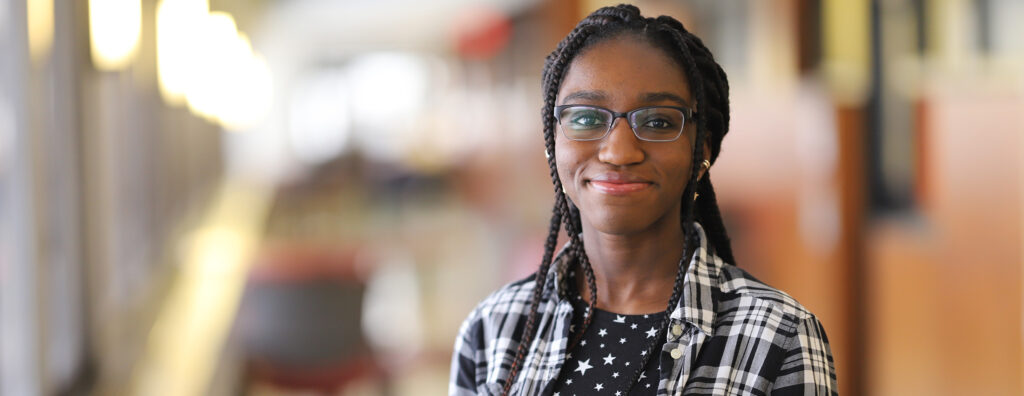
The Patti Grace Smith Fellowship program connects the nation’s leading aerospace companies with talented Black students. Students receive a summer internship in the aerospace field, a scholarship and personalized mentors. 39 recipients from across the United States were chosen after displaying exceptional aptitude in their chosen discipline in addition to scoring high marks for creativity, ingenuity and a commitment to serving others.
Bekoe is an active member of the National Society of Black Engineers chapter, as well as the American Institute of Aeronautics and Astronautics chapter. She is also a member of Citrus Racing – the college’s Formula 1 Team as part of the Society of Automotive Engineers, where she is a member of the aerodynamics sub-team. Outside of engineering, she is a dancer and choreographer for Creations Dance Company – the first student dance organization founded on campus by 10 African-American women – specializing in multiple dance styles. This spring semester commemorates their 44th year as a dance team. Bekoe plans to continue onto the 4+1 Masters Program in mechanical and aerospace engineering following her senior year. She will be hosted this summer at Ball Aerospace in Colorado as a systems engineering intern.
Engineering and Computer Science, Upstate Medical University Faculty Awarded National Institutes of Health Grant for Catheter Research Project
For the 75 million people who require a urinary catheter, urinary tract infections are a serious concern. Catheters are prone to colonization by bacterial and fungal pathogens, which causes antibiotic-resistant infections. An infection can also lead to pH changes in the urine and block a catheter due to stone formation with potentially fatal consequences. Catheter associated urinary tract infections (CAUTIs) that are antibiotic resistant cause 13,000 deaths in the U.S. each year.
College of Engineering and Computer Science professors Dacheng Ren, Stevenson endowed professor of biomedical and chemical engineering and associate dean for research and graduate programs; Teng Zhang, assistant professor of mechanical and aerospace engineering; and Huan Gu, research assistant professor and Upstate Medical University’s Dmitriy Nikolavsky, MD, associate professor of Urology, were awarded an National Institutes of Health (NIH) R01 grant for a project aiming to engineer a new urinary catheter using smart biomaterials to reduced catheter associated complications.
“Conventional antibiotics commonly fail to eradicate infections associated with medical devices because of the remarkable capabilities of microbes to colonize these surfaces and form drug-resistant biofilms. To solve this challenging problem, we need new strategies that can provide long-term protections. This R01 project gave us an exciting opportunity to do exactly that,” said Ren, the principal investigator of this project.
Ren’s lab has developed a new strategy designed to make catheters smarter and more resistant to infection. They successfully created micron-sized pillars with supermagnetic nanoparticles on the tip so the pillars can beat in response to an electromagnetic field generated using an insulated copper coil embedded in the catheter wall. By controlling the on and off of an electric current, they could turn the magnetic field on and off, and thus control the beating frequency and beating force of the pillars. This strategy (active topography) worked well, as these moving pillars prevented biofilm formation of multiple bacterial species by up to 99.9% compared to flat control surfaces. A prototype catheter with active topography remained clean for 30 days while the control catheters were blocked by biofilms of uropathogenic Escherichia coli within five days in an in vitro test with flow of a medium mimicking urine. Their study was published in a recent issue of Nature Communications.
Now Ren, Gu, Zhang and Nikolavsky will move forward and study the mechanism of infection control by such active topographies, and further engineer their catheter porotype for in vivo tests in this R01 project. By optimizing micron sized pillars on the catheter wall, they hope to develop a self-cleaning catheter that would be much safer for long term use.
“This strategy is inspired by the motile cilia in human airways that protects our lungs from foreign particles during respiration,” said Gu. “Thanks to the development in materials and surface engineering, we can replicate this defense strategy, make it more robust and adaptable, and apply it to address challenges such as biofilm-associated urinary tract infections in this project.”
Numerical simulations from Zhang’s lab and the collaboration with Nikolavsky in Upstate Medical University’s urology department are key components to the potentially groundbreaking work.
“Biofilms are highly complicated biological materials with active bacteria embedded in polymer networks. This poses challenges and provides opportunities to integrate mechanics modeling and simulations with well-controlled experiments to uncover the working mechanism and design principles of medical devices.”
Zhang has been collaborating with the Ren lab prior to this award and he is also a co-author of the Nature Communications paper.
If successful, the findings from this study may also help solve other infections that involve microbial biofilms, especially those associated with medical devices.
“I am very excited about this design of smart catheters, Bacterial colonization and biofilm formation on catheters, stents and other implantable devices is an enormous problem in medicine,” said Nikolavsky. “Creating such smart surfaces on catheters that would actively expel pathogens, could potentially prevent bacterial colonization, catheter-associated urinary tract infections and may save patients with chronic catheters from bladder stone formation and recurrent catheter encrustation and clogging. I expect this will improve medical care and have positive effect on quality of life for many patients and prevent some of the common urological emergencies.”
BioInspired Institute
BioInspired Syracuse supports research into complex biological systems, developing and designing programmable smart materials to address global challenges in health, medicine and materials innovation. It is an Institute for Material and Living Systems, focusing on four key areas: drug discovery, smart materials, form and function, and development and disease. BioInspired involves faculty from life sciences, engineering, physics and chemistry.
Faculty:
Introducing the Inaugural Patrick P. Lee Scholars in the College of Engineering and Computer Science
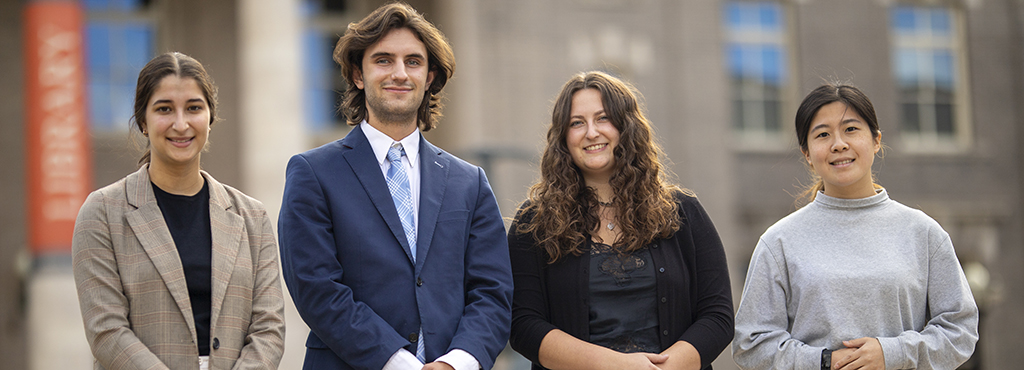
Syracuse University’s College of Engineering and Computer Science is honored to announce our inaugural Patrick P. Lee Scholars. The Lee Foundation’s largest scholarship program supports students at institutions of higher learning who are pursuing careers in engineering and other technical fields.
Joli Cacciatore is a fourth year Civil Engineering student from Niagara Falls, NY. Since arriving at SU she has been part of the ECS Ambassador Scholars program which conducts outreach to local middle schools to foster interest in STEM and provide positive educational role models. She is a member of the SU student chapters of the National Society of Professional Engineers, the Society of Women Engineers, and the American Society of Civil Engineers.
Stacy Kim is a fourth year Systems Information Science major from Staten Island, NY. She has several leadership positions in campus organizations including Vice President of the Society of Asian Scientists and Engineers and Community Service Chair for Kappa Theta Pi through which she conducted outreach to local high schools to help with the transition to online learning. Since 2019 she has worked for the Barnes Center in health promotion for her fellow students and during the pandemic has been helping administer and process COVID tests on campus.
Aymeric Destrée is a third year Civil Engineering major from San Marcos, CA. He is a member of the Ambassador Scholars program and enjoys working with children in the Syracuse public school system to introduce engineering concepts and problem solving skills through fun after school activities. He plans a career in public infrastructure and is particularly interested in transportation and urban design.
Olivia Kmito is a third year Bioengineering student from Bridgewater MA. She is a student athlete on the SU Gymnastics team and a member of the Alpha Xi Delta sorority and the Society of Women Engineers. She has a long term commitment to the March of Dimes organization inspired by a personal connection to their work. Following in the footsteps of her father, an SU engineering alum, she believes an engineer must value “integrity, leadership, and service” and most of all take seriously the trust that their colleagues, their clients, and the public place in them and their work.
Tracking Wildfires
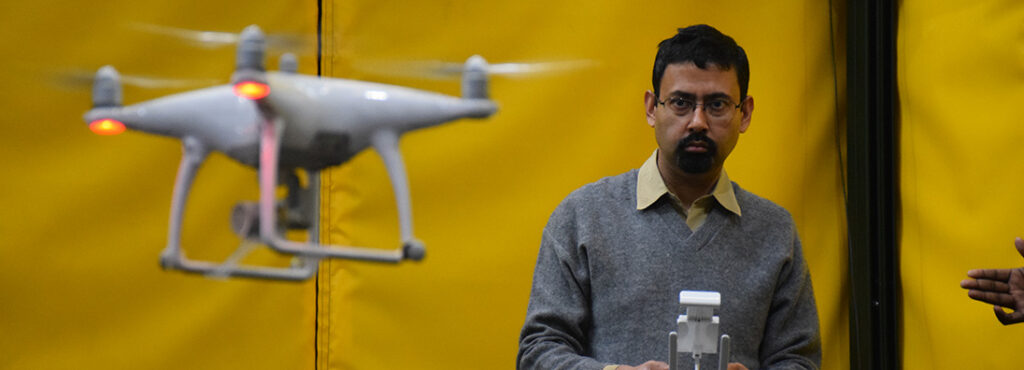
Over the past forty years, wildfires have become more common, more destructive and more difficult to contain. In dry conditions, a spark can turn into a forest fire covering thousands of acres over the course of a few hours. Trying to contain a fast-moving fire is a challenge for firefighters, emergency responders and communities who may have just minutes to evacuate. Fires can travel up to six miles per hours in forests and up to 14 miles an hour in dry grass. If terrain slopes upwards, those speeds can double.
Real time monitoring of fire conditions and movement could help firefighters improve containment strategies but getting data from manned or unmanned aircraft above a raging forest fire has been a challenge.
“This is not just flying in isolation,” says mechanical and aerospace engineering Professor Amit Sanyal. “There is hot air from fires and different air currents being induced. Sensors also have to deal with smoke, ash, burning leaves or leaves about to catch fire.”
Even when an unmanned aerial vehicle (UAV) can be put in the air near a fire, getting data from multiple sensors and input systems back to fire crews on the ground in real time becomes a processing challenge. Especially for a small UAV where load restrictions limit the size and weight of any on-board processing systems.
An interdisciplinary collaboration between Sanyal and two faculty members from The Ohio State University has received a National Science Foundation (NSF) National Robotics Initiative grant to explore the integration of unmanned aerial systems (UAS) into prescribed wildland burn projects. Mechanical and aerospace engineering Professor Mrinal Kumar and forest ecosystem analysis and management Professor Roger Williams from The Ohio State University will be Co-Principal Investigators with Sanyal on the project. Syracuse University will receive $536,983 from the NSF grant to support Sanyal’s research.
Research has shown that climate change has led to warmer, drier conditions in many parts of the world. With reduced snowpack and precipitation, many forests and areas that are already susceptible to wildfires will become even drier. The U.S. Forest Service predicts the percentage of land area determined to be experiencing extreme drought conditions will increase by 30 percent by 2090.
The research team will explore how topographic, atmospheric and forest fuel factors in temperate hardwood forests influence fire intensity and rate of spread through real-time data activation in fire behavior models. Sanyal has extensive research experience with UAV control systems and sees this project as a natural evolution of where his interests have been going.
“A UAV in close proximity to a fire needs dependable and robust control schemes,” says Sanyal. “A non-linear model-free control system has a lot of potential.”
The system Sanyal envisions could allow an UAV to be able to deal with the known physics (elevation, topography) and also rapidly adapt to the unknown physics it might face (sudden and extreme changes in heat, winds or air currents.)
“In order to do that in real time, we need to learn from the data really fast and compensate for it,” said Sanyal. “I think it would be interesting to consider what is known and what is unknown in an ultra-local model of the multi-input, multi-output system that is suitable for implementation on a small onboard processing system.”
The Ohio State University will provide the team with the ability to do controlled burns and test their systems in actual wildland fire conditions. Their work will help provide real time data to firefighters and fire coordinators working to manage hazardous situations and keep people around the world safe.
“Autonomous systems are an area of strength for Syracuse University researchers. This NSF grant demonstrates the potential of cross-disciplinary and multi-institutional research for finding solutions to pressing problems,” says Ramesh Raina, interim vice president for research.
“It is a human problem and a wildlife problem. It would be great if we can make a difference in how we deal with this problem,” says Sanyal.
Teng Zhang
Degree(s):
- Ph.D. Brown University, 2015
- M.S. Dalian University of Technology, 2010
- B.S. Dalian University of Technology, 2007
Lab/ Center Affiliation:
BioInspired Institute
Areas of Expertise:
- Solid mechanics
- Smart materials
- Mechanics of morphing
- Mechanics of instabilities
- Mechanics of interfaces
Dr. Zhang’s group’s research goal is to solve grand challenges where mechanics can play an important role and harness mechanics as an enabling tool to design smart materials and structures for future sustainability. Built on the core strength of mechanics, my group actively engages in highly interdisciplinary works, such as food design, smart materials, and biofilms. Examples of ongoing projects include:
- Harnessing instabilities and active materials to design reconfigurable structures
- Bio-inspired hybrid liquid and solid systems enabled by elasto-capillary and hygro-mechanical couplings
- Mechanics guided shape-changing food
- Mechanics of smart magnetic materials and structures
The fundamental mechanics understanding could also provide design principles of robotics and biomedical devices and establish virtual platforms for simulating and controlling them, especially for those with highly nonlinear deformation in complicated working environments (e.g., endovascular neurosurgery and smart catheters).
Honors and Awards:
- 2021 Soft Matter Emerging Investigator
- 2019 Faculty Early Career Development (CAREER) Award, National Science Foundation
- 2015 Outstanding thesis, Brown University’s School of Engineering
Selected Publications:
- Gabriel Alkuino, and Teng Zhang. Physics-based discrete models for magneto-mechanical metamaterials. Journal of the Mechanics and Physics of Solids (2024): 105759.
- Guangchao Wan, Samuel J. Avis, Zizheng Wang, Xueju Wang, Halim Kusumaatmaja, and Teng Zhang. Finding transition state and minimum energy path of bistable elastic continua through energy landscape explorations. Journal of the Mechanics and Physics of Solids 183 (2024): 105503.
- Danli Luo, Aditi Maheshwari, Andreea Danielescu, Jiaji Li, Yue Yang, Ye Tao, Lingyun Sun Guanyun Wang, Shu Yang, Teng Zhang, Lining Yao. Autonomous self-burying seed carriers for aerial seeding. Nature 614, no. 7948 (2023): 463-470.
- Ye Tao, Yi-Chin Lee, Haolin Liu, Xiaoxiao Zhang, Jianxun Cui, Catherine Mondoa, Mahnoush Babaei, Jasio Santillan, Guanyun Wang, Danli Luo, Di Liu, Humphrey Yang, Youngwook Do, Lingyun Sun, Wen Wang, Teng Zhang, and Lining Yao. Morphing Pasta and Beyond. Science Advances 7, no. 19 (2021): eabf4098.
- Oleh Tovkach, Junbo Chen, Monica M. Ripp, Teng Zhang, Joseph D. Paulsen, and Benny Davidovitch. Mesoscale structure of wrinkle patterns and defect-proliferated liquid crystalline phases. Proceedings of the National Academy of Sciences 117, no. 8 (2020): 3938-3943.
Jianshun “Jensen” Zhang
Degrees
- Ph.D., University of Illinois and Urbana-Champaign; 1991
- M.S. and B.S. Beijing Agr. Eng. University; 1982 and 1985
Lab/Center Affiliations
- Building Energy and Environmental Systems Laboratory
- EQS-STAR Center of Environmental Systems
- Syracuse Center of Excellence in Energy and Environmental Systems
Areas of Expertise:
- Material Emissions, Air Purification, Ventilation, and Indoor Air Quality
- Hygrothermal Performance of Building Materials and Enclosure Systems
- Building Energy and Environmental Systems
- Built Environmental Systems Measurements, Modeling, and Controls
- Intelligent Buildings
- Combined Heat, Air, Moisture and Pollutant Simulations (CHAMPS)
- Multi-disciplinary and Multi-scale Building Systems Design and Optimization
- Effects of indoor environmental quality on occupant exposure, productivity, and creativity
Professor Zhang’s research ranges multi-scale BES from nano/micro-scale in porous media to buildings and urban environment and involves engineering, architectural design, human health, and performance. Major ongoing research projects are:
- Virtual Design Studio (VDS): development of a digital platform for an integrated and coordinated design of green buildings. The project involves close collaboration between engineers and architects to develop a designer-oriented software tool for performance-based building system design.
- BM-IDC: Building monitoring and intelligent diagnosis and control. Using a full-scale testbed, a “Virtual Building” based near real-time monitoring system is developed and deployed to collect essential data for fault detection and diagnosis, and improvement of building operation.
- CHAMPS: Development of combined heat, air moisture, and pollutant simulation software for building system design and control optimization. The CHAMPS simulation environment includes a whole building model, an enclosure model, an HVAC mode and a room model. It is supported by a collection of shared databases of weather, materials and assemblies, pollutants, sources, and sinks. Reduced-order models will be developed for near-real-time simulation in design and predictive control in the operation of buildings.
- ME-IAQ: Material emissions and indoor air quality. A model-based approach is taken to develop fundamental mass transfer models with essential model parameters determined from experiments. The research leads to better models for performance prediction and better test methods for evaluating both short and long-term emissions.
- ACT-IAQ: Air cleaning technologies and indoor air quality. A model-based approach is taken to develop better test methods, evaluate the performance of existing air cleaning technologies, and develop new ones for improving indoor air quality.
- BEST: Building enclosure system technologies. This research includes experimental measurements and modeling of the hygrothermal (thermal and moisture) storage and transport properties of various building materials, model prediction of their impact on enclosure assembly performance, and full-scale evaluation and validation at reduced and full-scale setting under both laboratory and field conditions.
- Effects of IEQ on human performance. Human subject study is performed using a total environmental quality research facility. The focus is on how the improved thermal and air quality via personal ventilation would impact the performance of creativity and productivity of building occupants.
Honors and Awards:
- 2019 ASHRAE Research Administration Committee Service in ASHRAE Research Award
- 2018 ASHRAE Central New York Chapter Award for Contributions to Research and Education in HVAC and IAQ.
- Elected Fellow of ASHRAE, 2012
- Frontier Foreign Expert Award, State Administration of Foreign Experts Affairs, the P.R. China, 2012
- Shiyuan Chair Professorship from Nanjing University, China, 2011
- Best Paper of the Year award, Building Simulation—an International Journal, 2010
- Elected and active member of The ISIAQ Academy of Fellows, International Society of Indoor Air Quality and Climate, 2009
- ASHRAE Distinguished Service Award, ASHRAE, 2008
- JSPS Fellowship, Japanese Society for Promotion of Scientific Exchange, 2007
- Otto Monsted Professorship from Technical University of Denmark, 2006
- Citation by New York State Governor George E. Pataki in his 2003 State of the State address for scientific contributions to the development of the Syracuse Center of Excellence in Environmental Systems, 2003
- American Council of Engineering Companies (ACEC) National Finalist Award and New York State Diamond Award for the development of the Coupled Indoor/Outdoor Environmental Simulator (C-I/O-ES) of the Building Energy and Environmental Systems Laboratory (BEESL), 2003
- ASHRAE Certification of Appreciation Award, 1999
- IRC/NRC Outstanding Research Achievement Award, 1999
- Second place paper award at the Healthy Buildings/IAQ 97 international conference, Washington, DC, 1997
- IRC/NRC Outstanding Research Achievement Award, 1995
- Best paper award at the 5th International Jacques Cartier Conference on Indoor Air Quality, Ventilation and Energy Conservation, 1992
- Outstanding research paper award (top 2.5%) by the American Society of Agricultural Engineers, 1989
- Phi Kappa Phi and Alpha Epsilon honor societies, 1989
- Excellent student awards, BAEU, 1980
Select Publications
Dung, A., J. Zhang and Z. Liu. 2021. Impact of humidity on formaldehyde and moisture buffering capacity of porous building material. Journal of Building Engineering, Volume 36, April 2021, 102114. https://doi.org/10.1016/j.jobe.2020.102114.
Zhao, J., J. Zhang, J. Grunewald and S. Feng. 2021. A probabilistic-based method to evaluate hygrothermal performance of an internally insulated brick wall. Building Simulation. Volume 14, 283-299.
Liu, Z., A. Nicolai, M. Abadie, M. Qin, J. Grunewald and J. Zhang. 2021. Development of a procedure for estimating the parameters of mechanistic VOC emission source models from chamber testing data. Building Simulation.Volume 14, pages269–282.
Shen, J., B. Krietemeyer, A. Bartosh, Z. Gao, J. Zhang. 2020. Green Design Studio: A modular-based approach for high-performance building design. BUILD SIMULATION – an International Journal. https://doi.org/10.1007/s12273-020-0728-9.
Zhou, S., Z. Liu, Wang, C.J. Young, T.C. VandenBoer, B. Guo,J. Zhang, N. Carslawand T. Kahan. 2020. Hydrogen Peroxide Emission and Fate Indoors during Non-bleach Cleaning: A Chamber and Modeling Study. Environ. Sci. Technol.2020, 54, 24, 15643–15651. https://doi.org/10.1021/acs.est.0c04702
Lv, Yang, Xi Chen, Shanshan Wei, Rui Zhu, Beibei Wang, Bin Chen, Meng Kong, Jianshun (Jensen) Zhang. 2020. Sources, concentrations, and transport models of ultrafine particles near highways: A Literature Review. Building and Environment 186 (2020) 107325
Afshari, A., L. Ekberg, L. FOREJT, J. MO , S. RAHIMI, J. SIEGEL, W. CHEN, P. WARGOCKI, S. ZURAMI, J. ZHANG. 2020. Electrostatic Precipitators as an Indoor Air Cleaner—A Literature Review. Journal of Sustainability: 12, Issue 21, 10.3390/su12218774
Zhang, J. 2020 Integrating IAQ control strategies to reduce the risk of asymptomatic SARS CoV-2 infections in classrooms and open plan offices, Science and Technology for the Built Environment, 26:8, 1013-1018, DOI: 1080/23744731.2020.1794499
Han, K. and J. Zhang. 2020. Energy-efficient building system integration with a smart and low cost sensing/control network for sustainable and healthy office environments: Demonstration case study. Energy and Buildings. Elsevier. https://doi.org/10.1016/j.enbuild.2020.109861
Rui Zhang, Jensen Zhang, Roger Schmidt, Jeremy Gilbert, Beverly Guo (December 2019). Effects of Moisture Content, Temperature and Pollutant Mixture on Atmospheric Corrosion of Copper and Silver and Implications for the Environmental Design of Data Centers (RP-1755). Science and Technology for the Built Environment. December 2019, DOI: 10.1080/23744731.2019.1701331
Kong, M., Zhang, J., Dang, T. Q., Hedge, A., Teng, T., Carter, B., Ezzat Khalifa, H. (2019). Micro-environmental control for efficient local cooling: Results from manikin and human participant tests. Building and Environment, 160, [106198]. https://doi.org/10.1016/j.buildenv.2019.106198
Meng Kong, T. Dang, J. Zhang, and H. E. Khalifa. Micro-environmental control for efficient local heating: CFD simulation and manikin test verification. Building and Environment. 147 (2019) 382-396, (DOI) 10.1016/j.buildenv.2018.10.018
Zhang, S., Shapiro, S., Gehrke, G., Castner, J., Liu, Z., Guo, B., Prasadd, R., Zhang, J., Hainese, S., Kormosf, D., Freyh, P., Qin, R., and Dannemiller, K. C. 2018. Smartphone app for residential testing of formaldehyde (SmART-Form). Building and Environment.
Han, K.H., Zhang, J.S. and Guo, B. (2018). Caveats and Technical Challenges in Performance Evaluation of Activated Carbon (AC) and Non-AC Filtration for NO2 Abatement toward Energy-efficient and Healthy Ventilation. Journal of Hazardous Materials. 360:560-570. doi: 10.1016/j.jhazmat.2018.08.006.
Synergistic Activities
- Jianshun Zhang has 28 years of research experience in Built Environmental Systems (BES) and has authored/co-authored 100+ peer-reviewed journal papers and 100+ refereed conference papers, one book, 2 ASTM and 1 ANSI/BIFMA Standards. His research ranges multi-scale BES from nano/micro-scale in porous media to buildings and urban environment and involves engineering, architectural design, human health and performance. He leads an international group in developing methods and tools for combined heat, air, moisture and pollutant simulations (CHAMPS) for building systems.
- He teaches graduate and undergraduate courses in the areas of building energy and environmental systems and fundamental heat and mass transfer and has advised/co-advised over 20 Ph.D. students, over 20 M.S. students, and 8 Postdoctoral Fellows.
- He serves on the Editorial Boards of several international journals: “Energy and Buildings,” HVAC&R Research,” “Ventilation,” “Building Simulations,” “High-Rise Buildings,” and “Frontiers of Architectural Research.”
- Zhang served on ASHRAE Environmental Health Committee (2006-present, 2011/12 Chair) and Research Administration Committee (2003-2005), and is a member of Technical and Standard Committees in the society. He is also a Voting Member of ASTM D22.05 on Indoor Air, AWMA and ISIAQ, and a U.S. Expert Representative to the ISO standard committee on air purification. He is elected Fellow of ASHRAE (2011) and ISIAQ (2009), and Member of Board of Directors of International Assoc. of Building Physics.
Yeqing Wang
Degree(s):
- Ph.D., University of Iowa
Areas of Expertise:
- Mechanics of composite materials and structures
- Durability and damage tolerance of composite structures
- Multifunctional composite materials
- Advanced manufacturing of composite materials
- Multiphysics modeling
Dr. Wang’s research goal is to understand the fundamental material behaviors and failure mechanisms of composite materials and structures under various loading conditions through mathematical modeling and experimental investigations, and then use the insights acquired to guide the design and development of novel multifunctional composite materials and structures (e.g., nanostructured, bioinspired) for improved durability and damage tolerance, as well as to guide the development and optimization of advanced manufacturing methods of composite structures.
Honors and Awards:
- Ralph E. Powe Junior Faculty Enhancement Award, Oak Ridge Associated Universities, 2020
- Graduate & Professional Student Government Travel Award, University of Iowa, 2016
- Second Place Award, IWEA (Iowa Wind Energy Association) Conference Research Poster Competition, 2014
- First Place Award, Paper Competition at the 15th Annual James F. Jakobsen Graduate Conference, University of Iowa, 2013
- First Place Award, Iowa EPSCoR Annual All-Hands Meeting Poster Competition, 2013
- Best Paper Award, 27th American Society for Composites (ASC) Technical Conference, 2012
Select Publications:
Yeqing Wang, Timothy K. Risch, Joseph H. Koo. Assessment of A One-dimensional Finite Element Charring Ablation Material Response Model for Phenolic-impregnated Carbon Ablator, Aerospace Science and Technology, 91:301-309, 2019.
Yeqing Wang, Getachew K. Befekadu, Hongtao Ding, David W. Hahn. Uncertainty Quantification for Modeling Pulsed Laser Ablation of Aluminum Considering Uncertainty in the Temperature-dependent Absorption Coefficients, Int. J. of Heat and Mass Transfer, 120:515-522, 2018.
Yeqing Wang, Crystal L. Pasiliao. Modeling Ablation of Laminated Composites: A Novel Manual Mesh Moving Finite Element Analysis Procedure with ABAQUS, Int. J. of Heat and Mass Transfer, 116:306-313, 2018.
Yeqing Wang, Olesya I. Zhupanska. Modeling of Thermal Response and Ablation in Laminated Glass Fiber Reinforced Polymer Matrix Composites Due to Lightning Strike, Applied Mathematical Modelling, 53:118-131, 2018.
Yeqing Wang. Multiphysics Analysis of Lightning Strike Damage in Laminated Carbon/Glass Fiber Reinforced Polymer Matrix Composite Materials: A Review of Problem Formulation and Computational Modeling, Composites Part A, 101:543-553, 2017.
Yeqing Wang, Ninggang Shen, Getachew K. Befekadu, Crystal L. Pasiliao. Modeling Pulsed Laser Ablation of Aluminum with Finite Element Analysis Considering Material Moving Front, Int. J. of Heat and Mass Transfer, 113:1246-1253, 2017.
Yeqing Wang, Olesya I. Zhupanska. Lightning Strike Thermal Damage Model for Glass Fiber Reinforced Polymer Matrix Composites and its Application to Wind Turbine Blades, Composite Structures, 132:1182-1191, 2015.
Yiyang Sun
Degrees:
- Ph.D. Florida State University, Tallahassee, 2017
- B.S. Huazhong University of Science & Technology, Wuhan, 2012
Areas of Expertise:
- Computational Fluid Dynamics
- Flow Control
- Unsteady Aerodynamics
- Modal Analysis
Dr. Sun’s research interests focus on understanding the underlying physics of fluid flows and designing physics-driven control strategies using high-fidelity numerical simulations, modal/non-modal analysis, and data science. The ability to control fluid flow behaviors can lead to quiet, economical, and efficient systems in fluid mechanics and aerodynamics. Because of high dimensionality, strong nonlinearity, and complexity in fluid physics, the design of effective control strategies can be challenging. Dr. Sun’s research focuses on uncovering the underlying physics of complex fluid flows using the cutting-edge techniques of modal analysis, such as modal decomposition, stability analysis, and resolvent analysis. The insights obtained from these analyses provide guidance for physics-driven control designs.
Honors and Awards:
- Excellence in Graduate Education Faculty Recognition Award, Syracuse University, 2025
- AFOSR Young Investigator Award, 2024
- Amelia Earhart Fellow, Zonta International, 2016
Selected Publications:
- Islam, M. R. and Sun, Y., “Identification of cross-frequency interactions in compressible cavity flow using harmonic resolvent analysis,” J. Fluid Mech., Vol. 1000, A13, 2024.
- Yeung, M., Gaitonde, D. V., and Sun, Y., “High-speed microactuation in a supersonic dual-stream jet flow,” J. Fluid Mech., Vol. 998, A53, 2024.
- Thakor, M., Sun, Y., and Gaitonde, D. V., “Responses to disturbance of supersonic shear layer: input-output analysis,” Phys. Rev. Fluids, Vol. 9, pp. 084603, 2024.
- Thakor, M., Seh, K. H., Gladson, S. R., Fernandez, M. L., Ivany L. C., Green, M., and Sun, Y., “Effects of annulation on low-Reynolds-number flows over an orthocone,” Theor. Comput. Fluid Dyn., Vol. 37, pp. 357-374, 2023.
- Yao, H., Sun, Y., and Hemati, M. S., “Feedback control of transitional shear flows: sensor selection for performance recovery,” Theor. Comput. Fluid Dyn., Vol. 36, pp. 597-626, 2022.
- Liu, Q., Sun, Y., Ukeiley, L. S., Cattafesta, L. N., and Taira, K., “Unsteady control of supersonic turbulent cavity flow based on resolvent analysis,” J. Fluid Mechanics, Vol. 925, A5, 2021.
Wanliang Shan
Degrees:
- Ph.D. Princeton University
- B.E. University of Science & Technology of China (USTC)
Areas of Expertise:
- Solid Mechanics
- Materials Engineering
- Soft Robotics
- Machine Learning
- Thermophysics
Lab/Center Affiliation:
- BioInspired Institute
Current Research:
Shan Research Group (SRG) focuses on interdisciplinary research in Smart, Hybrid, Active and Nature-inspired Materials, Mechanics, and Machines (SHAN 3M). Fundamental insights from solid mechanics, materials engineering, thermal science, and machine learning are emphasized for the design and fabrication of soft multifunctional materials and high-performance robotic mechanisms, which impact critical application domains such as soft robotics, biomedical devices, and wearable devices. The ultimate goal of SRG’s research is to improve human-machine-environment interactions.
Teaching Interests:
- Introduction to Robotics
- Soft Robotics
- Continuum Mechanics
- Fracture Mechanics
Honors and Awards:
- NSF Career Award (2023)
- Graduate with Great Honor (magna cum laude), USTC (2006)
Select Publications:
* for corresponding authors. ◦ for co-first authors.
- C. Zhao, K.T. Wan*, W.L. Shan*, Progressive Adhesion Mechanics of Elastomeric Shells against a Rigid Substrate: from Thin to Thick, Extreme Mechanics Letters, 68:102140, 2024.
- G. Wan, W.L. Shan*, Pneumatically Tunable Adherence of Elastomeric Soft Hollow Pillars with Non-Circular Contact, International Journal of Solids and Structures, 294:112736, 2024.
- G. Wan, Y. Tang, K.T. Turner, T. Zhang*, W.L. Shan*, Tunable Dry Adhesion of Soft Hollow Pillars through Sidewall Buckling under Low Pressure, Advanced Functional Materials, 33(2):2209905, 2023.
- C. Zhao, X. Chen, W.L. Shan*, K.T. Wan*, Adherence of a Hyperelastic Shell on a Rigid Planar Substrate. International Journal of Solids and Structures, 236:111351, 2022.
- A. Mohammadi Nasab, A. Luo, P. Stampfli, S. Sharifi, K.T. Turner*, W.L. Shan*, Dynamically Tunable Dry Adhesion Through a Subsurface Thin Layer with Tunable Stiffness. Advanced Materials Interfaces, 9(7):2102080, 2022.
- S. Sharifi, C. Rux, N. Sparling, G. Wan, A. Mohammadi Nasab, A. Siddaiah, P. Menezes, T. Zhang, W.L. Shan*, Dynamically Tunable Friction via Subsurface Stiffness Modulation, Frontiers in Robotics and AI, 8:691789, 2021.
- A. Mohammadi Nasab, S. Sharifi, S. Chen, W.L. Shan*, Robust three-component elastomer-particle-fiber composites with tunable properties for soft robotics, Advanced Intelligent Systems, 3:2000166, 2021.
- A. Mohammadi Nasab, A. Luo, S. Sharifi, K.T. Turner*, W.L. Shan*, Soft Gripping Device Based on Pneumatics-Modulated Tunable Dry Adhesion, ACS Applied Materials and Interfaces, 2020.
- A. Luo◦, A. Mohammadi Nasab◦, M. Tatari, S. Chen, W.L. Shan*, K.T. Turner*. Adhesion of flat-ended pillars with non-circular contacts, Soft Matter, 2020. Link
- M. Tatari, A. Mohammadi Nasab, K.T. Turner*, W.L. Shan*, Dynamically Tunable Dry Adhesion via Sub-Surface Stiffness Modulation, Advanced Materials Interfaces, 5:1800321, 2018.
- A. Mohammadi Nasab, D. Wang, Z. Chen, W.L. Shan*, Buckling Shape Transition of an Embedded Thin Elastic Rod after Failure of Surrounding Elastic Medium, Extreme Mechanics Letters, 15:51-56, 2017.
- A. Mohammadi Nasab◦, A. Sabzehzar◦, M. Tatari, C. Majidi, W.L. Shan*, A Soft Gripper with Rigidity Tunable Elastomer Strips as Ligaments, Soft Robotics, 2017.
- A. Tutcuoglu, C. Majidi*, W.L. Shan*, Nonlinear Thermal Parameter Estimation for Embedded Internal Joule Heaters, International Journal of Heat and Mass Transfer, 97:12-421, 2016.
Amit K. Sanyal
Degrees:
- Ph.D. (Aerospace Engineering, U of Michigan)
- MS (Mathematics, U of Michigan)
- MS (Aerospace Engineering, Texas A&M)
- B. Tech. (Indian Institute of Technology, Kanpur)
Lab/Center Affiliation:
- Autonomous Unmanned Systems Laboratory (AUSL) at the Syracuse Center of Excellence
Areas of Expertise:
- Geometric mechanics and its applications to robotics and control
- Geometric control of nonlinear systems
- Geometric observer design for nonlinear systems
- Guidance, navigation and control of aerospace vehicles
- Dynamics and control of autonomous vehicles
Current Research:
I am seeking two new PhD students interested in working on geometric control and estimation for multi-agent rigid body systems (MARBS). Interested applicants should have some knowledge and background in nonlinear control theory, and should contact me directly by email before applying. These two positions need to be filled by Fall 2026.
My research develops technologies that increase the safety and reliability of autonomous vehicles and robots working alongside humans. As the roles and uses of robots and autonomous vehicles are growing and expected to grow over the next several years, we need to ensure that they are safe and reliable when deployed for tasks benefitting human society. This is accomplished through design of nonlinearly stable and robust onboard guidance, navigation and control schemes that can be implemented onboard resource-constrained robotic platforms, using commercially available sensors and onboard processors. Research investigations undertaken in my lab include: (1) motion and relative motion estimation of autonomous unmanned aerial and ground vehicles, (2) data-enabled robust and stable control of single and multiple autonomous unmanned vehicles, and (3) spacecraft guidance, navigation and control for Earth-orbiting and deep space missions.
Courses Taught:
Courses taught at NMSU from fall 2013 till spring 2015 are:
- AE 362 (Orbital Mechanics)
- ME 452 (Control System Design)
- AE 561/ME 405 (Spacecraft Dynamics and Control)
- AE/ME 527 (Control of Mechanical Systems)
- AE/ME 529 (Nonlinear and Optimal Control)
- ME 580 (Numerical Analysis II)
Courses taught at Syracuse University from fall 2015 are:
- AEE 577 (Introduction to Space Flight)
- MEE 725 (Advanced Engineering Dynamics)
- MAE 312 (Engineering Analysis)
- MAE 675 (Methods of Analysis)
- MAE 728 (Geometric and Optimal Control)
- AEE 630 (Spacecraft Dynamics and Control)
- MAE 628 (Linear Systems)
Honors and Awards:
- 2001 Distinguished Graduate Student Masters Research Award, Texas A & M University.
- 2002 College of Engineering Fellowship, University of Michigan.
- 2003 Engineering Academic Scholar Certificate, College of Engineering, University of Michigan.
- 2012 Summer Faculty Fellow, Air Force Research Laboratory.
- 2015 Senior Member, AIAA and IEEE.
- 2021 Associate Fellow, AIAA.
- 2024 Visiting Faculty Research Fellow, Air Force Research Laboratory.
Recent Research Awards:
- CPS: Small: NSF-DST: Autonomous Operations of Multi-UAV Uncrewed Aerial Systems using Onboard Sensing to Monitor and Track Natural Disaster Events, NSF, 3/1/2024 to 2/28/2027, PI, $453,372.
- Collaborative Research: NRI: Integration of Autonomous UAS in Wildland Fire Management, NSF (with Ohio State), 1/1/2022 to 12/31/2025, PI at Syracuse University, $536,983.
- A Platform-Independent Flight Management Unit for Small UAS, Akrobotix LLC (flow through from NSF SBIR Phase 1), 2/1/2020 to 04/30/2021, PI, $31,981.
- Reliable Perception and Control for UAV Navigation in 3D Space, Semiconductor Research Corporation, 2/1/2019 to 1/31/2022, Co-PI, $299,638.
- Enabling Multimodal Sensing, Real-time Onboard Detection and Adaptive Control for Fully Autonomous Unmanned Aerial Systems, NSF Cyber-Physical Systems, 8/15/2017 to 8/14/2020, Co-PI, $600,000.
Selected Publications:
- N. Wang amd A. K. Sanyal, “H¨older Continuous Finite Time Stable Tracking Control of Attitude Dynamics,” AIAA Journal of Guidance, Control and Dynamics, accepted June 2025.
- M. Kumar, R. Williams, and A. Sanyal, “Role of autonomous unmanned aerial systems in prescribed burn projects,” in Dynamic Data Driven Applications Systems, E. Blasch, F. Darema, and A. Aved, Eds. Cham: Springer Nature Switzerland, 2024, pp. 395–402.
- N. Wang, R. Hamrah, A. K. Sanyal and M. Glauser, “Geometric Extended State Observer on TSE(3) with Fast Finite-Time Stability: Theory and Validation on a Rotorcraft Aerial Vehicle,” Aerospace Engineering Science and Technology, https://doi.org/10.1016/j.ast.2024.109596
- N. Wang, R. Hamrah and A. K. Sanyal, “Robust and H¨older-continuous finite-time stabilization of rigid body attitude dynamics using rotation matrices,” American Control Conference, Toronto, Canada, July 2024.
- M. Bhatt, A. Sanyal, and S. Sukumar, “Asymptotically Stable Optimal Multi-rate Rigid Body Attitude Estimation based on Lagrange-d’Alembert Principle,” Journal of Geometric Mechanics, vol. 15(1), pp. 73-97, 2023.
- H. Eslamiat, N. Wang, R. Hamrah, and A. K. Sanyal, “Geometric Integral Attitude Control on SO(3),” Electronics, vol. 11(18), pn. 2821, 2022.
- P. Cruz, P. Batista, and A. Sanyal, “Design and analysis of attitude observers based on the Lagrange-d’Alembert principle applied to constrained three-vehicle formations,” Advances in Space Research, vol. 69 (11), pp. 4001-4012, 2022.
- M. Bhatt, S. Sukumar, and A. K. Sanyal, “Discrete-Time Rigid Body Pose Estimation Based on Lagrange–d’Alembert Principle,” Journal of Nonlinear Science, vol. 32, pn. 86, 2022.
- A. K. Sanyal, “Data-Driven Discrete-time Control with H¨older-Continuous Real-time Learning,” International Journal of Control, vol. 95(8), pp. 2175-2187, 2022, doi: 10.1080/00207179.2021.1901993; arXiv version available at: https://arxiv.org/abs/2006.05288.
- R. Hamrah and A. K. Sanyal, “Finite-time stable tracking control for an underactuated system in SE(3) in discrete time,” International Journal of Control, vol. 95 (4), pp. 1106-1121, 2022, doi: 10.1080/00207179.2020.1841299.
- R. Hamrah, R. R. Warier, and A. K. Sanyal, “Finite-time stable estimator for attitude motion in the presence of bias in angular velocity measurements,” Automatica, vol. 132(10), 2021, doi: 10.1016/j.automatica.2021.109815.
- X. Li, R. R. Warier, A. K. Sanyal, and D. Qiao, “Trajectory Tracking Near Small Bodies Using Only Attitude Control and Orbit-Attitude Coupling,” AIAA Journal of Guidance, Control and Dynamics, vol. 42(1), 2019, doi: 10.2514/1.G003653.
- S. P. Viswanathan and A. K. Sanyal, “Adaptive Singularity-Free Control Moment Gyroscopes,” AIAA Journal of Guidance, Control and Dynamics, vol. 41(11), 2018, doi: 10.2514/1.G003545.
- S. P. Viswanathan, A. K. Sanyal and E. Samiei, “Integrated Guidance and Feedback Control of Underactuated Robotics System in SE(3),” Journal of Intelligent & Robotic Systems, vol. 89, pp. 251-263, 2018, doi: 10.1007/s10846-017-0547-0.
- A. K. Sanyal and M. Izadi, “Stable Estimation of Rigid Body Motion Based on the Lagrange-d’Alembert Principle,” in Multisensor Attitude Estimation: Fundamental Concepts and Applications, pp. 57-76, 2016, ed.: H. Fourati, CRC Press (Taylor and Francis), FL.
- M. Izadi and A. K. Sanyal, “Rigid Body Pose Estimation based on the Lagrange-d’Alembert Principle,” Automatica, vol. 71(9), pp. 78-88, 2016, doi: 10.1016/j.automatica.2016.04.028.
- S. P. Viswanathan, A. K. Sanyal, F. Leve and N. H. McClamroch, “Dynamics and Control of Spacecraft with a Generalized Model of Variable Speed Control Moment Gyroscopes,” ASME Journal of Dynamic Systems, Measurement and Control, vol. 137(7), paper 071003, 2015, doi: 10.1115/1.4029626.
- A. K. Sanyal and J. Bohn, “Finite Time Stabilization of Simple Mechanical Systems using Continuous Feedback,” International Journal of Control, vol. 88(4), pp. 783-791, 2015.
- D. Lee, A. Sanyal, E. Butcher and D. Scheeres, “Almost Global Asymptotic Tracking Control for Spacecraft Body-Fixed Hovering near an Asteroid,” Aerospace Science and Technology, vol. 38, pp. 105-115, 2014.
- M. Izadi and A. K. Sanyal, “Rigid Body Attitude Estimation Based on the Lagrange-d’Alembert Principle,” Automatica, vol. 50(10), pp. 2570-2577, 2014.
- A. K. Sanyal and A. Goswami, “Dynamics and Balance Control of the Reaction Mass Pendulum (RMP): A 3D Multibody Pendulum with Variable Body Inertia,” ASME Journal of Dynamic Systems, Measurement and Control, vol. 136(2), paper 021002, 2014.
- A. K. Sanyal and N. Nordkvist, “Attitude State Estimation with Multi-Rate Measurements for Almost Global Attitude Feedback Tracking,” AIAA Journal of Guidance, Control and Dynamics, vol. 35(3), pp. 868-880, 2012.
- A. M. Bloch, P. E. Crouch, N. Nordkvist and A. K. Sanyal, “Embedded geodesic problems and optimal control for matrix Lie groups,” Journal of Geometric Mechanics, vol. 3(2), pp. 197-223, 2011.
- N. A. Chaturvedi, A. K. Sanyal, and N. H. McClamroch, “Rigid Body Attitude Control: Using rotation matrices for continuous, singularity-free control laws,” IEEE Control Systems Magazine, vol. 31(3), pp. 30-51, 2011.
- A. K. Sanyal, N. Nordkvist and M. Chyba, “An Almost Global Tracking Control Scheme for Maneuverable Autonomous Vehicles and its Discretization,” IEEE Transactions on Automatic Control, vol. 56(2), pp. 457-462, 2011.
- A. K. Sanyal, A. M. Bloch, P. E. Crouch, and J. E. Marsden, “Optimal Control and Geodesics on Quadratic Matrix Lie Groups,” Foundations of Computational Mathematics, vol 8(4), pp. 469-500, 2008.
Mehmet Sarimurat
Research interests
- Multiphysics modeling and simulation
- Turbomachinery/Aircraft propulsion
- Air management system design and optimization
- Computational and experimental aero-acoustics
Teaching Interests
- MAE571 Application of Computational Fluid Dynamics
Patents
- Rau, Mark Patrick, Mehmet N. Sarimurat, and Ryan K. Dygert. “Double inlet backward curved blower.” U.S. Patent No. 11,041,502. 22 Jun. 2021.
- Sarimurat, Mehmet N., and Thong Q. Dang. “Compact, high-efficiency air handling unit for residential HVAC systems” World Intellectual Property Organizations, Patent Application No WO2021003211, 2021
- Bushnell, Peter R., Yu H. Chen, and Mehmet N. Sarimurat. “Temperature-controlled cargo container with air distribution.” U.S. Patent No. 9,233,791. 12 Jan. 2016.
- Sarimurat, Mehmet N., Peter R. Bushnell, and Lee G. Tetu. “Inducer fan assembly for a furnace.” U.S. Patent No. 8,584,664. 19 Nov. 2013.
Journal Papers
- M.N. Sarimurat and T. Q. Dang “An Analytical Model for Boundary Layer Control via Steady Blowing and its Application to NACA-65-410 Cascade”, ASME Journal of Turbomachinery, Vol. 136, No. 6 (2014): 061011, doi: 10.1115/1.4025585
- M.N. Sarimurat and T. Q. Dang “Shock Management in Diverging Flow Passages by Blowing/Suction Part 1: Quasi-1D Theory”, AIAA Journal of Propulsion and Power, Vol. 28, Issue 6, 2012, pp. 1222-1229, doi: 10.2514/1.B34136
- M.N. Sarimurat and T. Q. Dang “Shock Management in Diverging Flow Passages by Blowing/Suction Part 2: Applications”, AIAA Journal of Propulsion and Power, Vol. 28, Issue 6, 2012, pp.1230-1242, doi: 10.2514/1.B34137
Publications
- M.N. Sarimurat “An Analytical Investigation of Flow Blowing into Compressible Main Flow”, ASME-GT2017-64907, ASME Turbo Expo, 2017, Charlotte, NC
- M.N. Sarimurat and T. Q. Dang “An Analytical Model for Boundary Layer Control via Steady Blowing and its Application to NACA-65-410 Cascade”, ASME-GT2013-95342, ASME Turbo Expo, 2013, San Antonio, TX
Mechanical and Aerospace Engineering Ph.D. Student Awarded National Science Foundation INTERN Grant for Research at Oak Ridge National Laboratory

Mechanical and aerospace engineering Ph.D. student Sajag Poudel and Professor Shalabh Maroo in the College of Engineering and Computer Science were awarded a National Science Foundation (NSF) INTERN grant to support Poudel’s research internship at the Oak Ridge National Laboratory for the Fall 2021 semester.
Oak Ridge will provide Poudel with the opportunity to explore potential ways to reduce energy waste from power generators and improve thermal management in buildings.
“We are hoping to break the limit of where we can go,” said Poudel. “It will help us be able to solve different issues related to energy.”
Poudel will be researching new types of devices that can be used in heat transfer and energy management to enhance efficiency. Oak Ridge has some of the best facilities in the world for testing energy conversion devices up to 1500 degrees Celsius.
“We can go to the micron or nanometer scale to understand the physics of heat transfer as we develop new ideas,” said Poudel. “If we can reduce the associated losses, a lot of energy can be saved.”
“This is a wonderful opportunity for Sajag to further advance his skillset, knowledge base and experience before he graduates with his doctoral degree next year,” said Maroo. “He took the initiative in reaching out to national labs, NASA and industry for internship opportunities and I applaud his efforts. Sajag also had interest in collaborating from NASA AMES but did not pursue further as it was remote-only. I am thankful to NSF for supporting his internship at Oak Ridge.”
Mechanical and Aerospace Engineering Professor Teng Zhang Develops Model to Shape the Future of Pasta and Sustainability

Like pasta, the pursuit of global environmental sustainability takes many shapes. In a paper titled “Morphing Pasta and Beyond” published as the cover story in the May 2021 issues of Science Advances, researchers found a way to redesign noodles as flat structures that transform into three-dimensional shapes when cooked. Considering humanity’s appetite, it is a breakthrough that could move us toward a green future.
After it is cooked, the noodles look and taste like traditional pasta, but the flat redesigned noodles can be fit into more compact packaging. Smaller packages requiring less material would reduce waste and save space during transportation. Moreover, these shape-shifting carbs could lead to lower carbon emissions.
“Cooking pasta takes energy. This method can shorten the cooking time and that could also contribute to sustainability,” said mechanical and aerospace engineering Professor Teng Zhang who was a co-author of the study.
The project has been a long-term collaboration between Zhang and Lining Yao, Director of the Morphing Matter Lab at Carnegie Mellon University (CMU), other researchers at CMU and Zhejiang University. To achieve morphing, grooves are strategically pressed into the surface of smooth, flat dough. In boiling water, the modified grooved side of the dough expands less than the smooth side thereby morphing the dough into more familiar contorted and tubular noodle shapes.
Yao’s team learned grooves in the pasta would be an effective way to control the shape morphing, but initially they could not explain why. Zhang developed a computer model that explained why altering the surface texture would work.
“The final product can have an impact on sustainability, and to achieve this morphing it is an excellent mechanics problem,” said Zhang. “The modeling and simulation of pasta morphing was very challenging. Sometimes you would run a simulation and the simulation would just stop. It took us a long time to find the right platform and the right code to set up the model to get a result.”
Zhang’s model uncovered the working mechanism of the research team’s grooved-based approach, which could be a practical solution for the food industry. The next challenge from a modeling standpoint will be to develop a more complex and accurate model that will look at how production of the pasta and cooking technique influence the material structure.
“Now we want to improve the accuracy of the model. How the manufacturing process and the cooking process will modify the material property,” said Zhang. “We want to include the whole process in the modeling platform.”
Zhang’s research was funded by the National Science Foundation.
